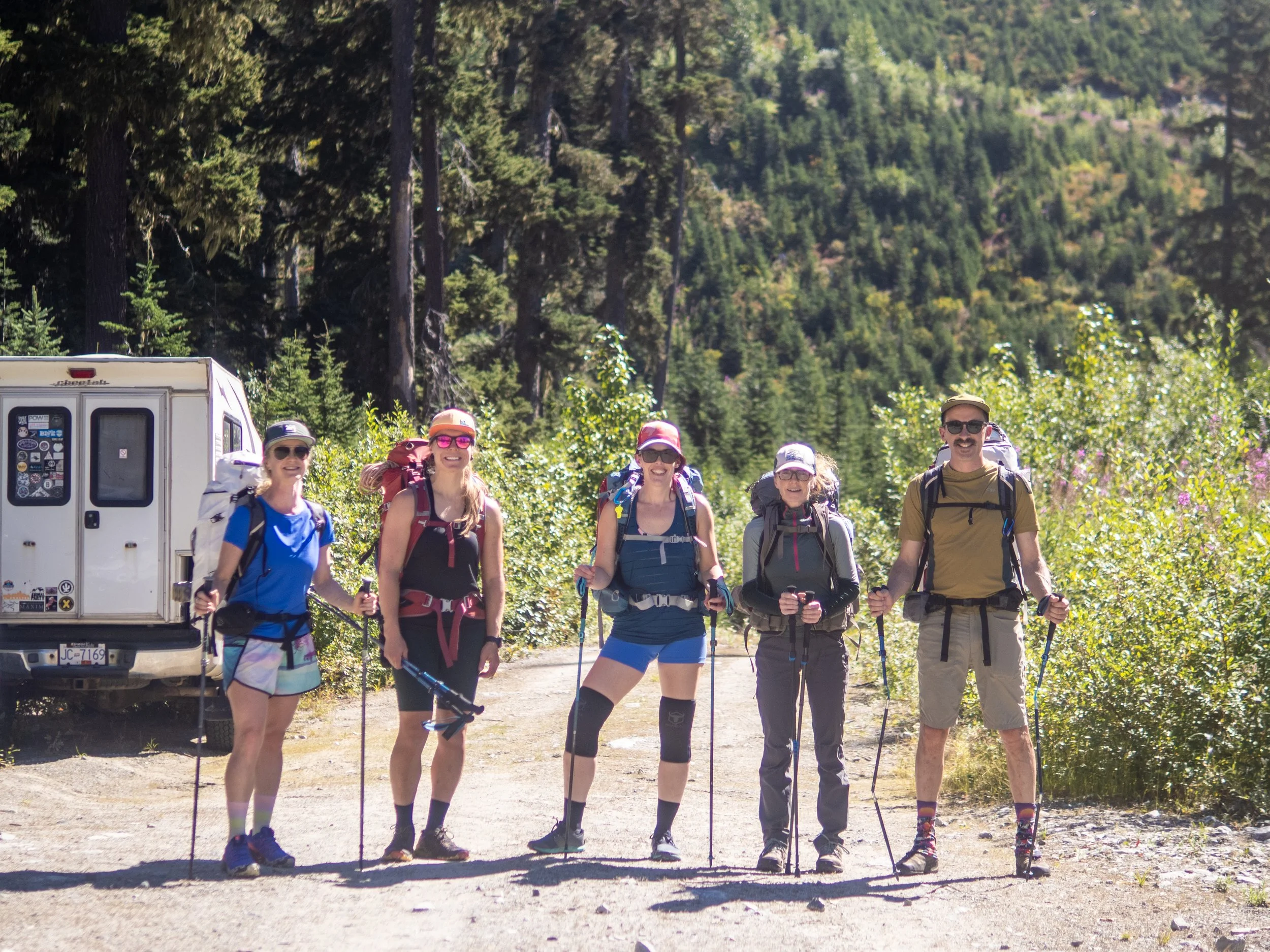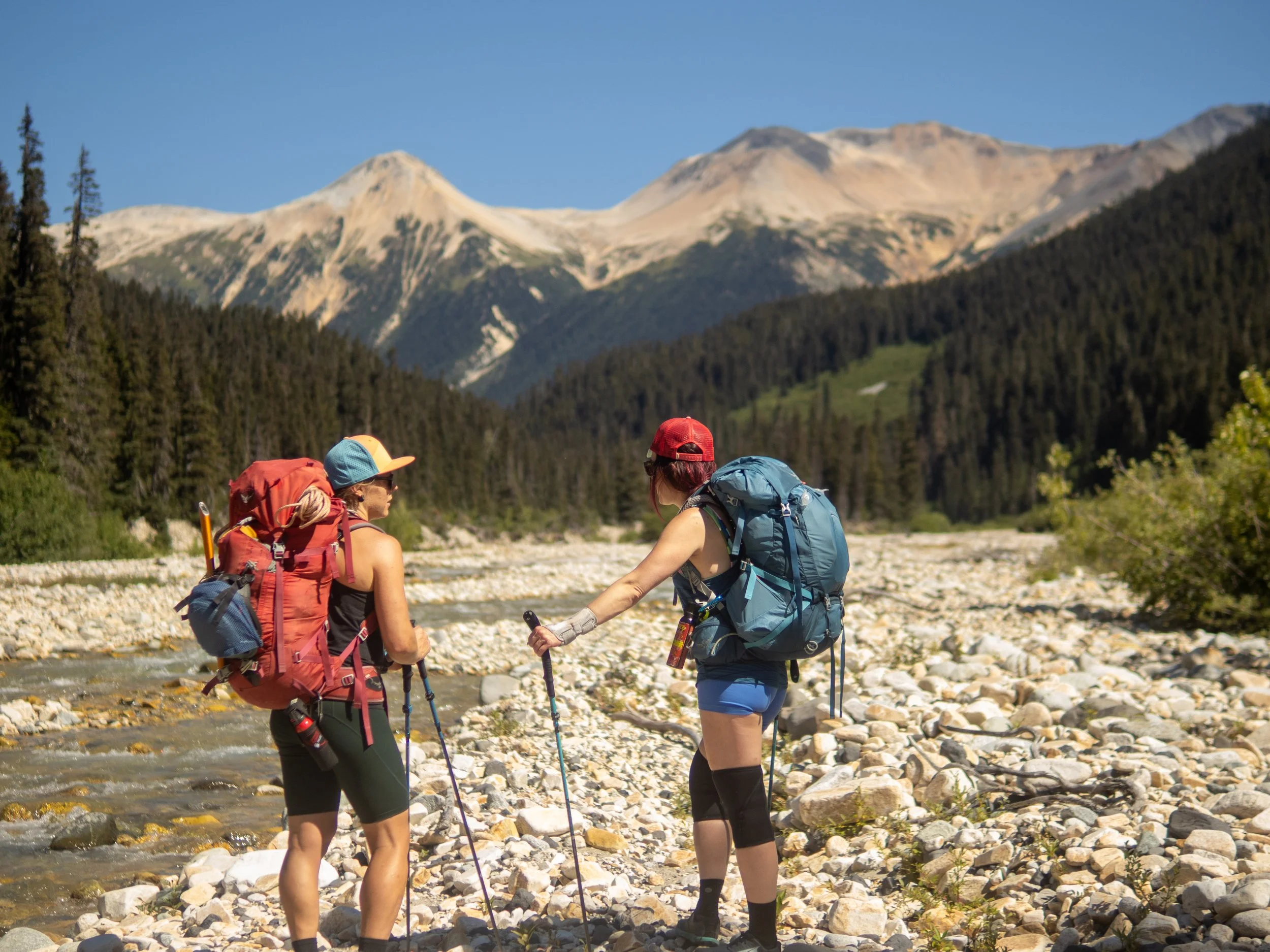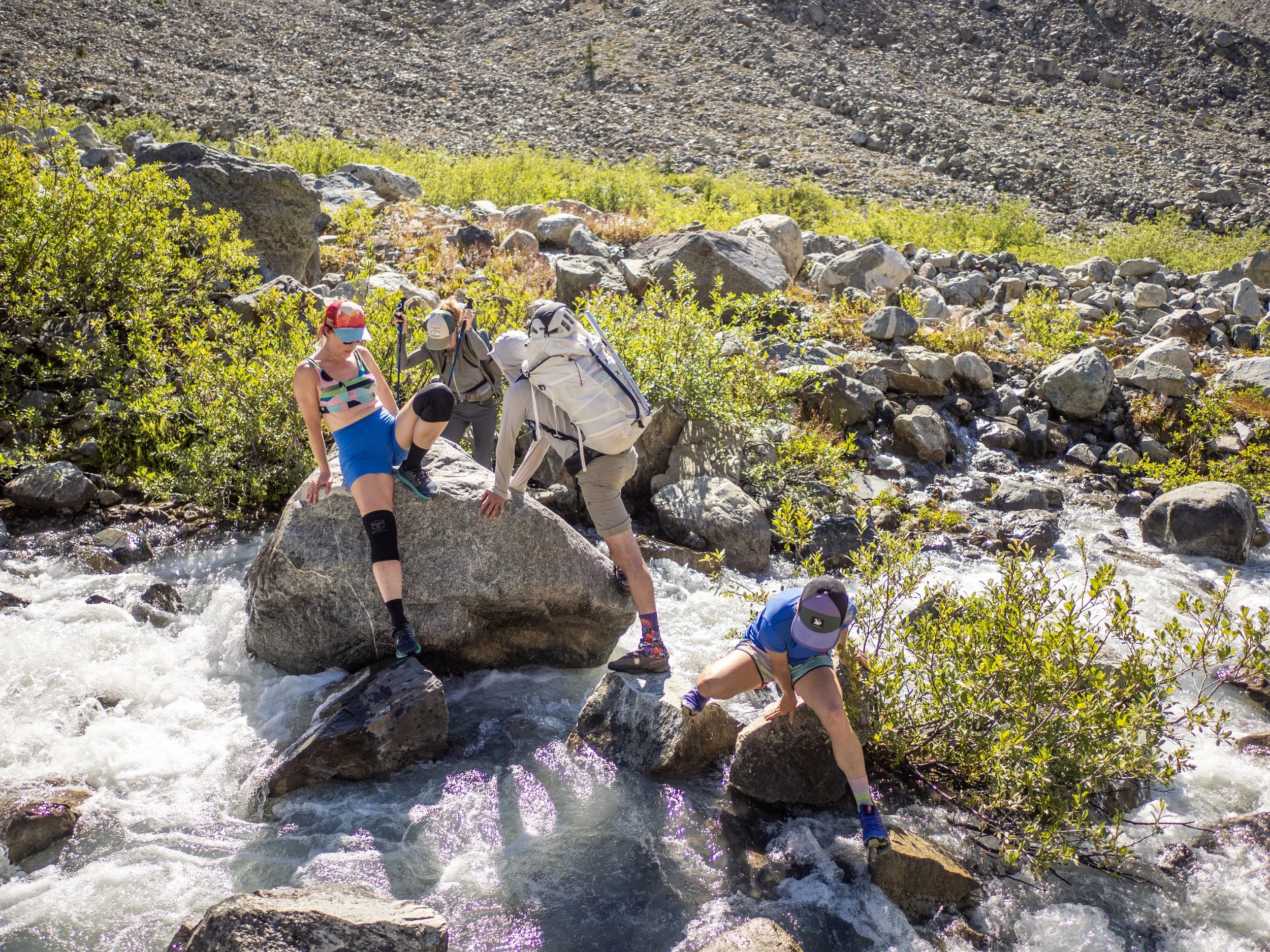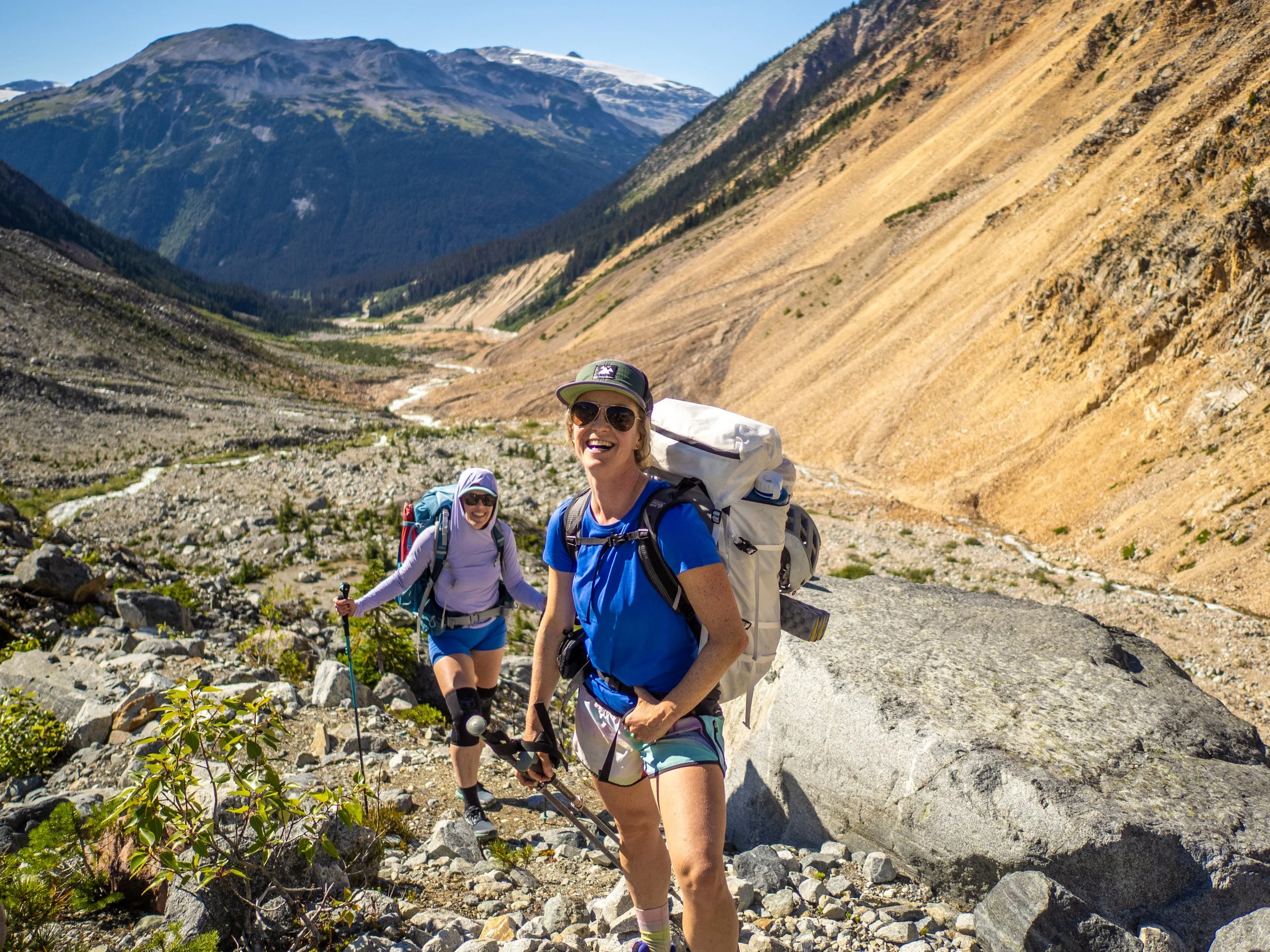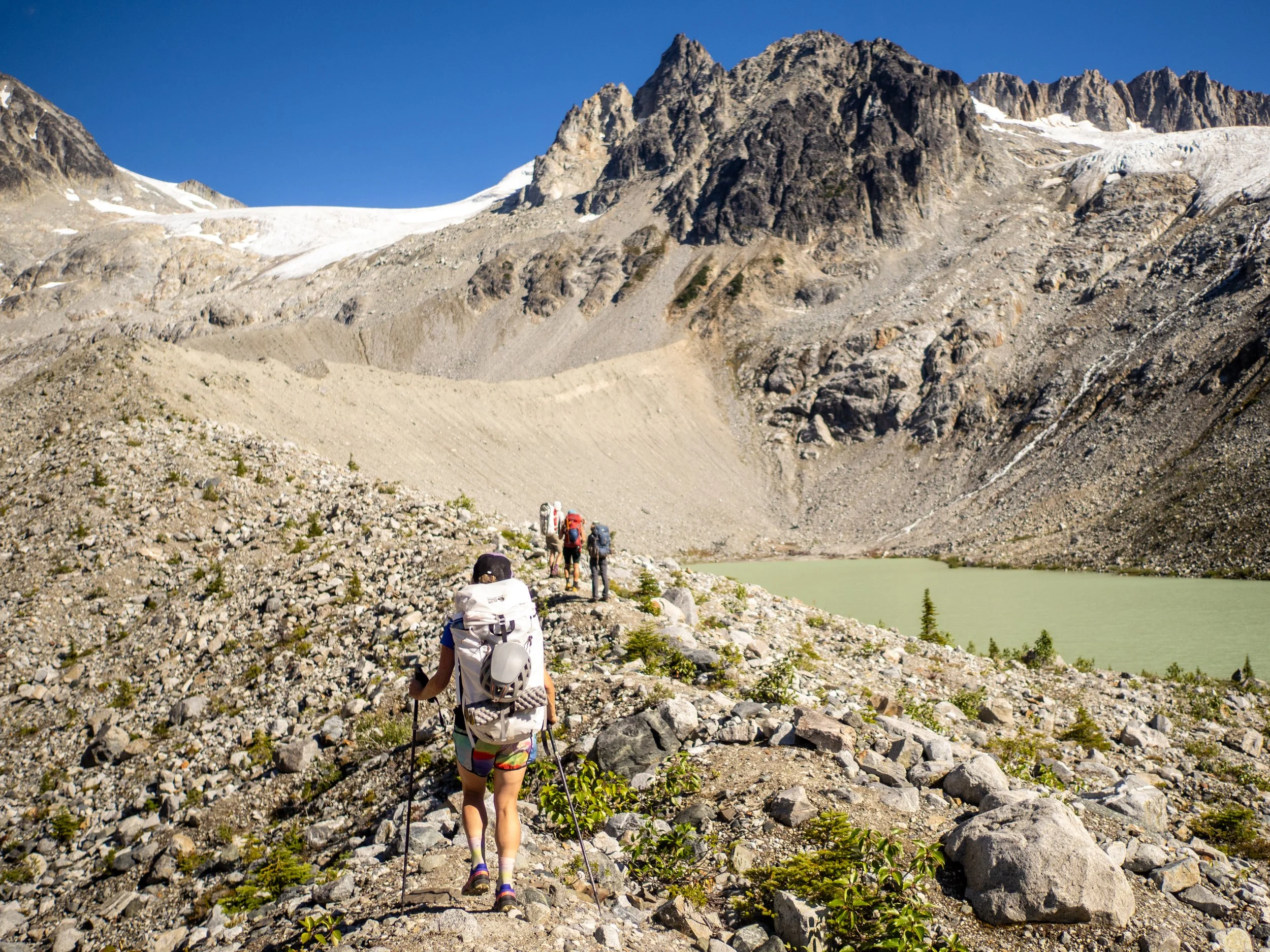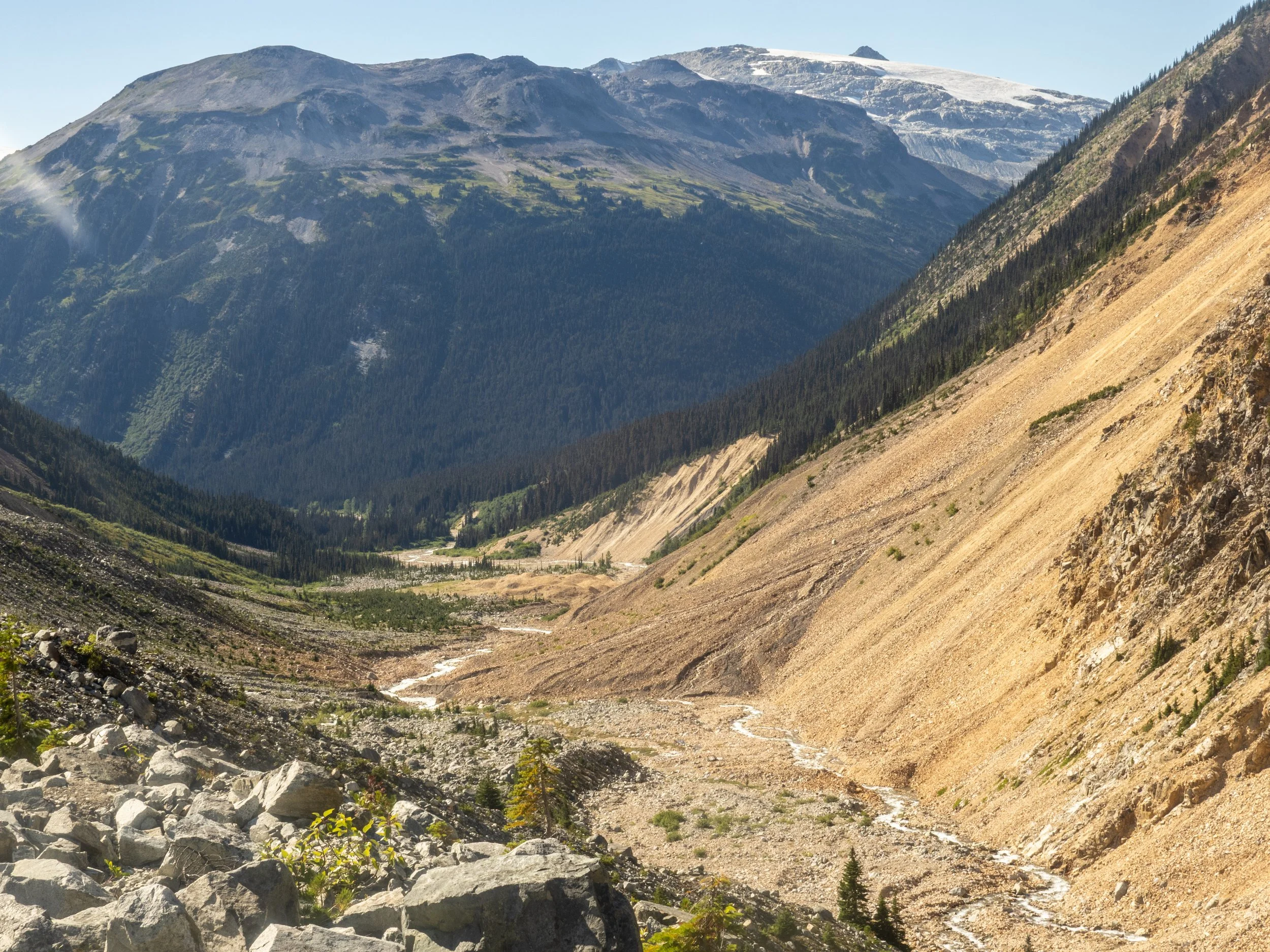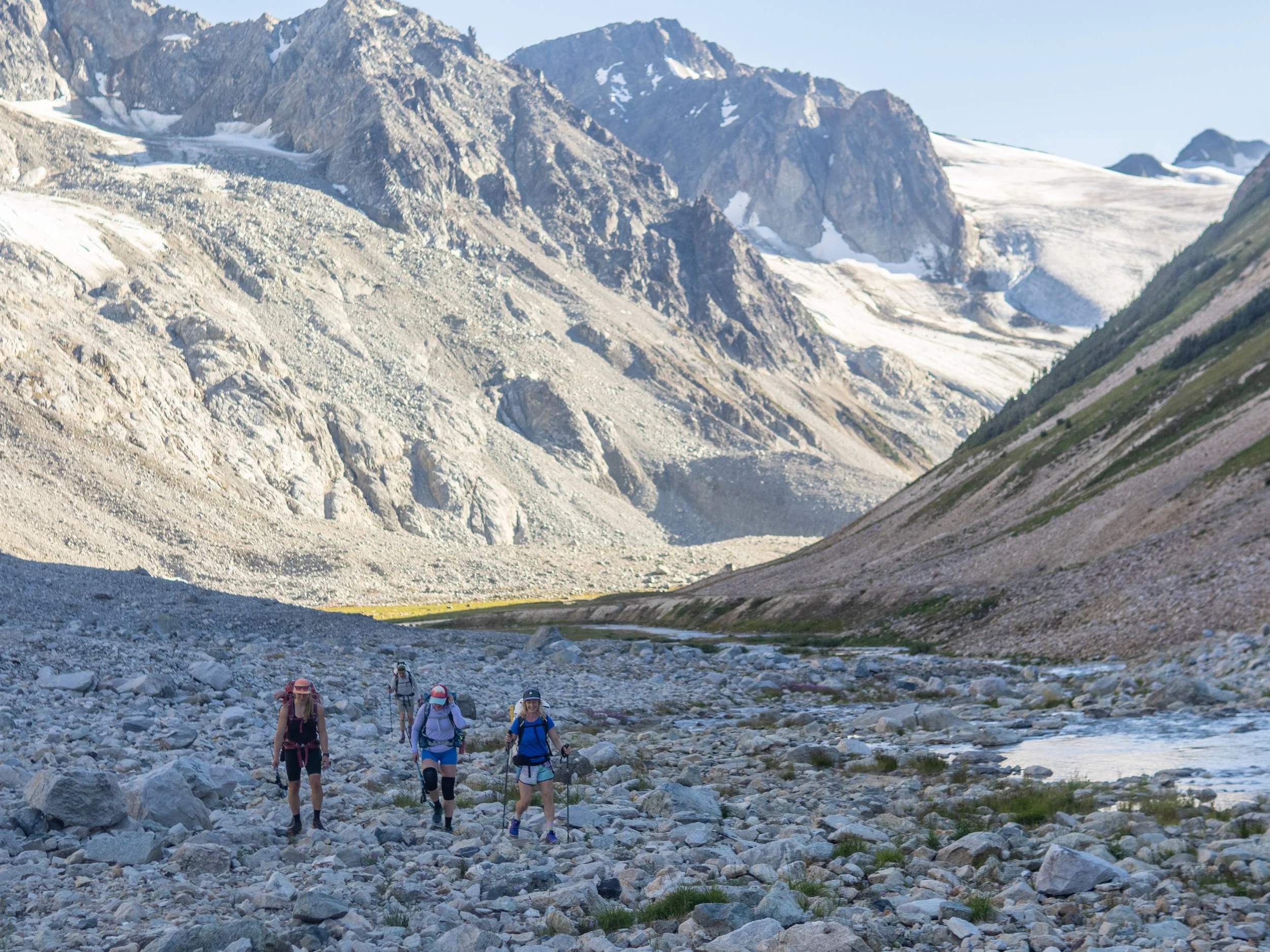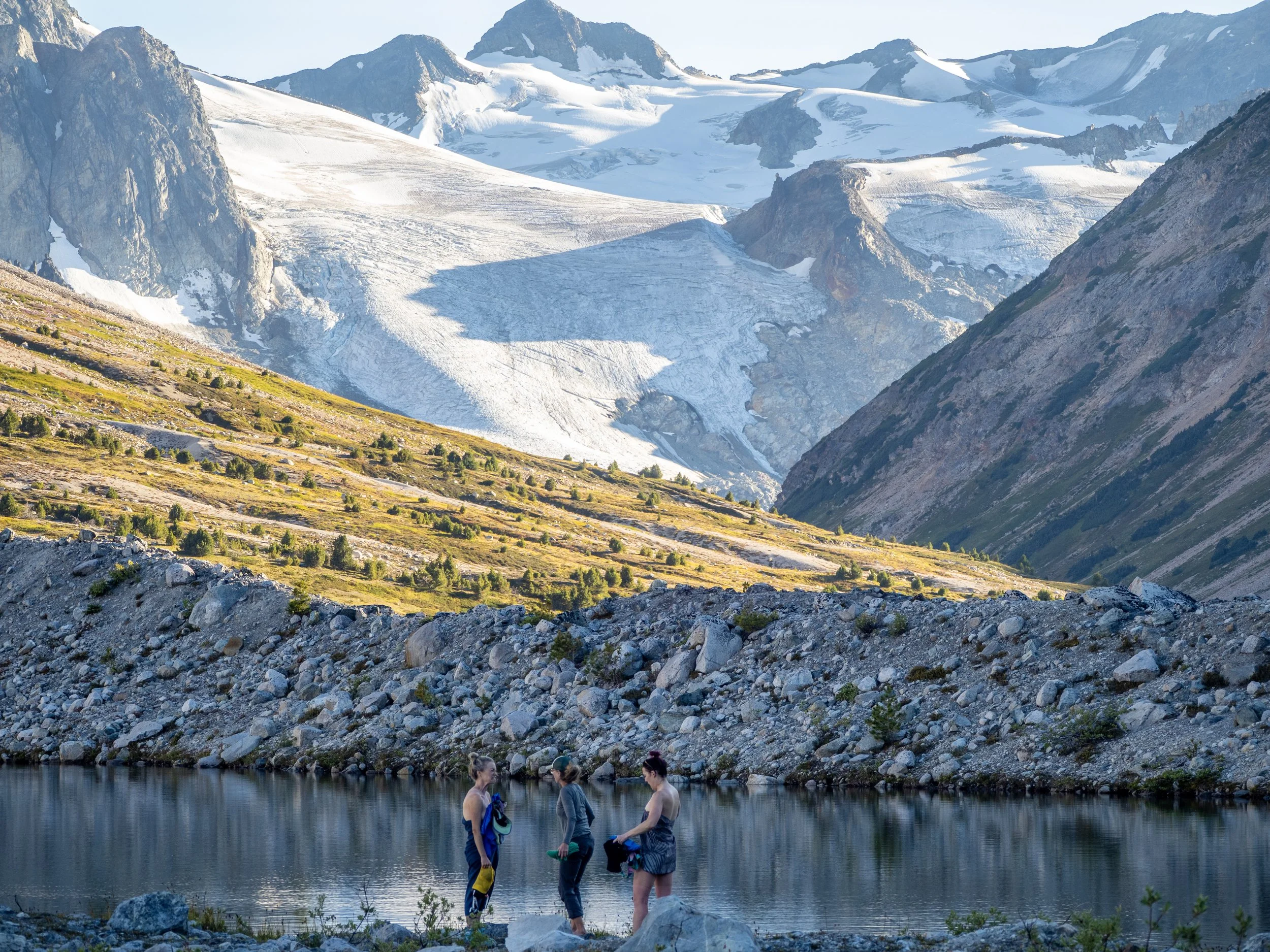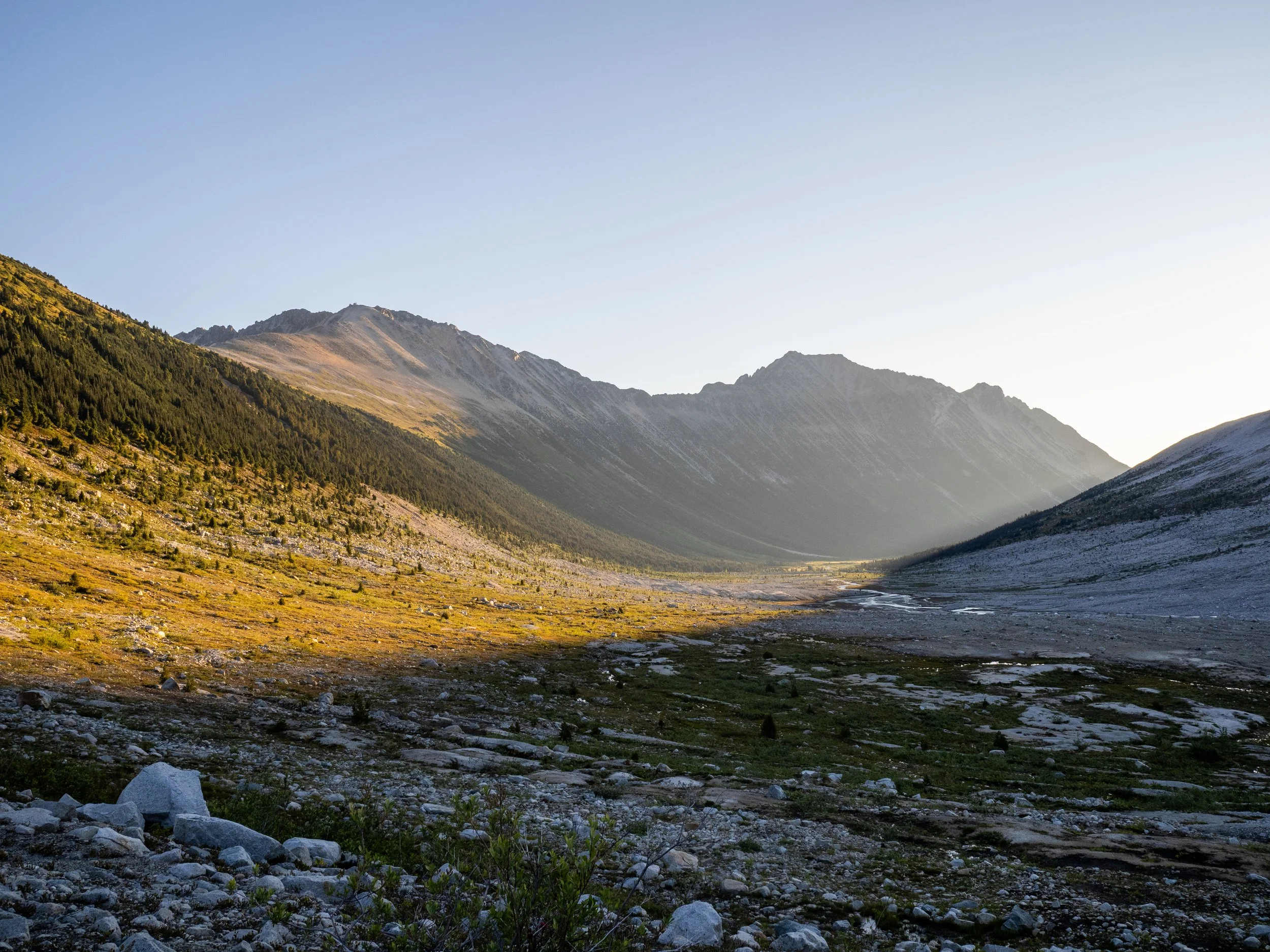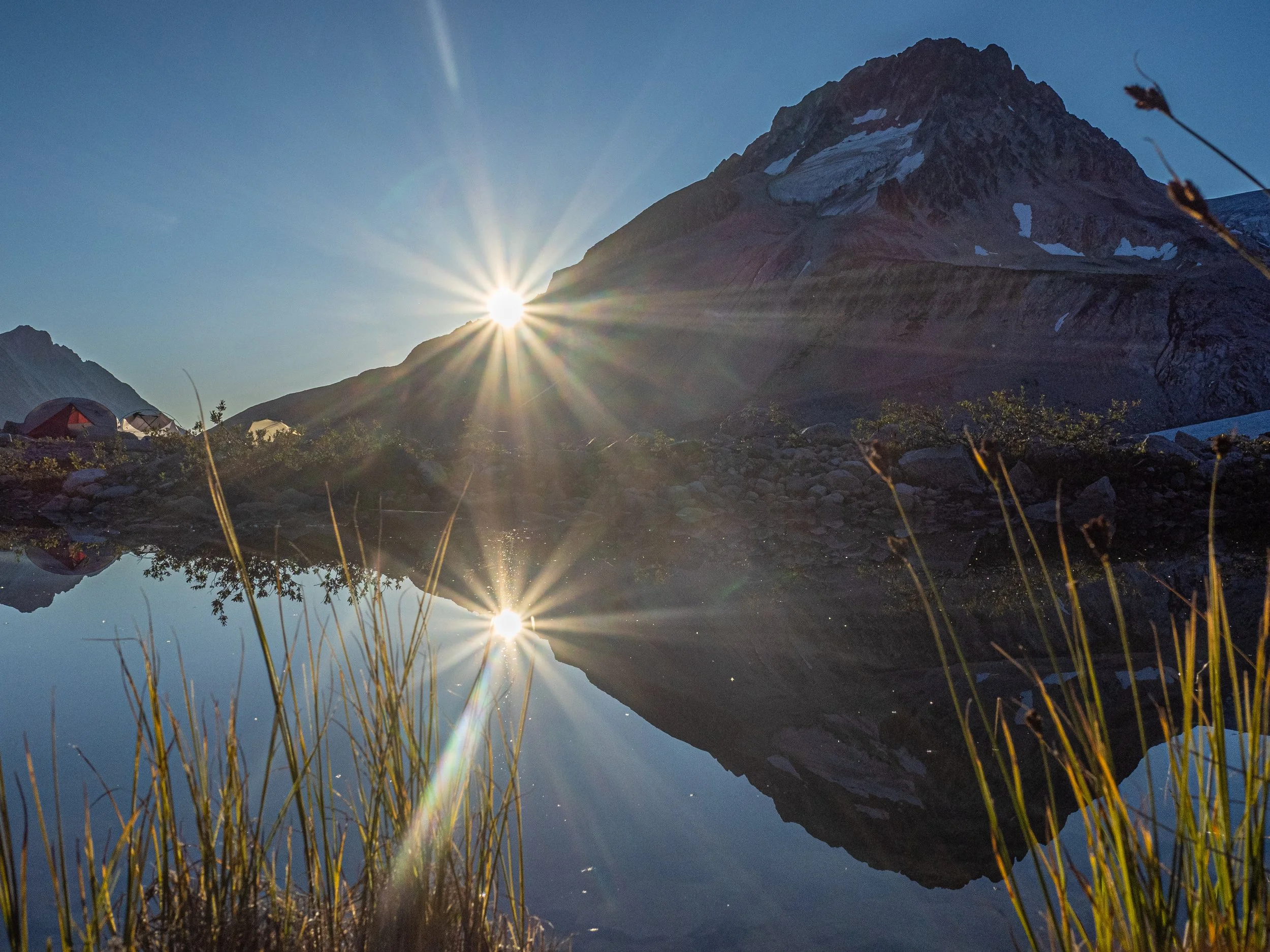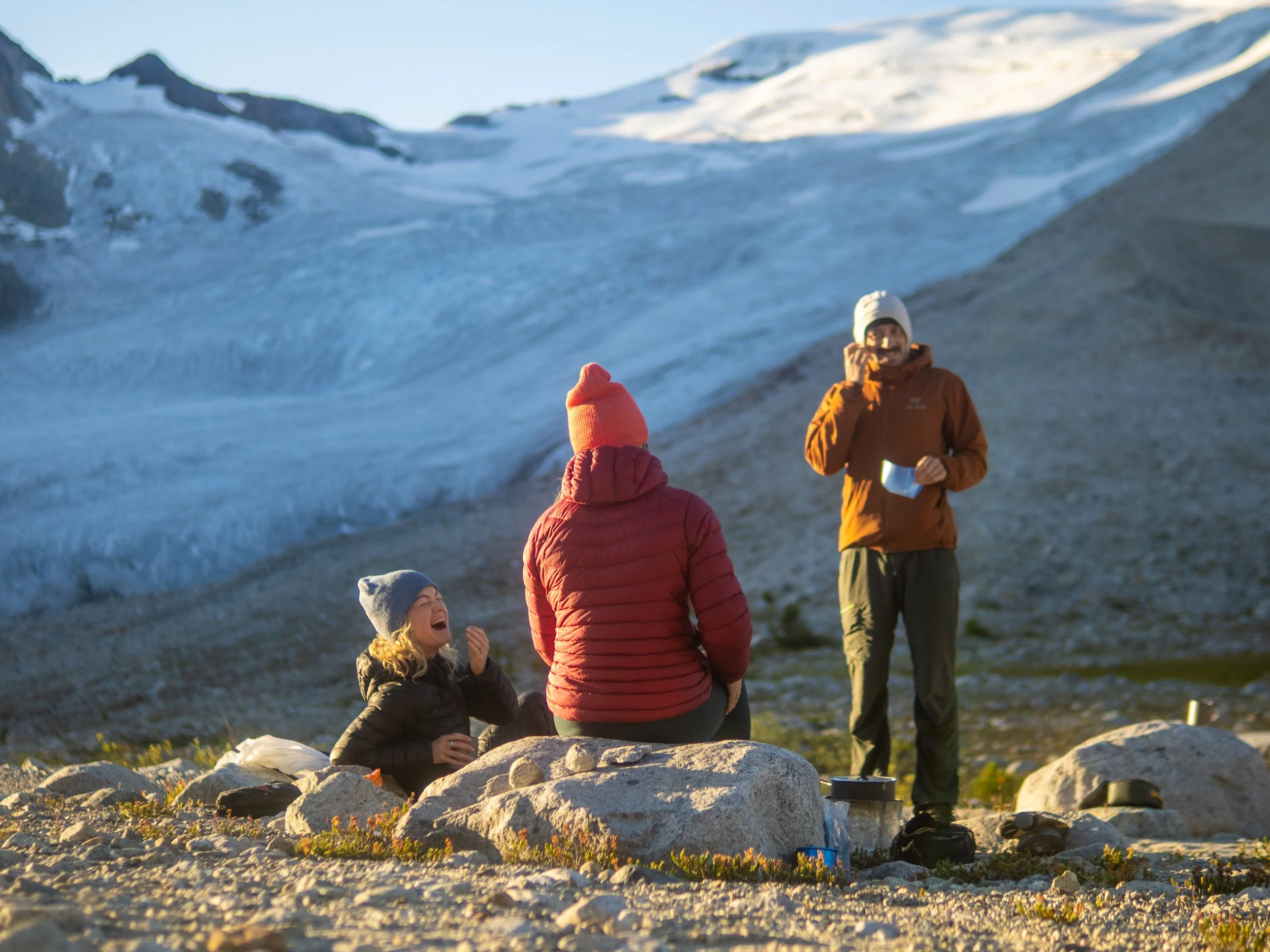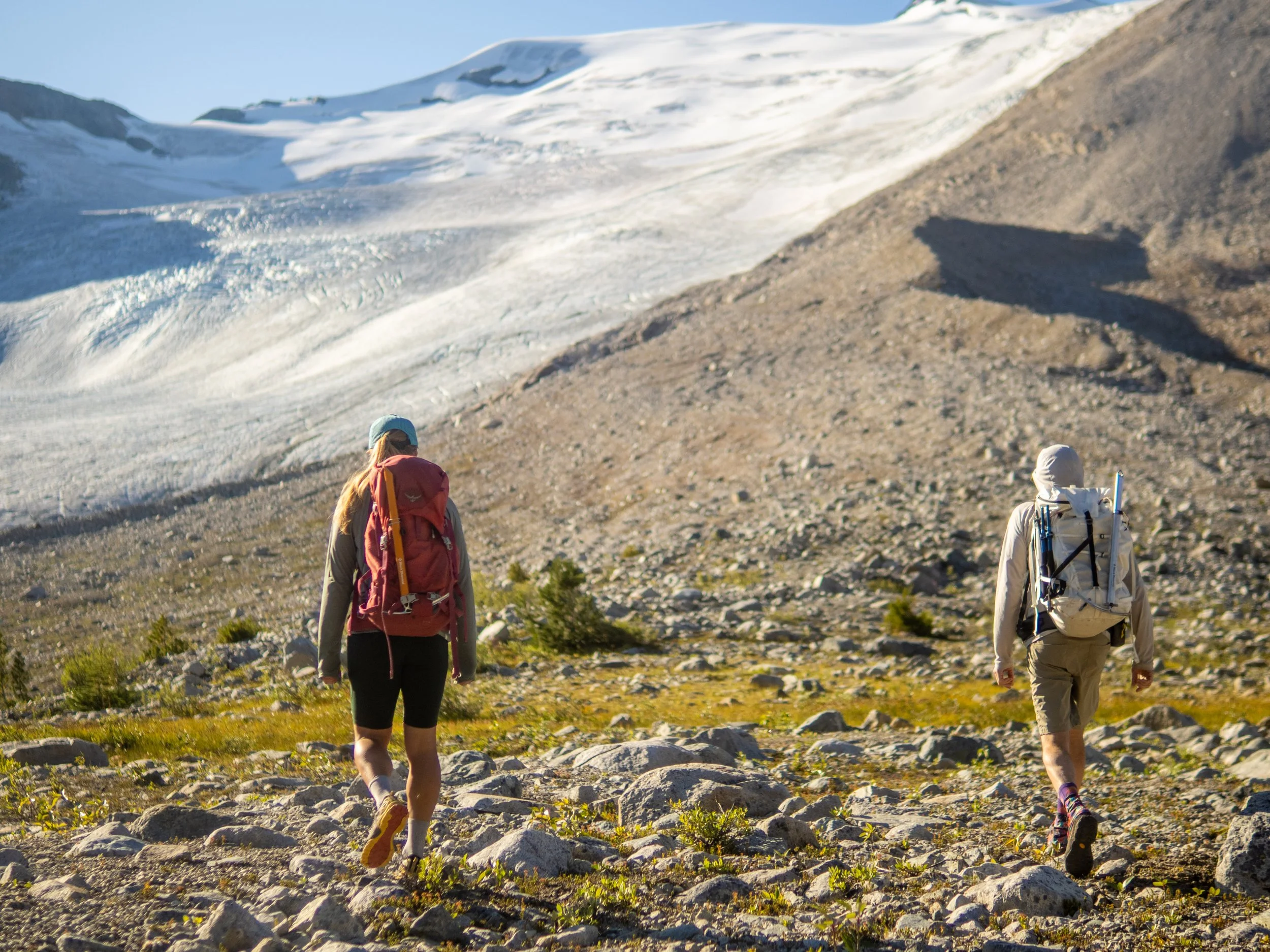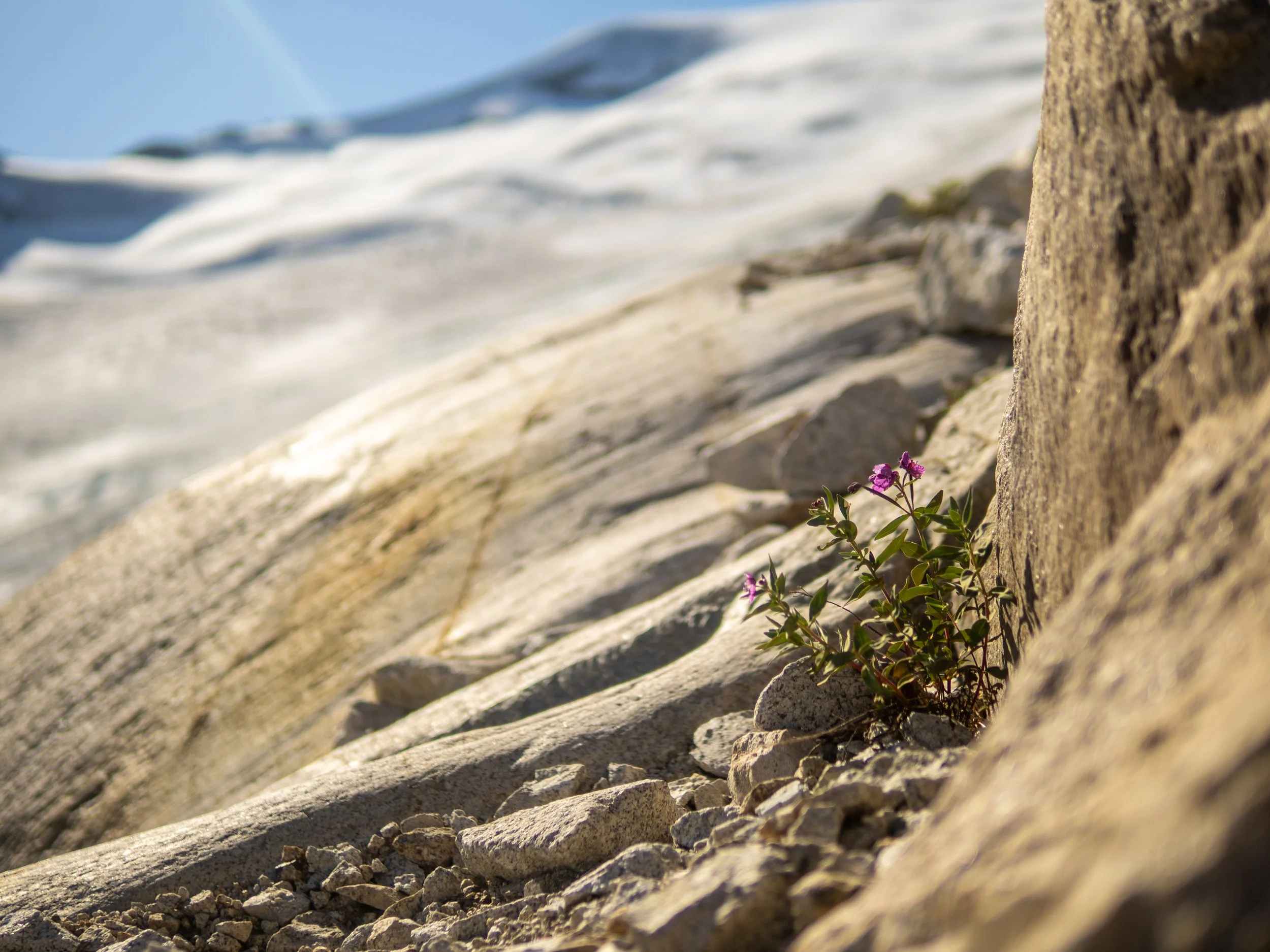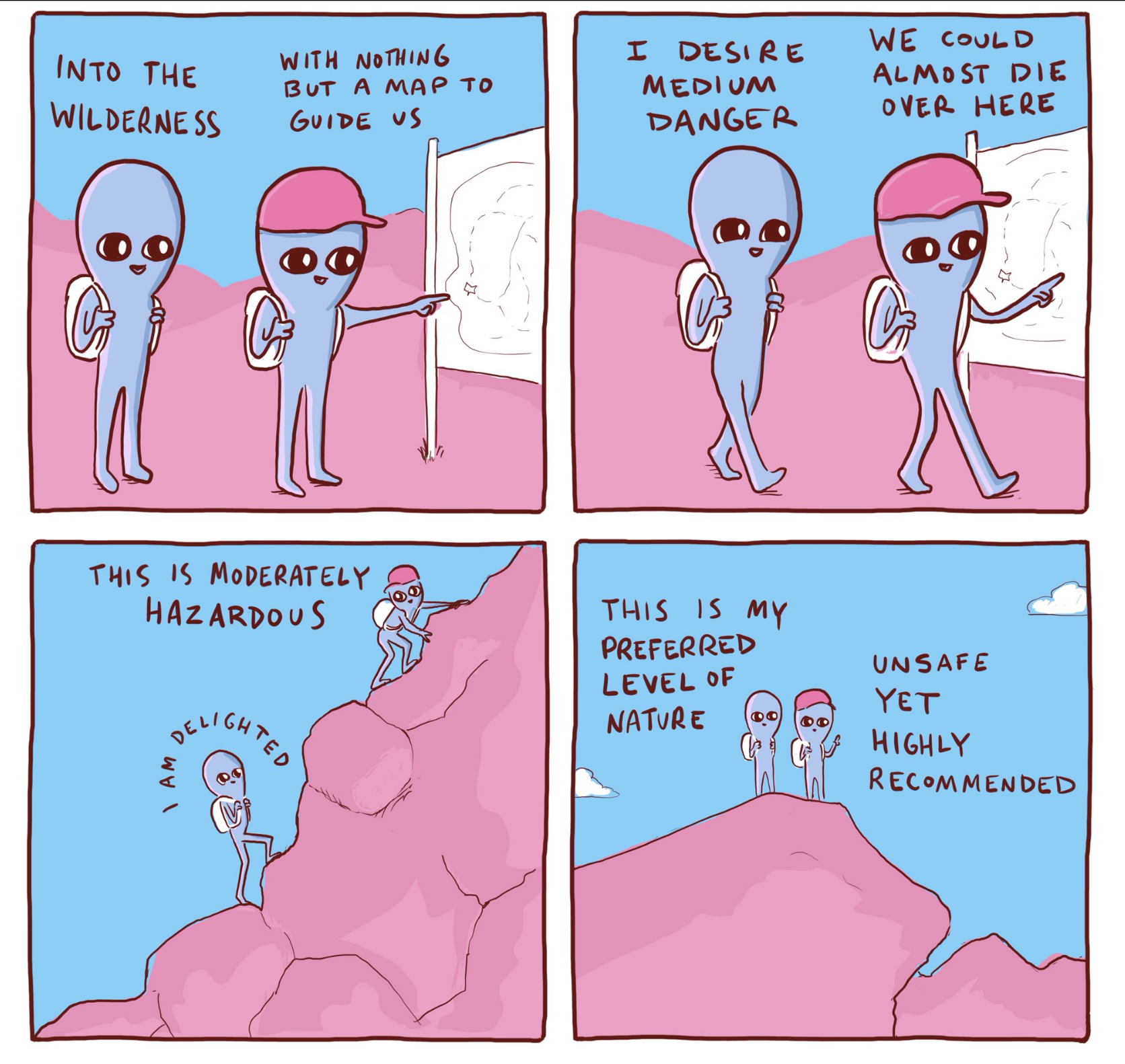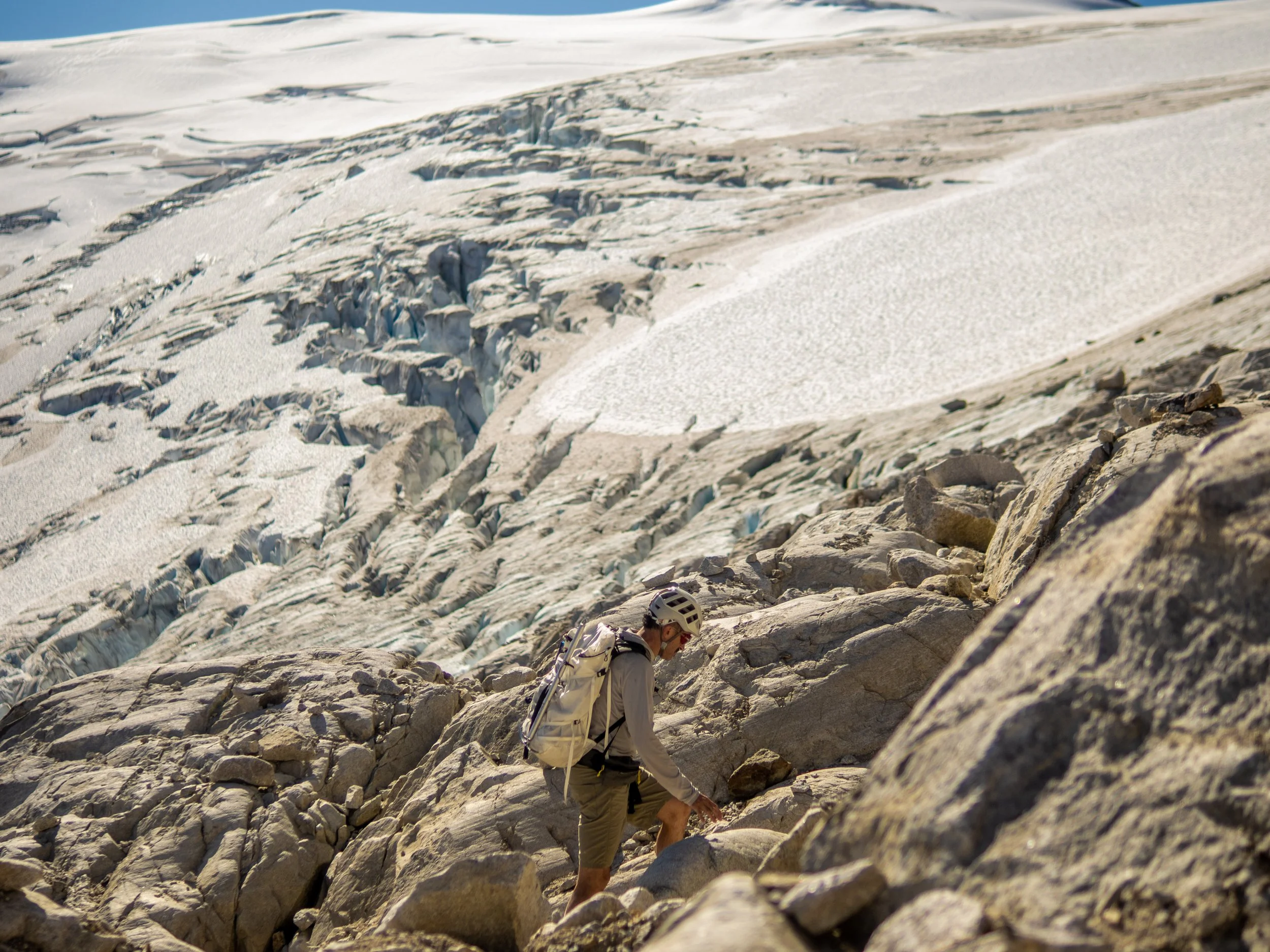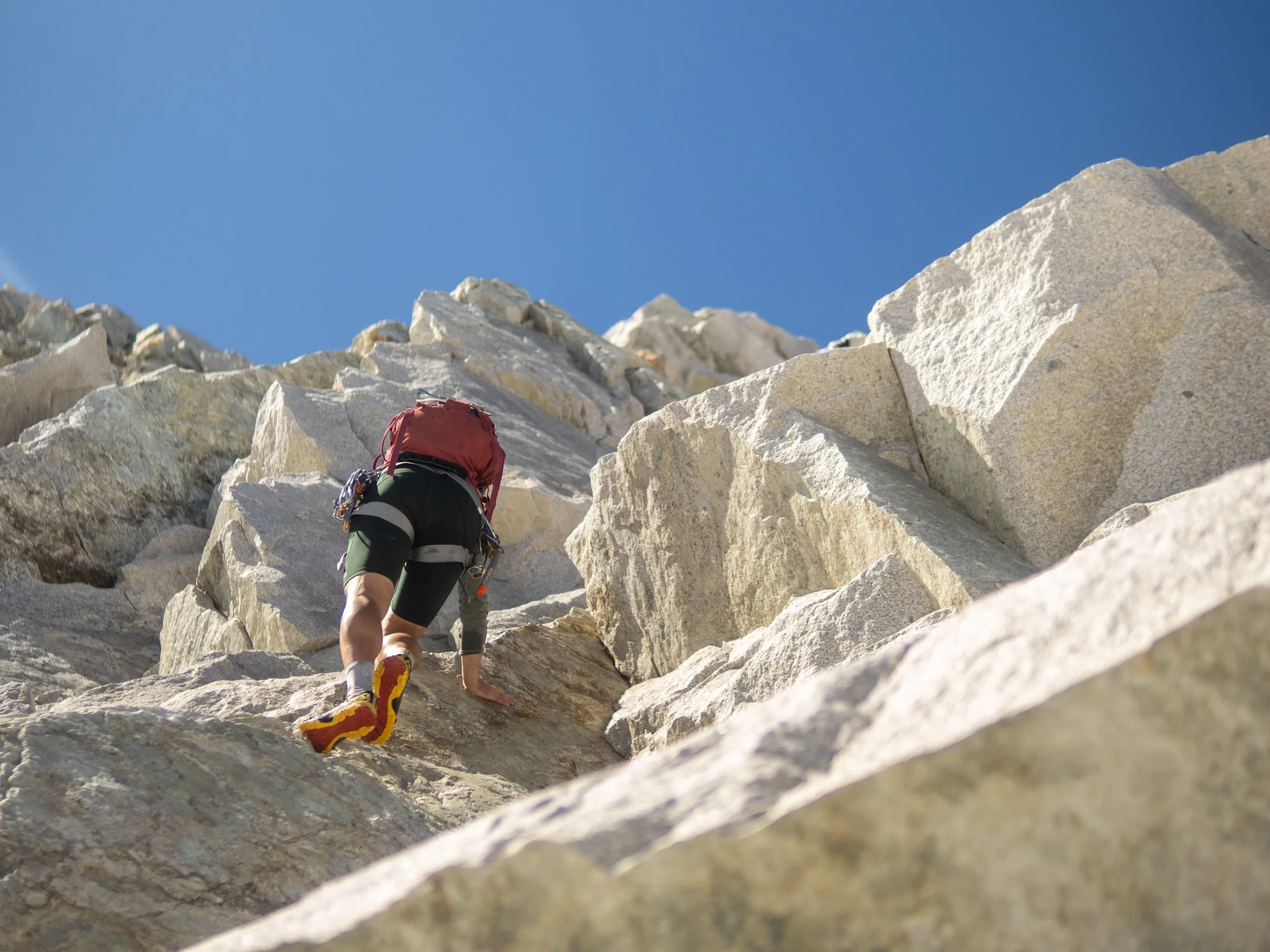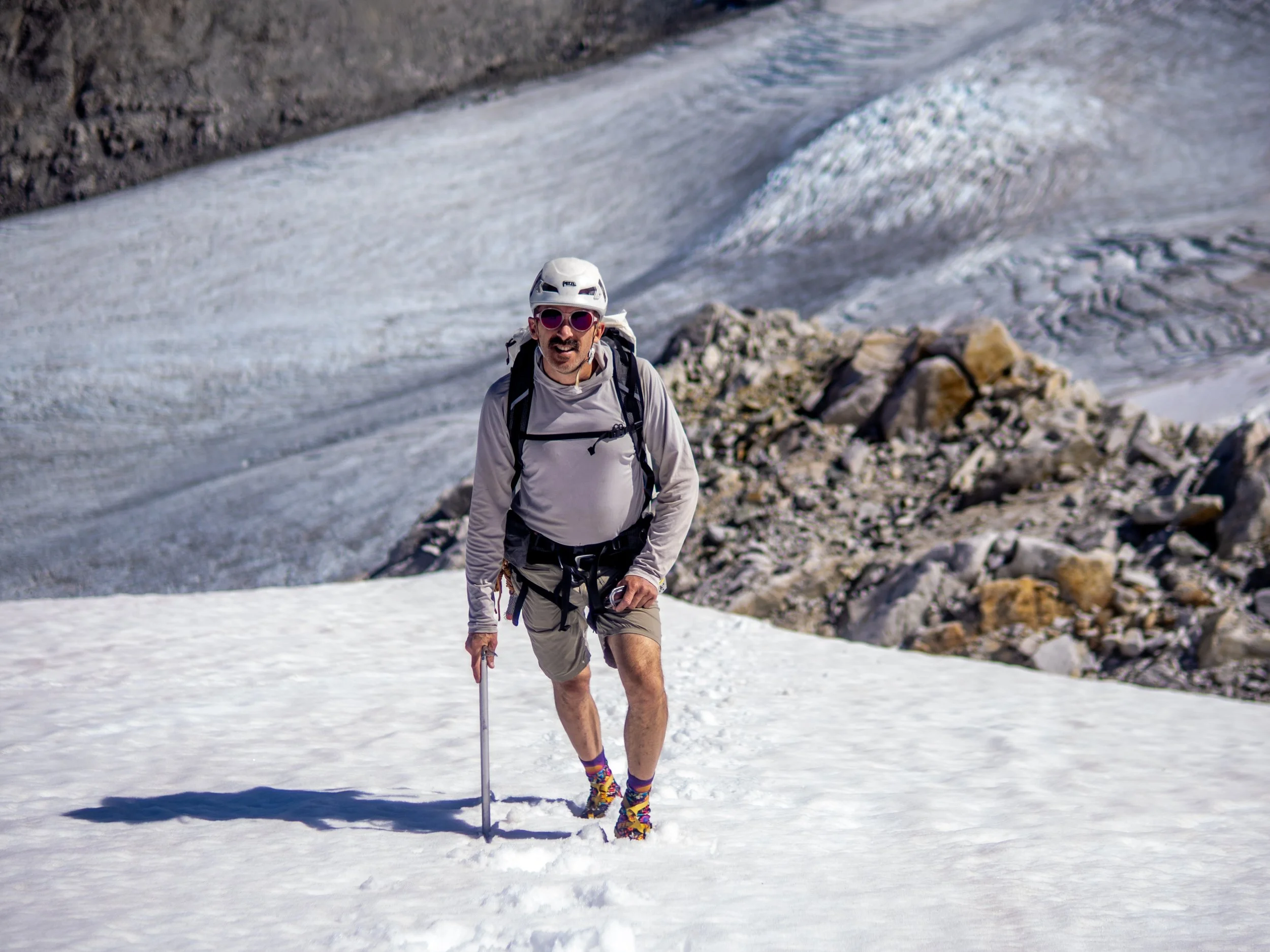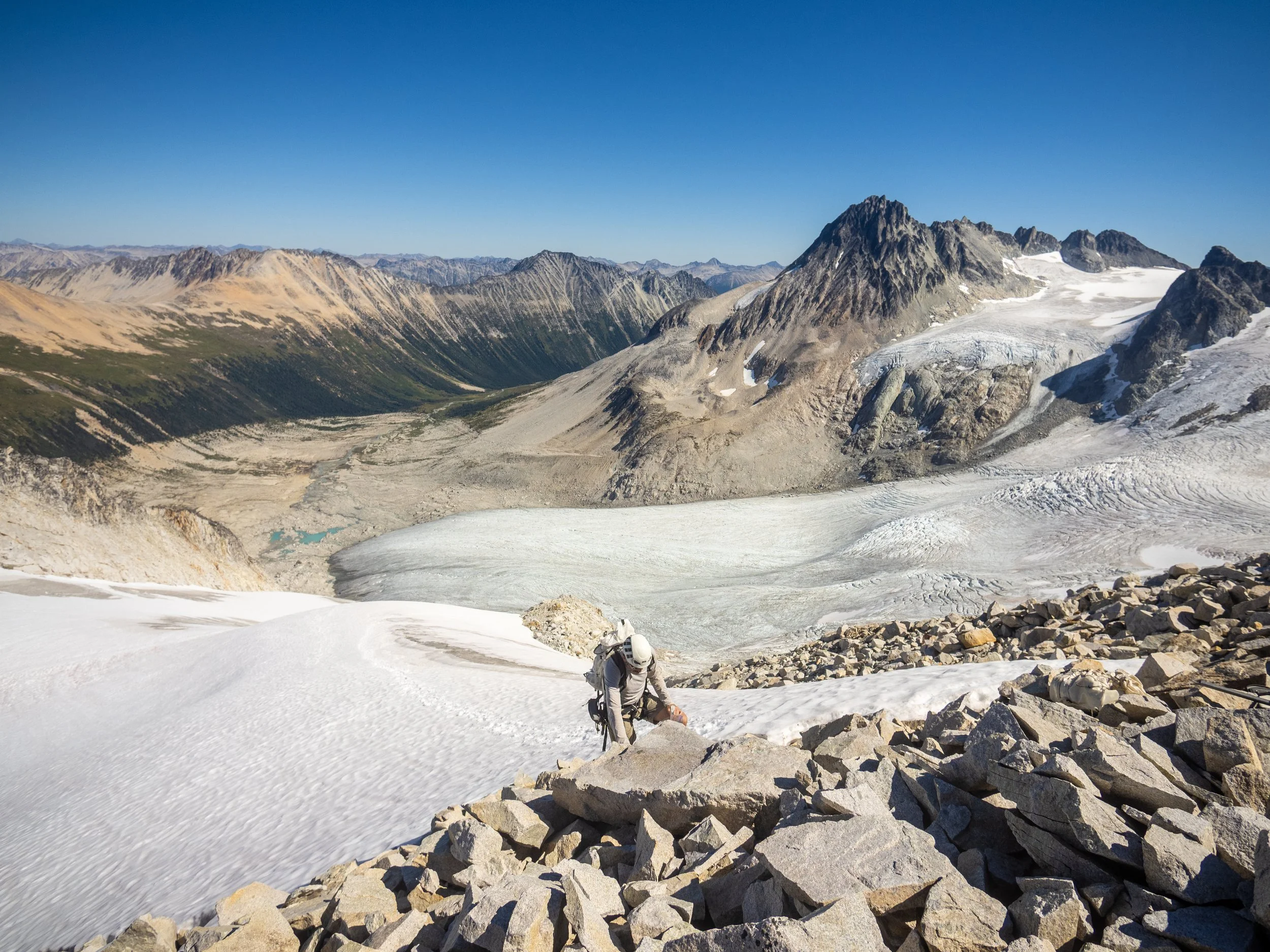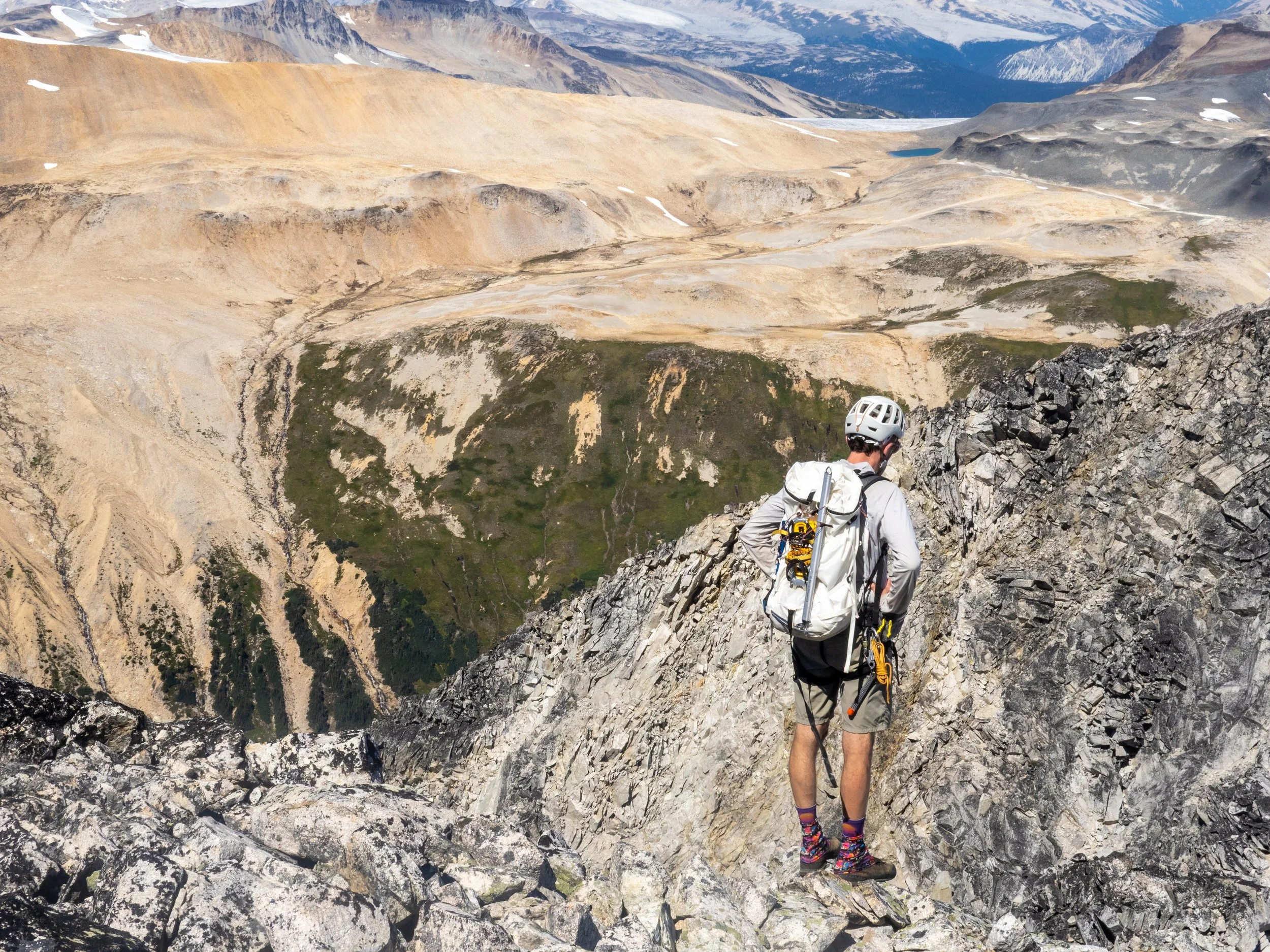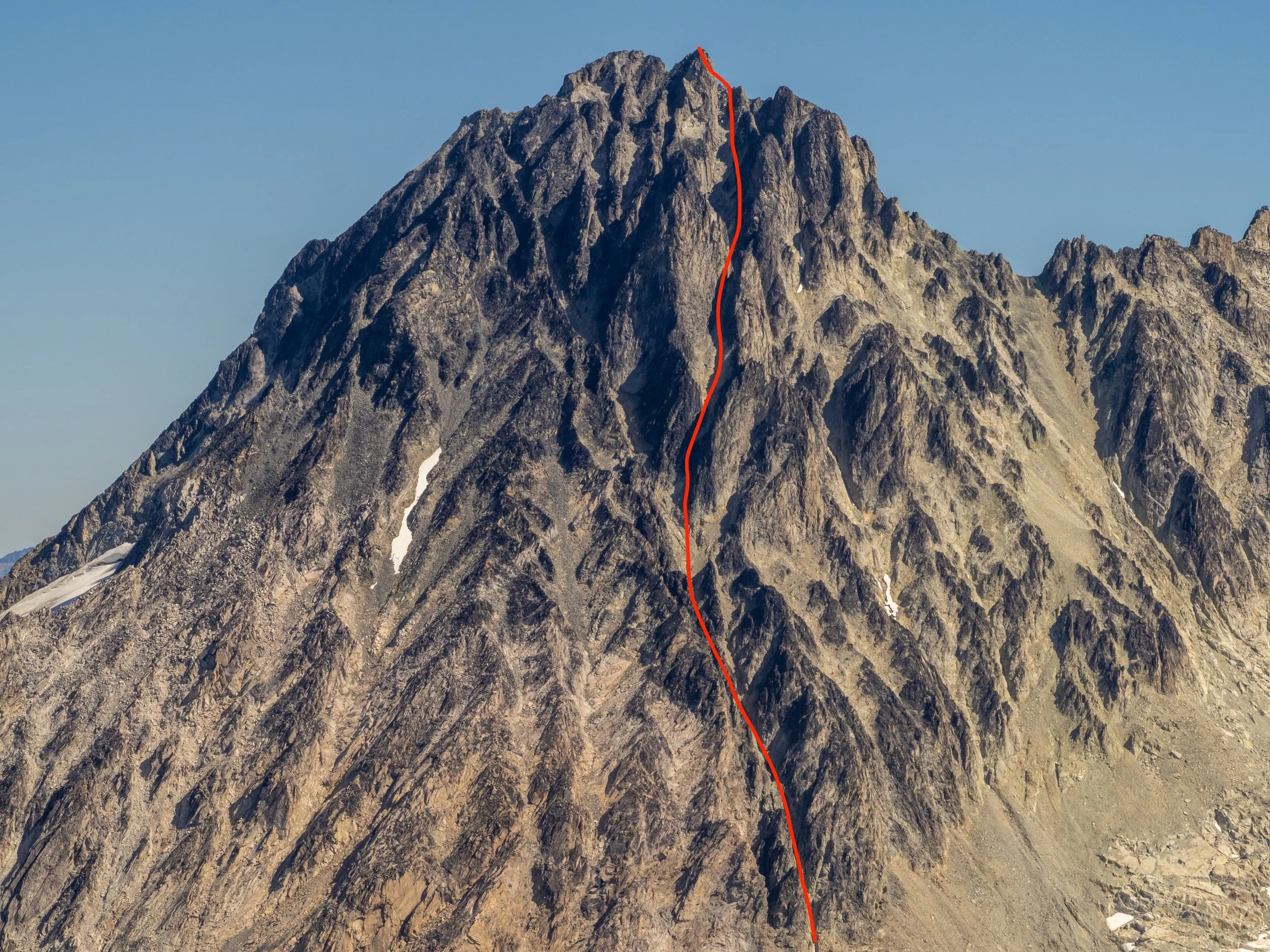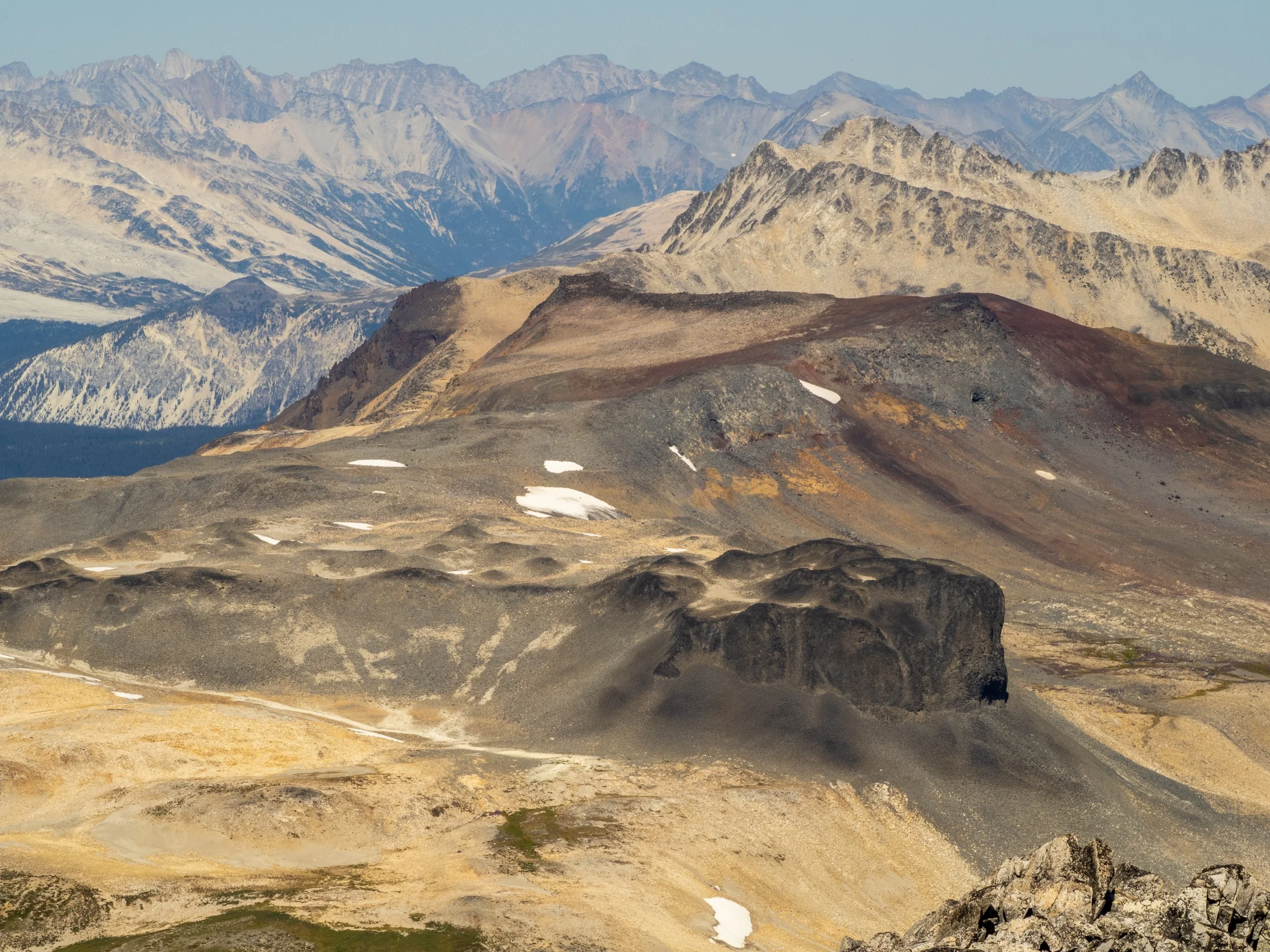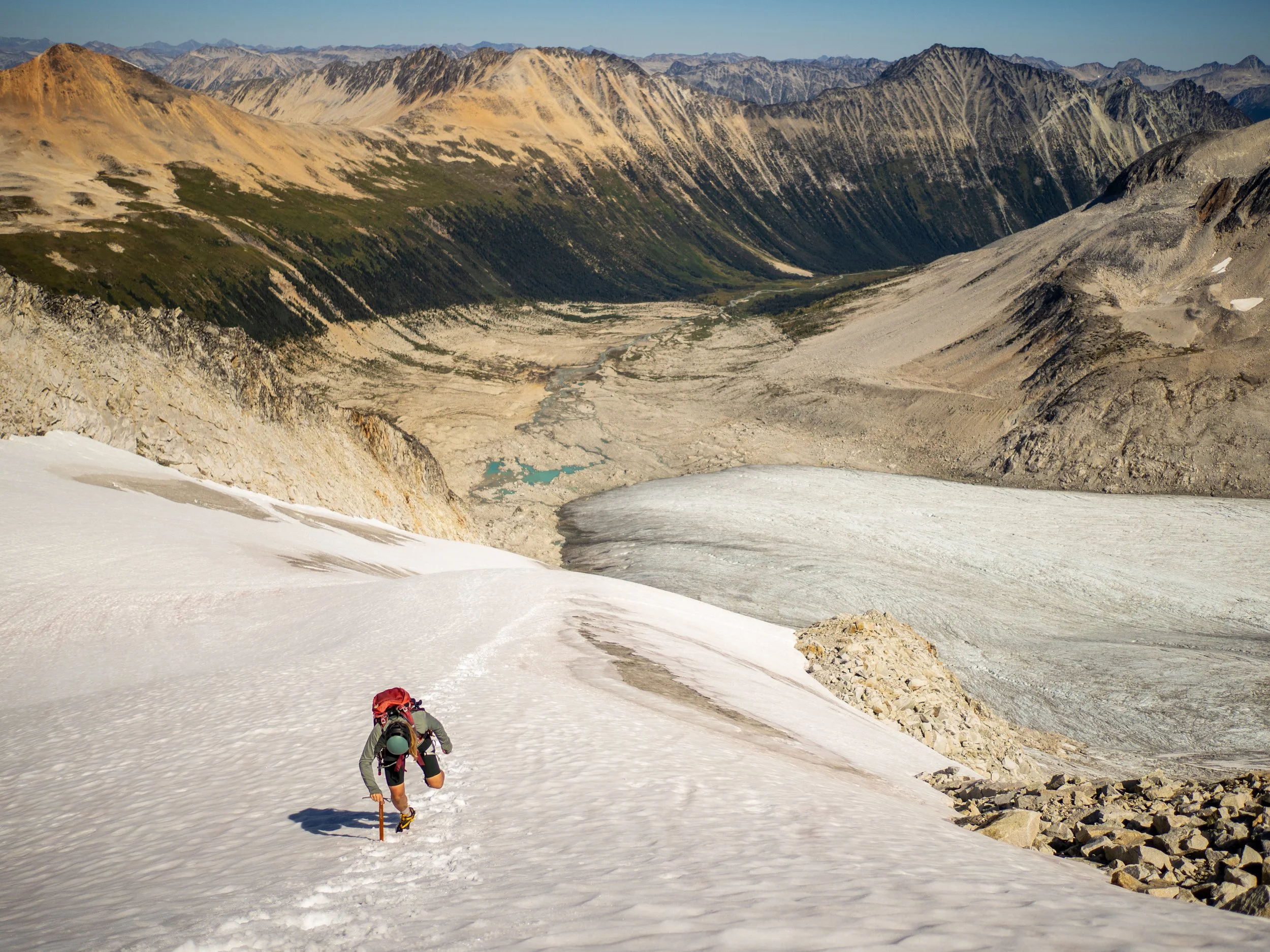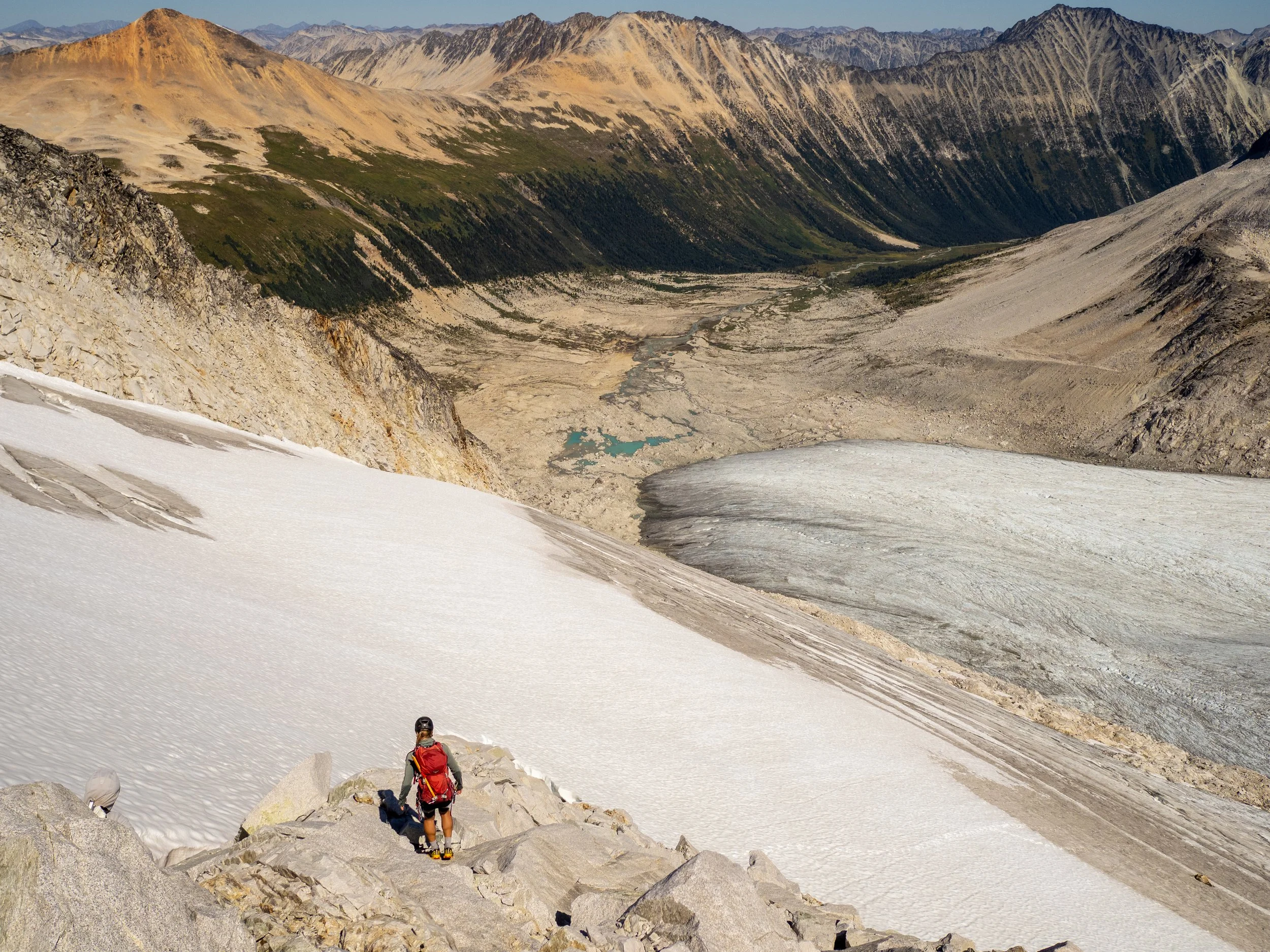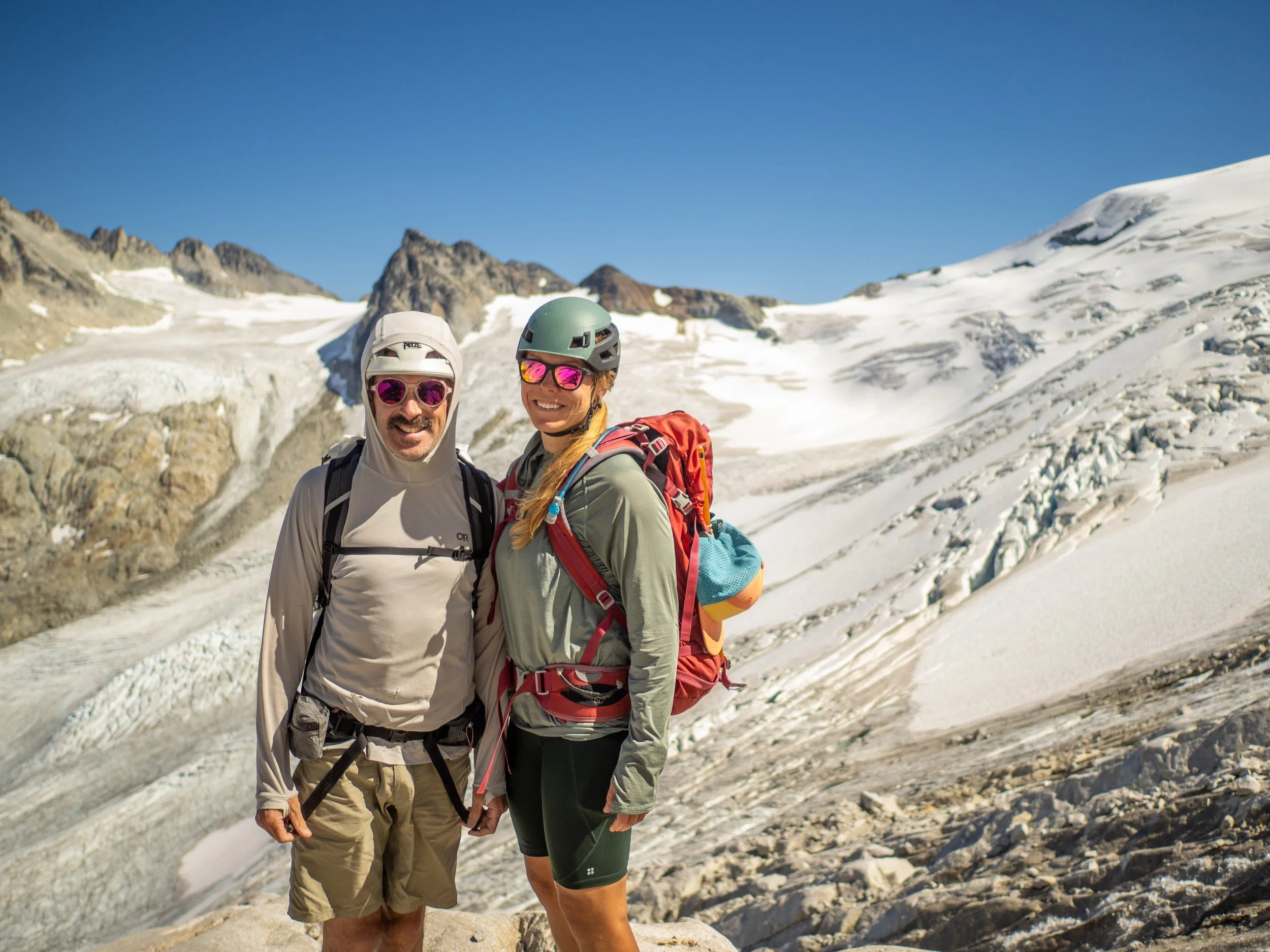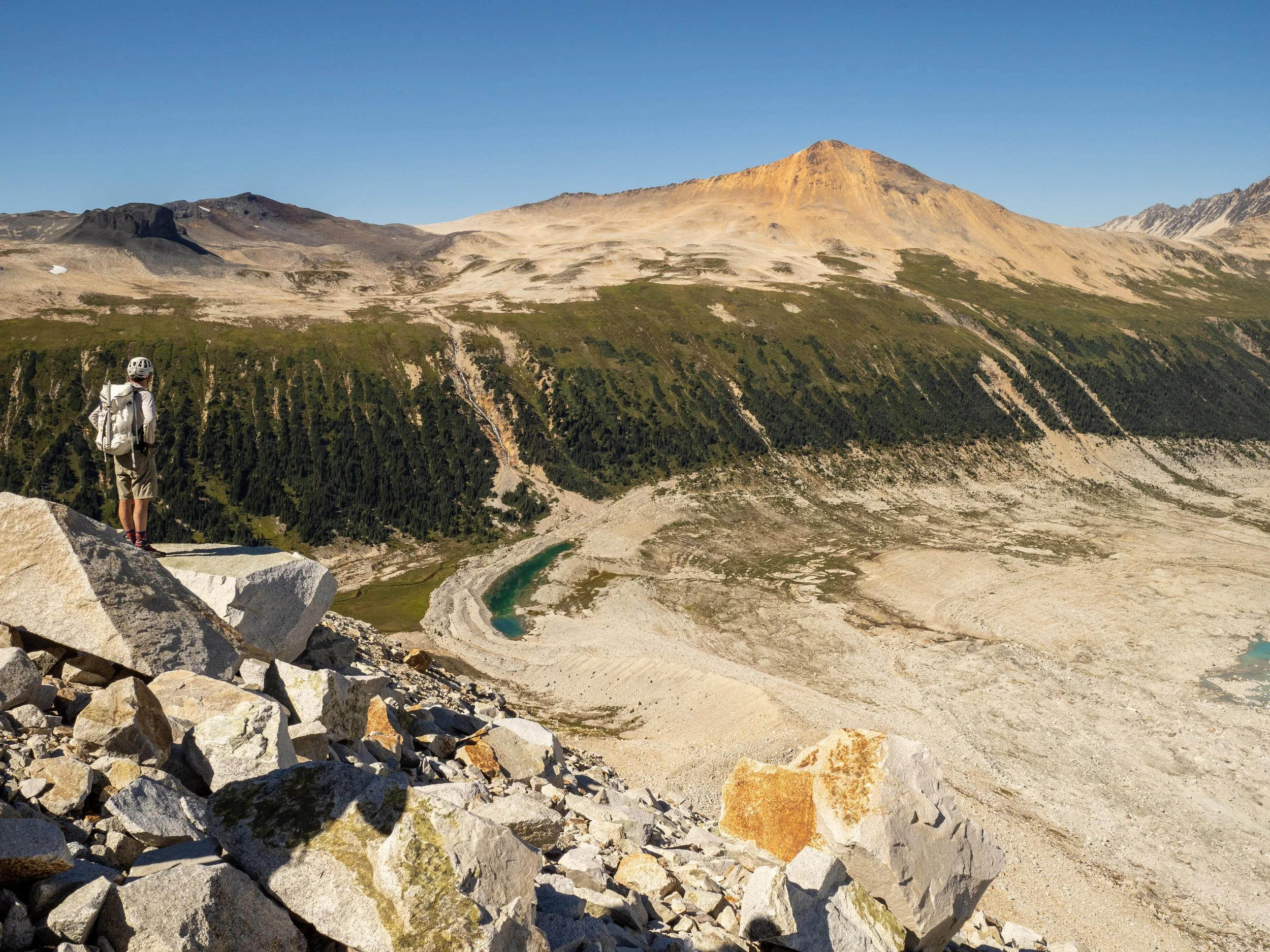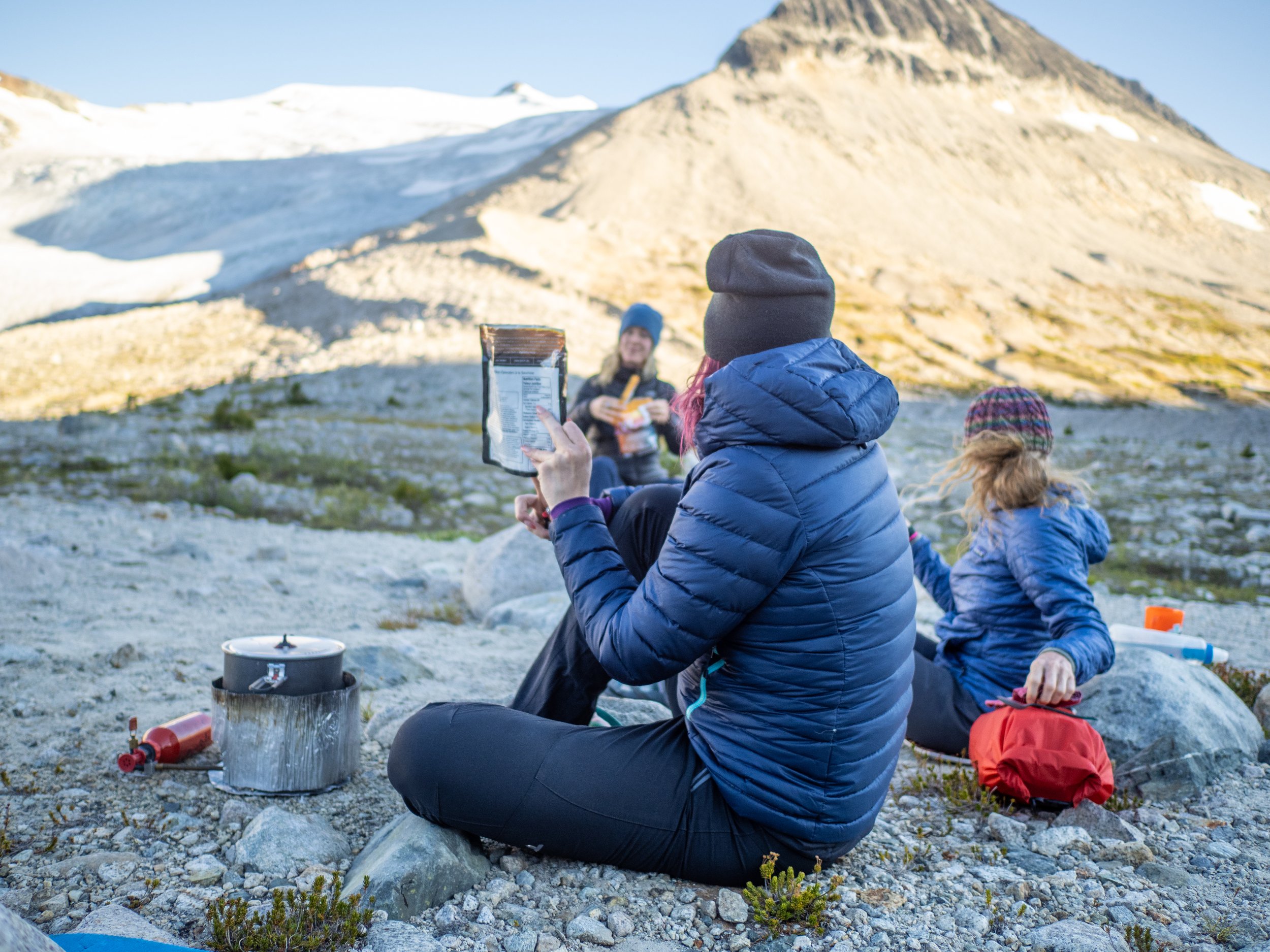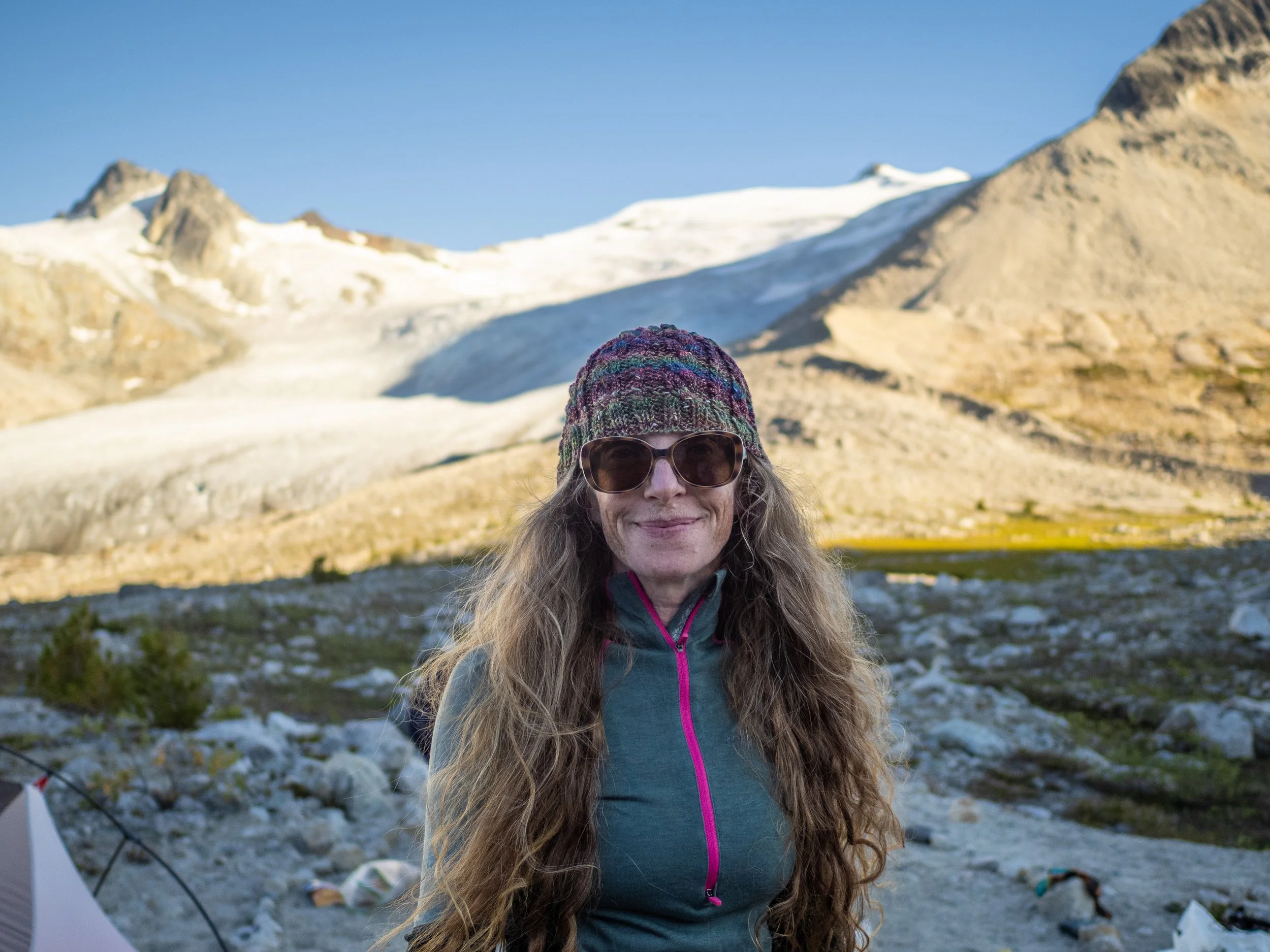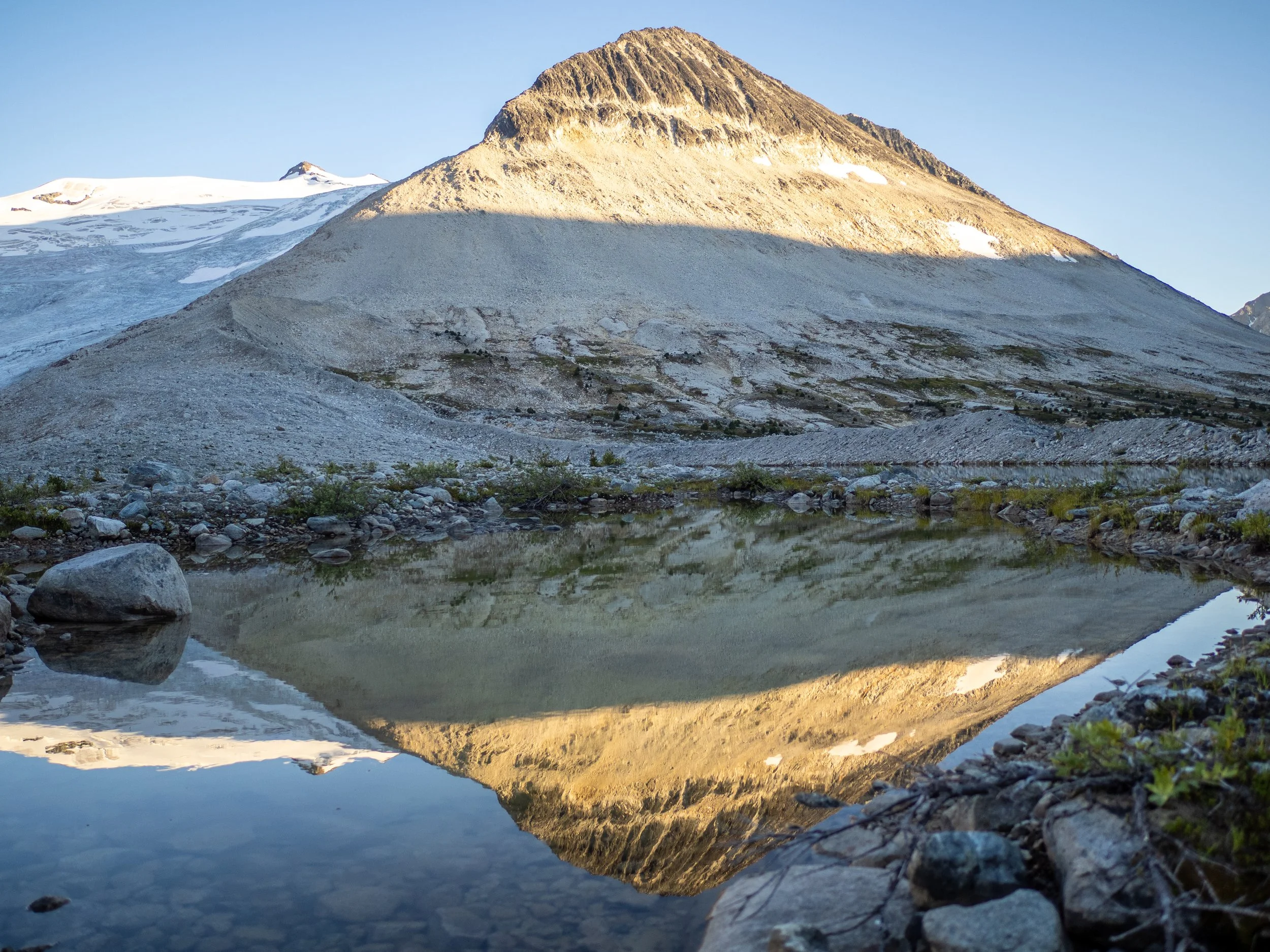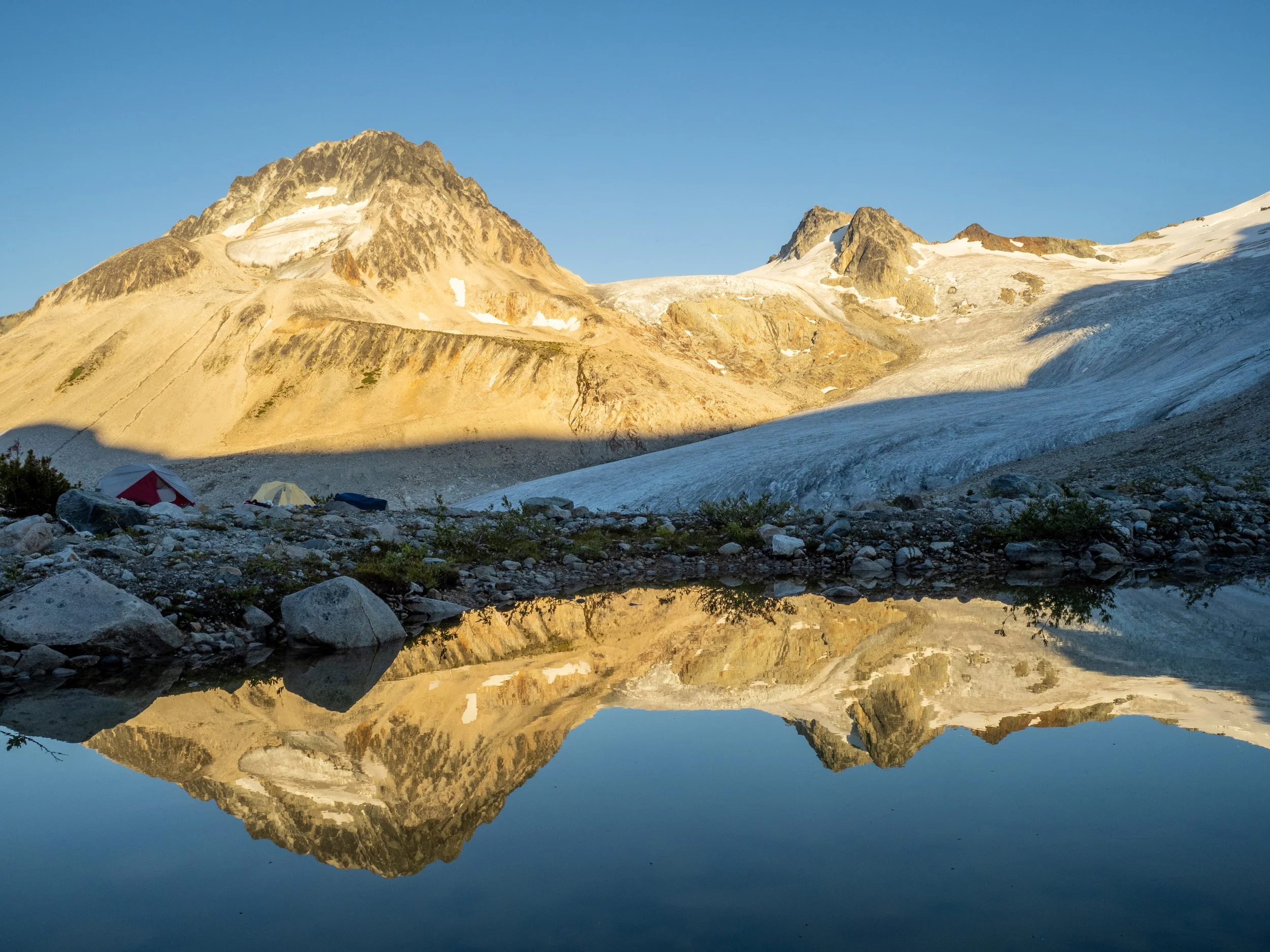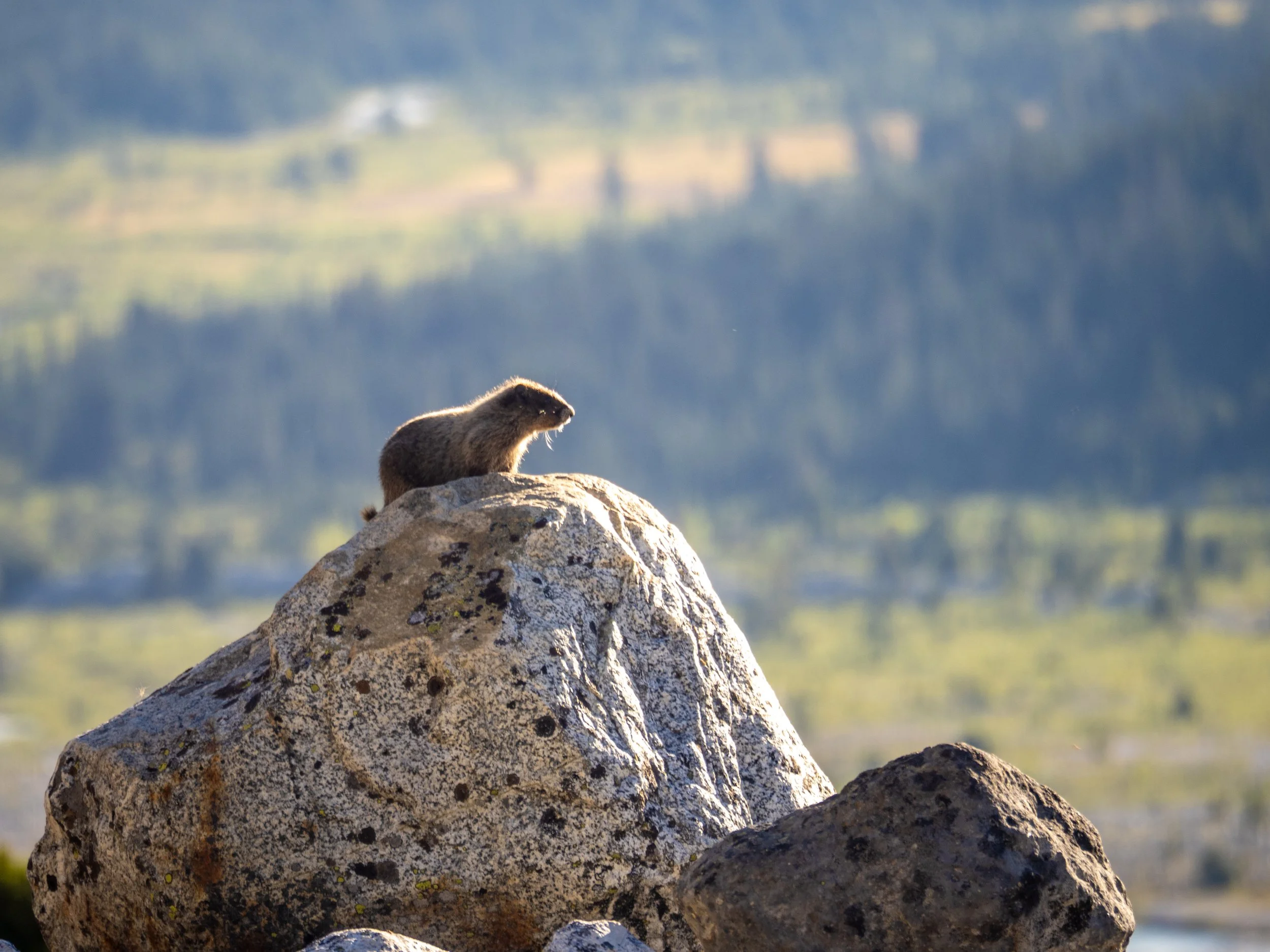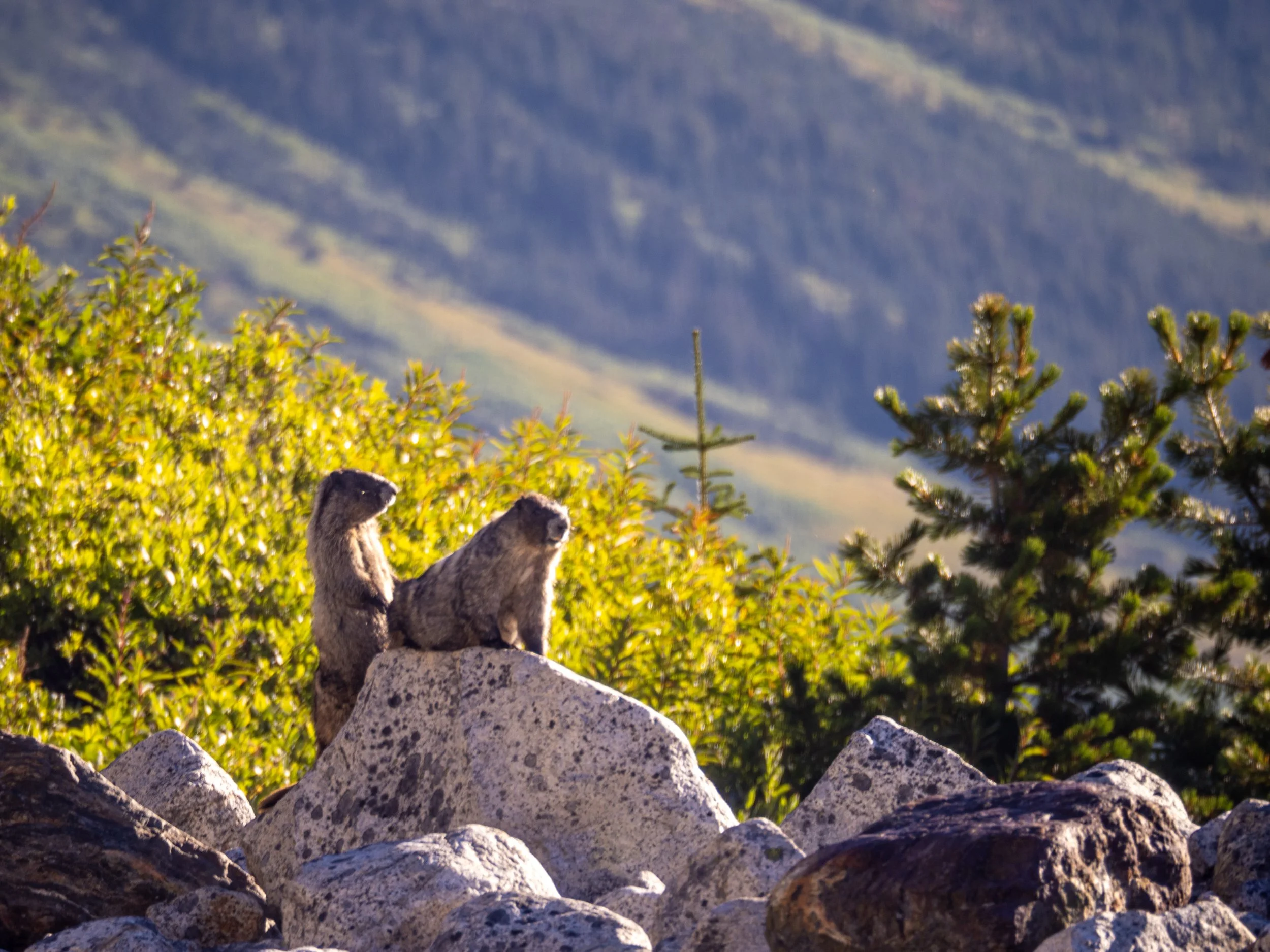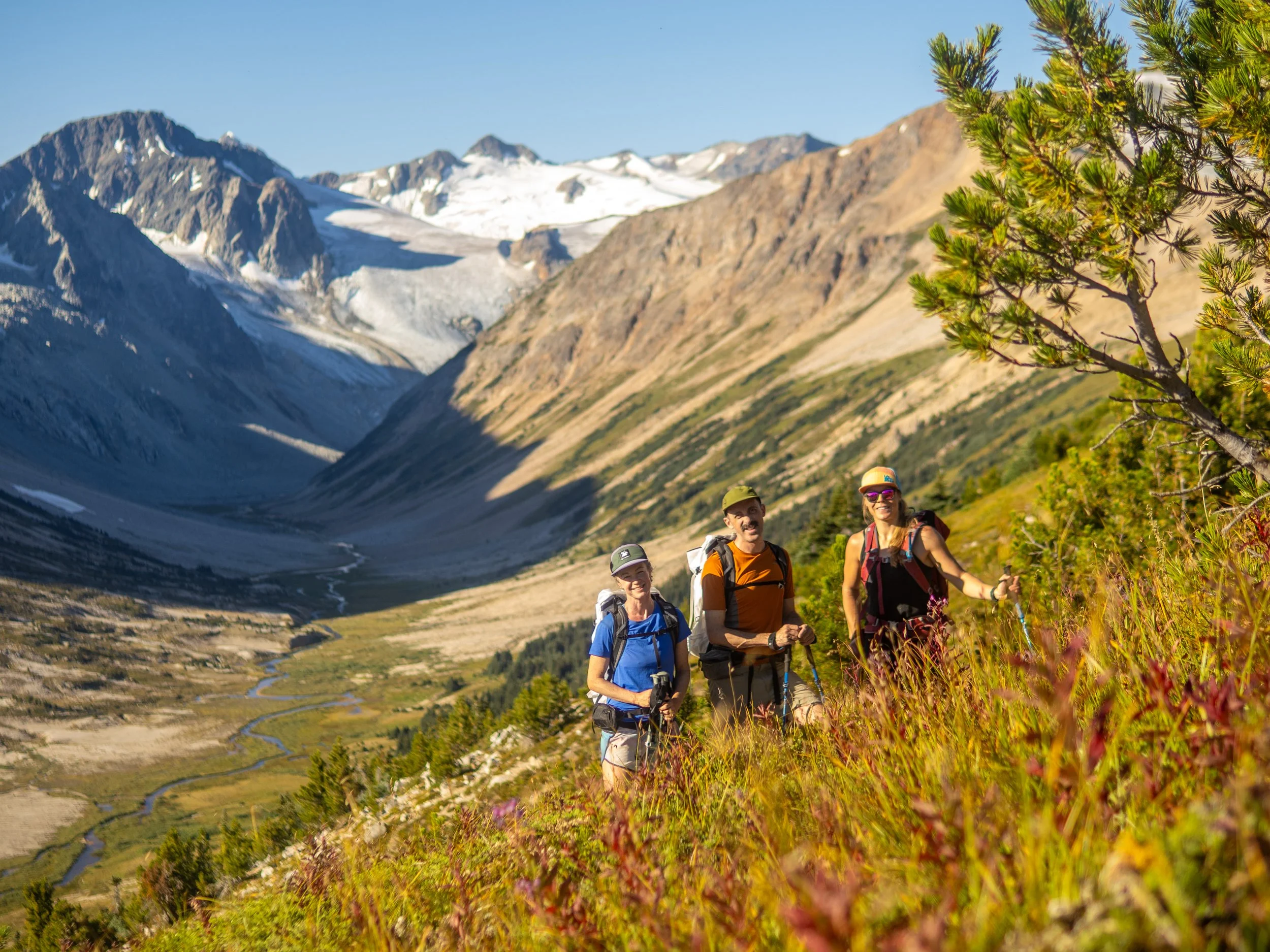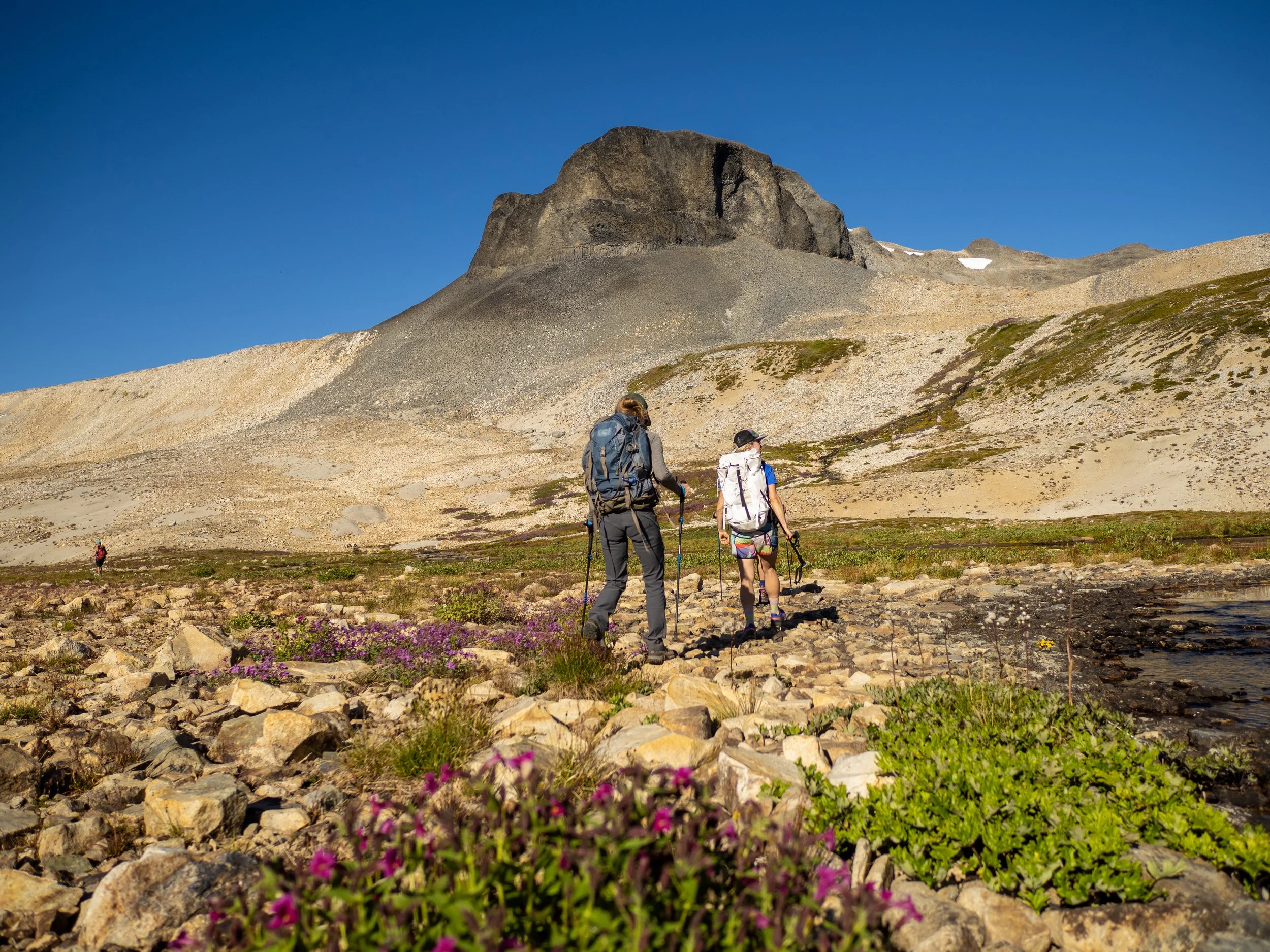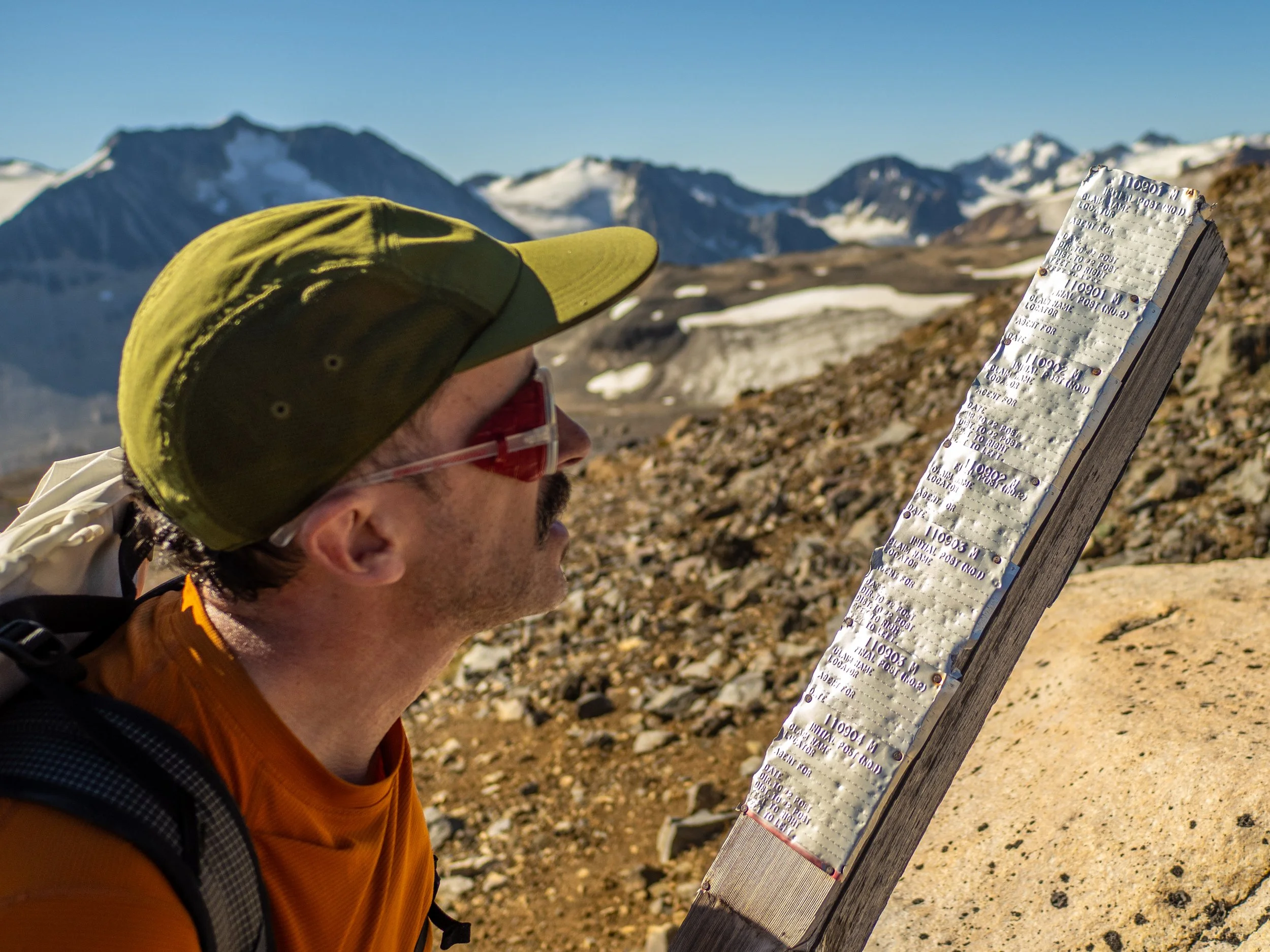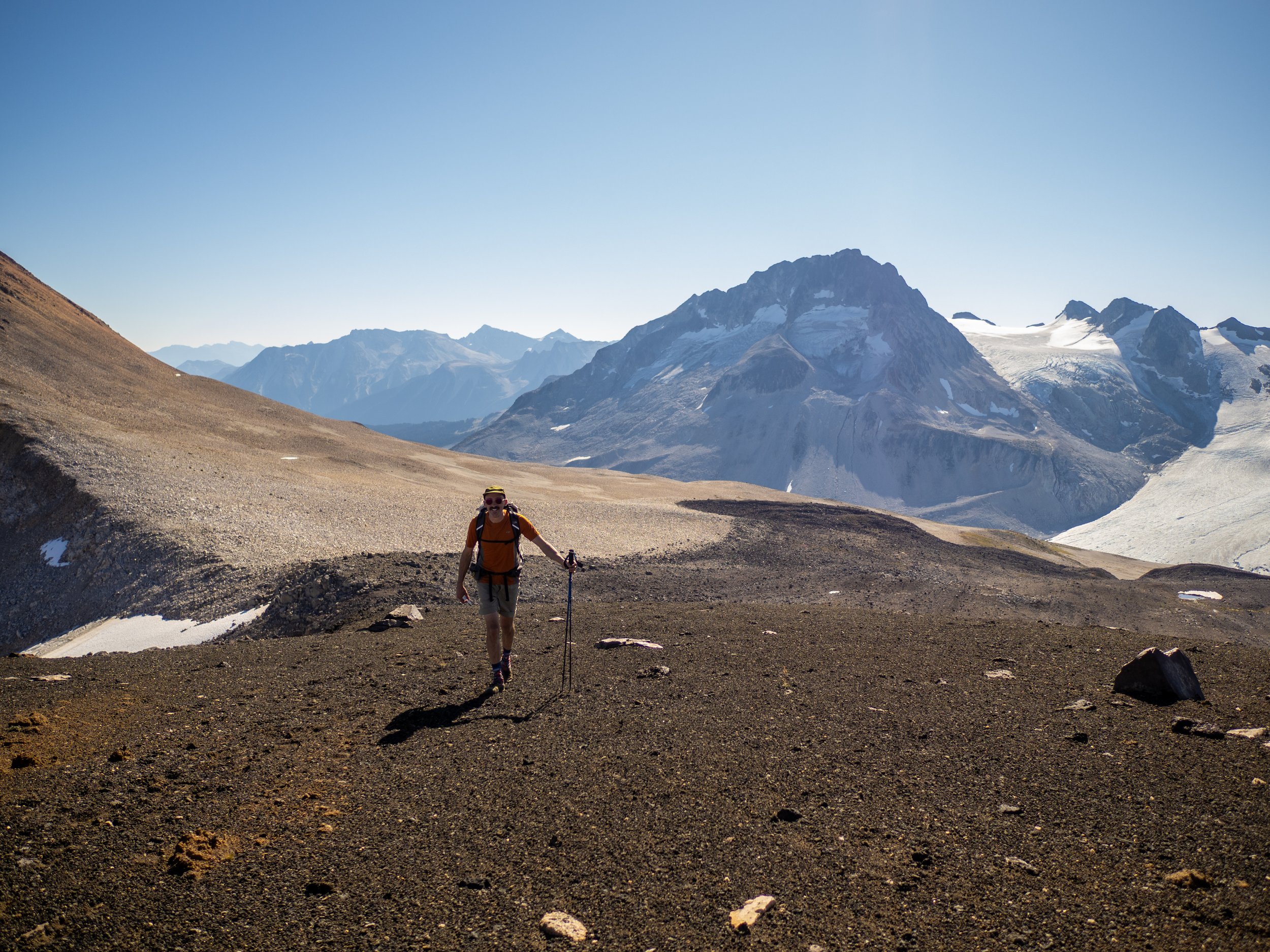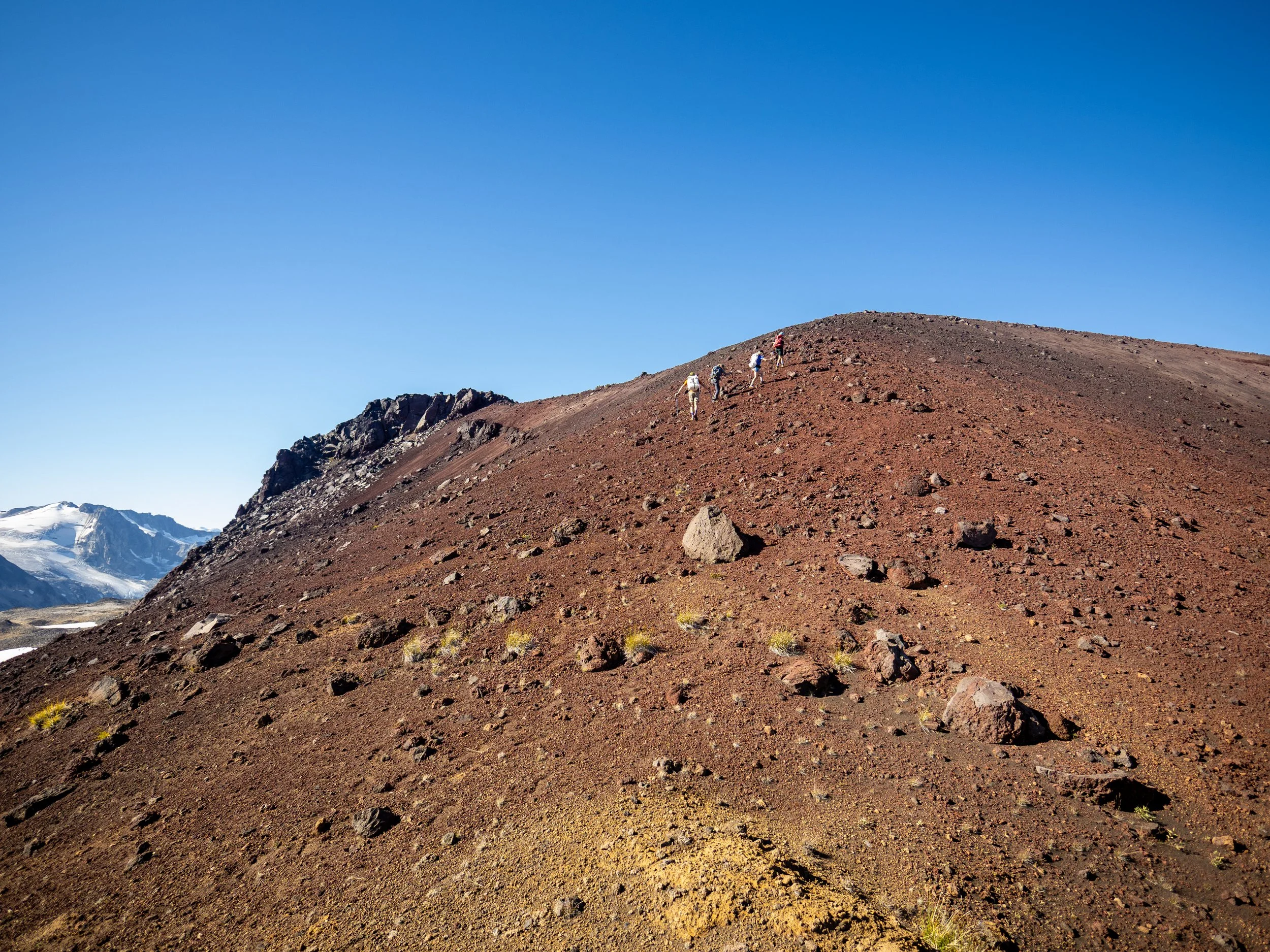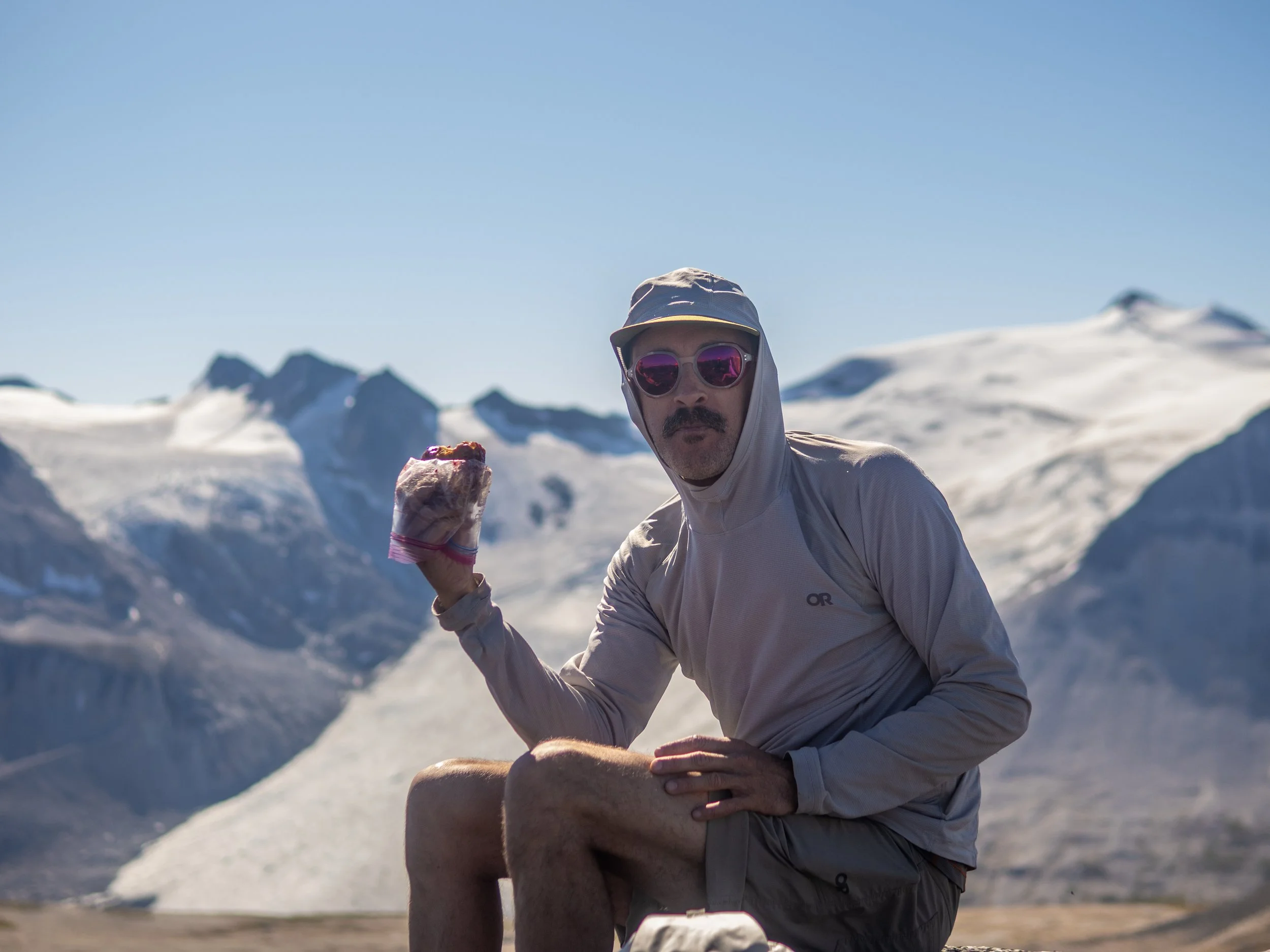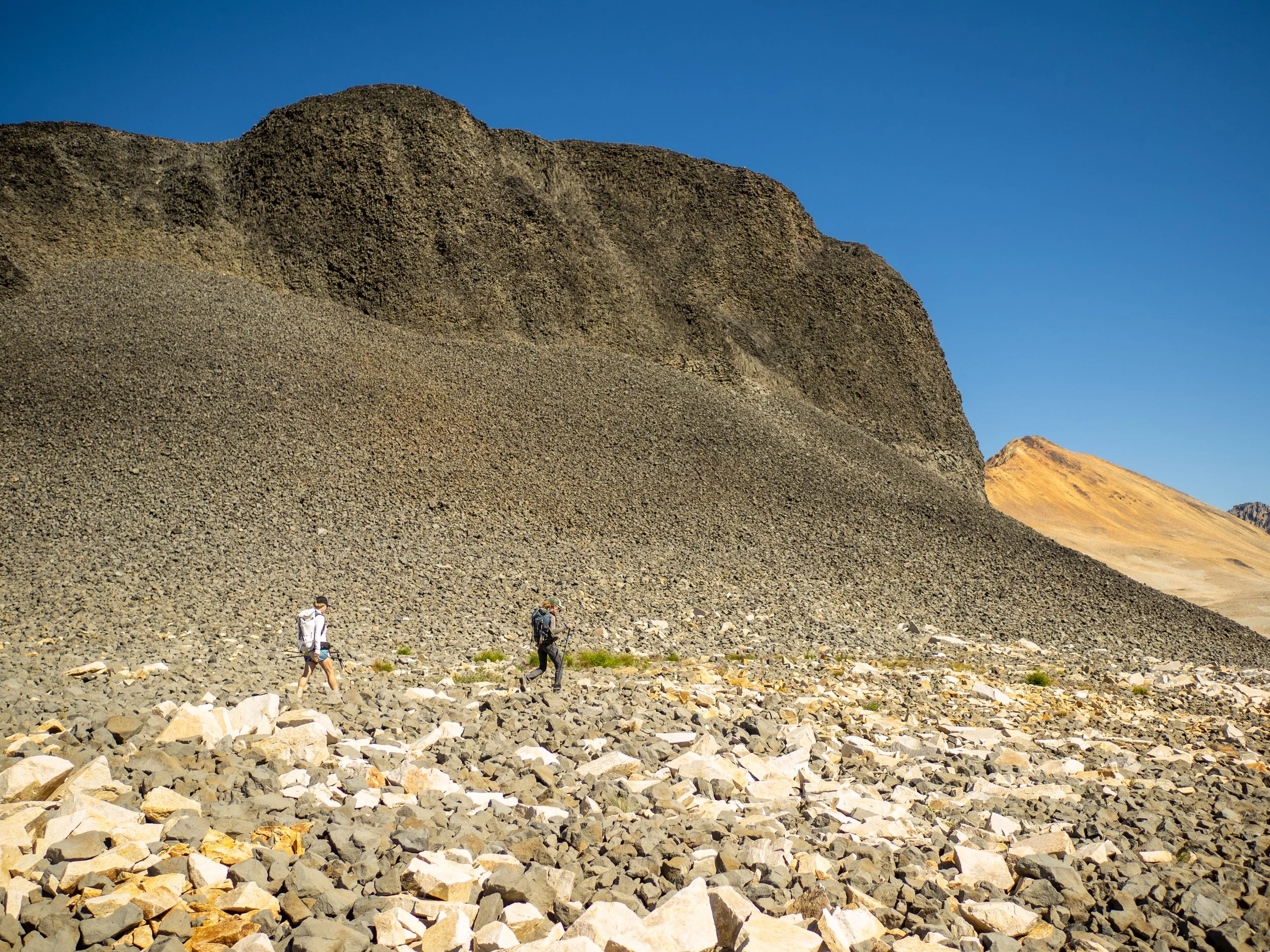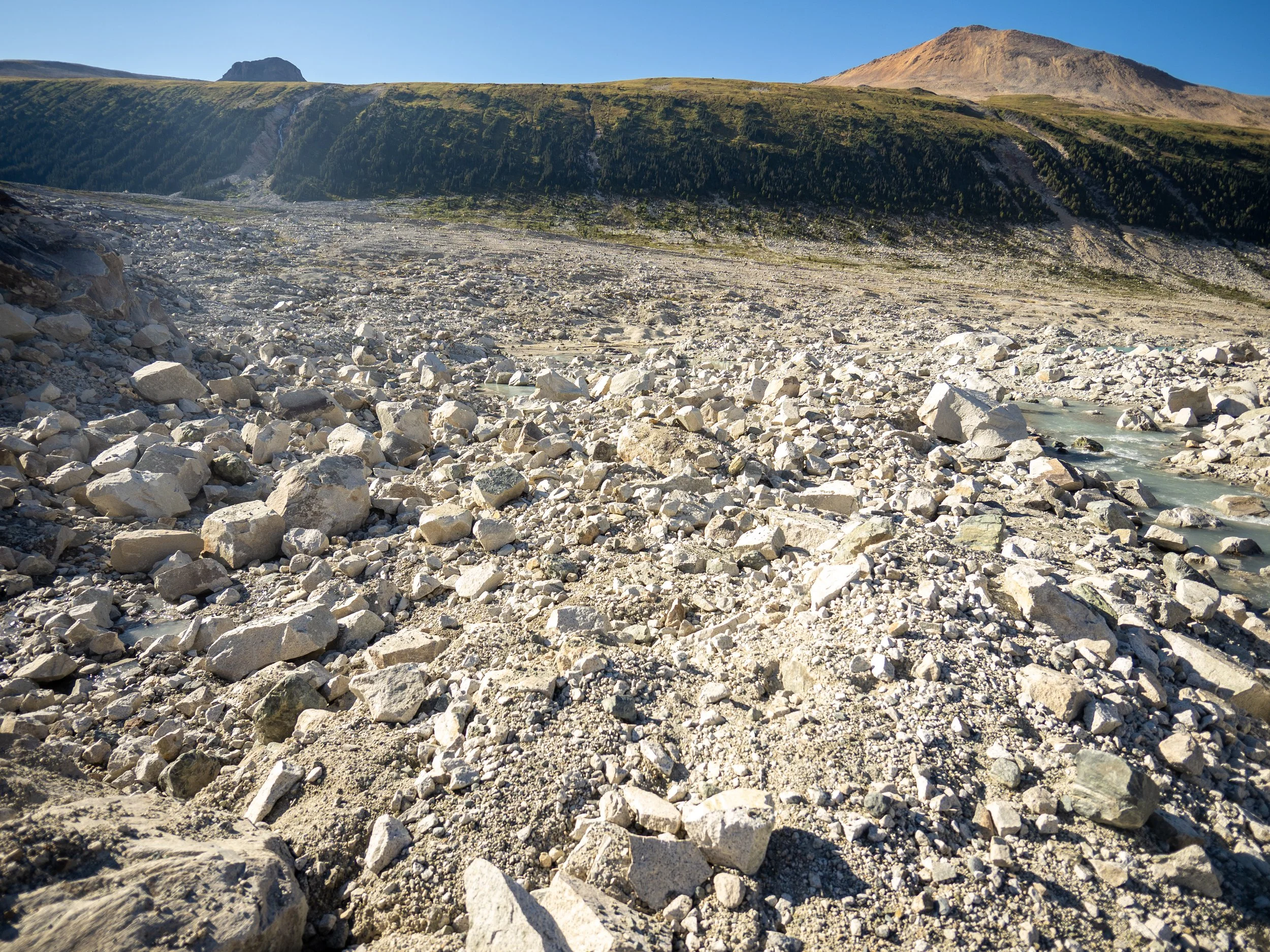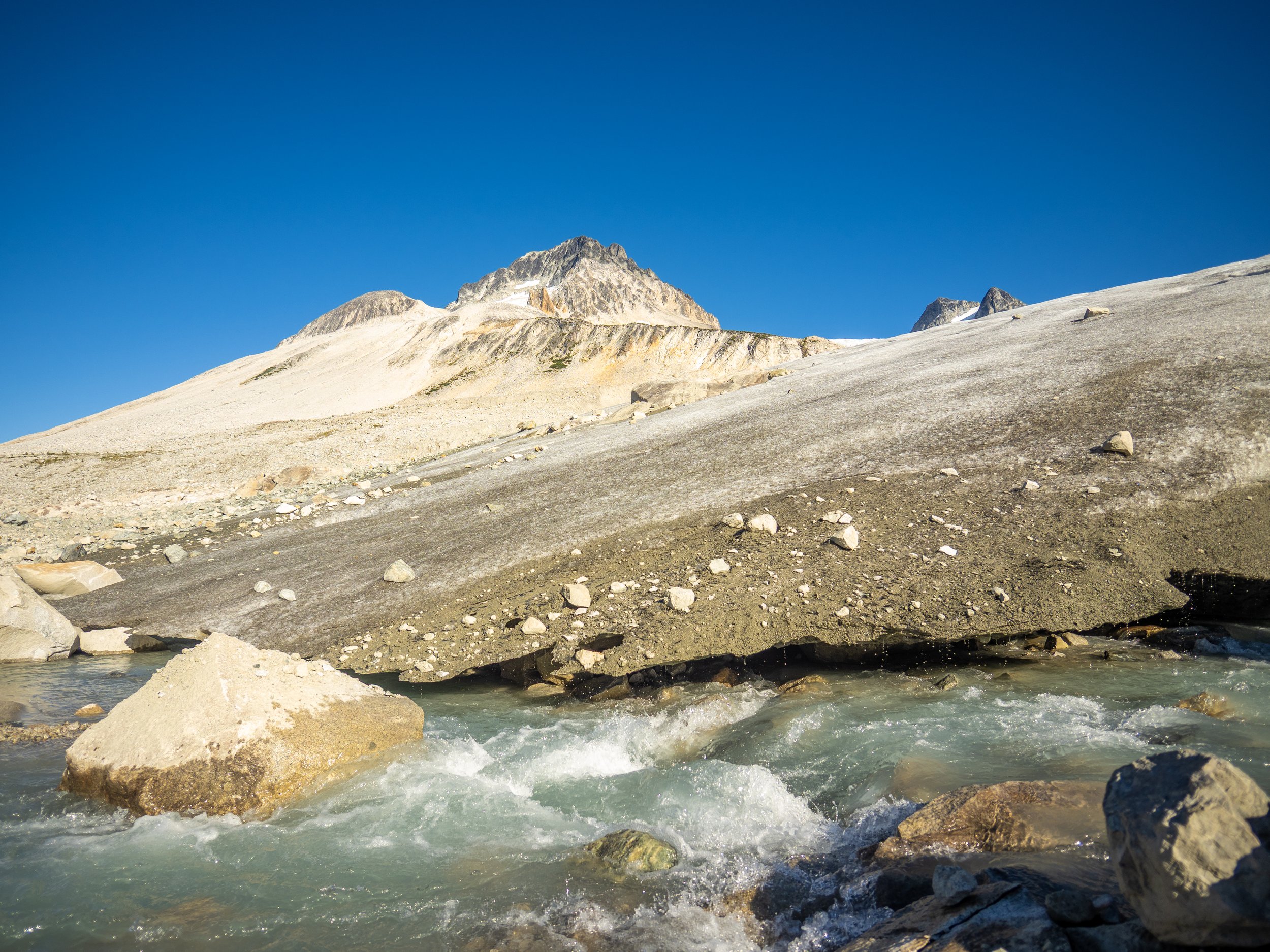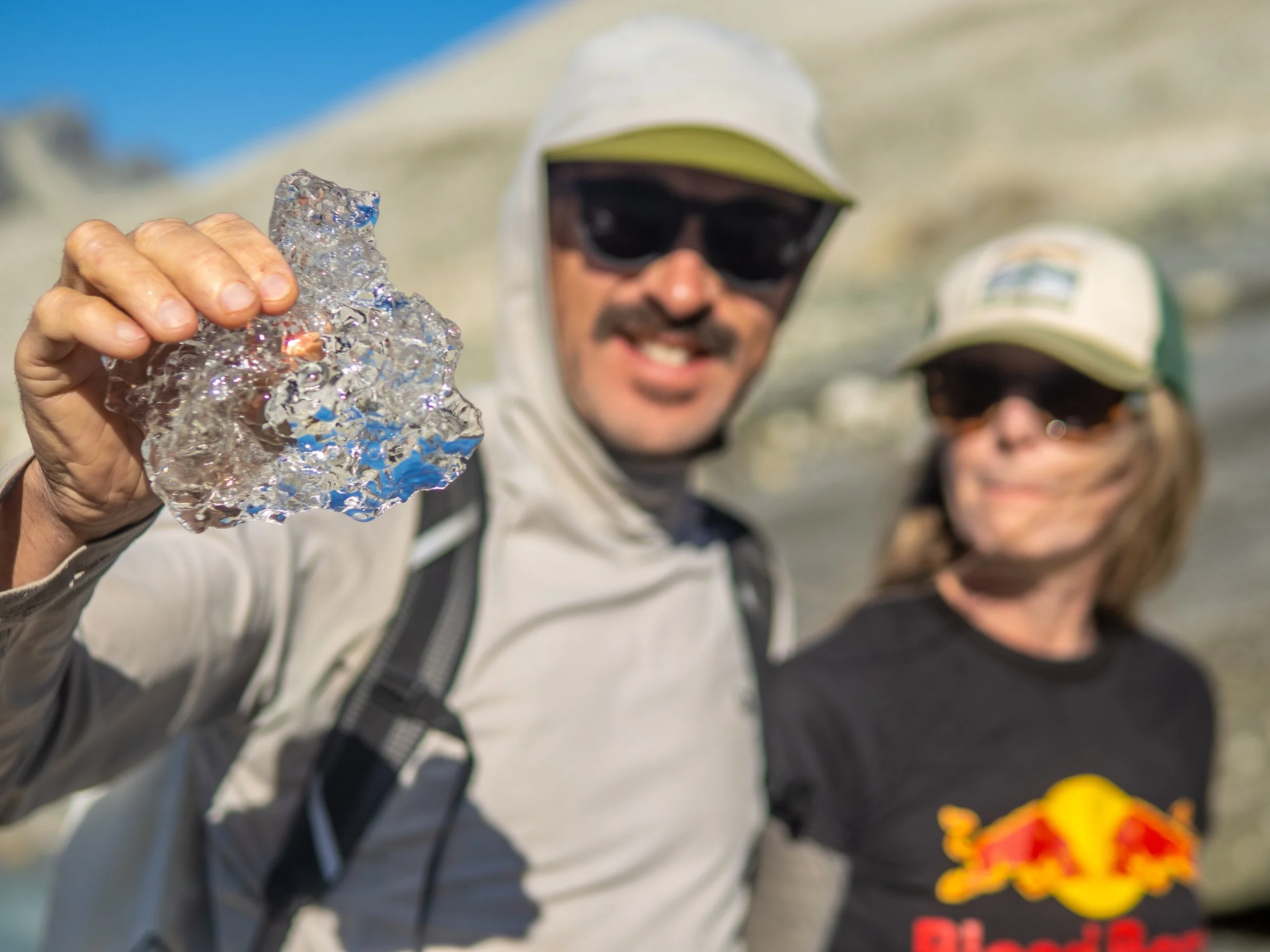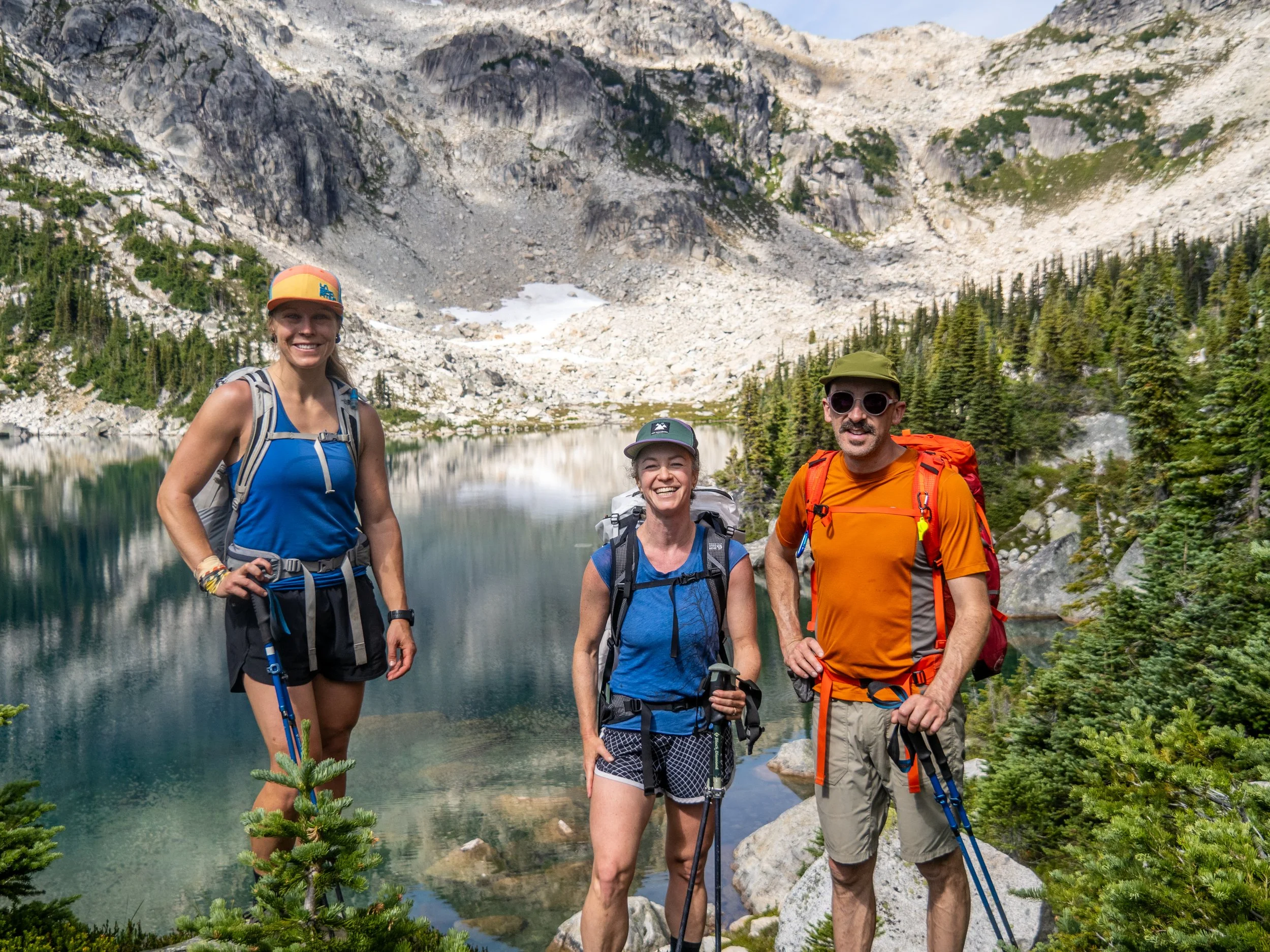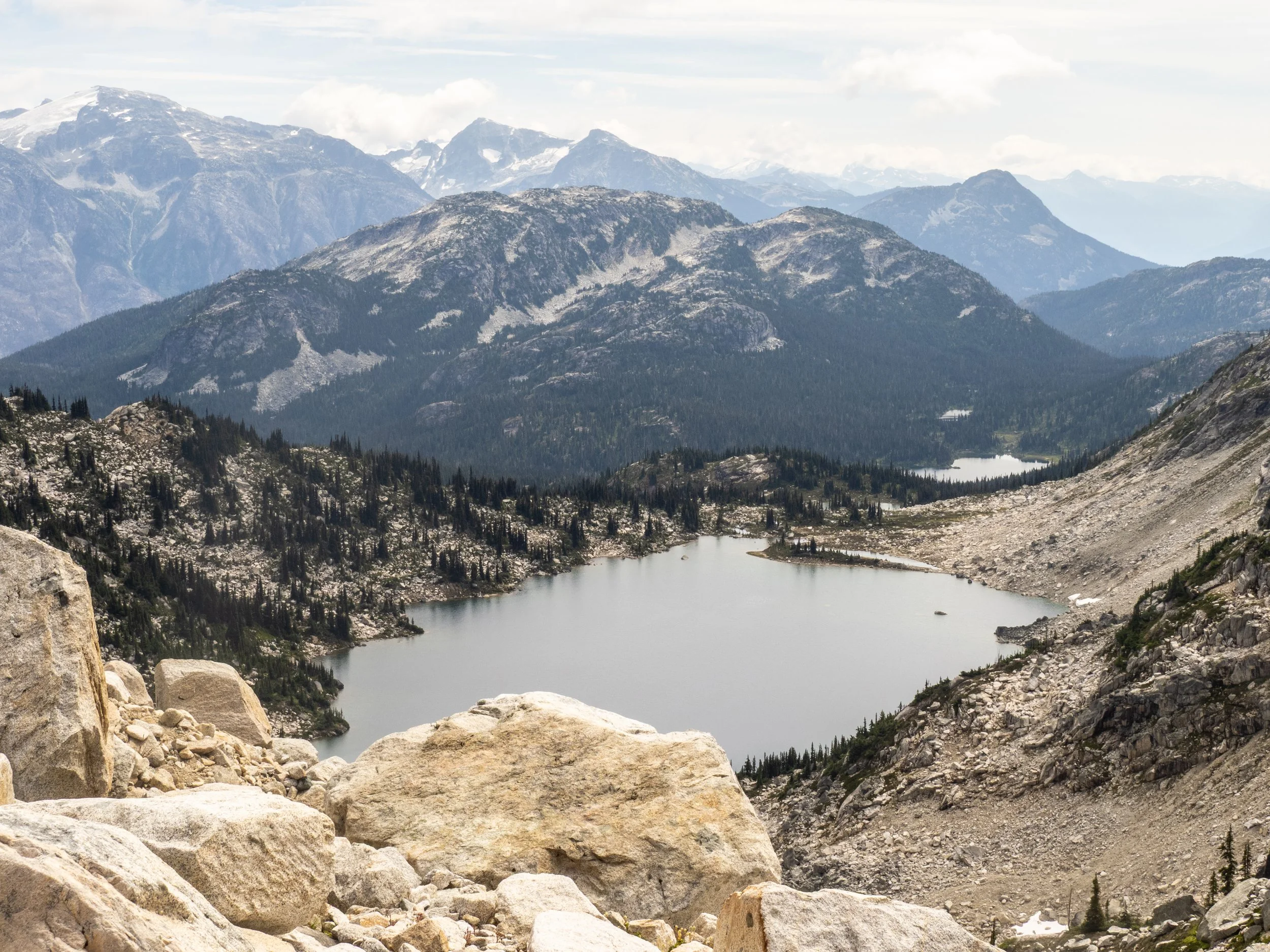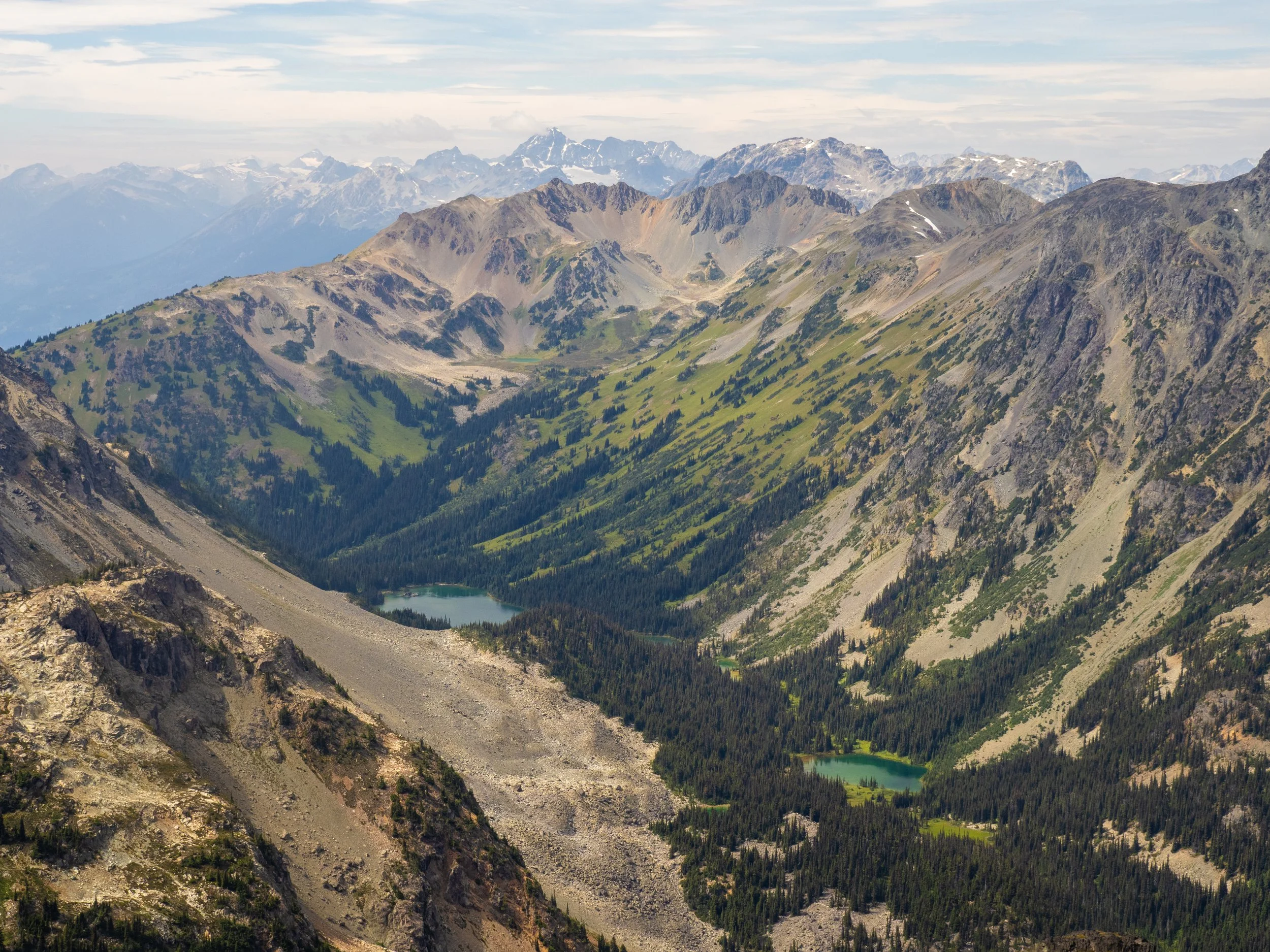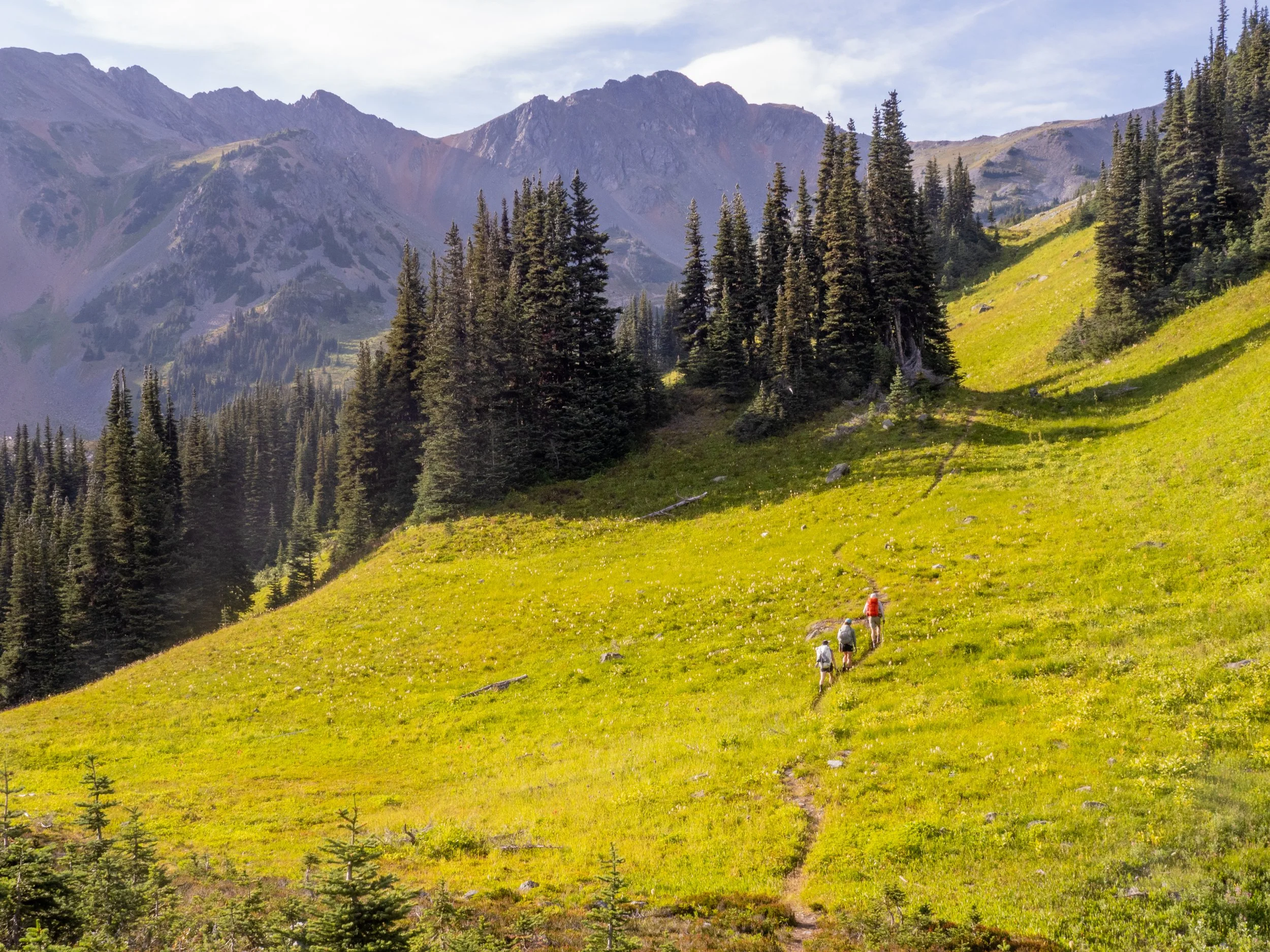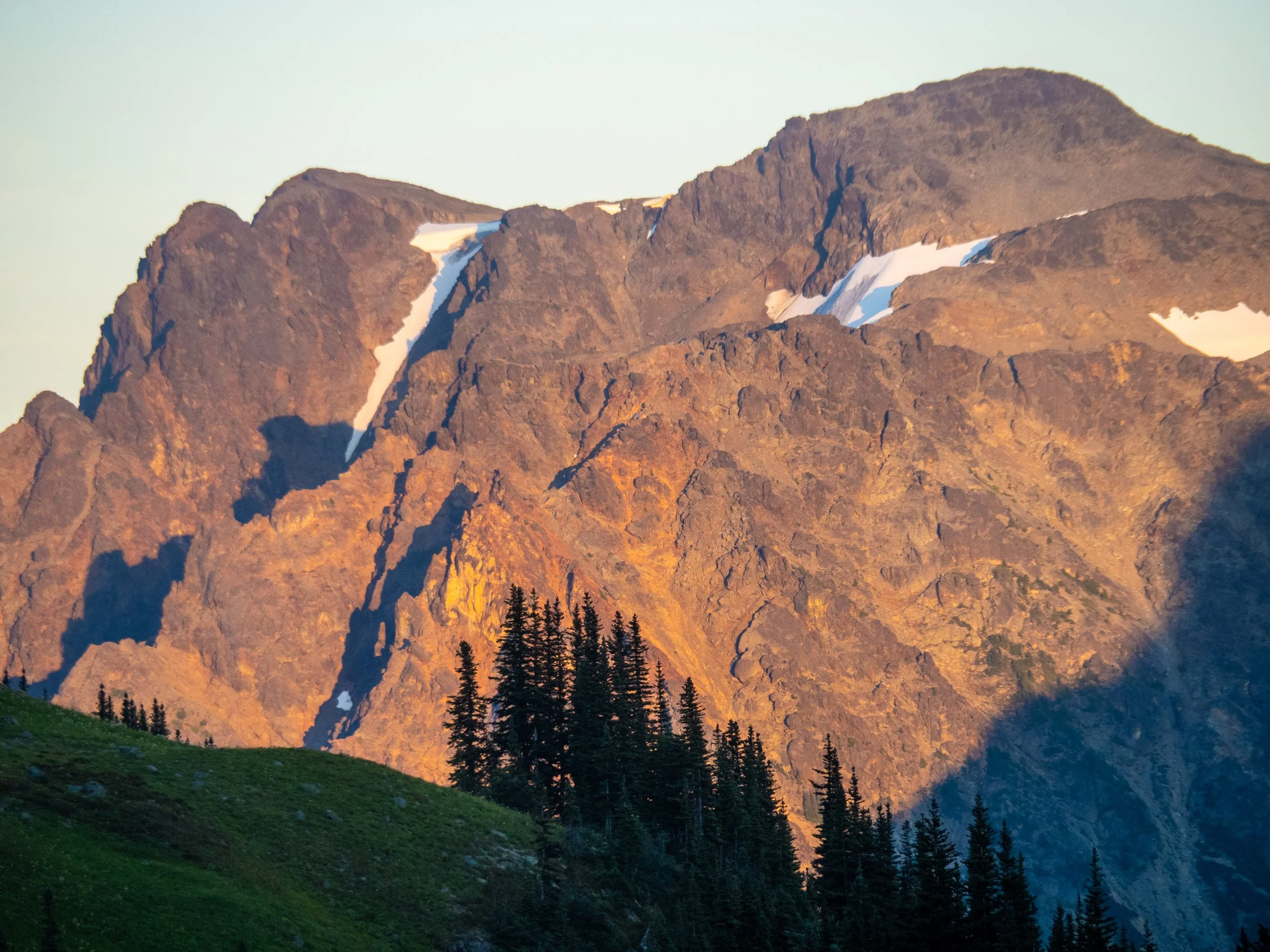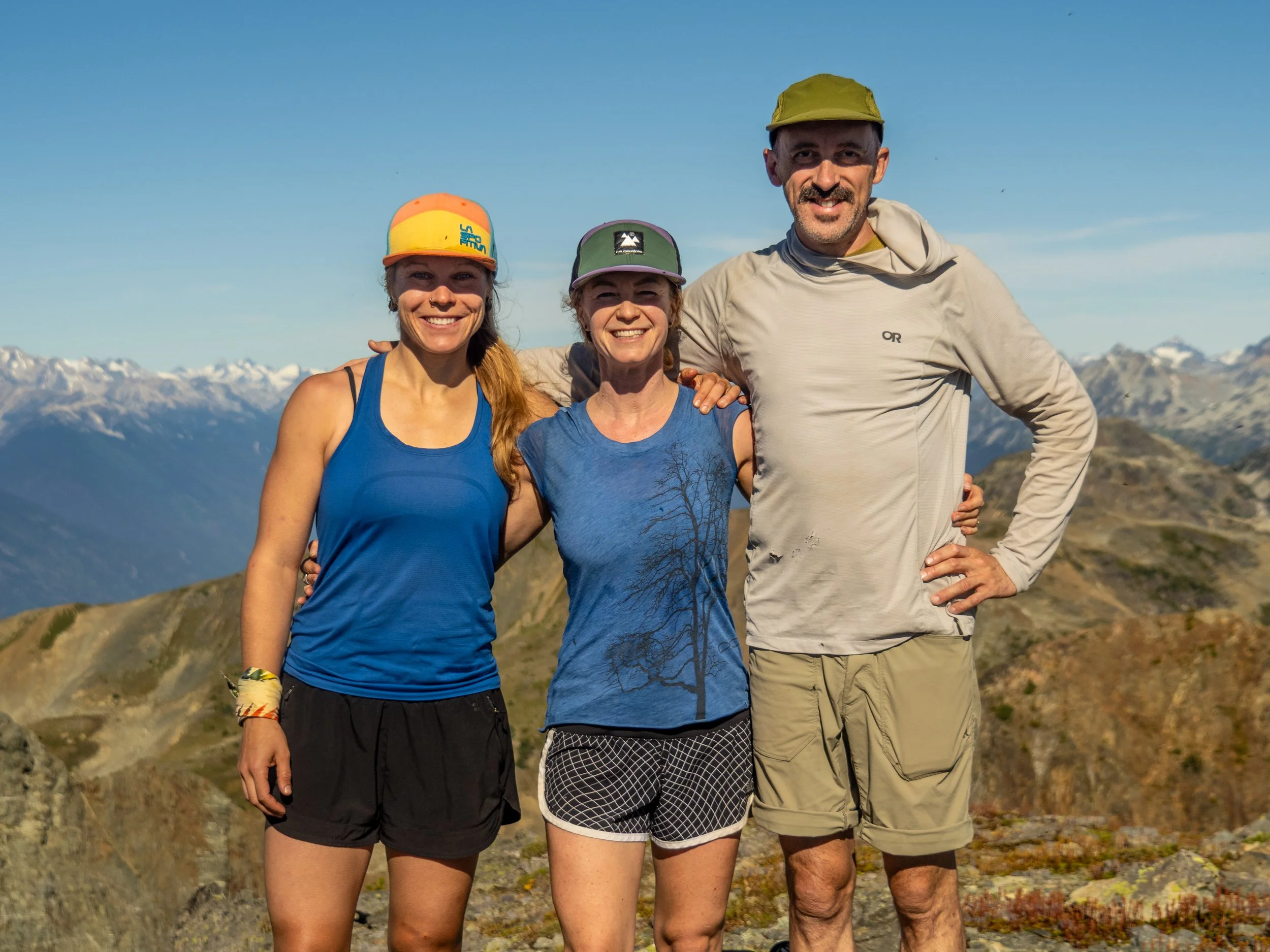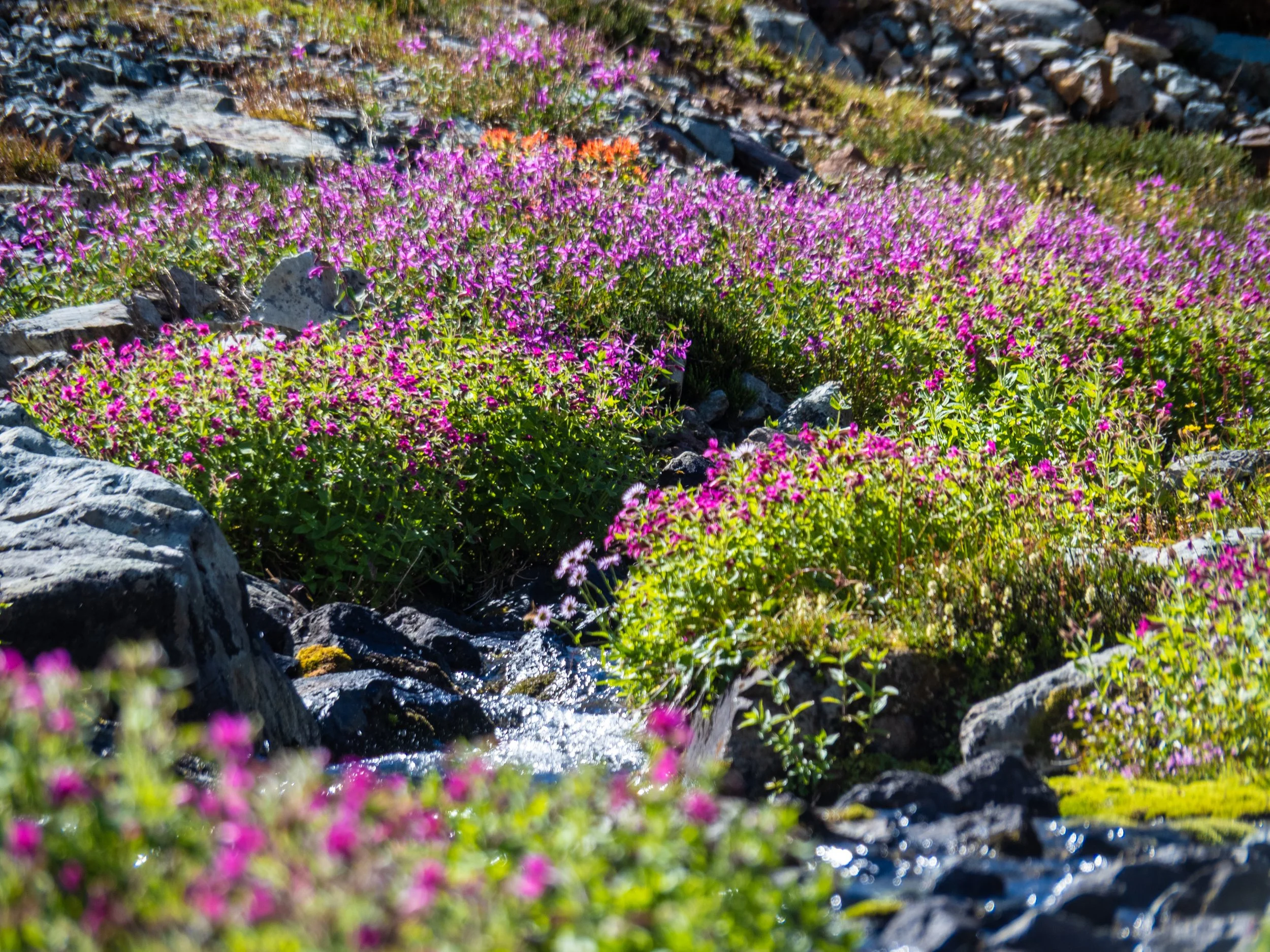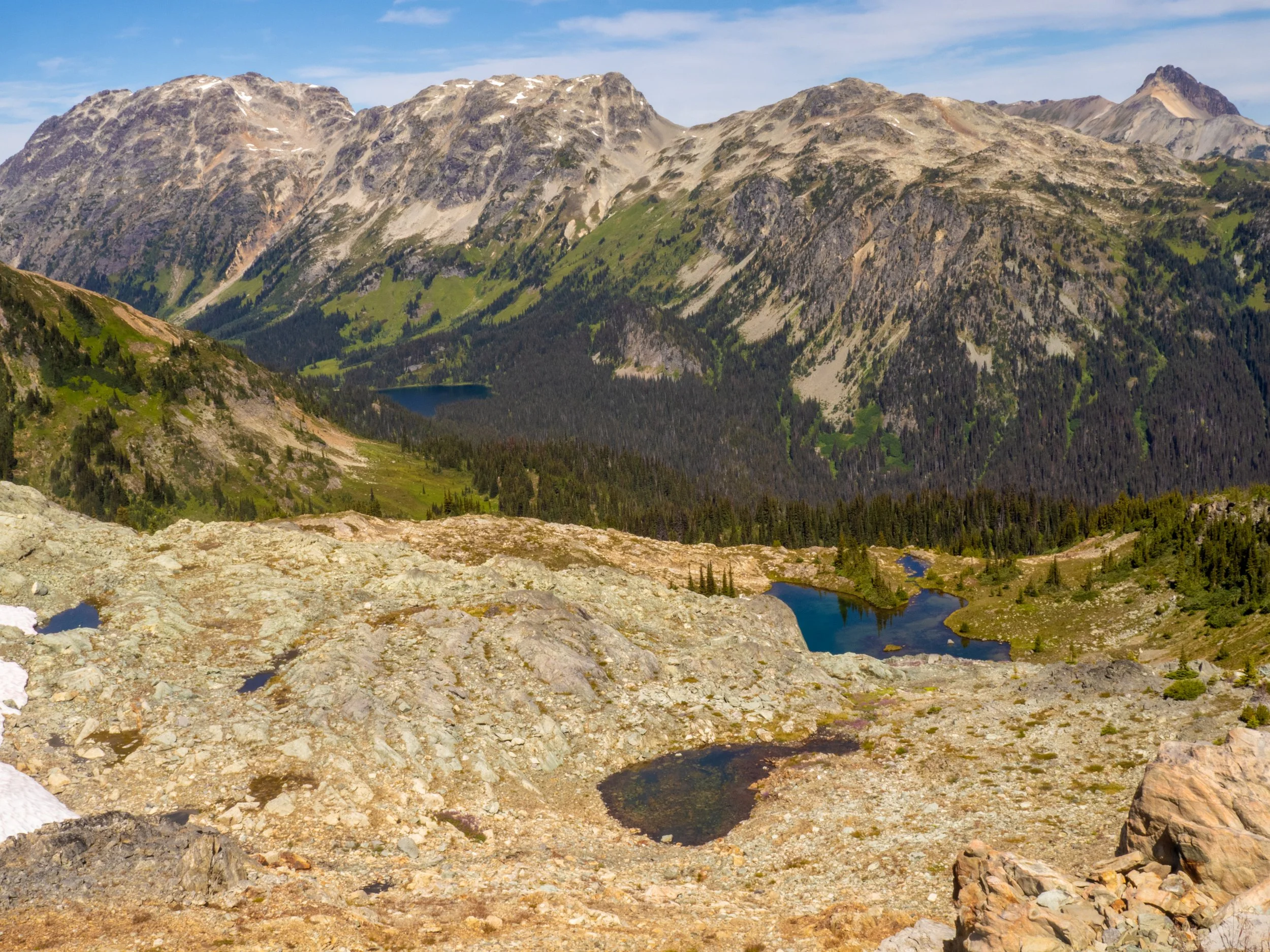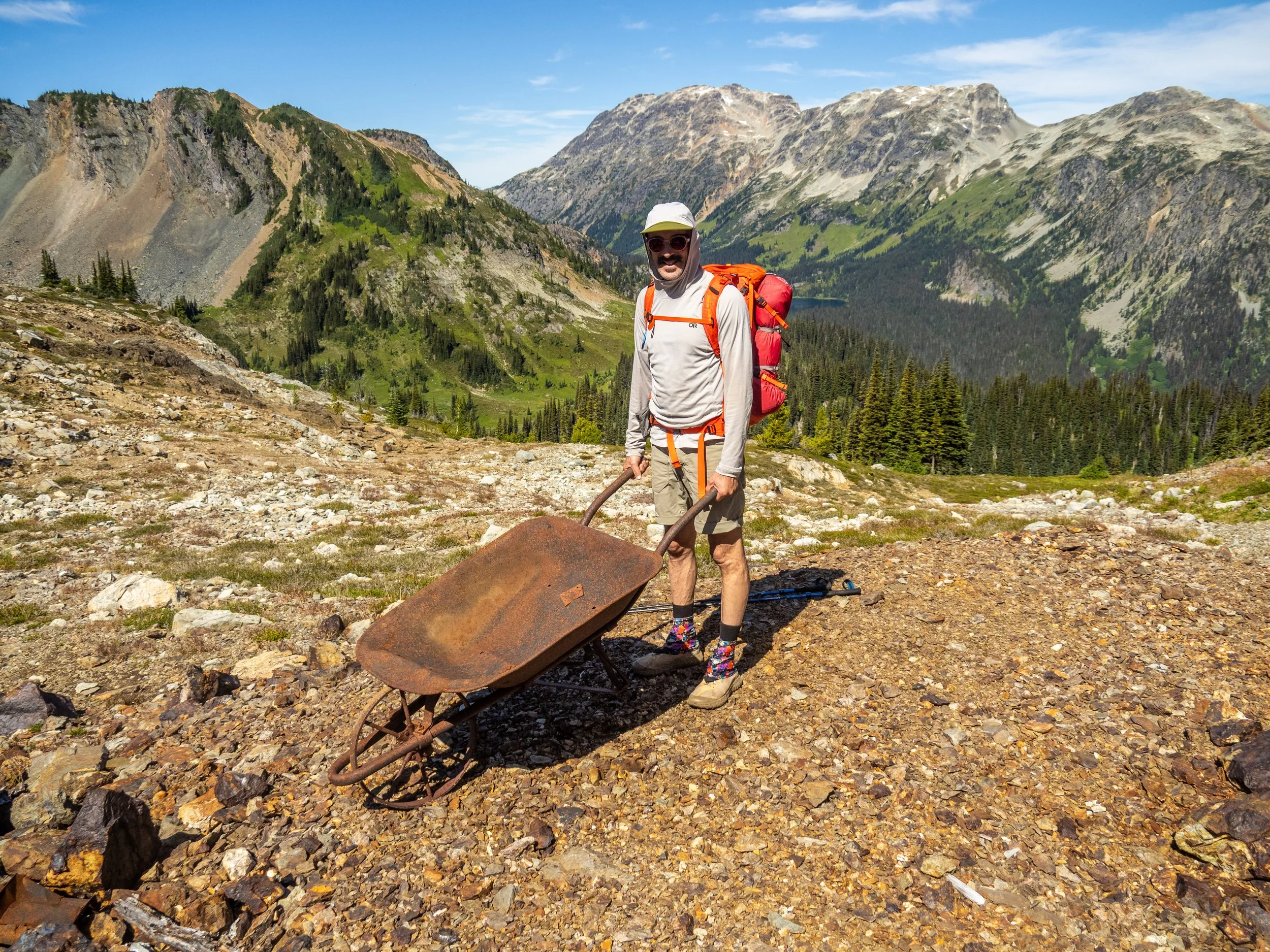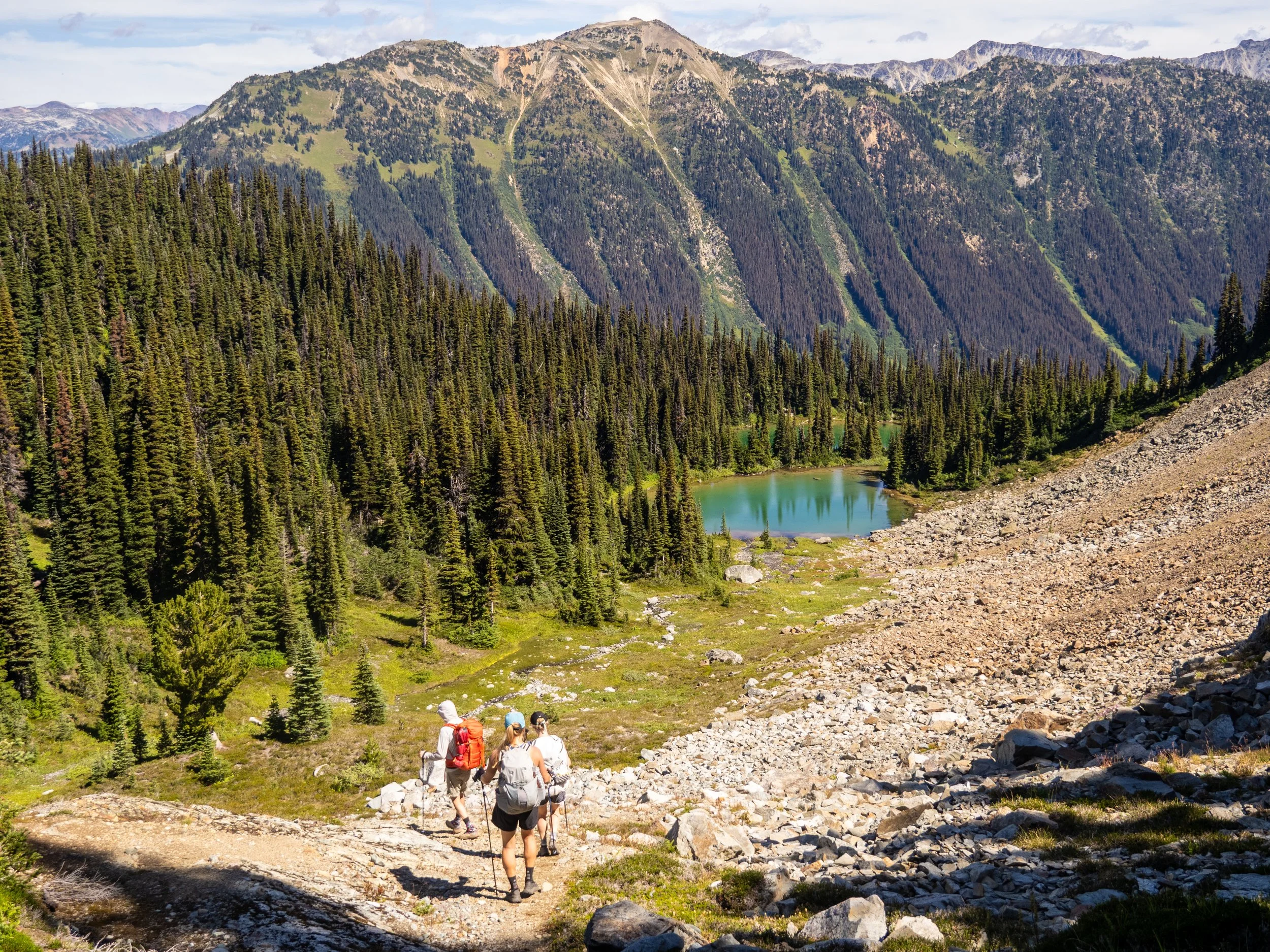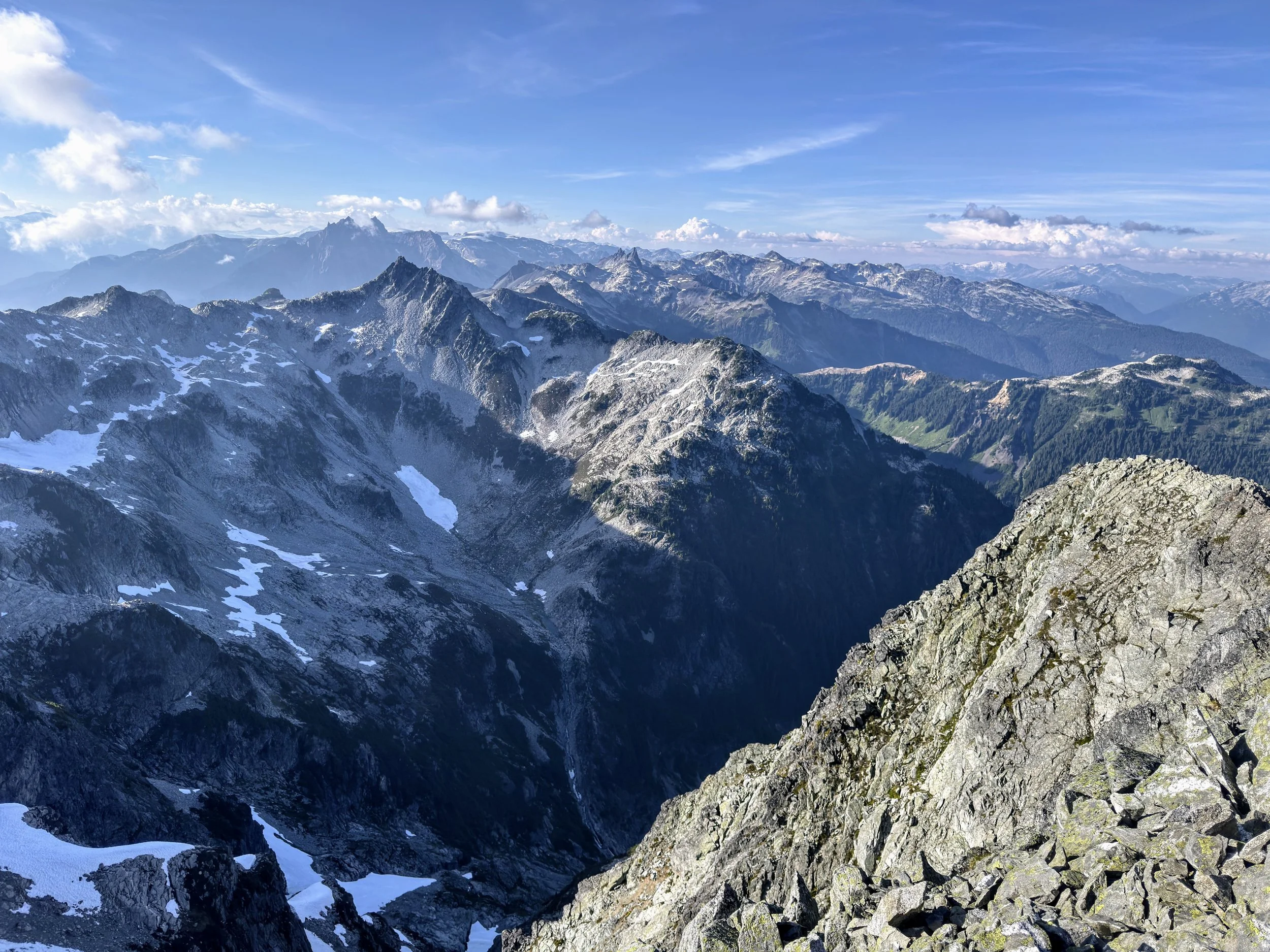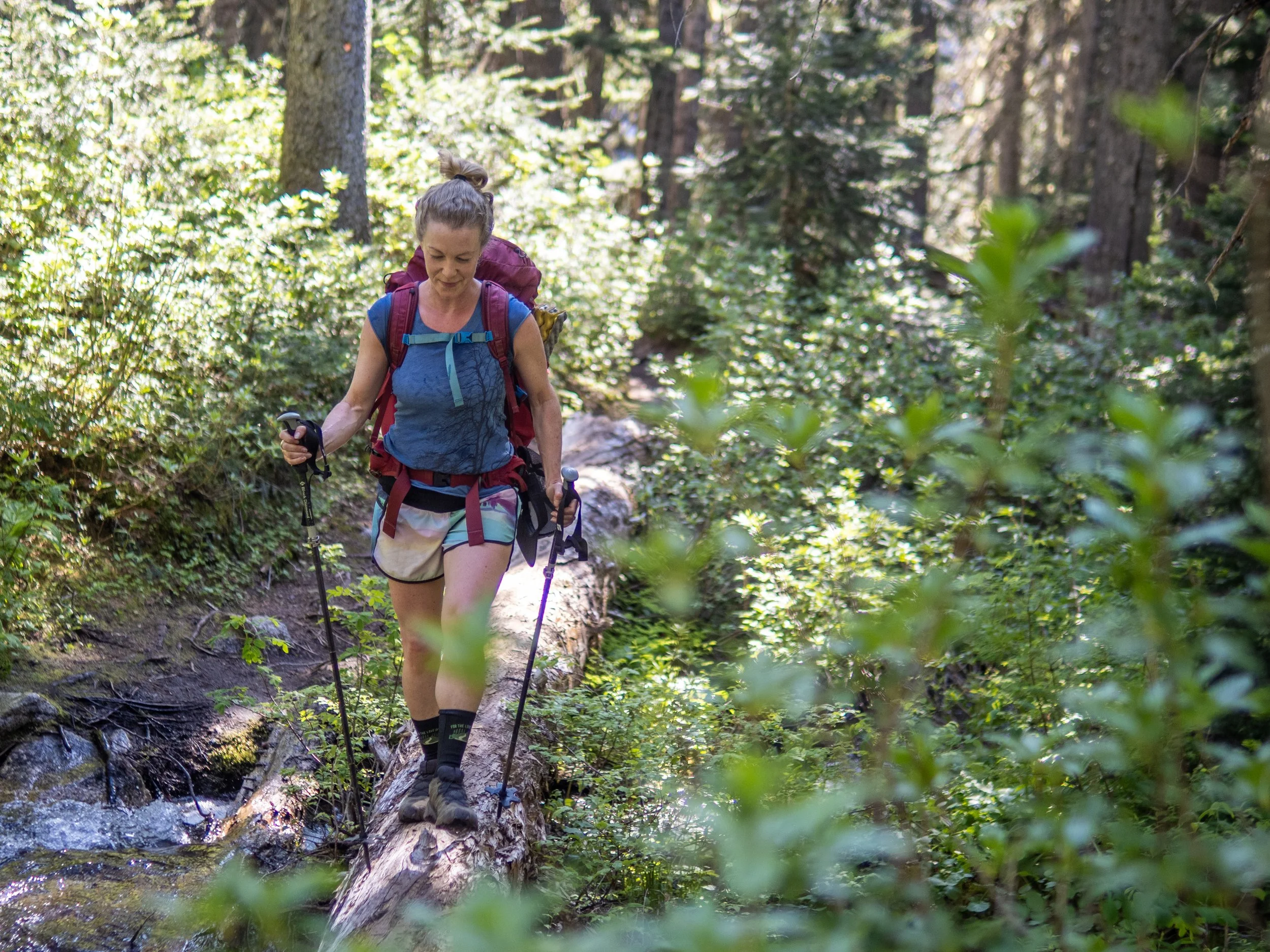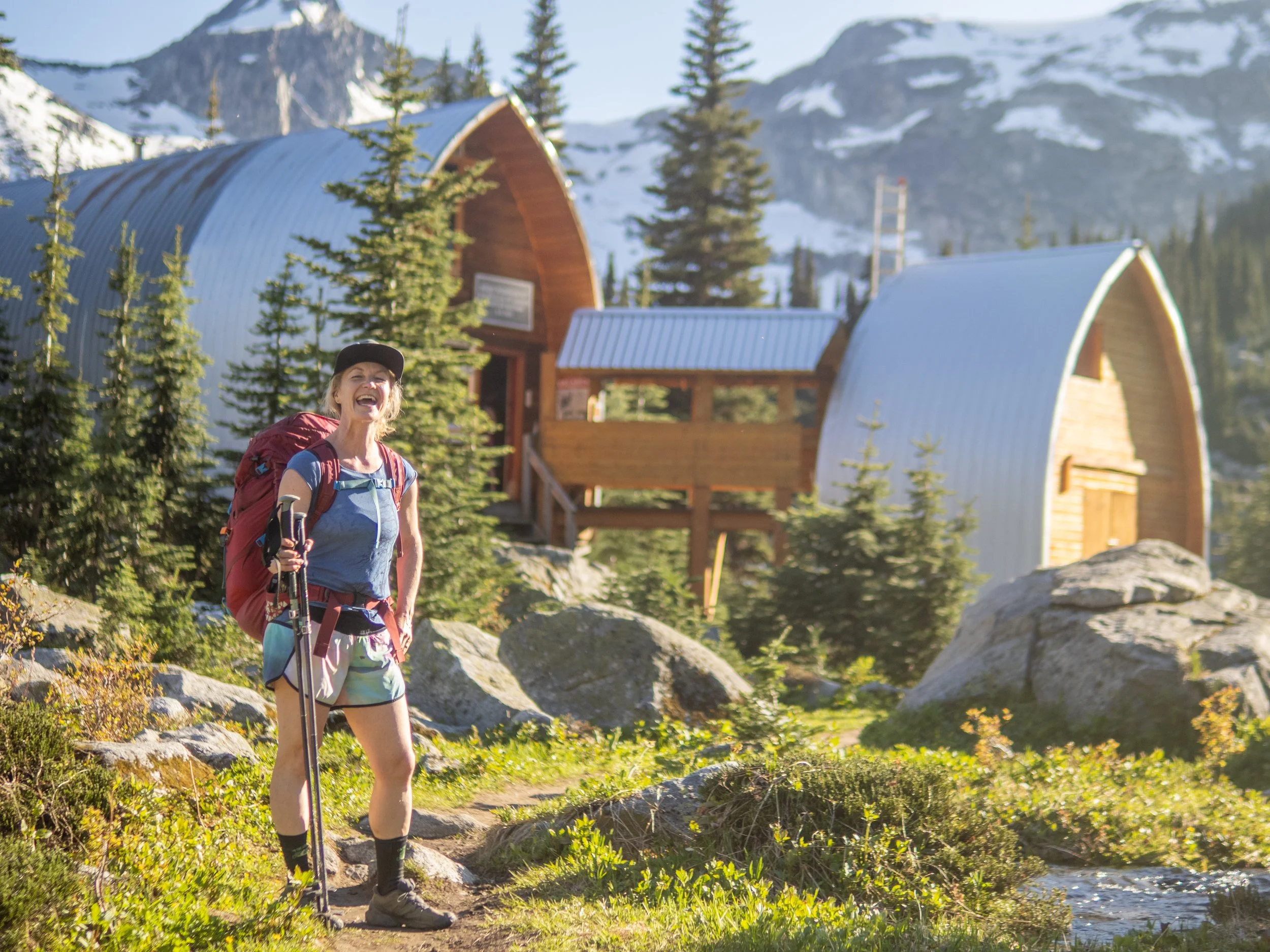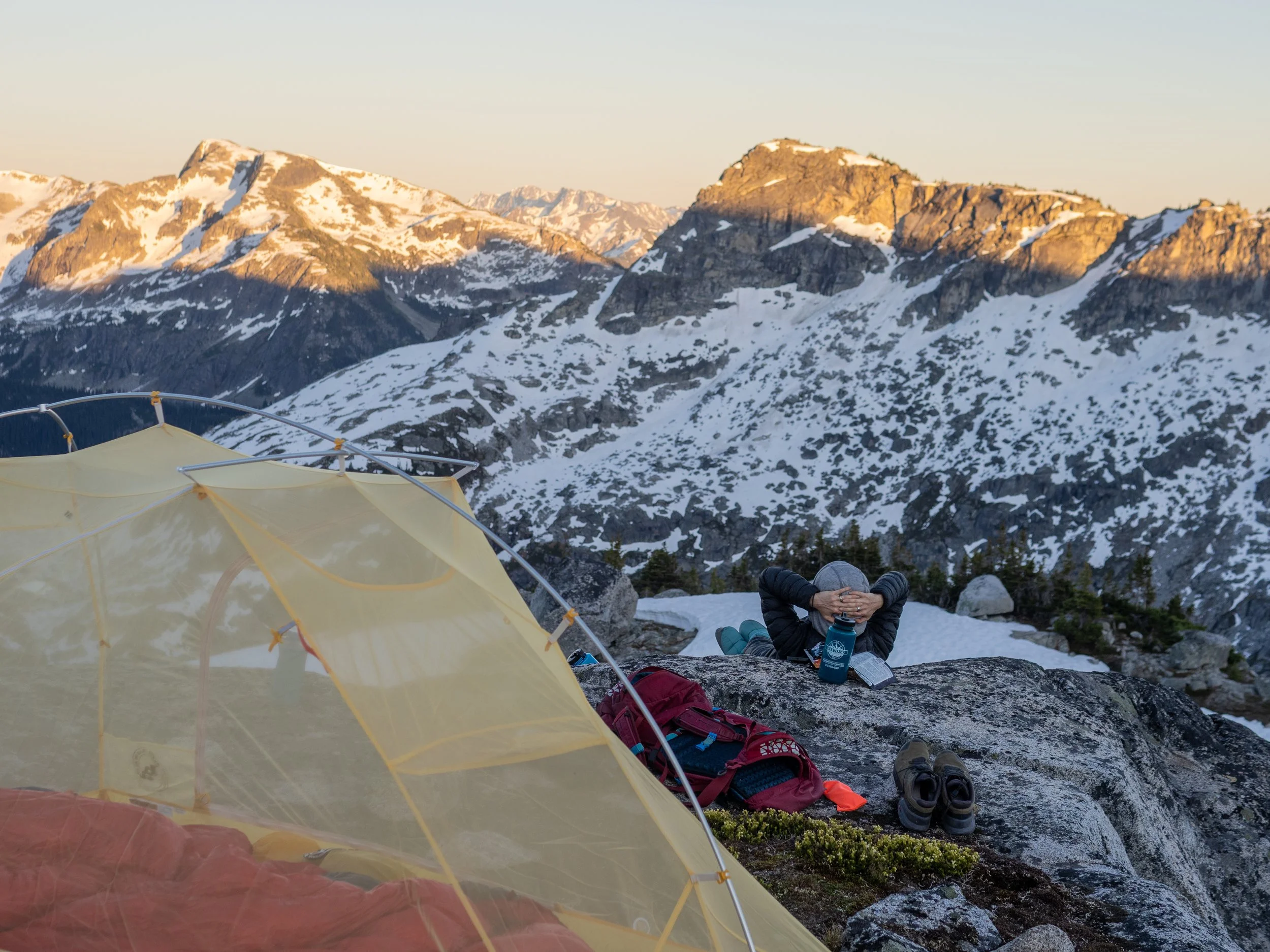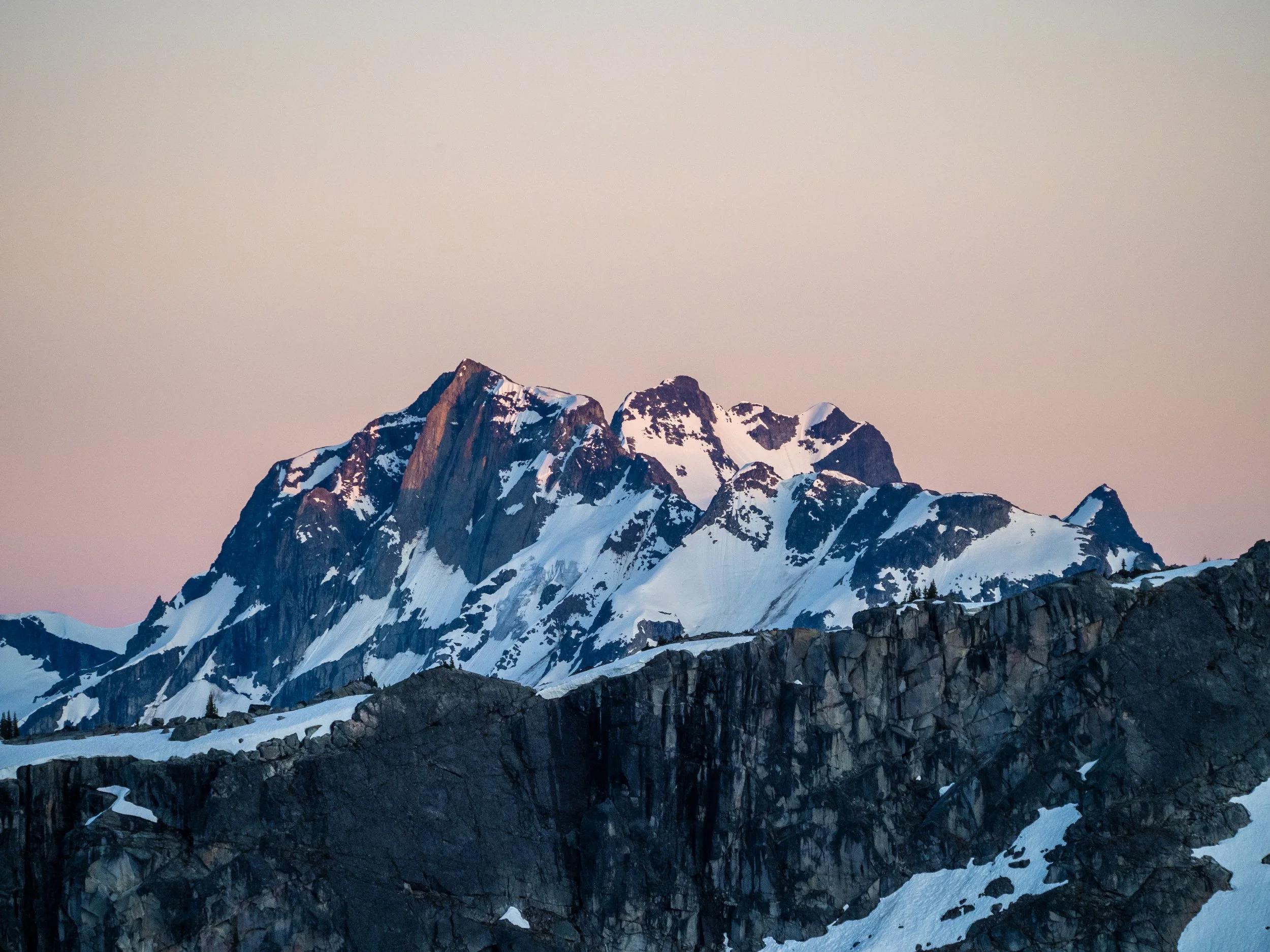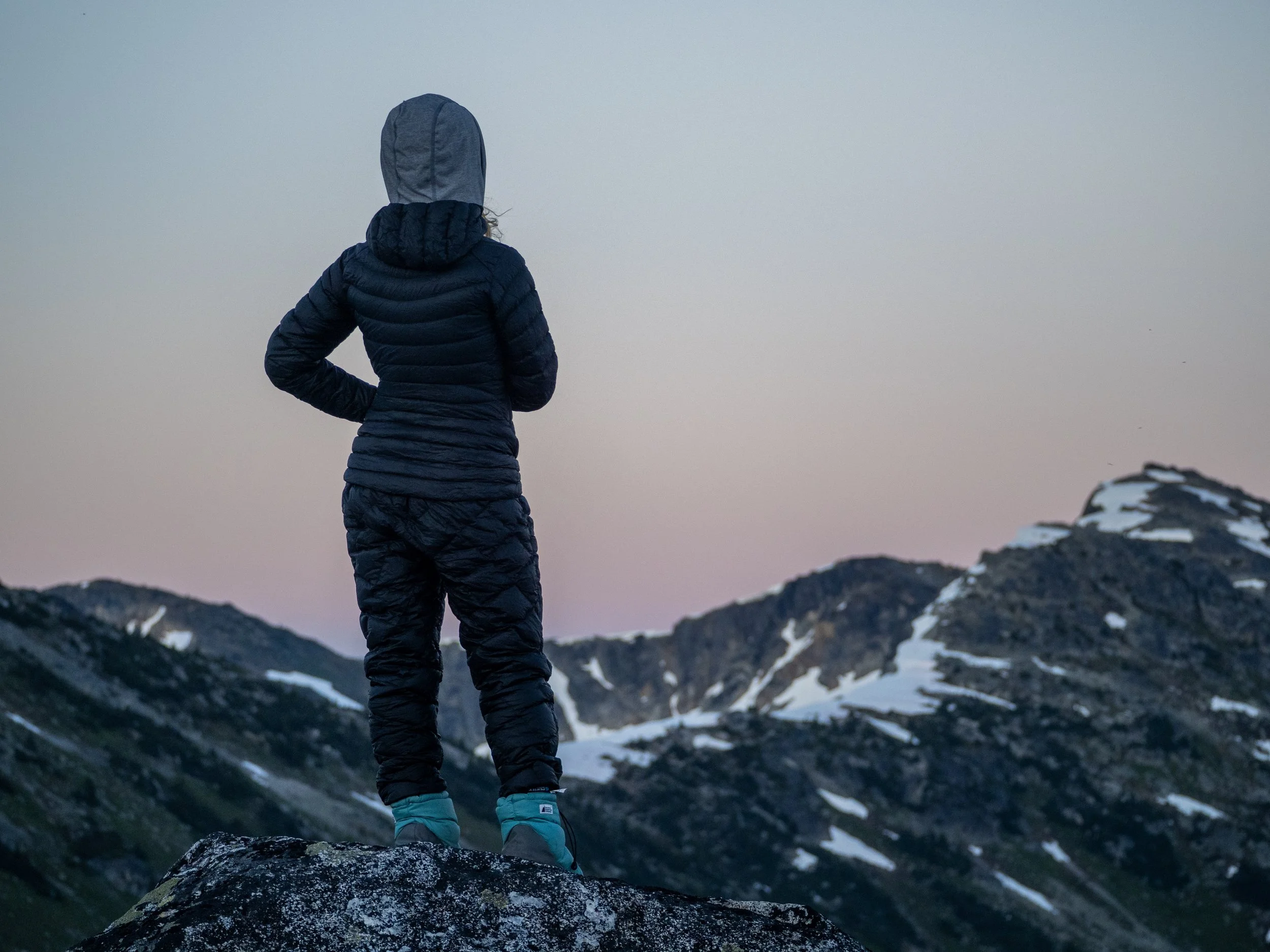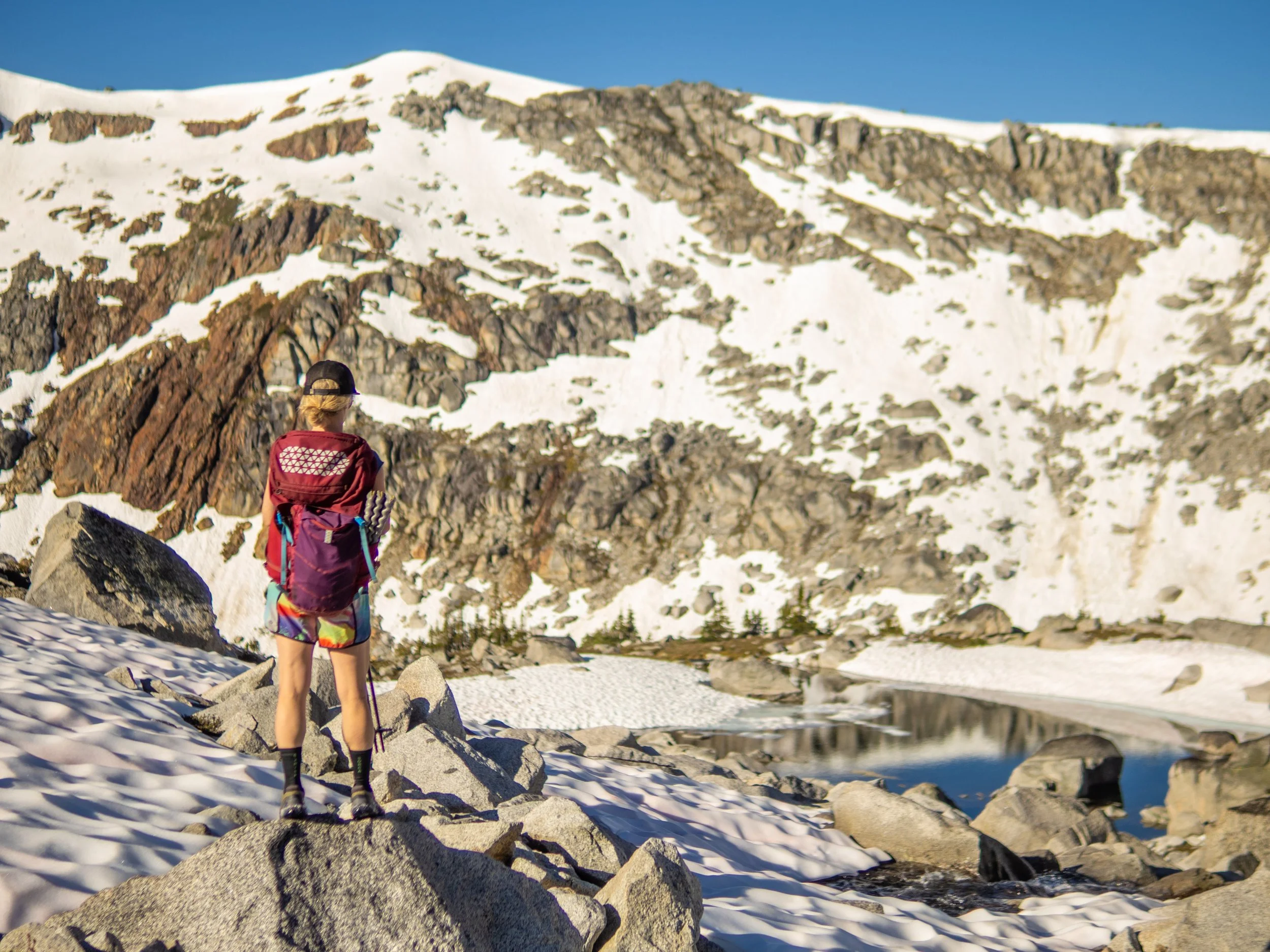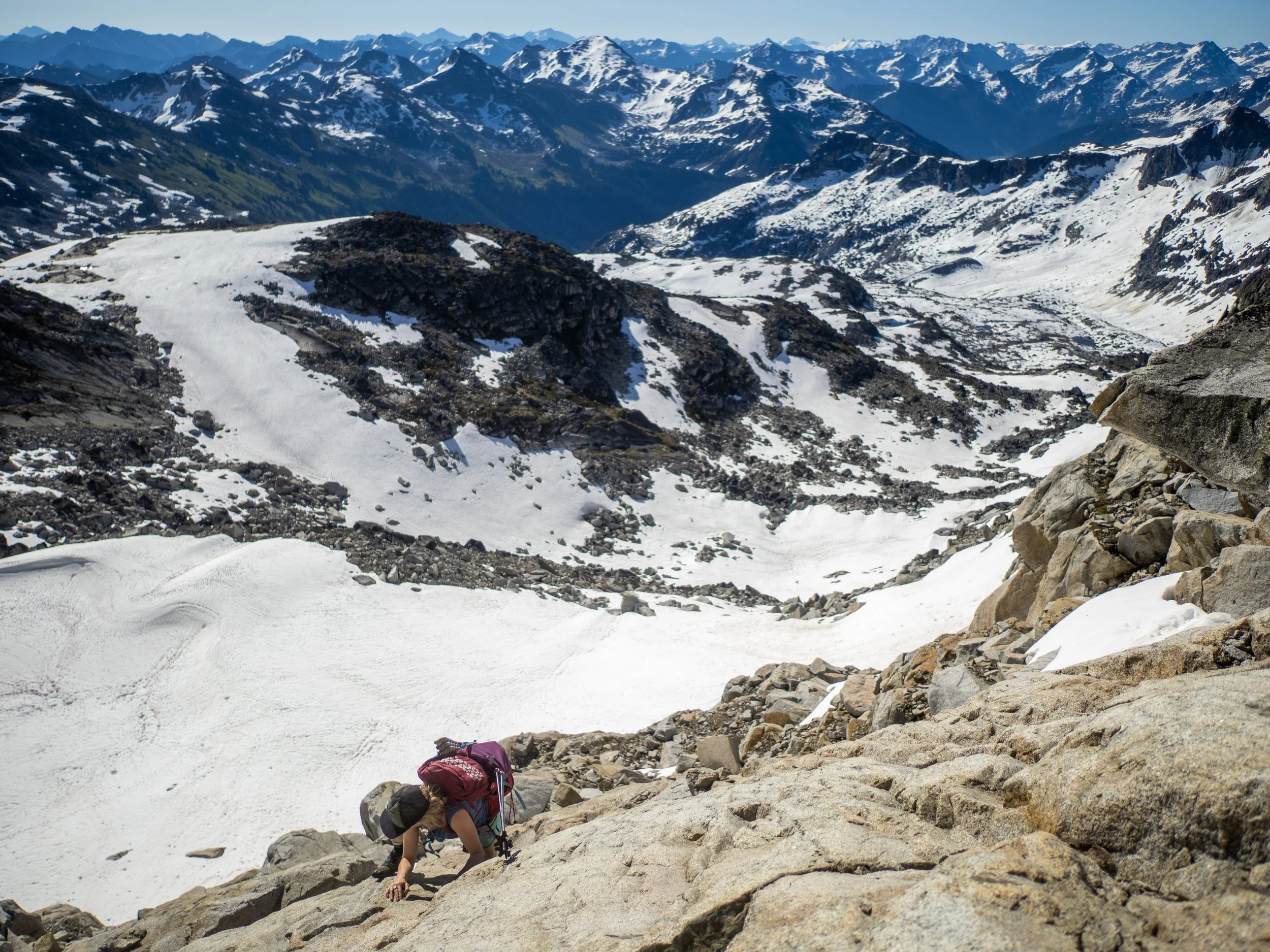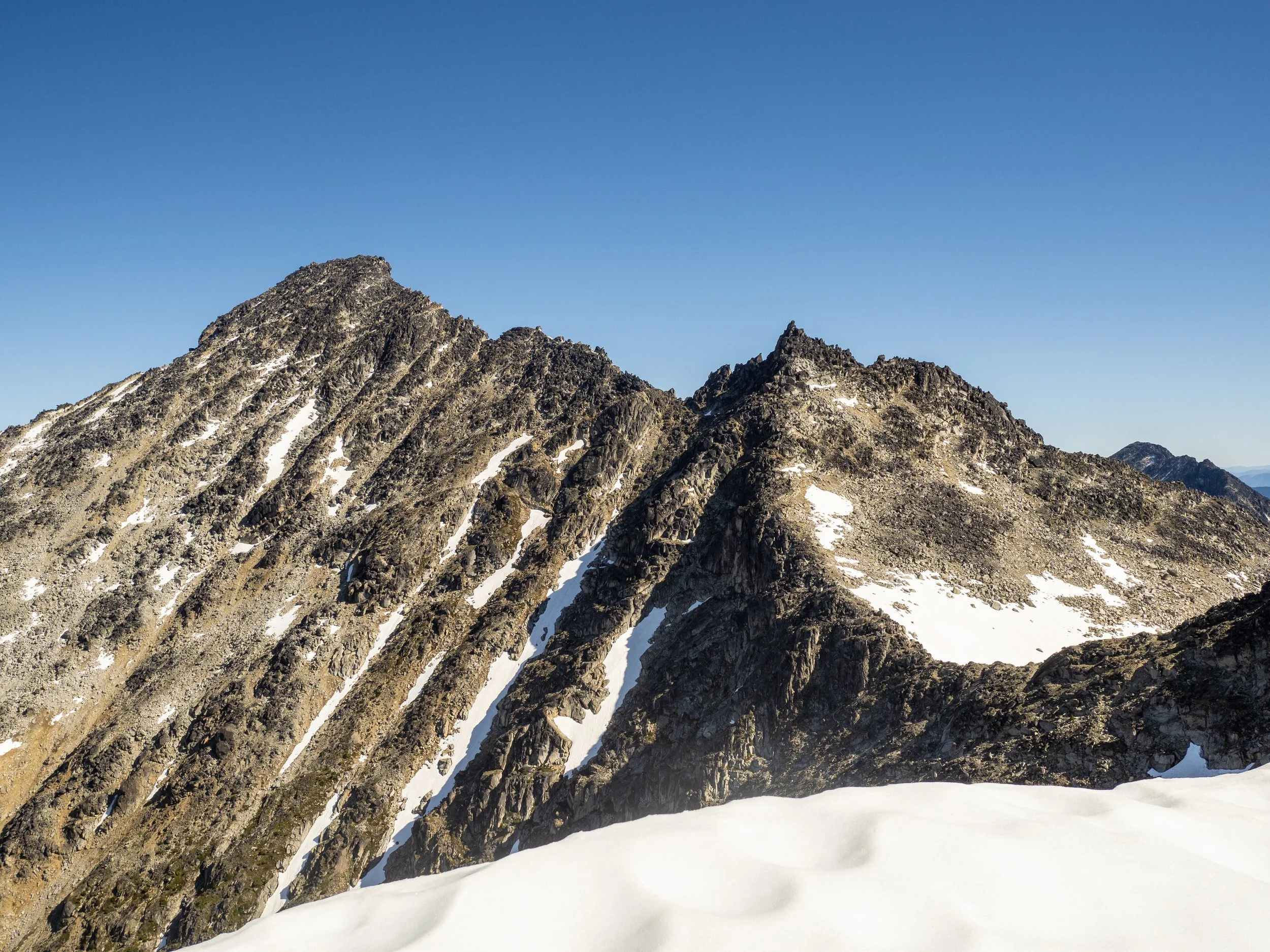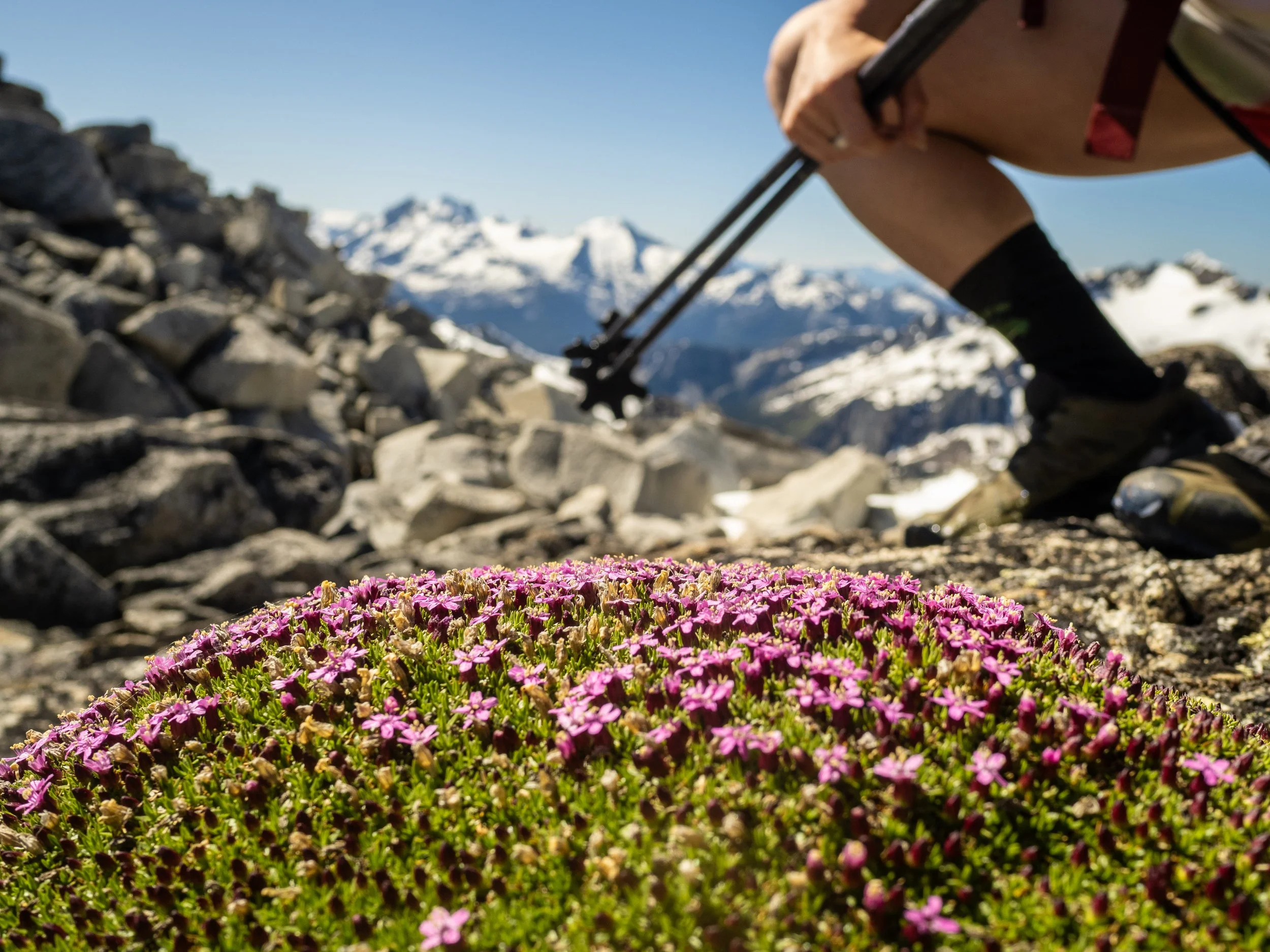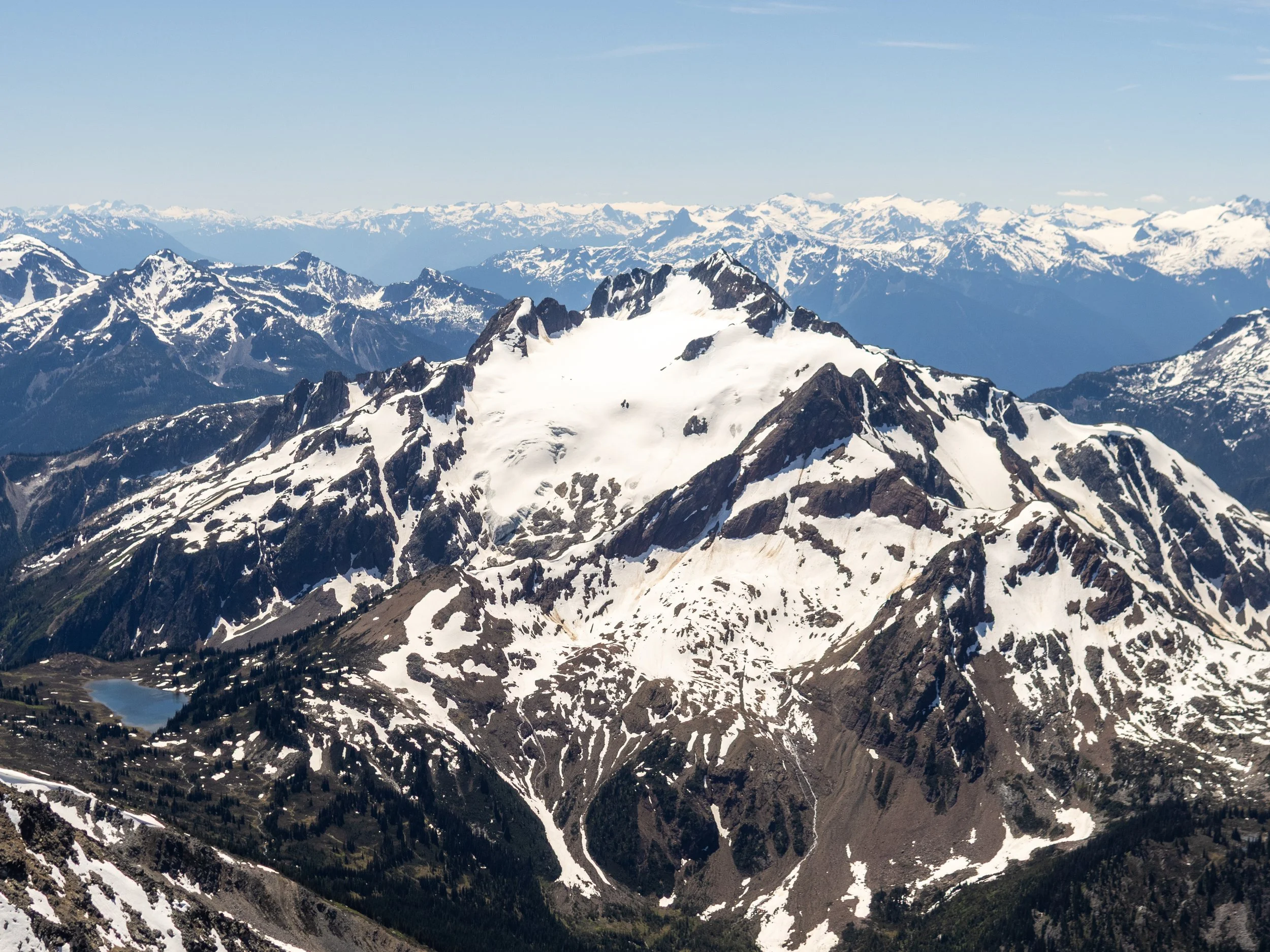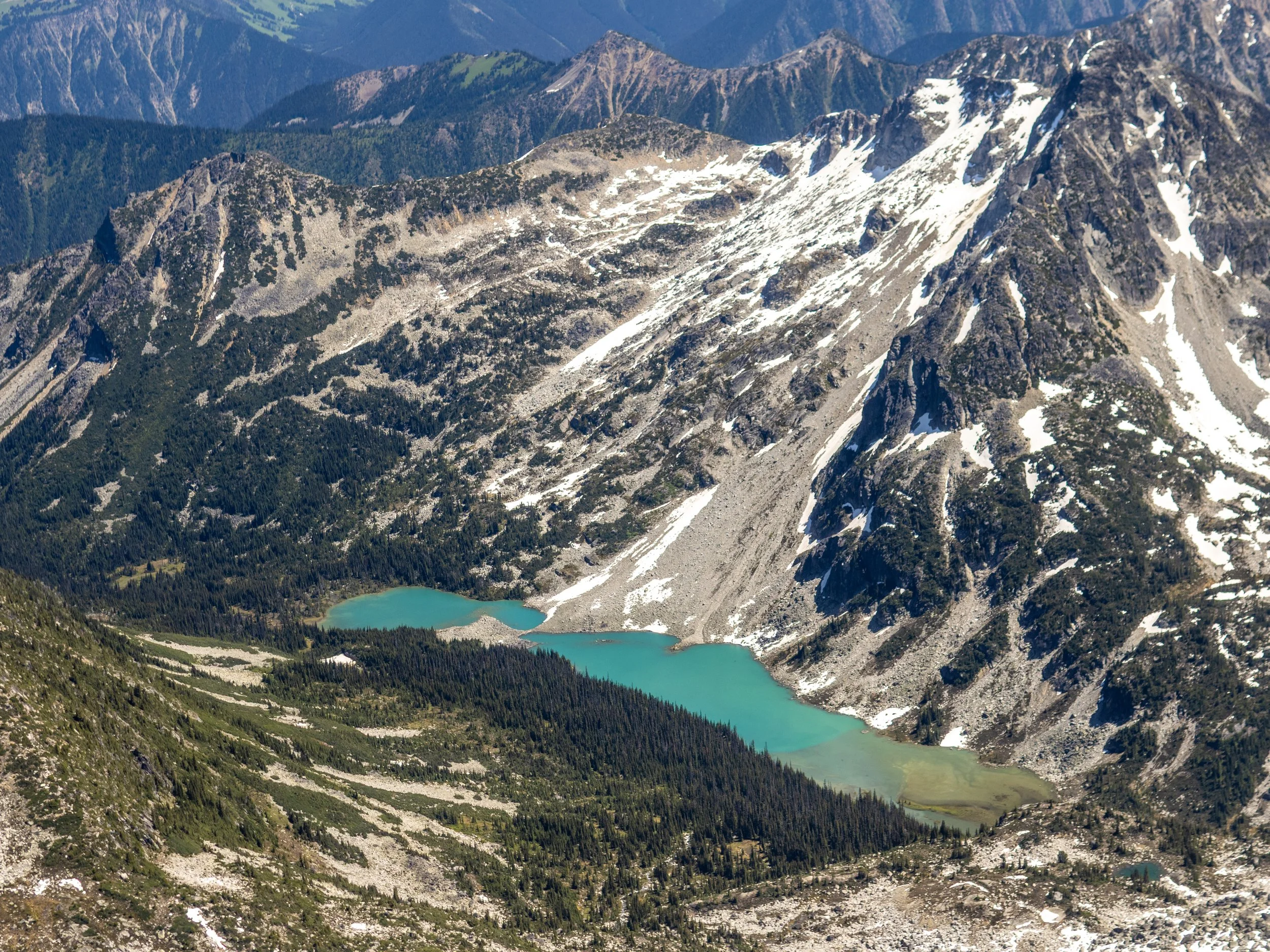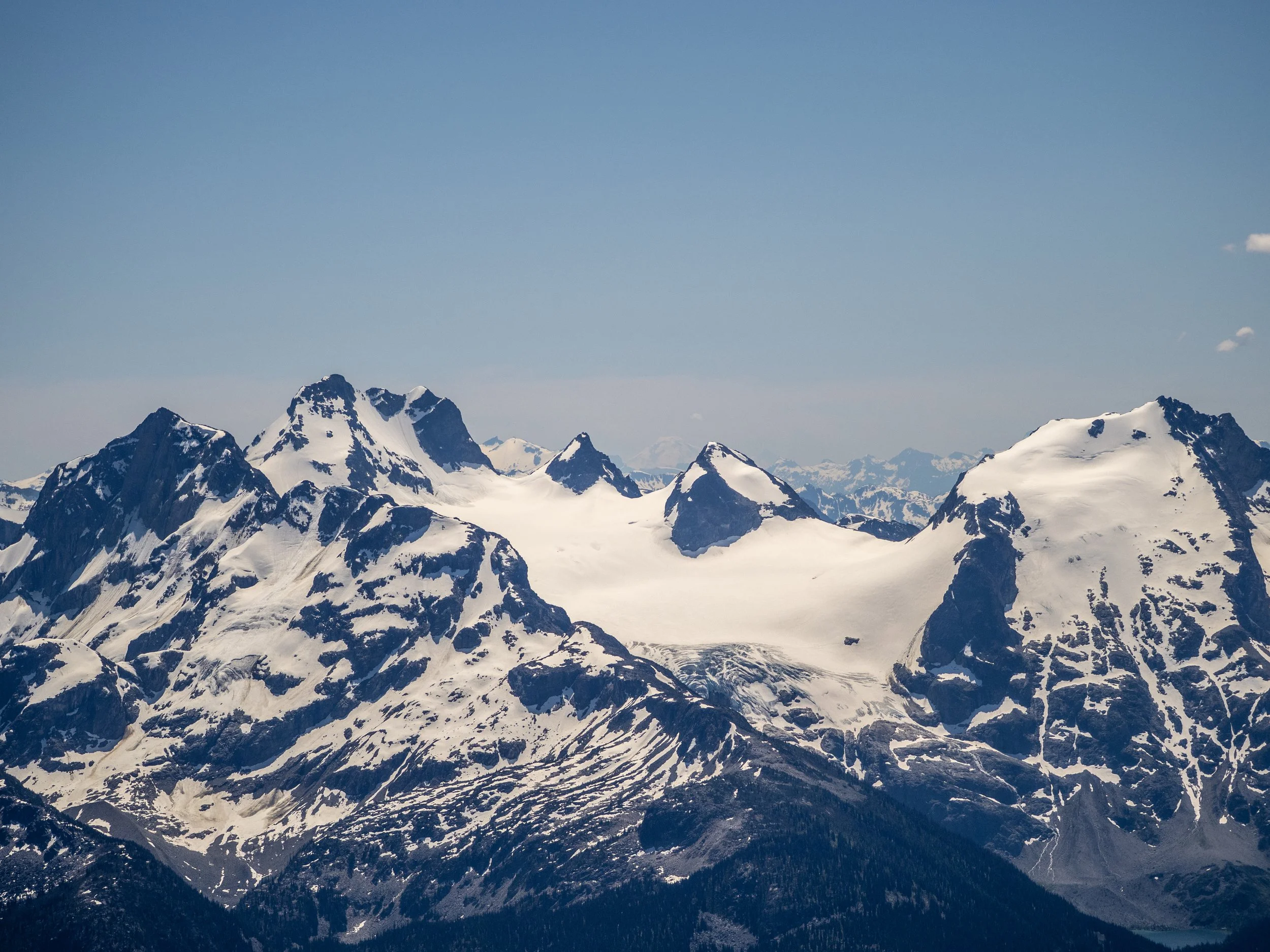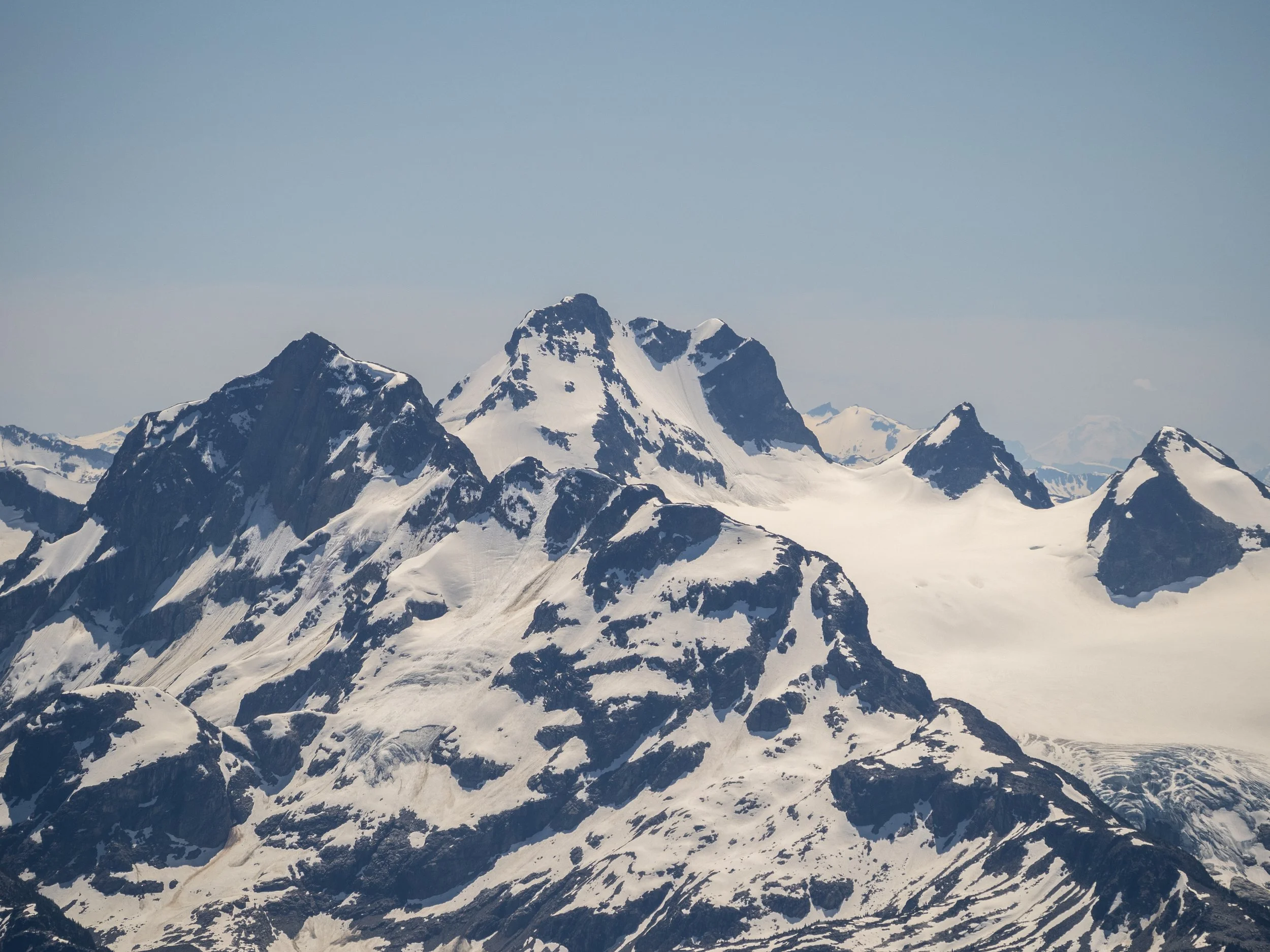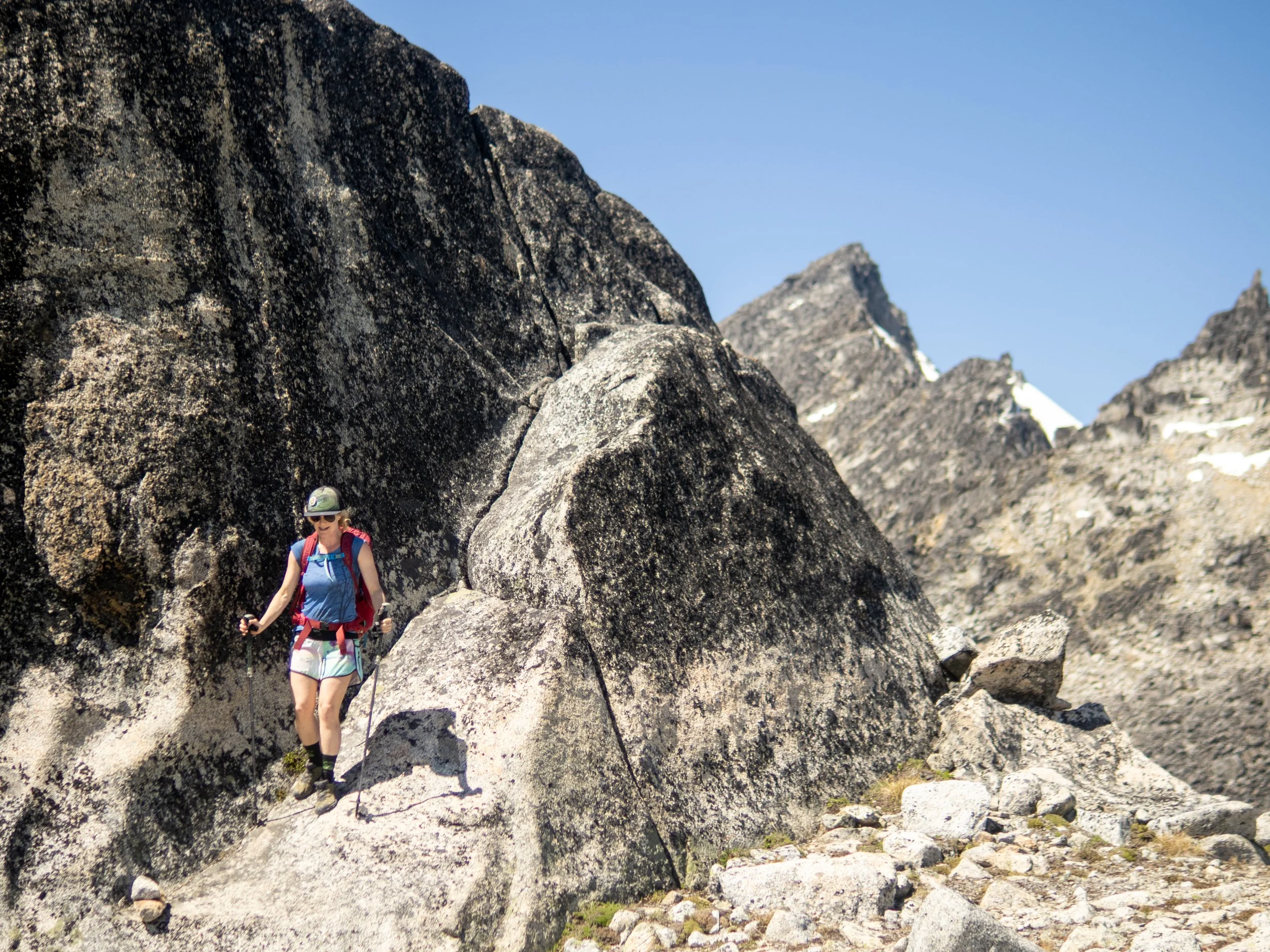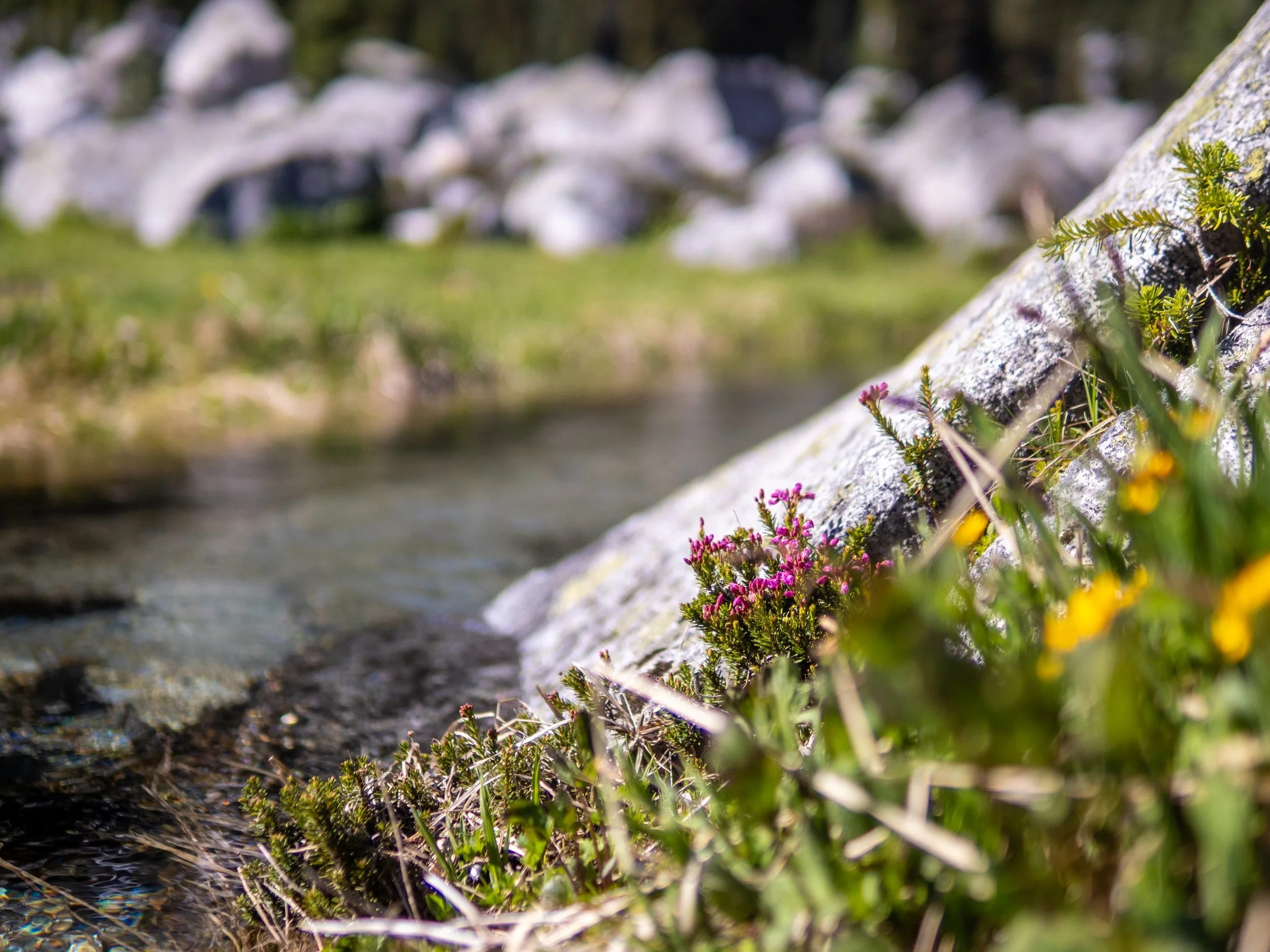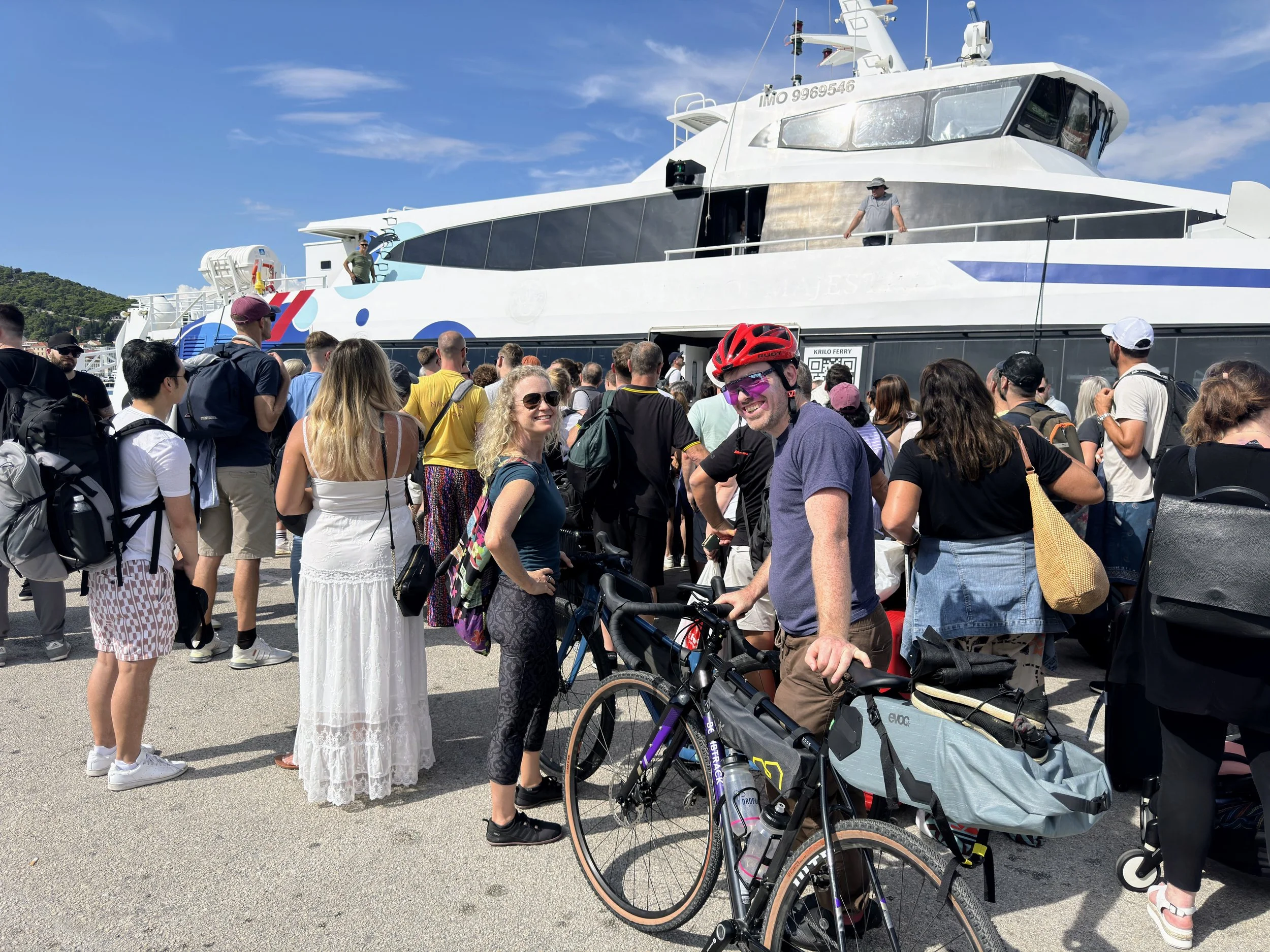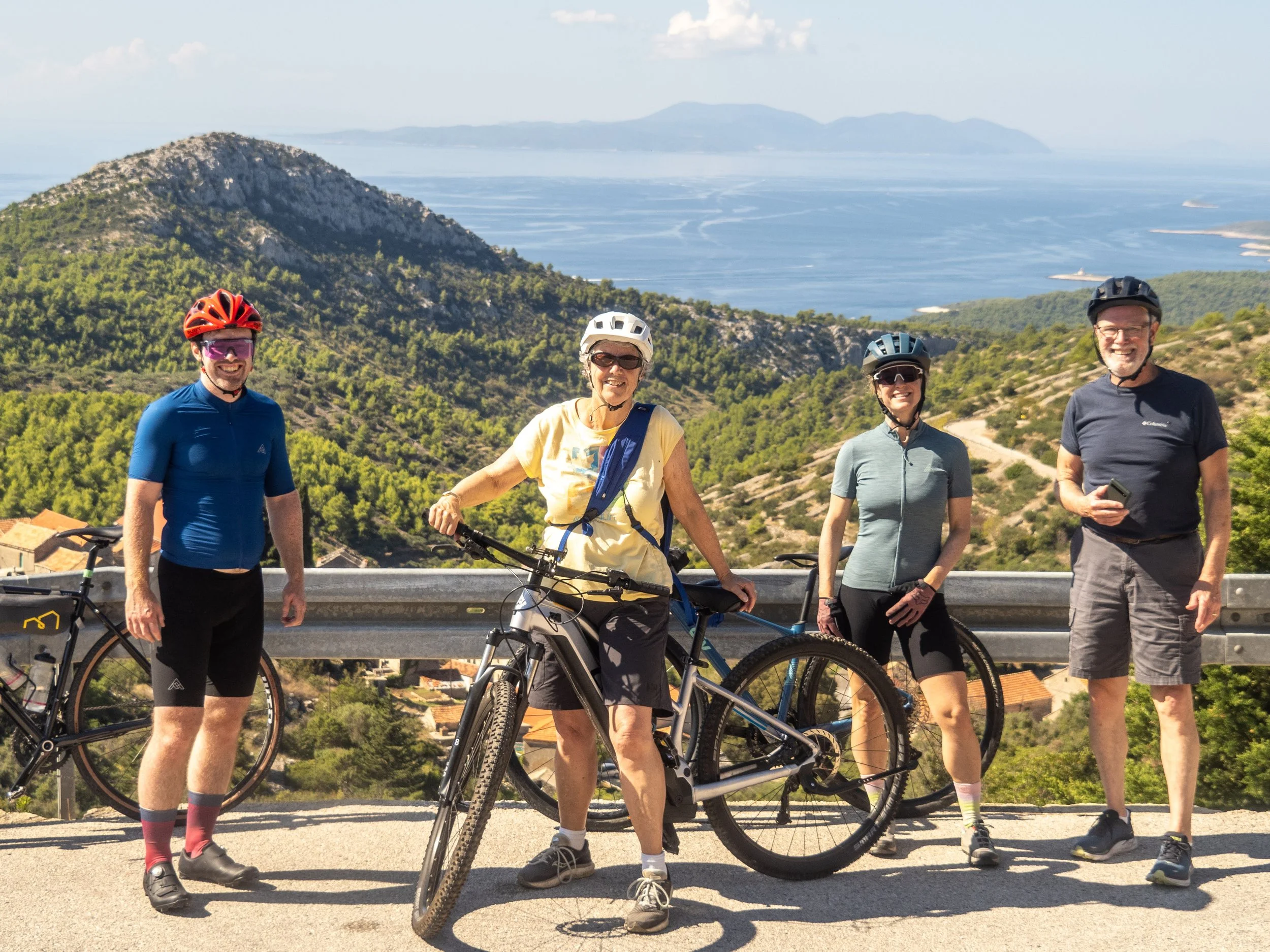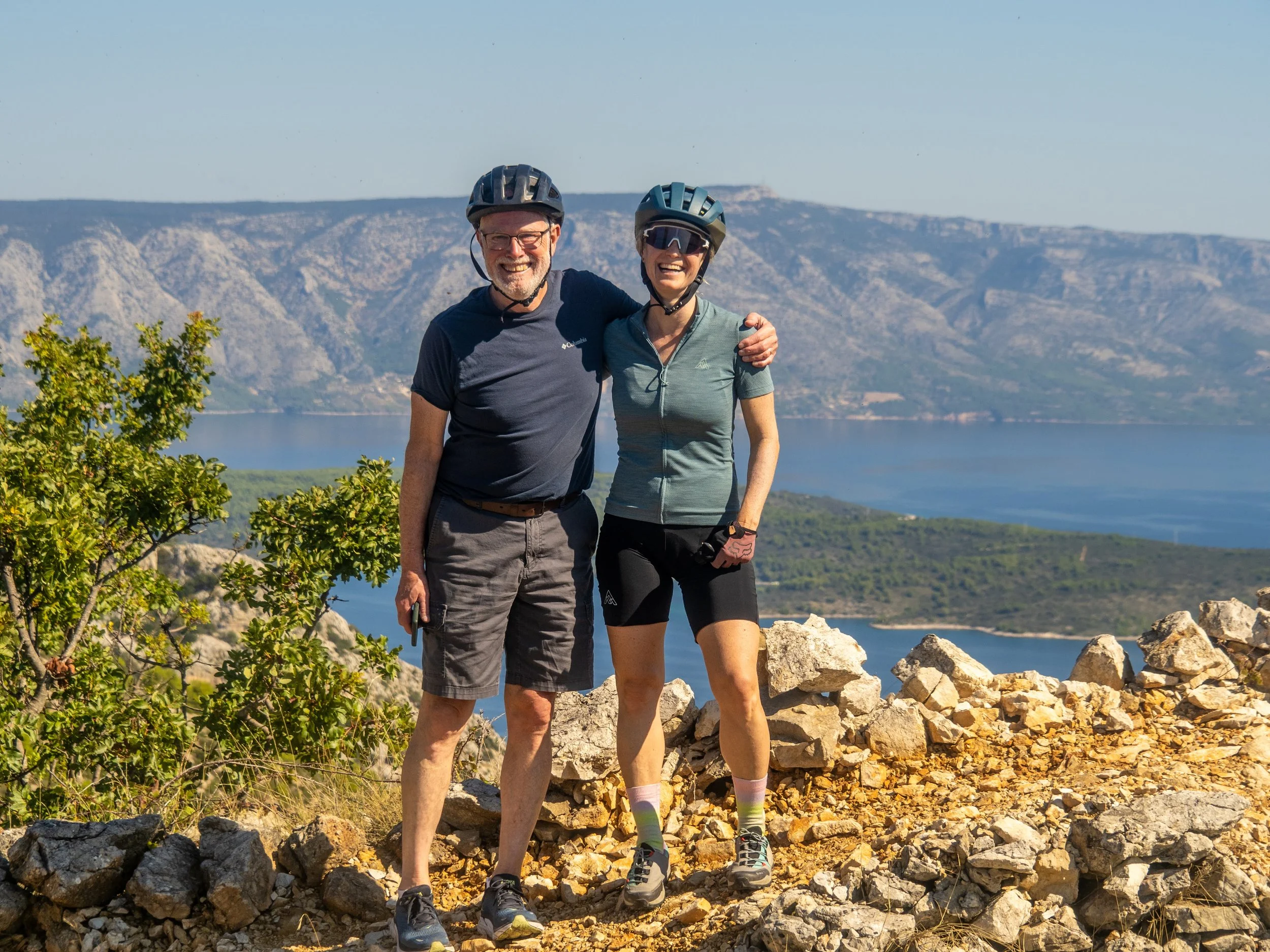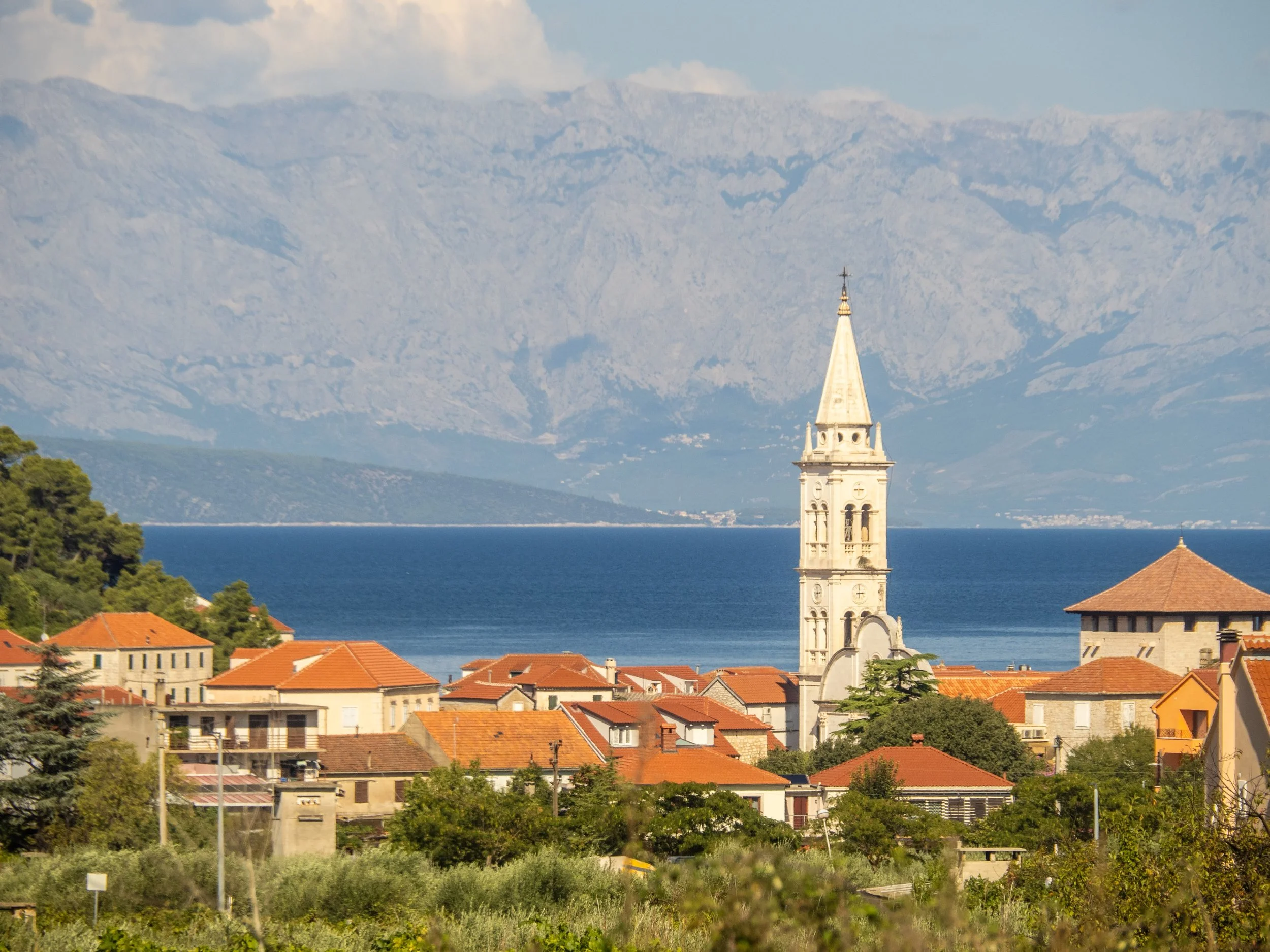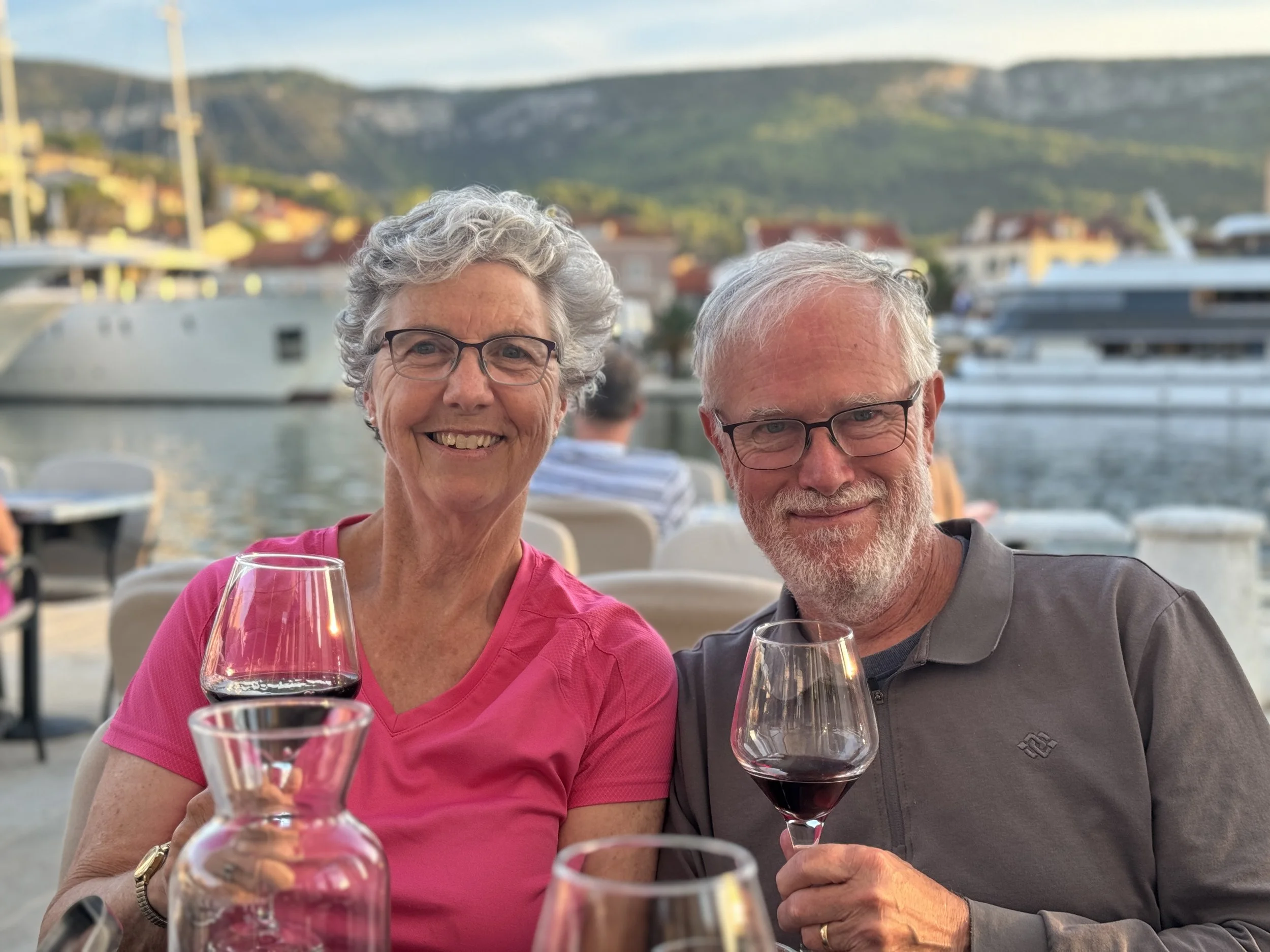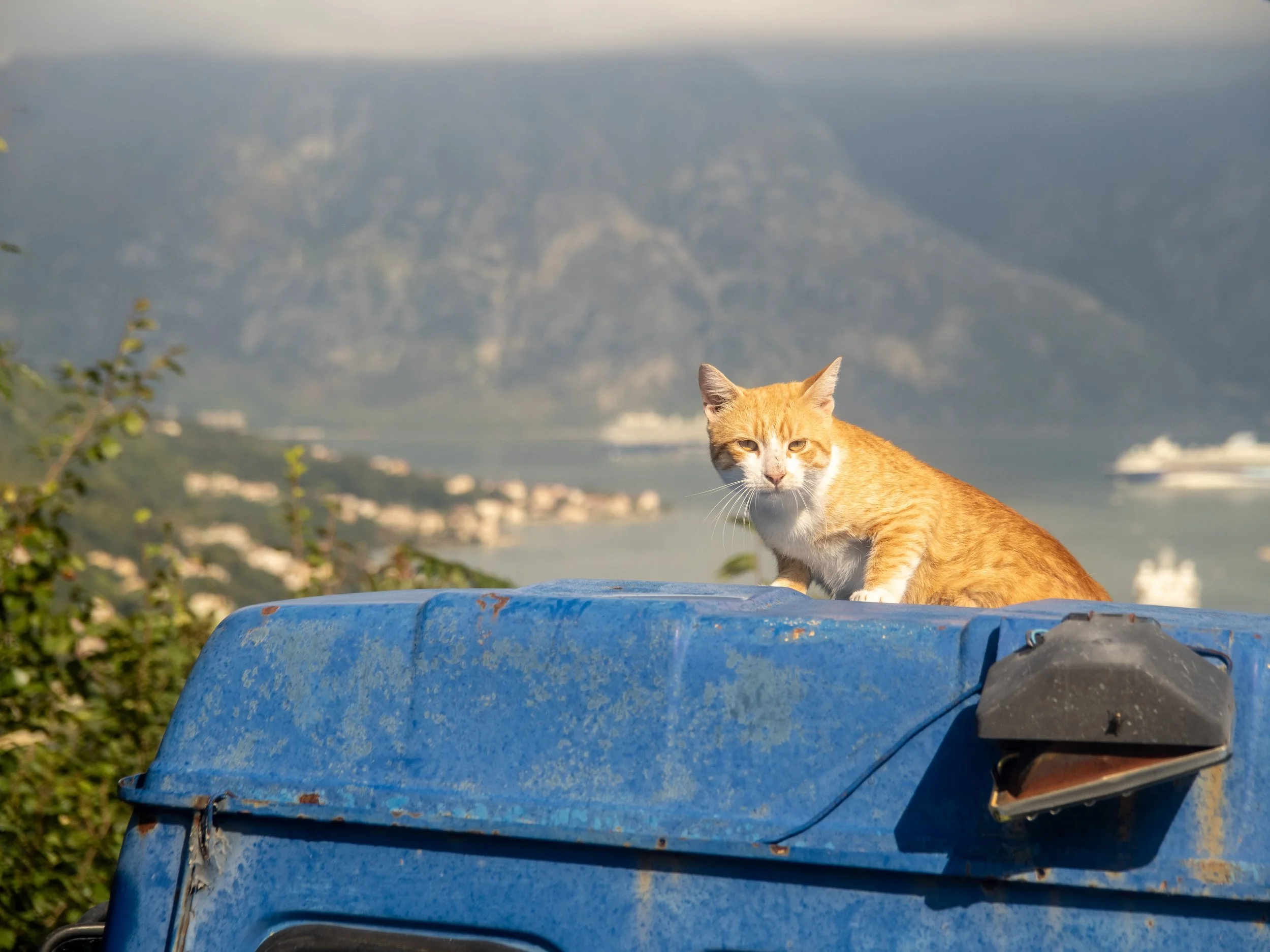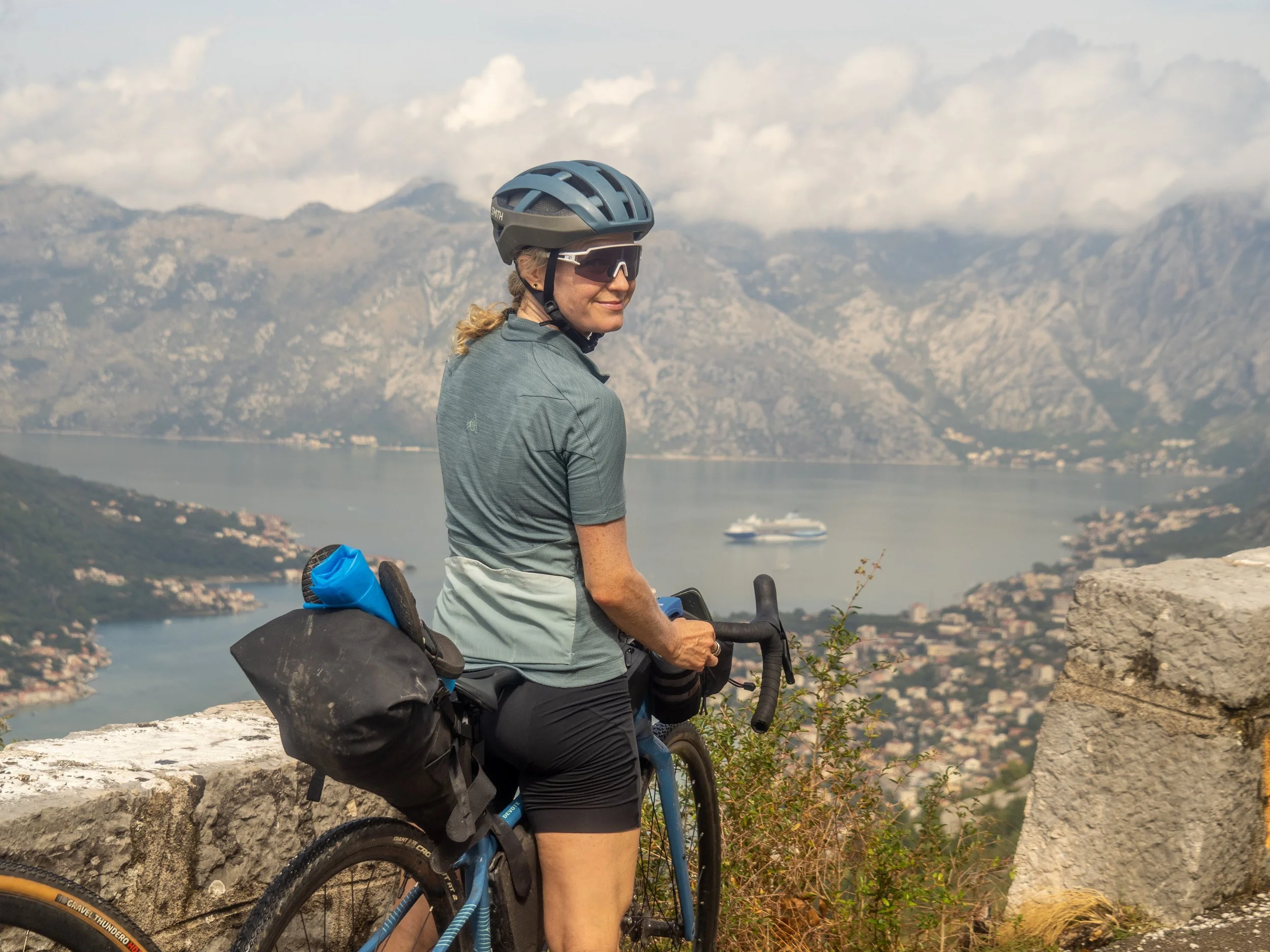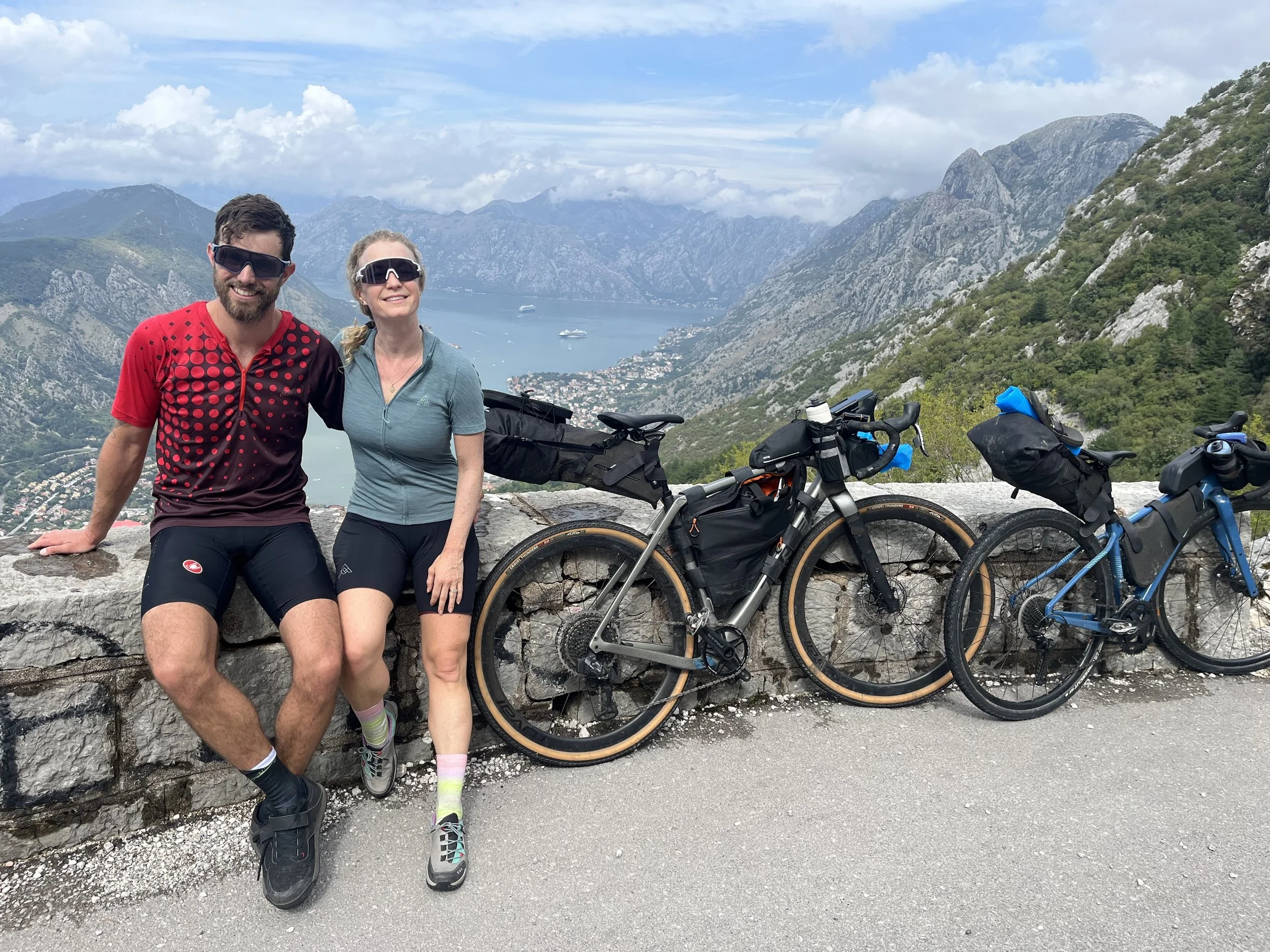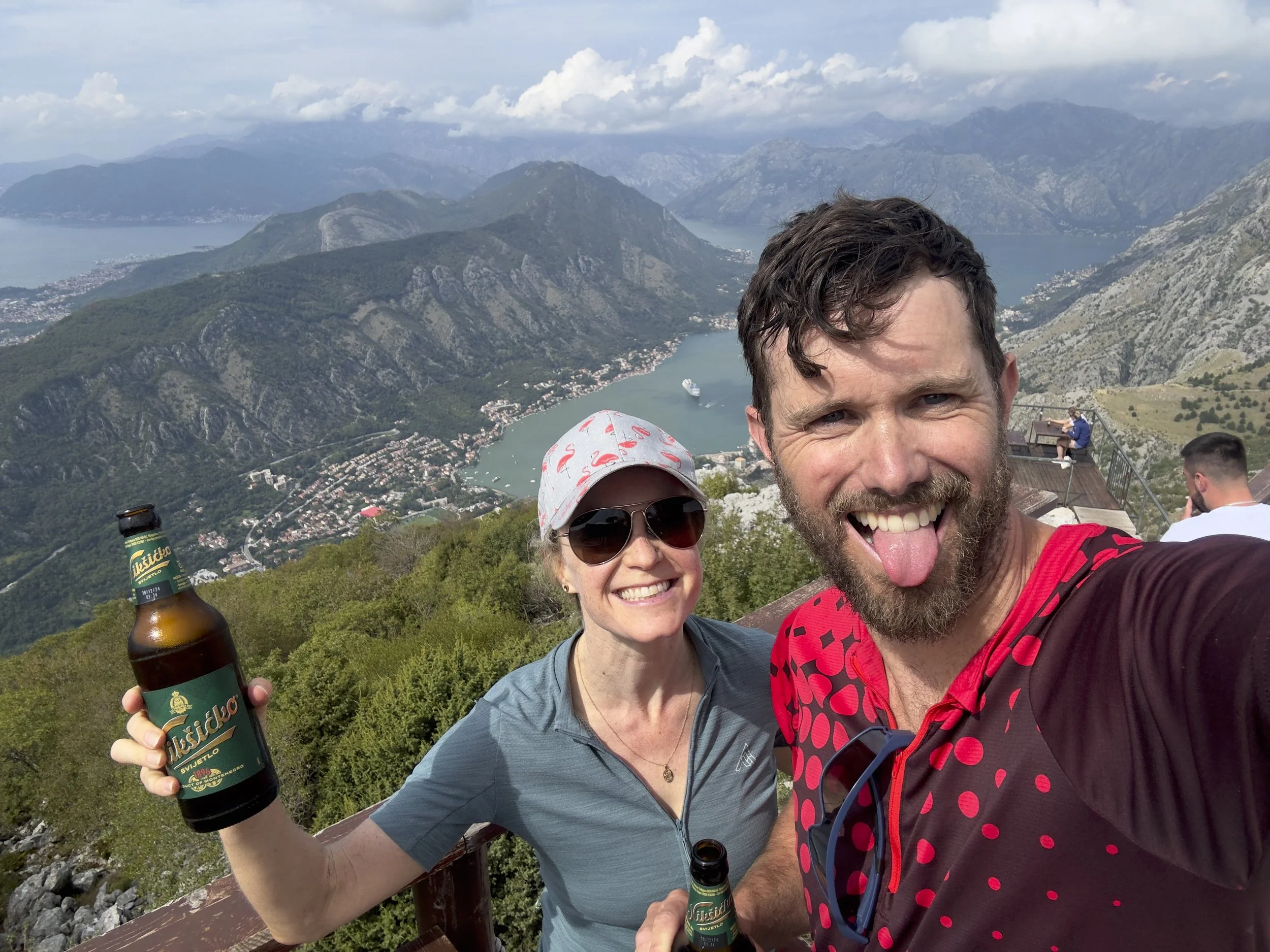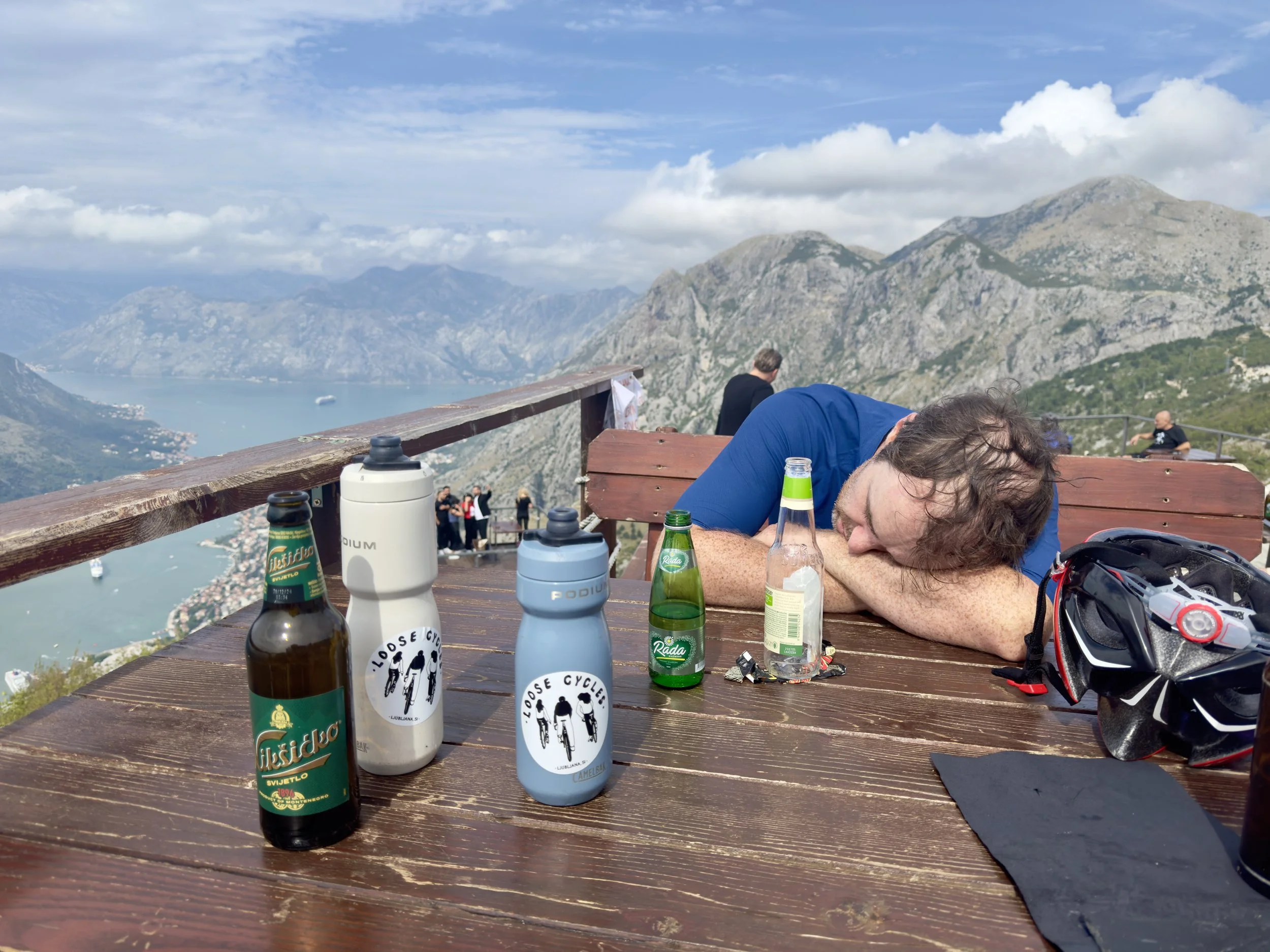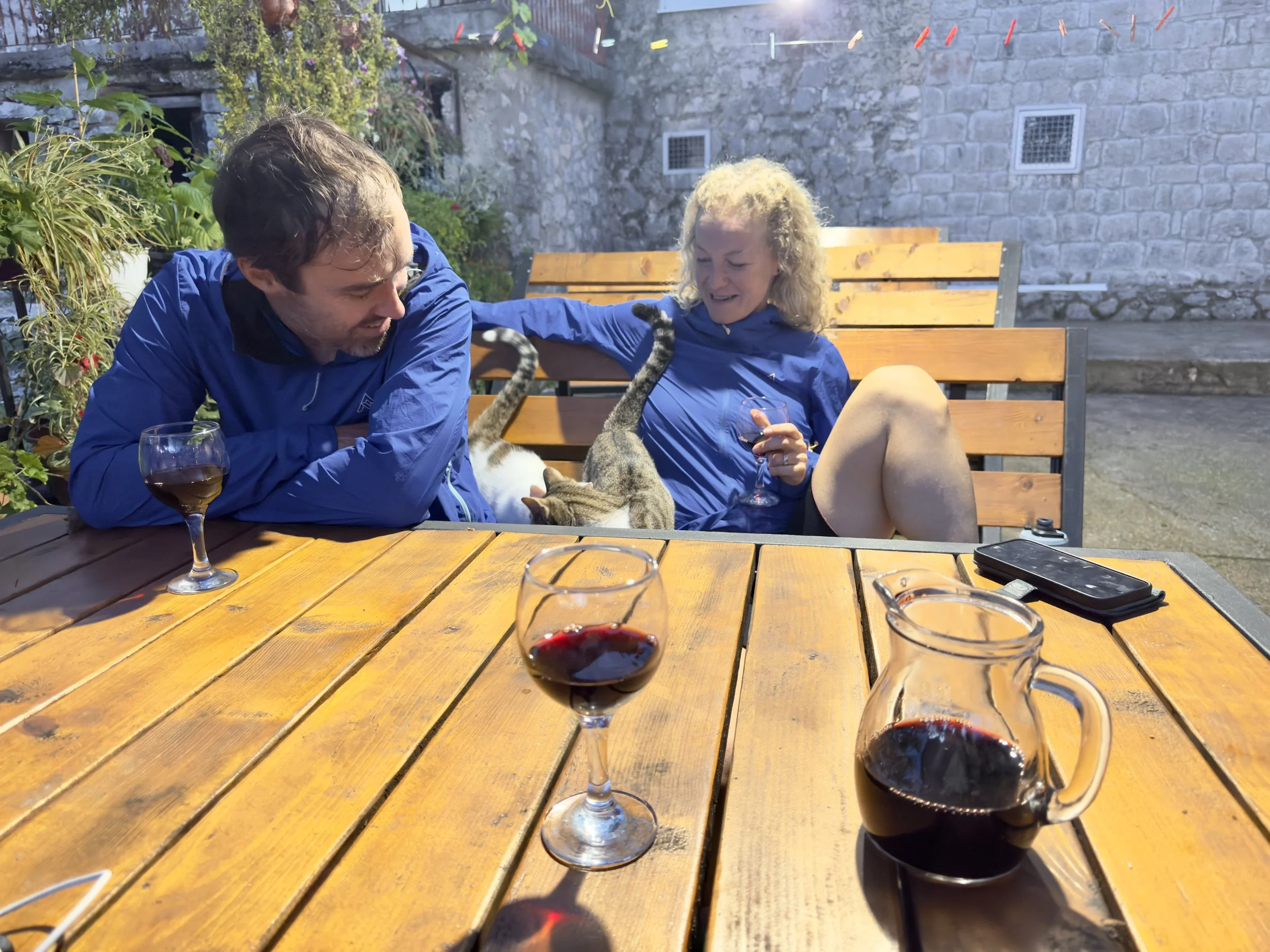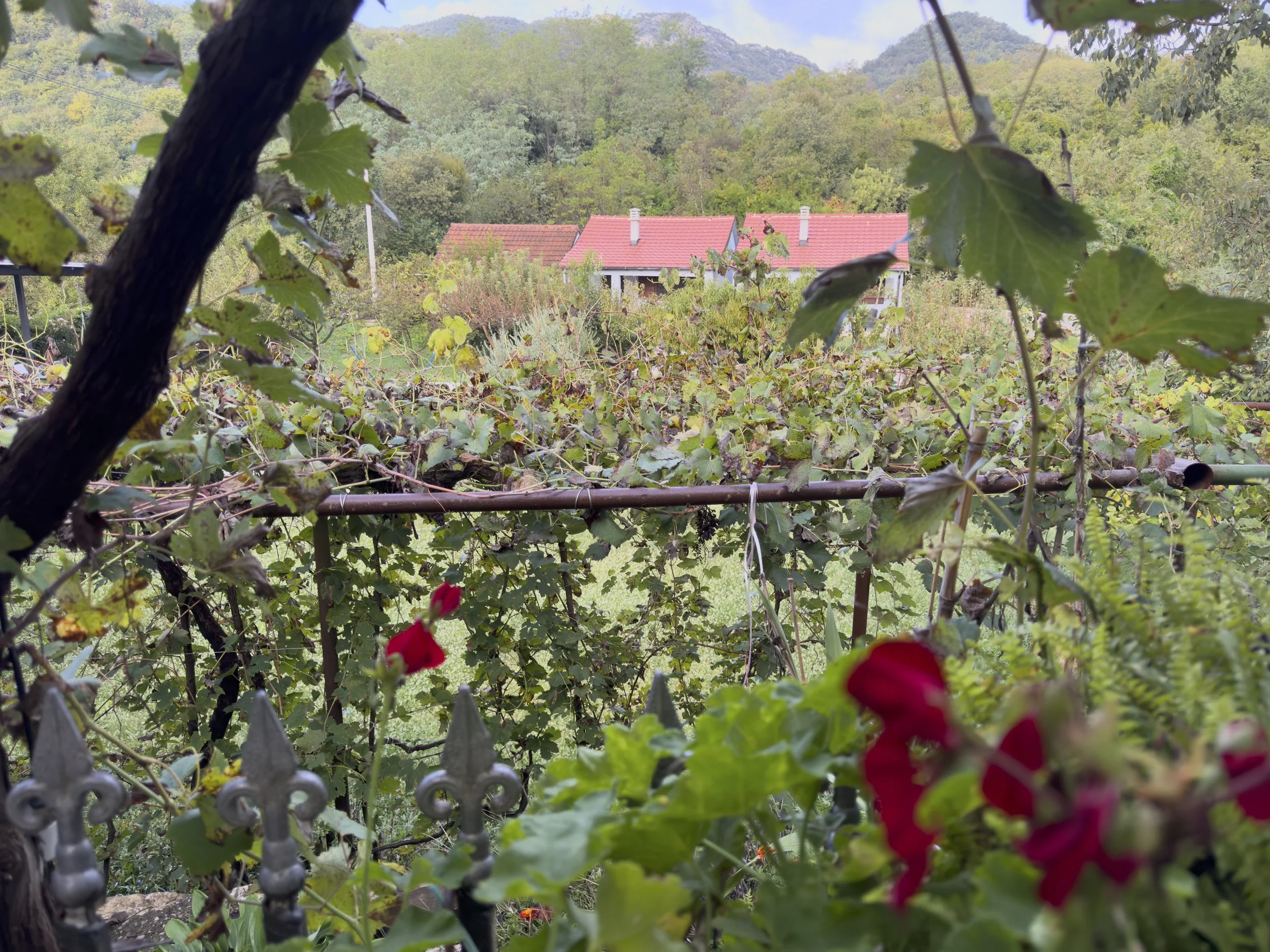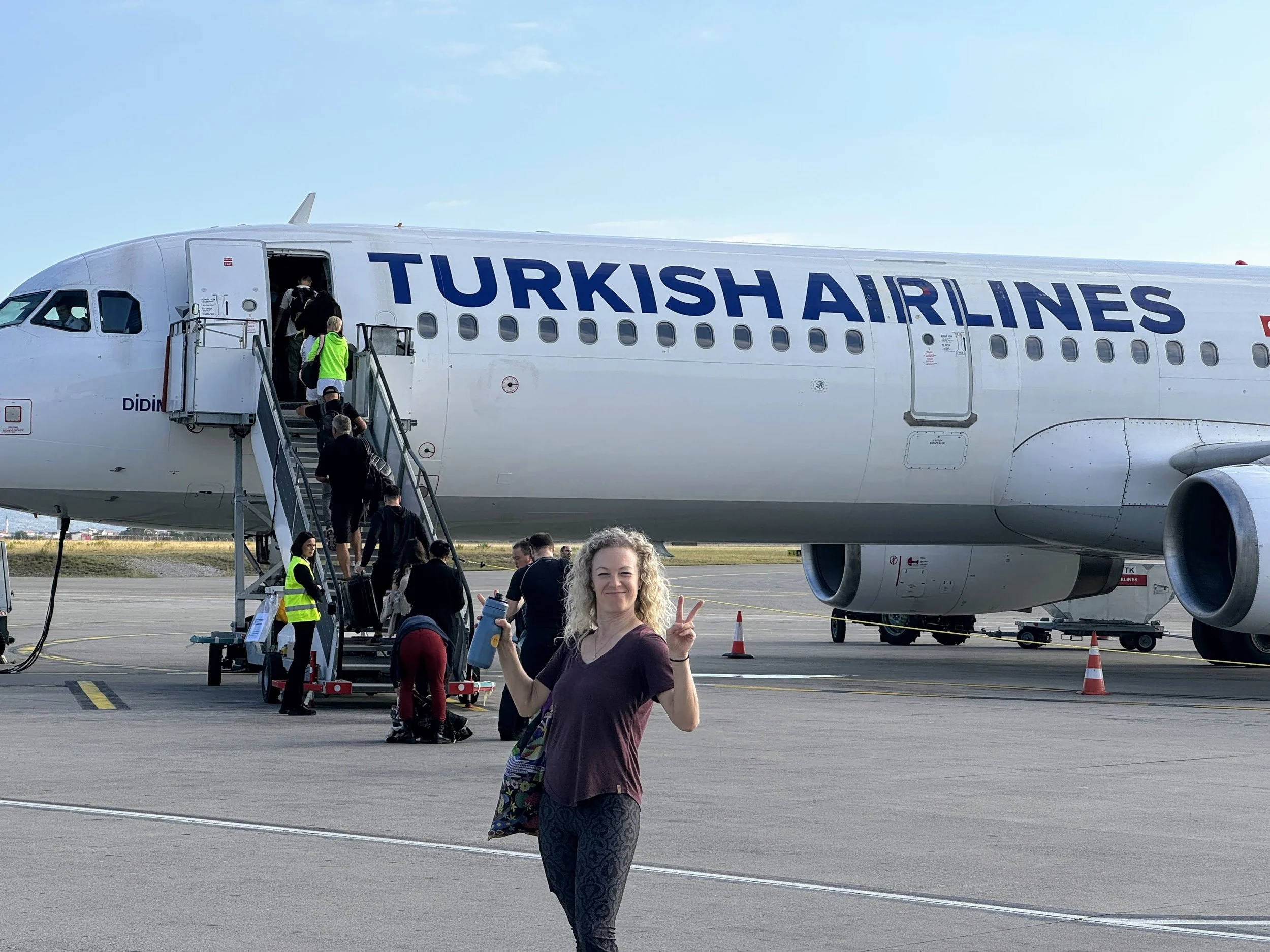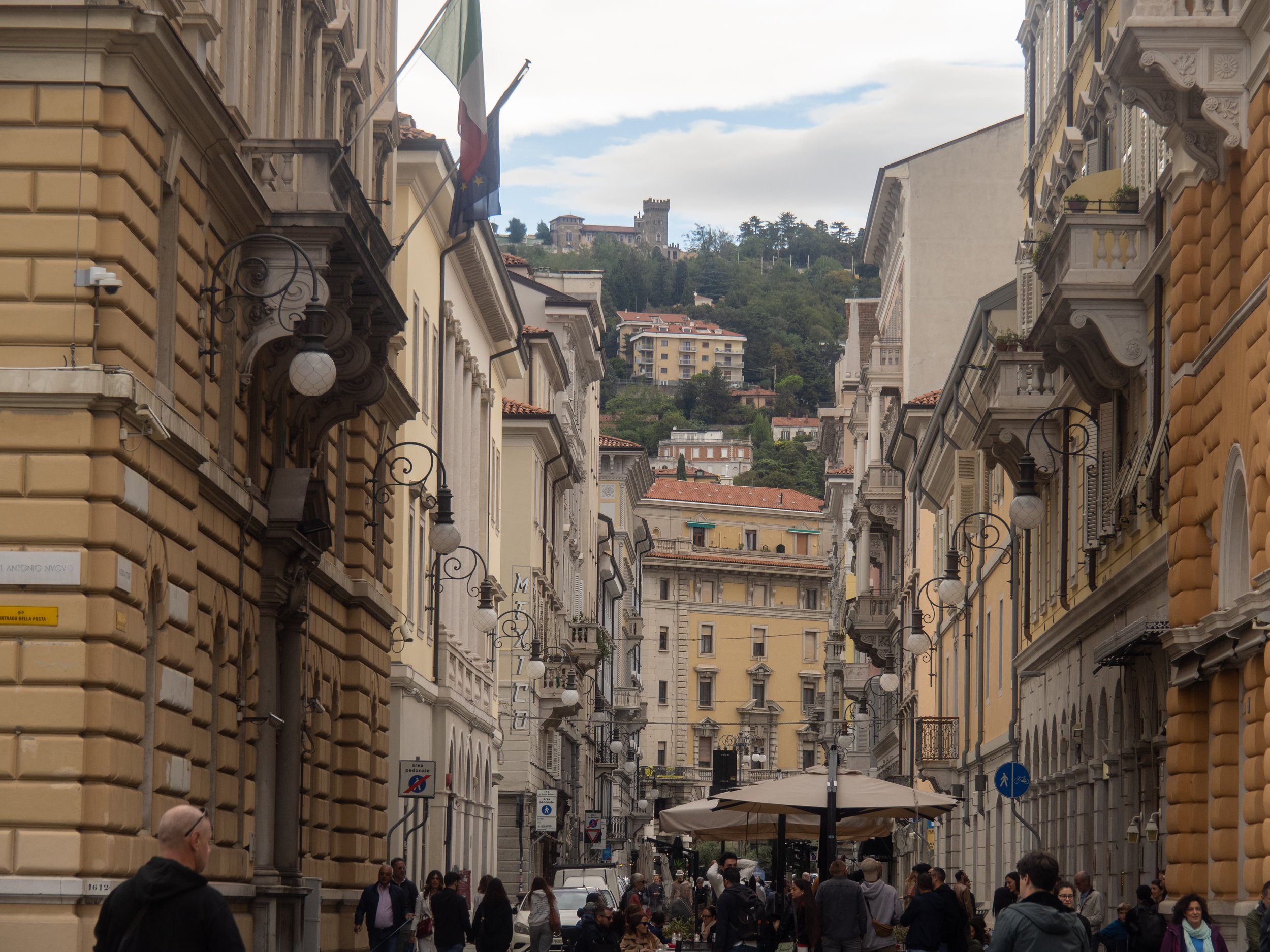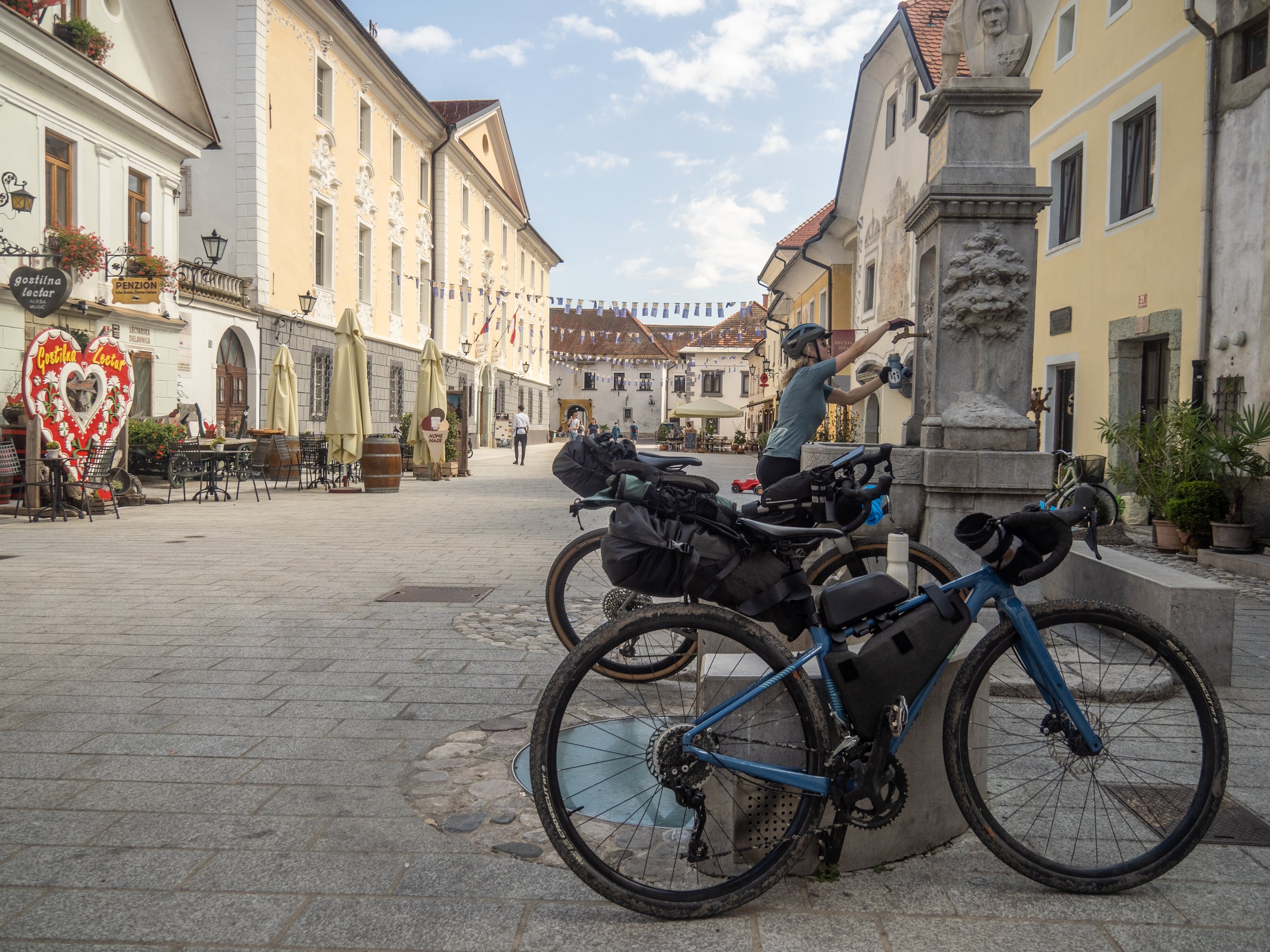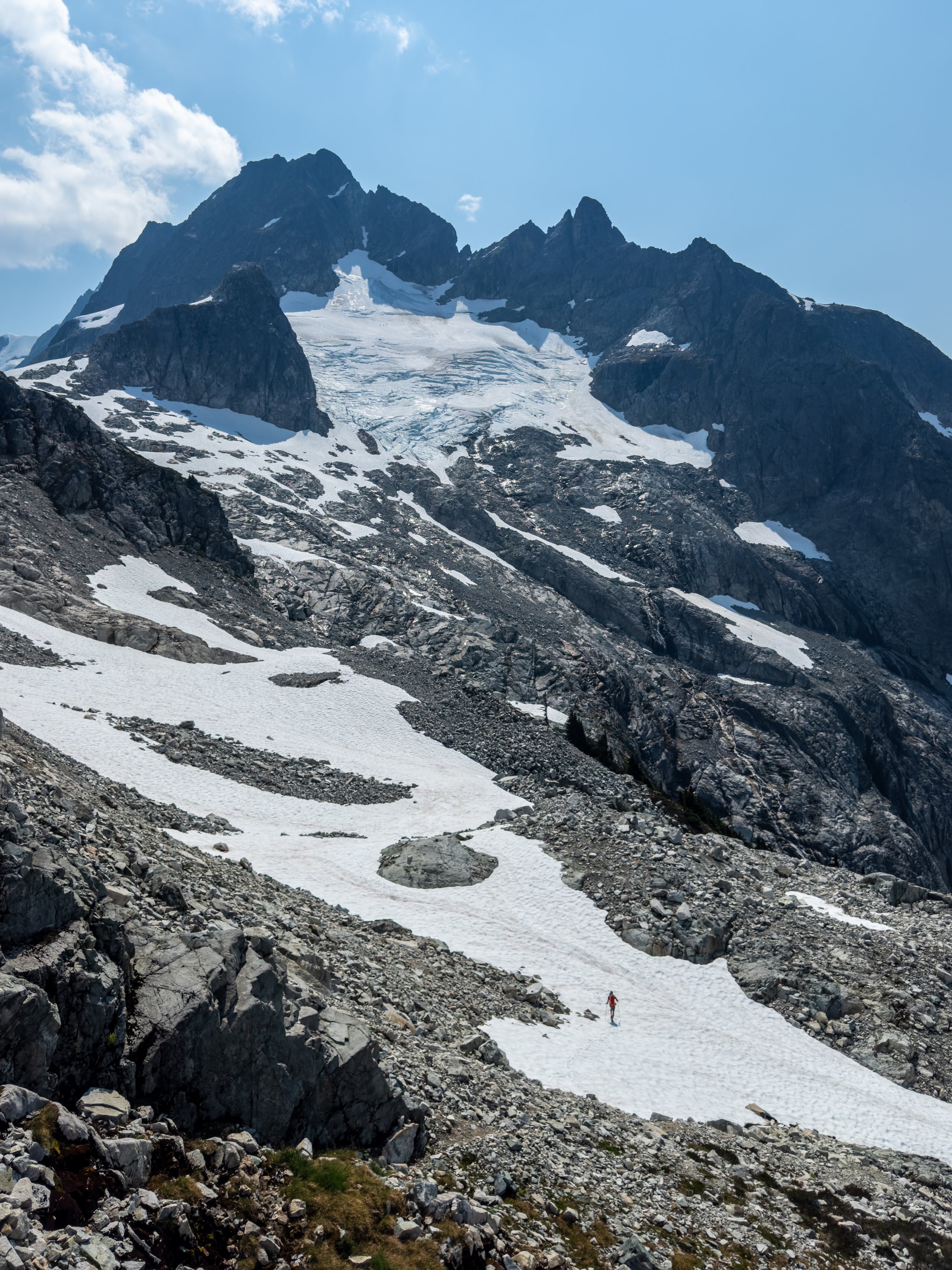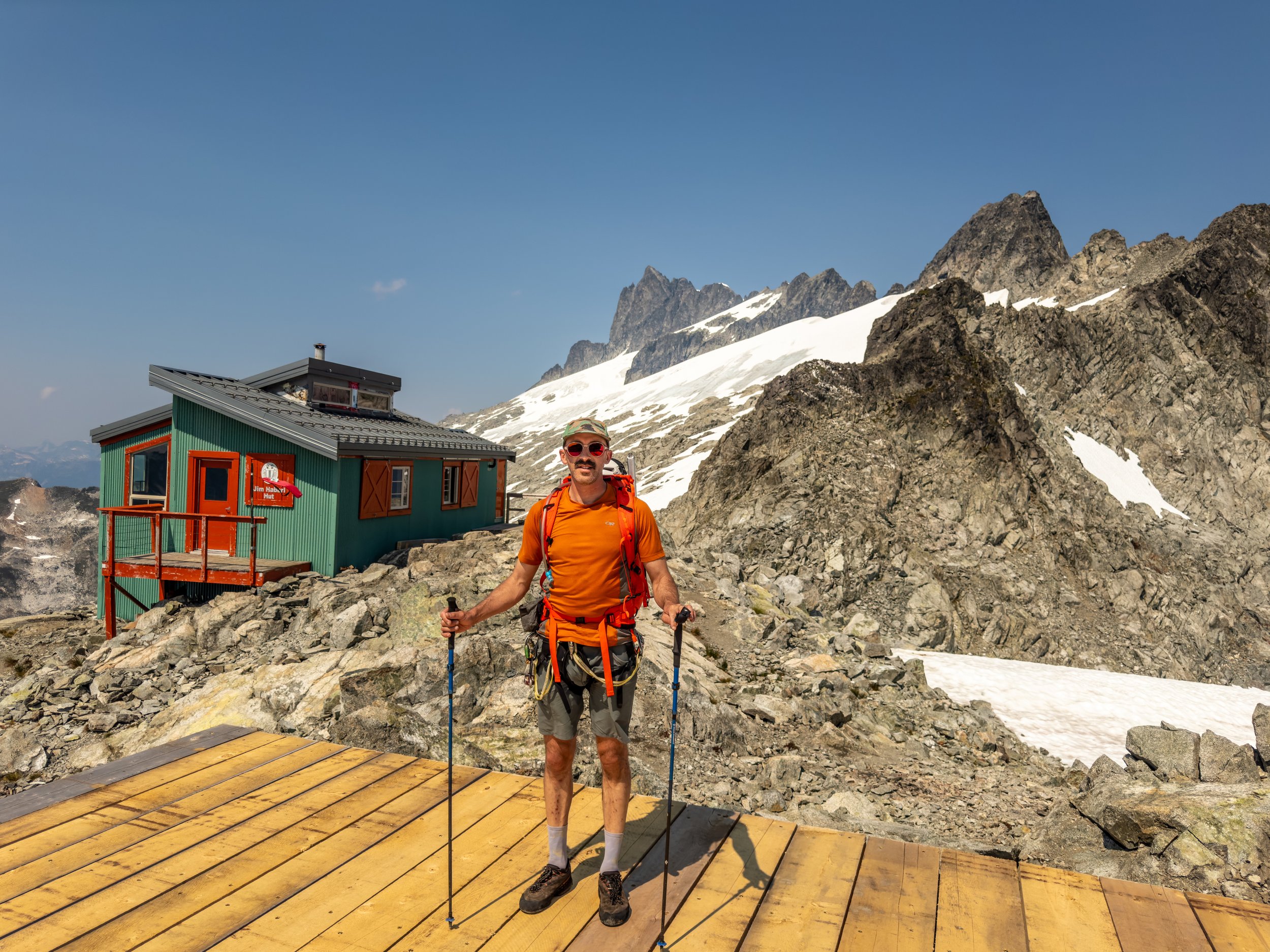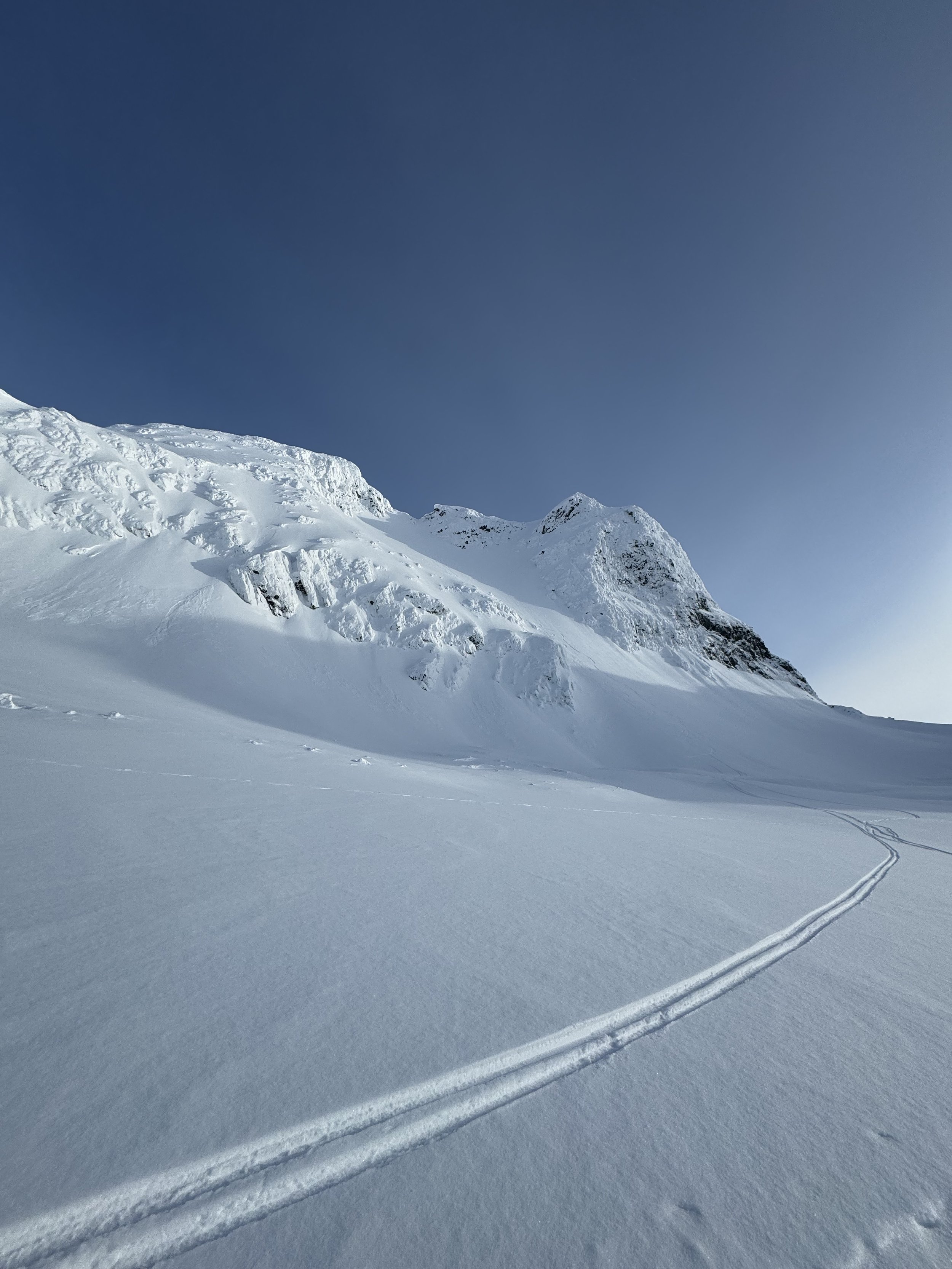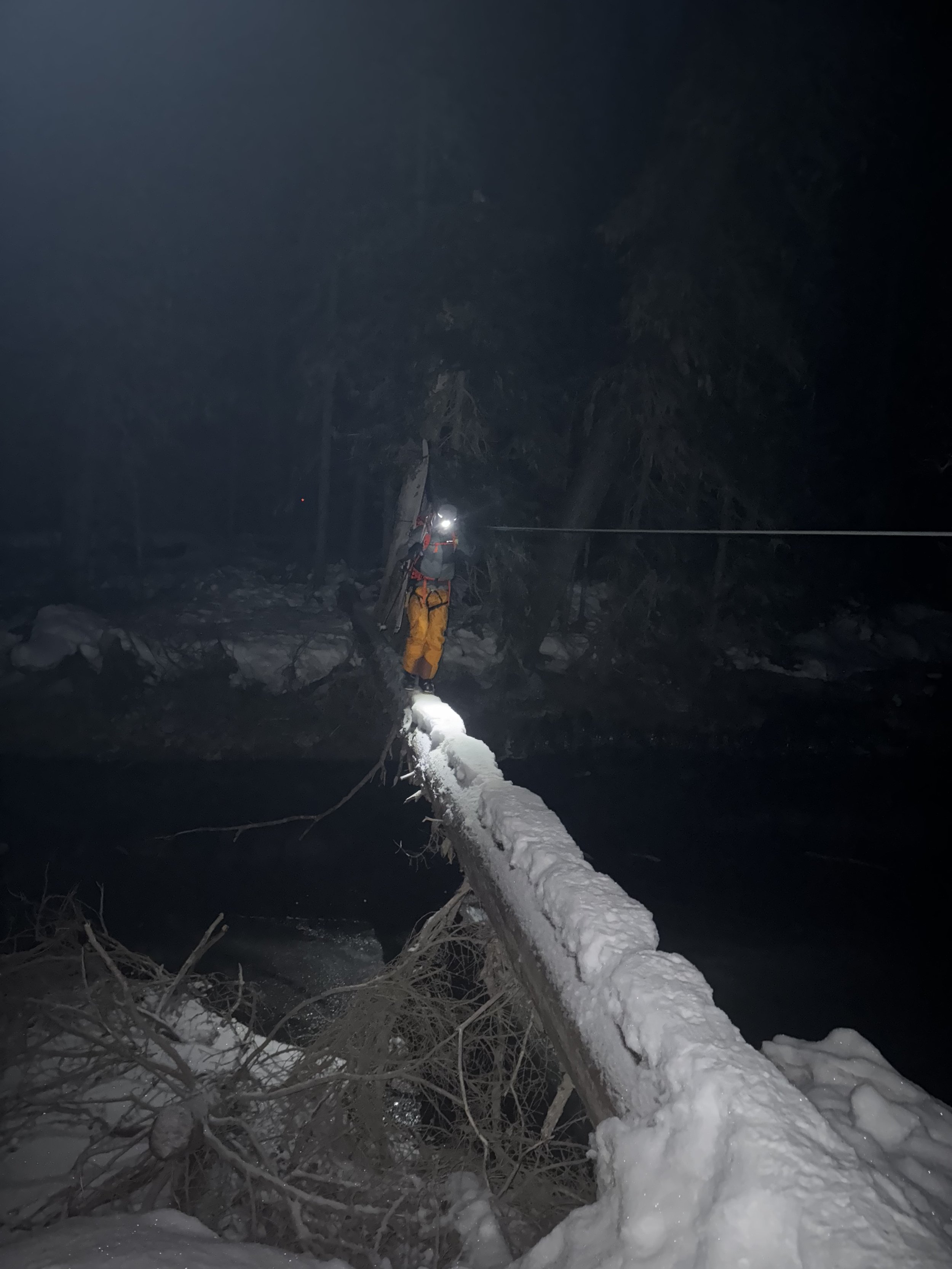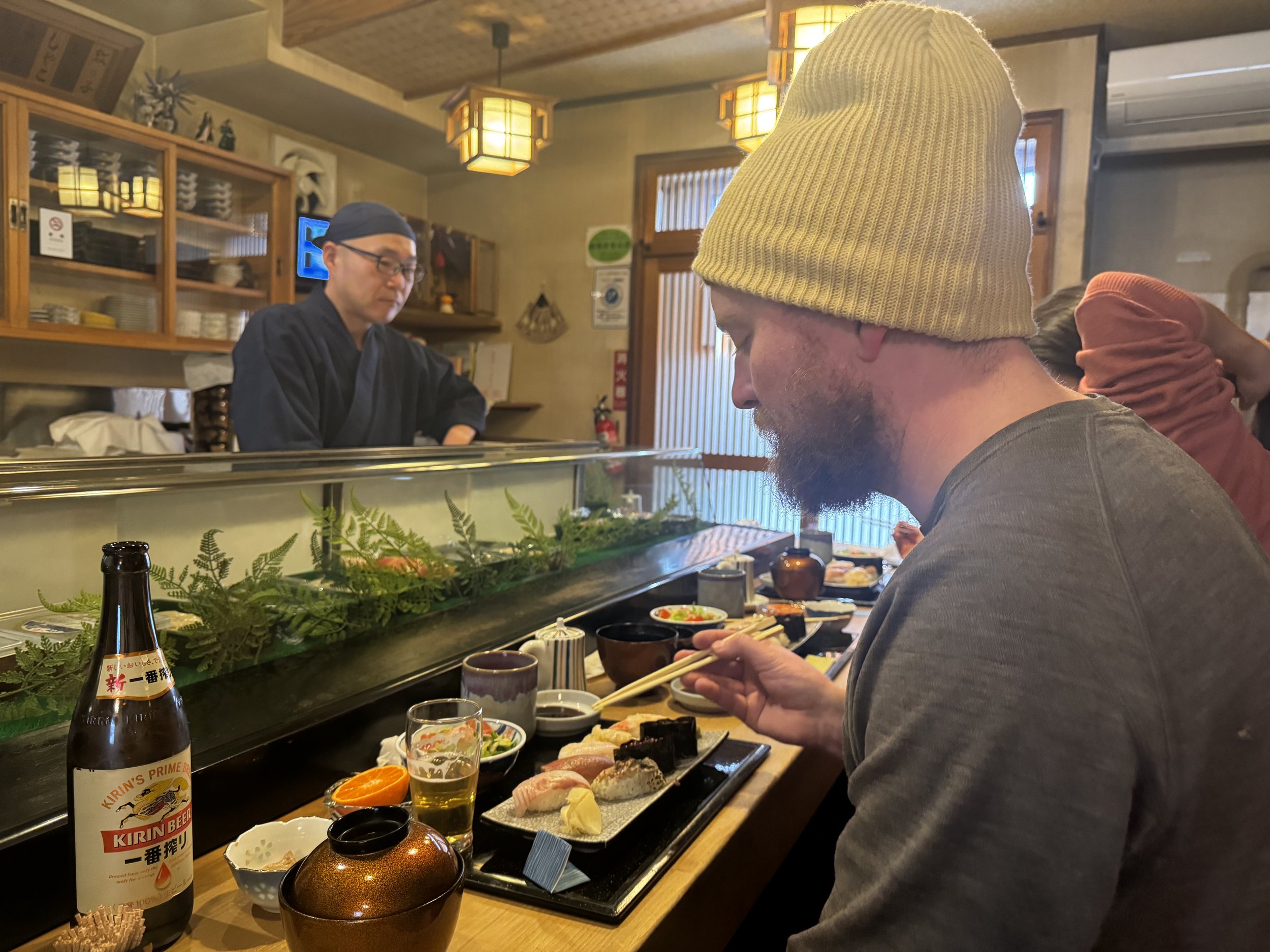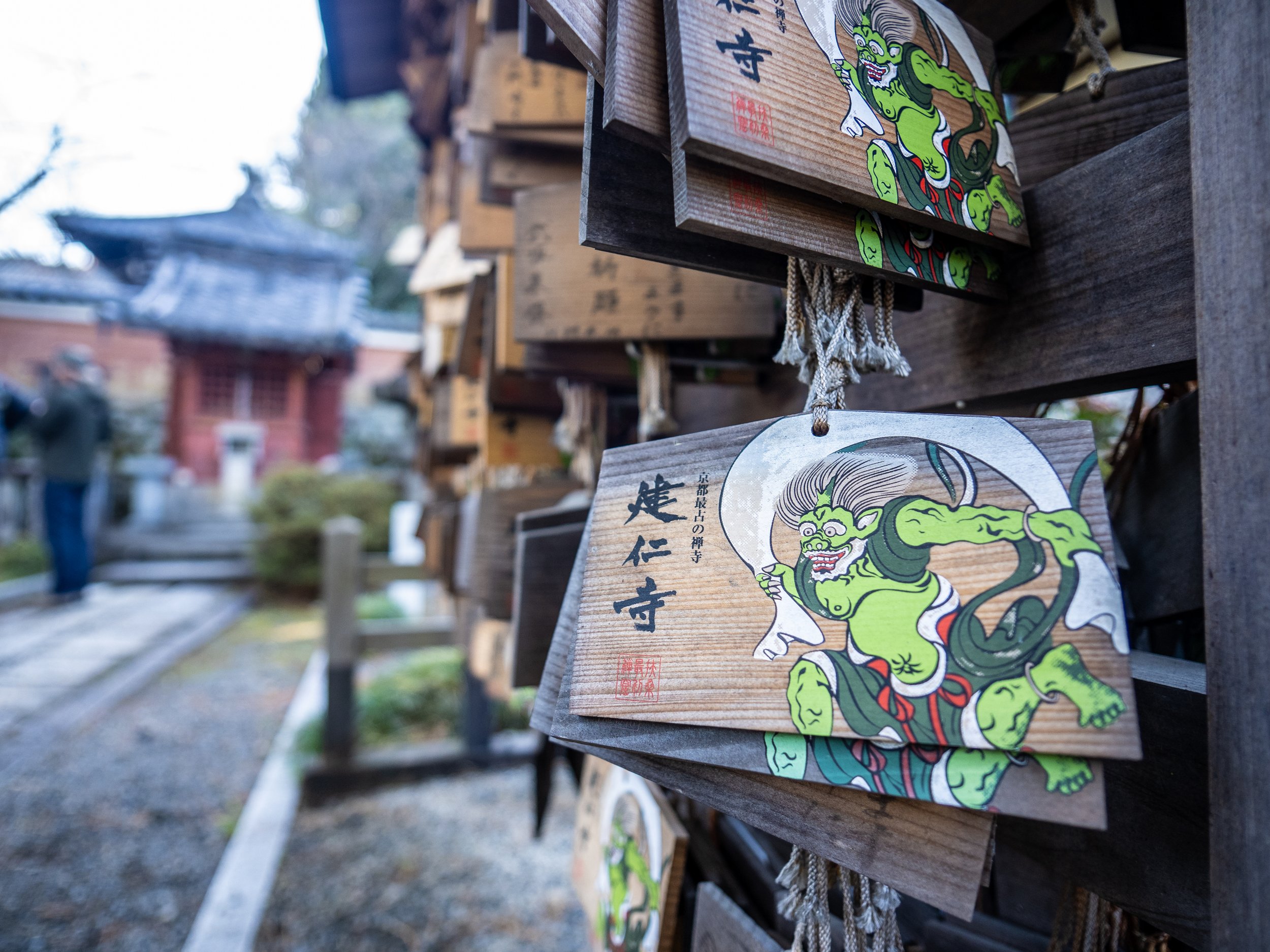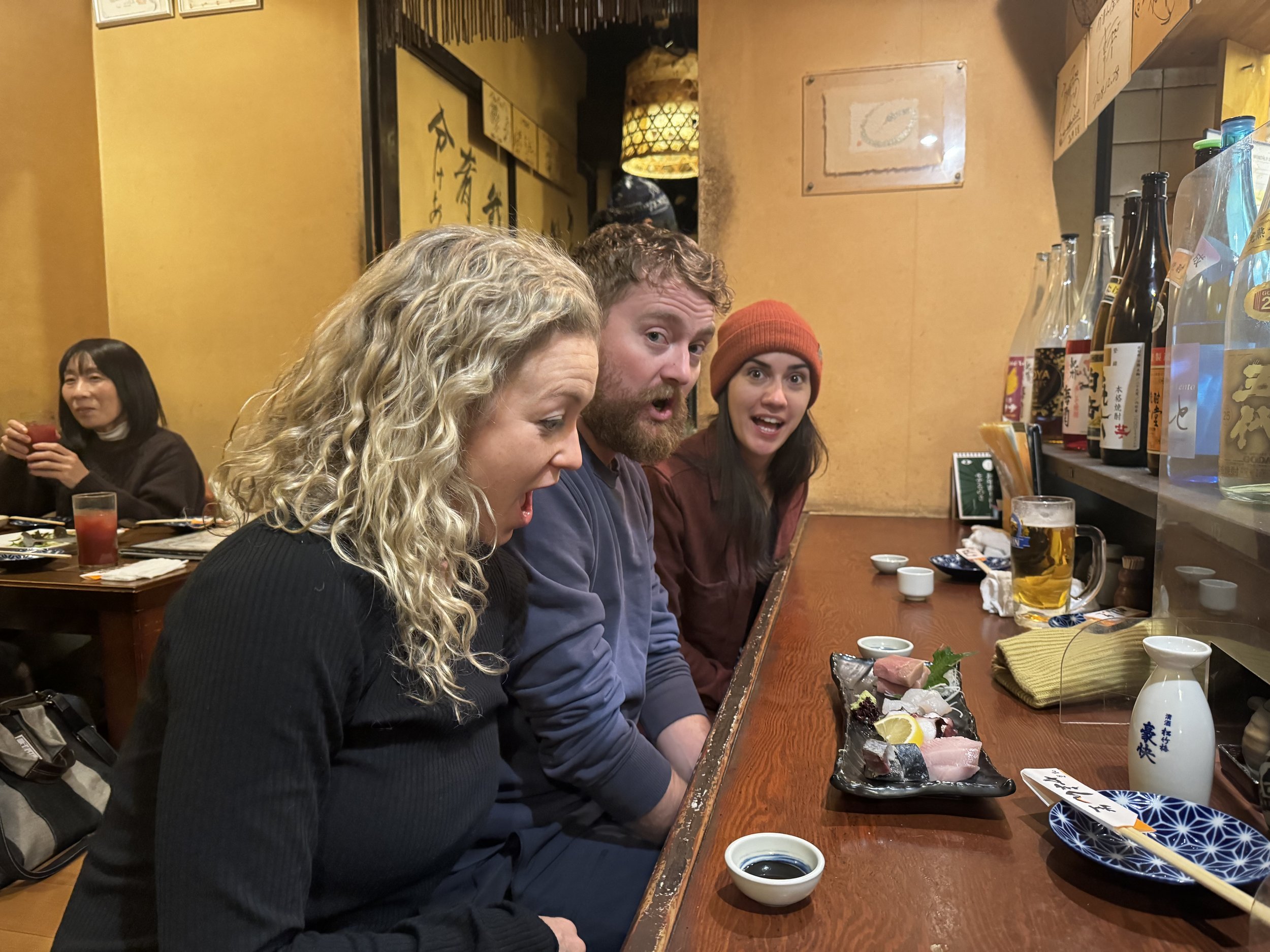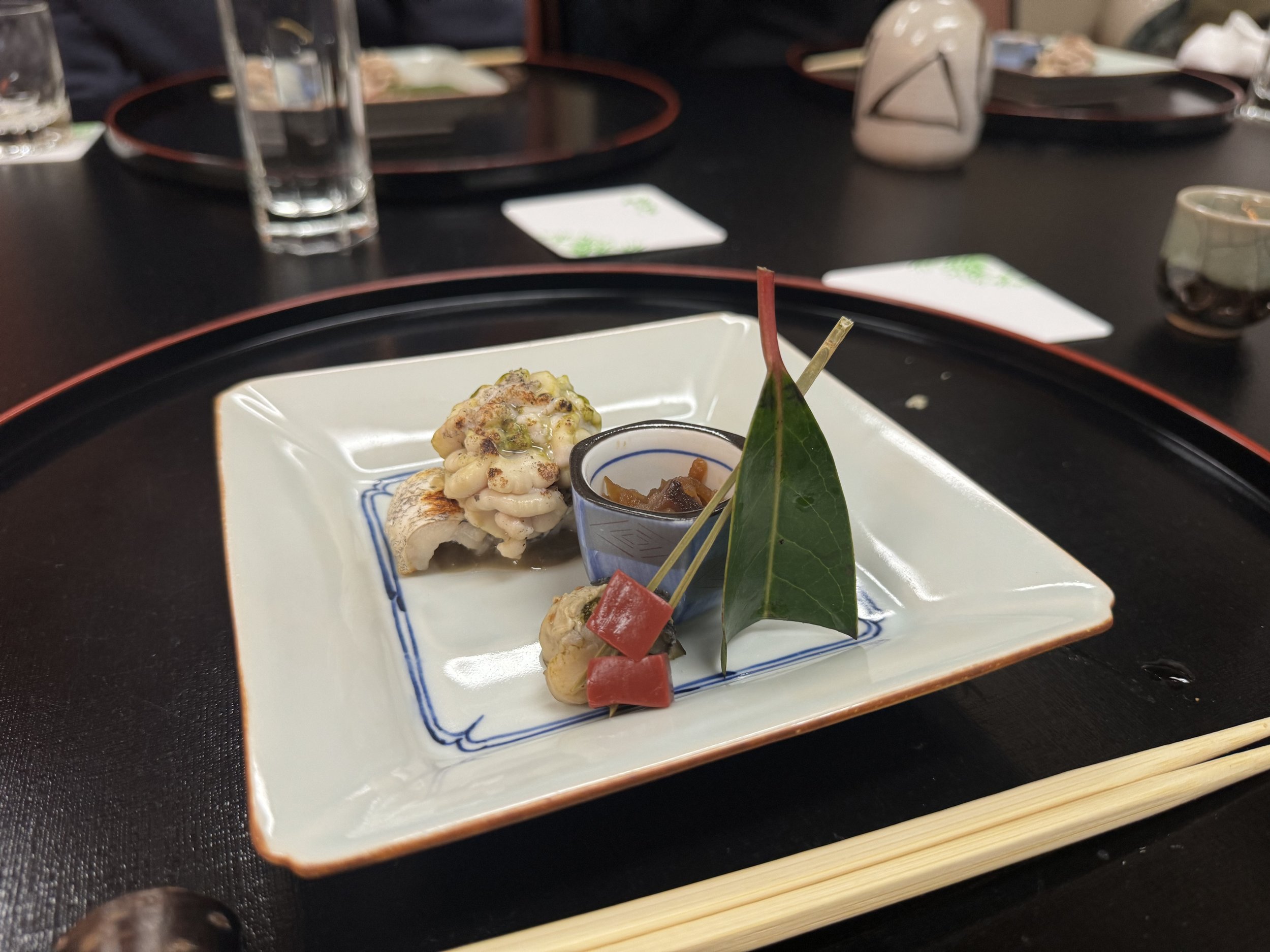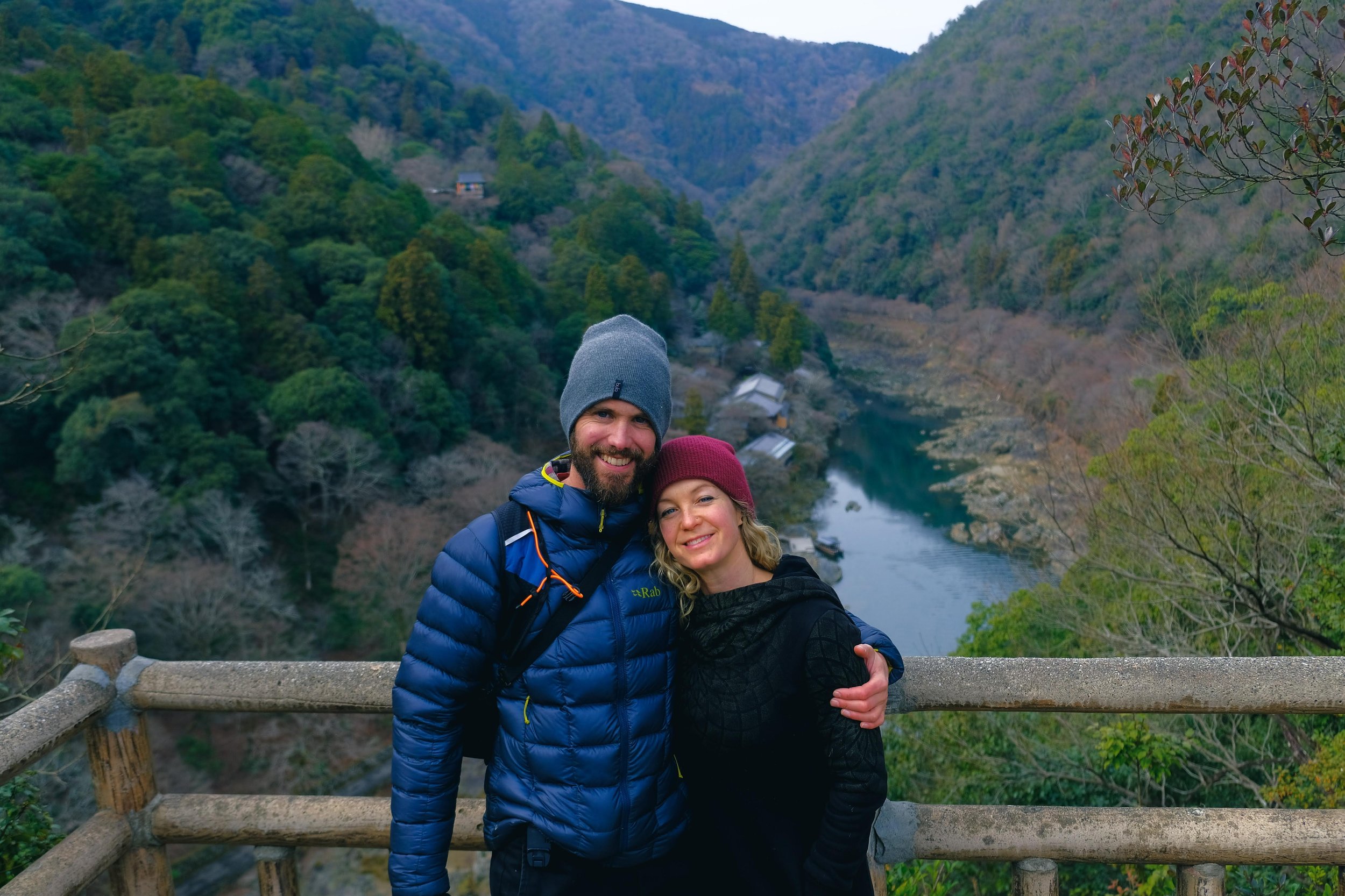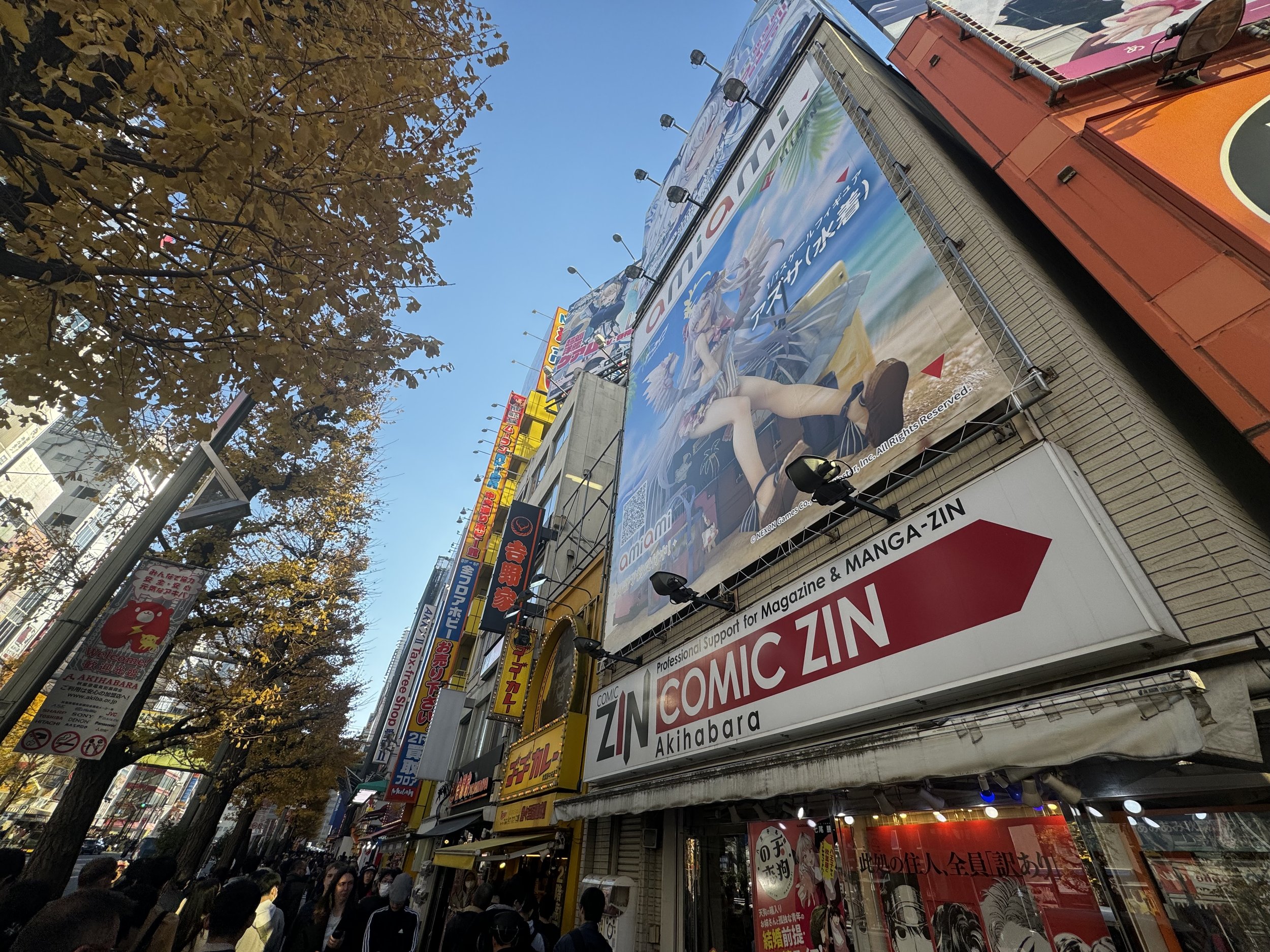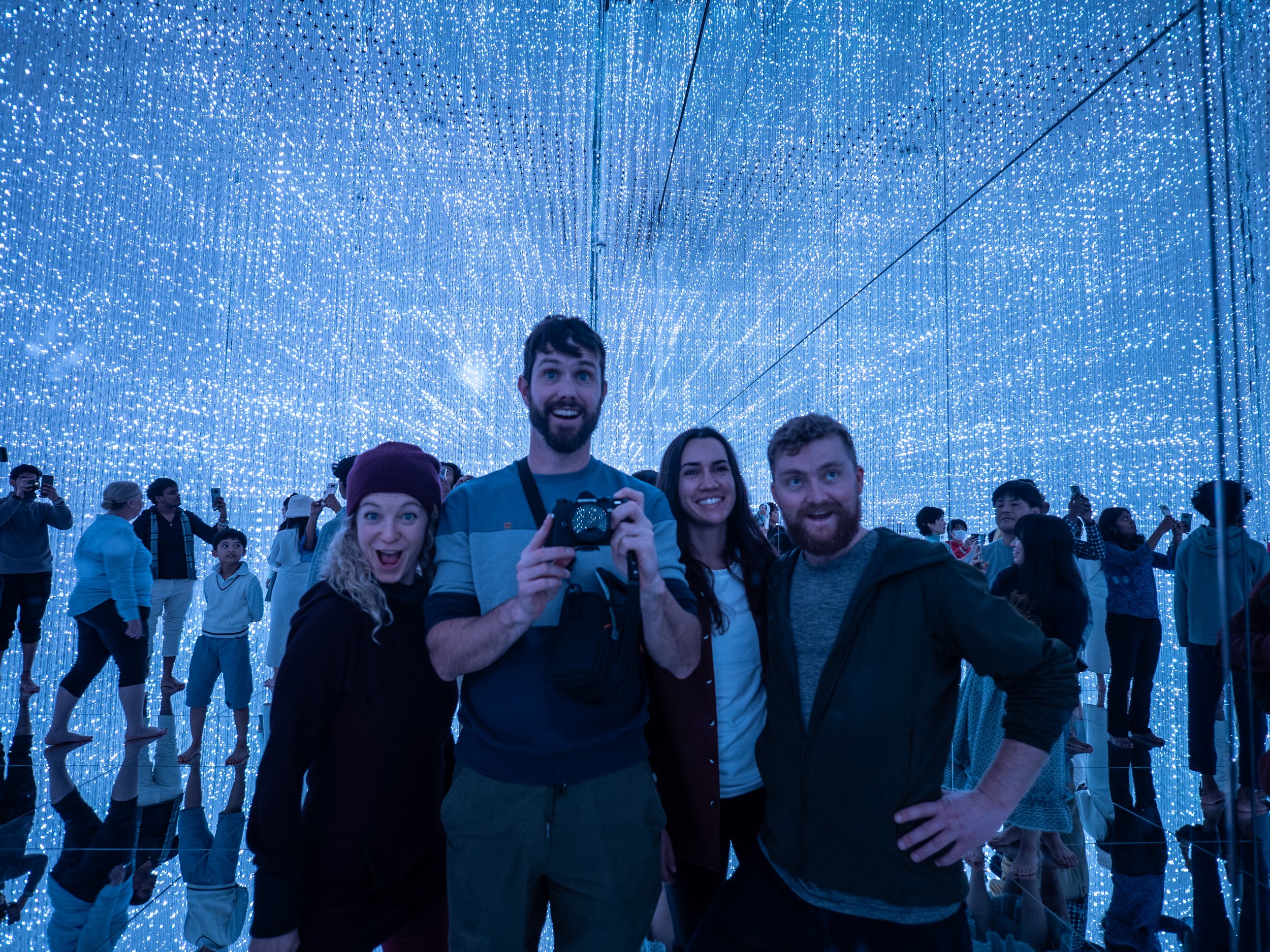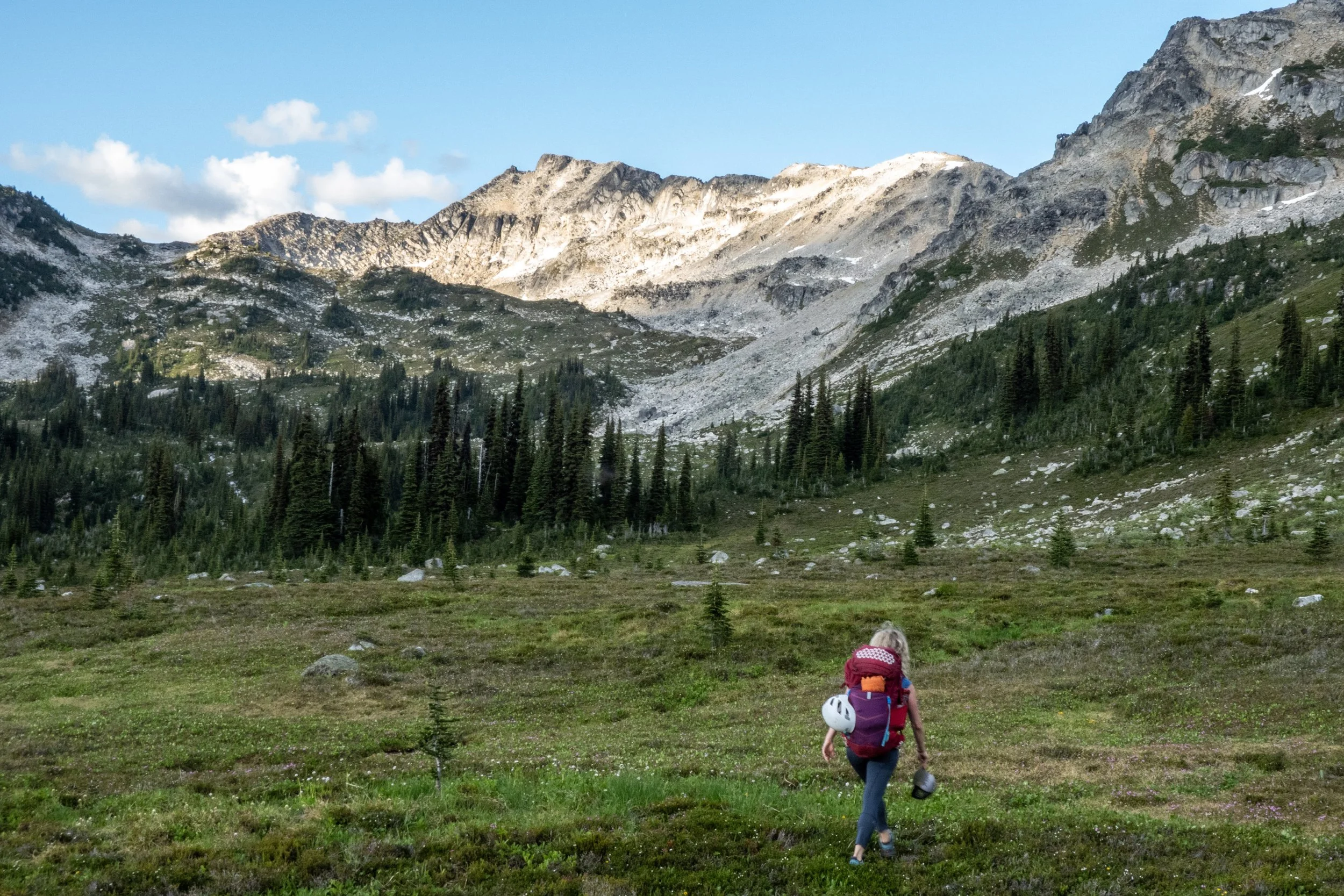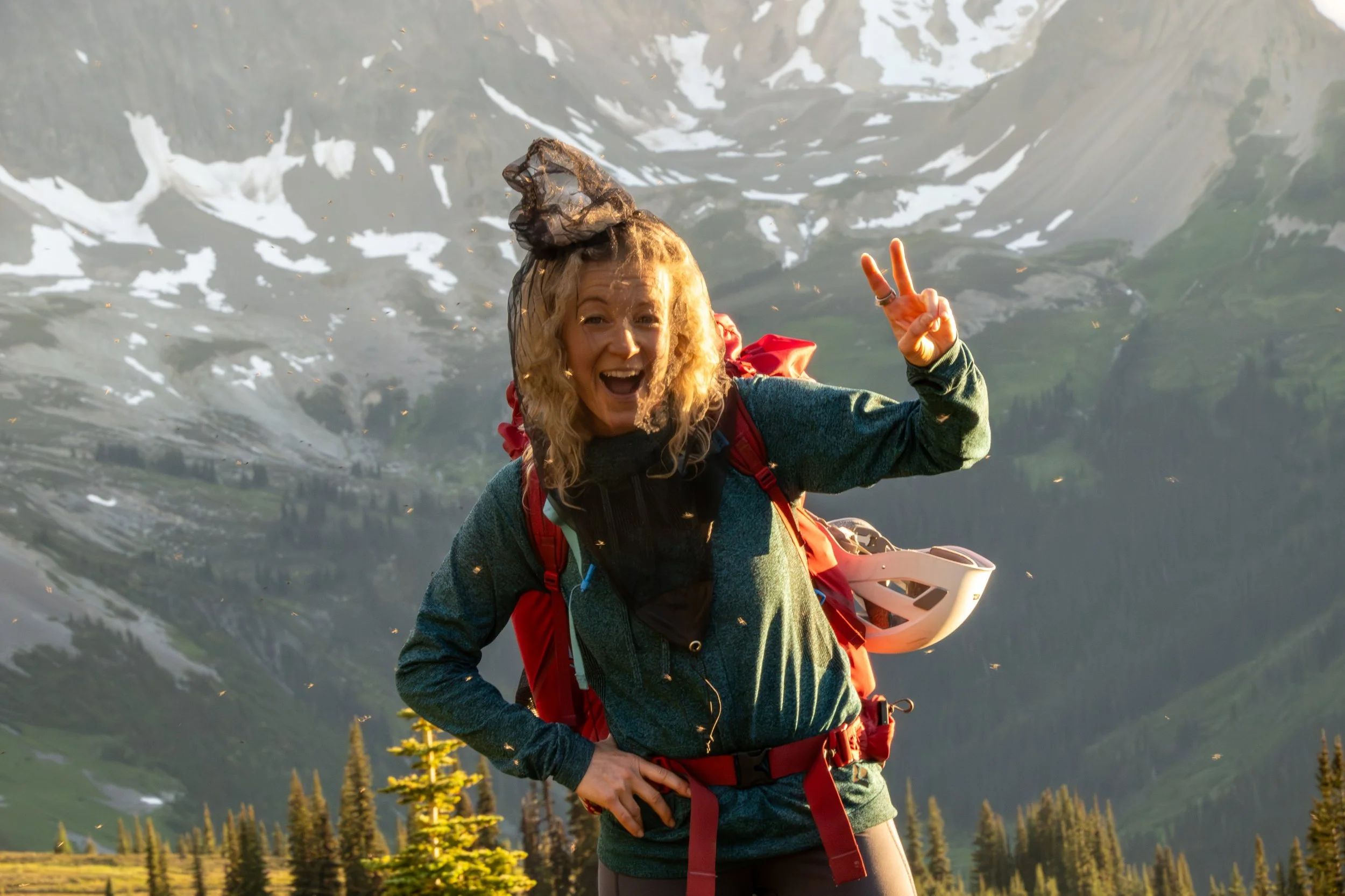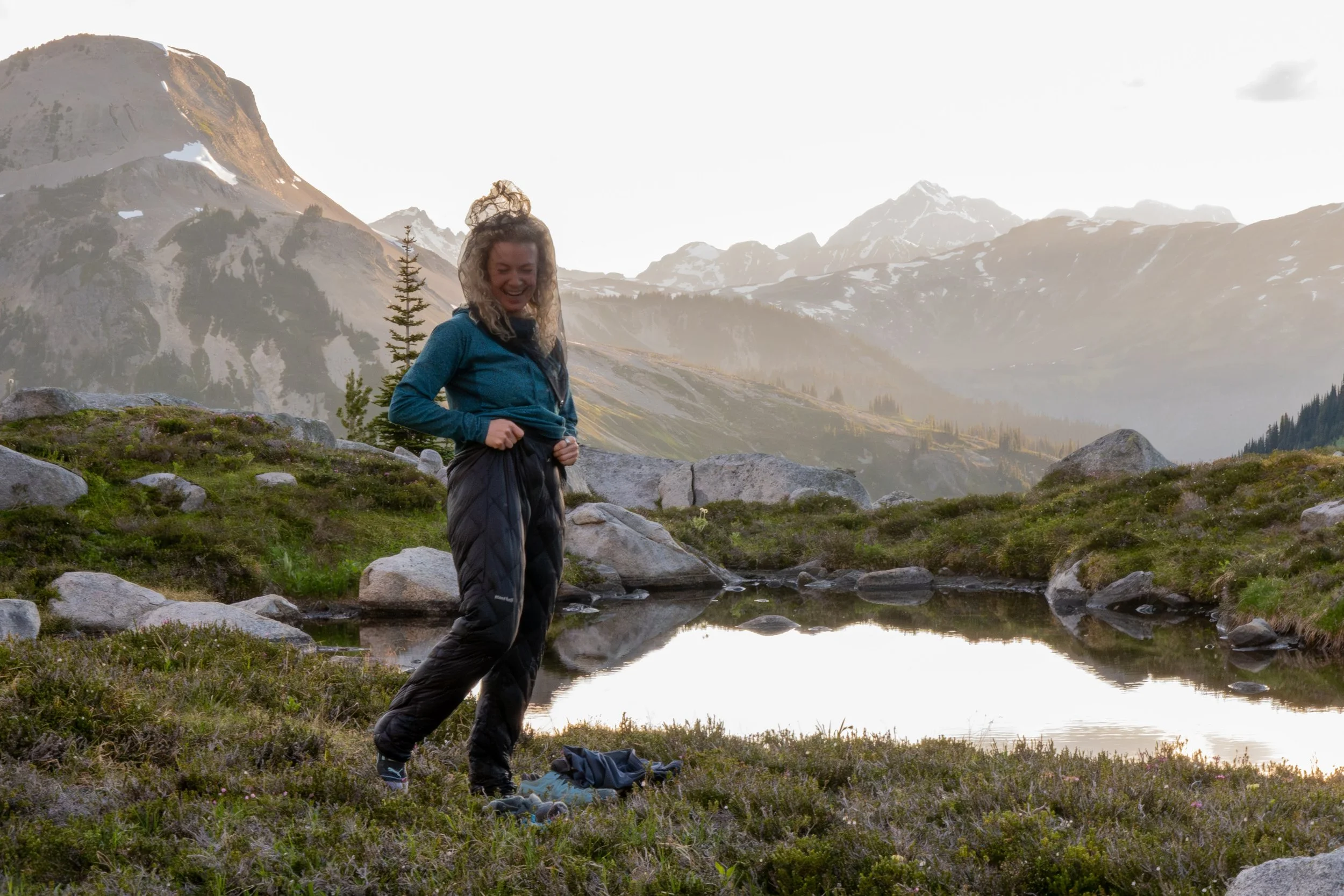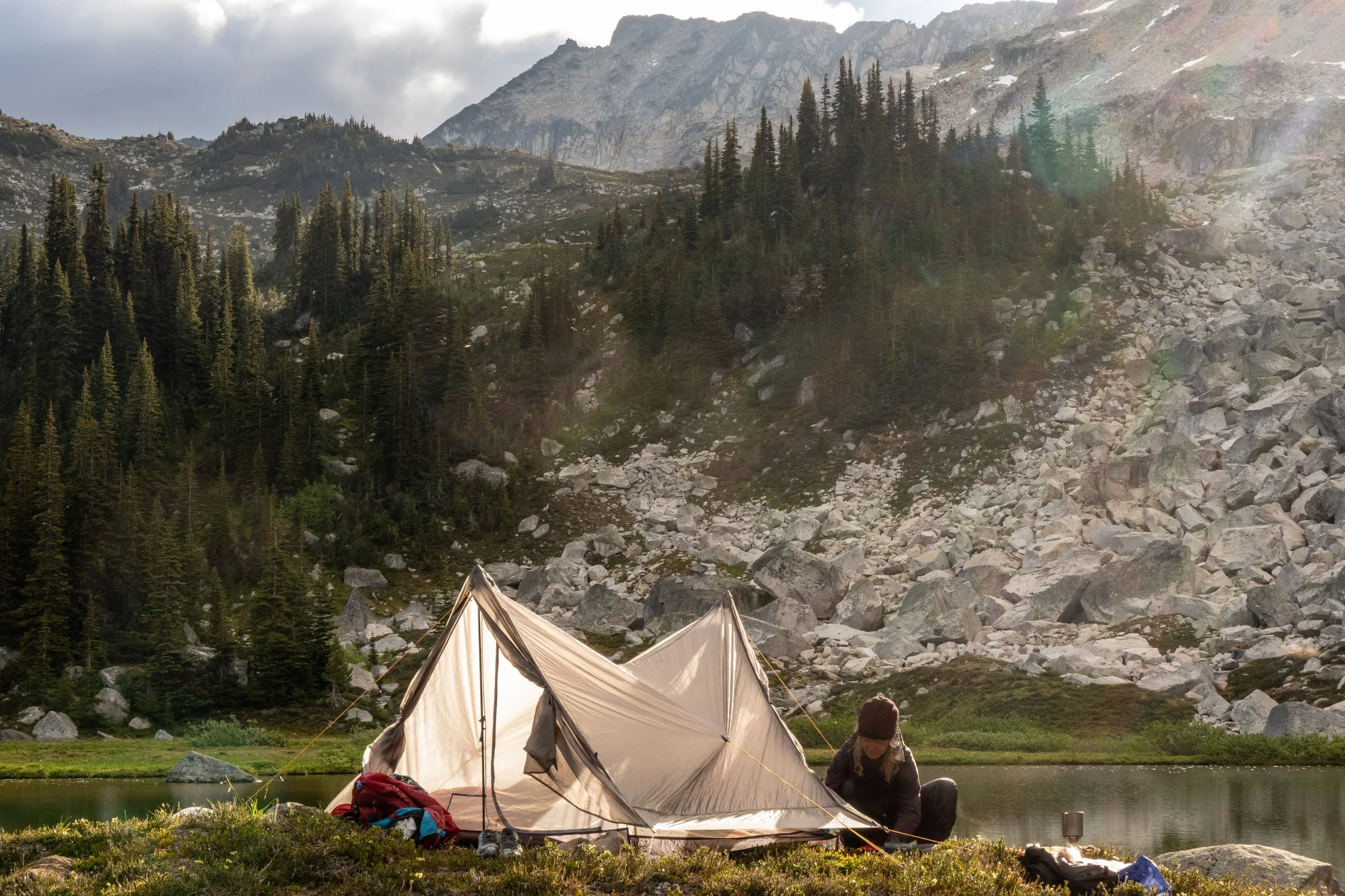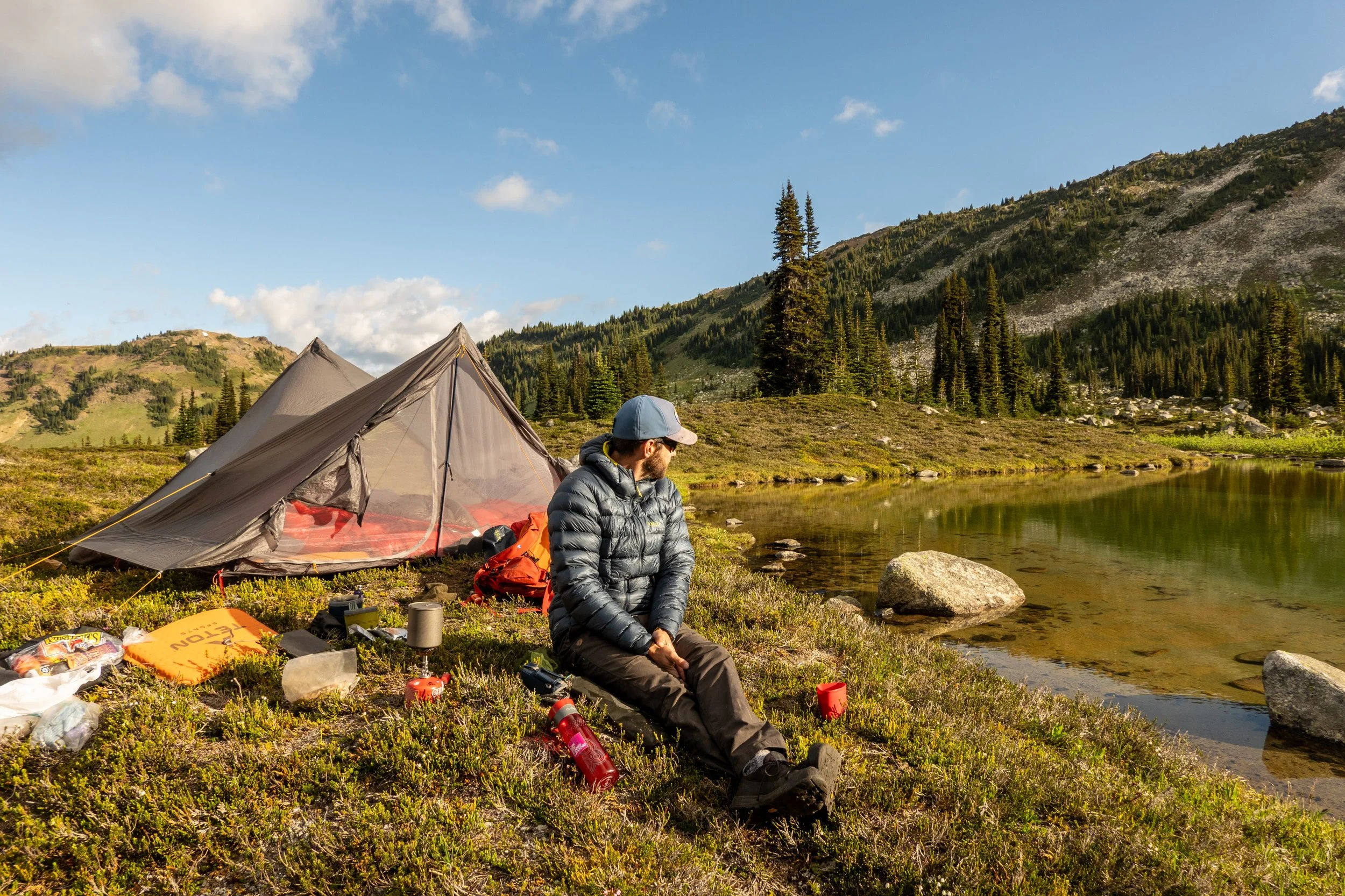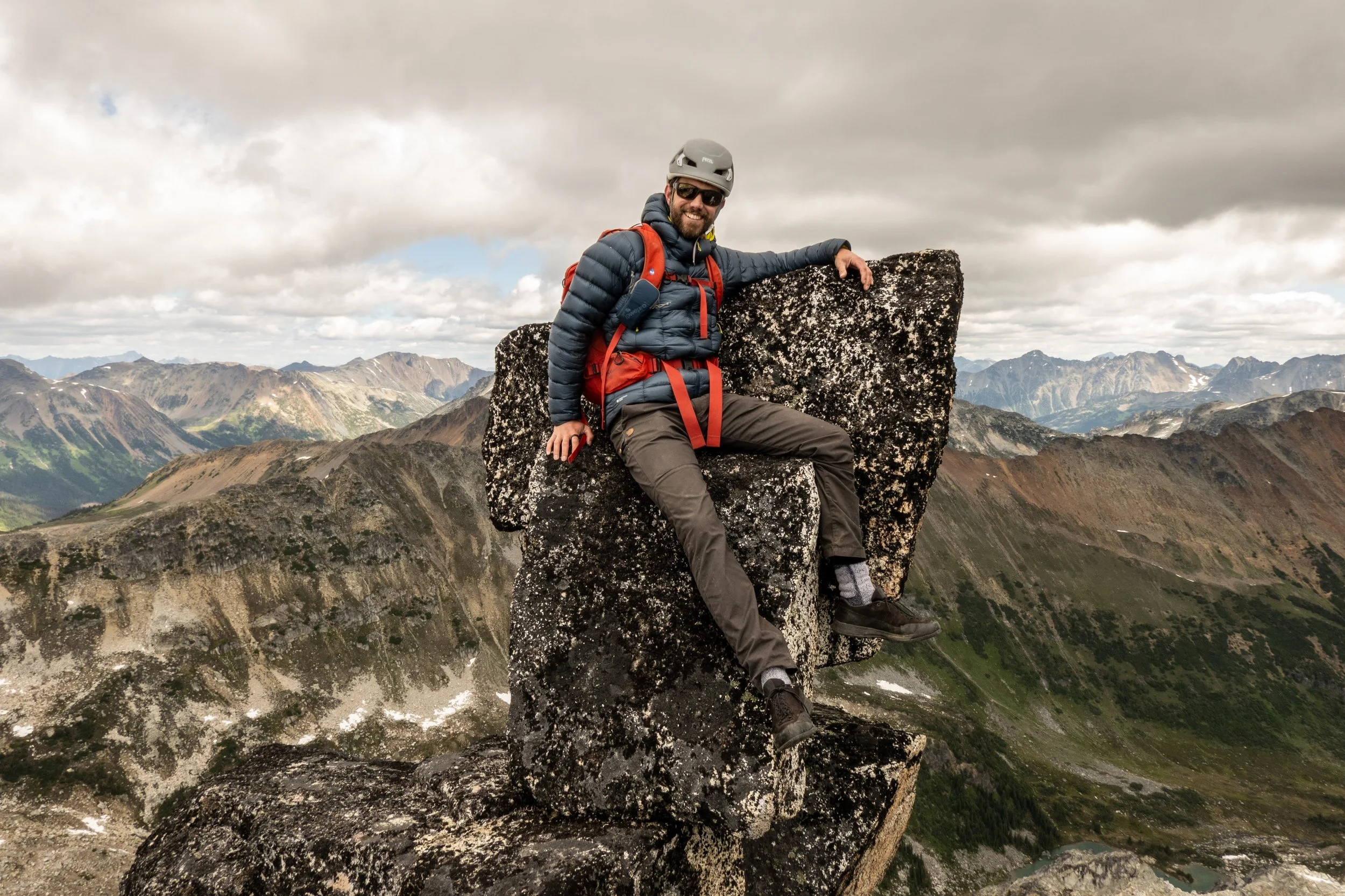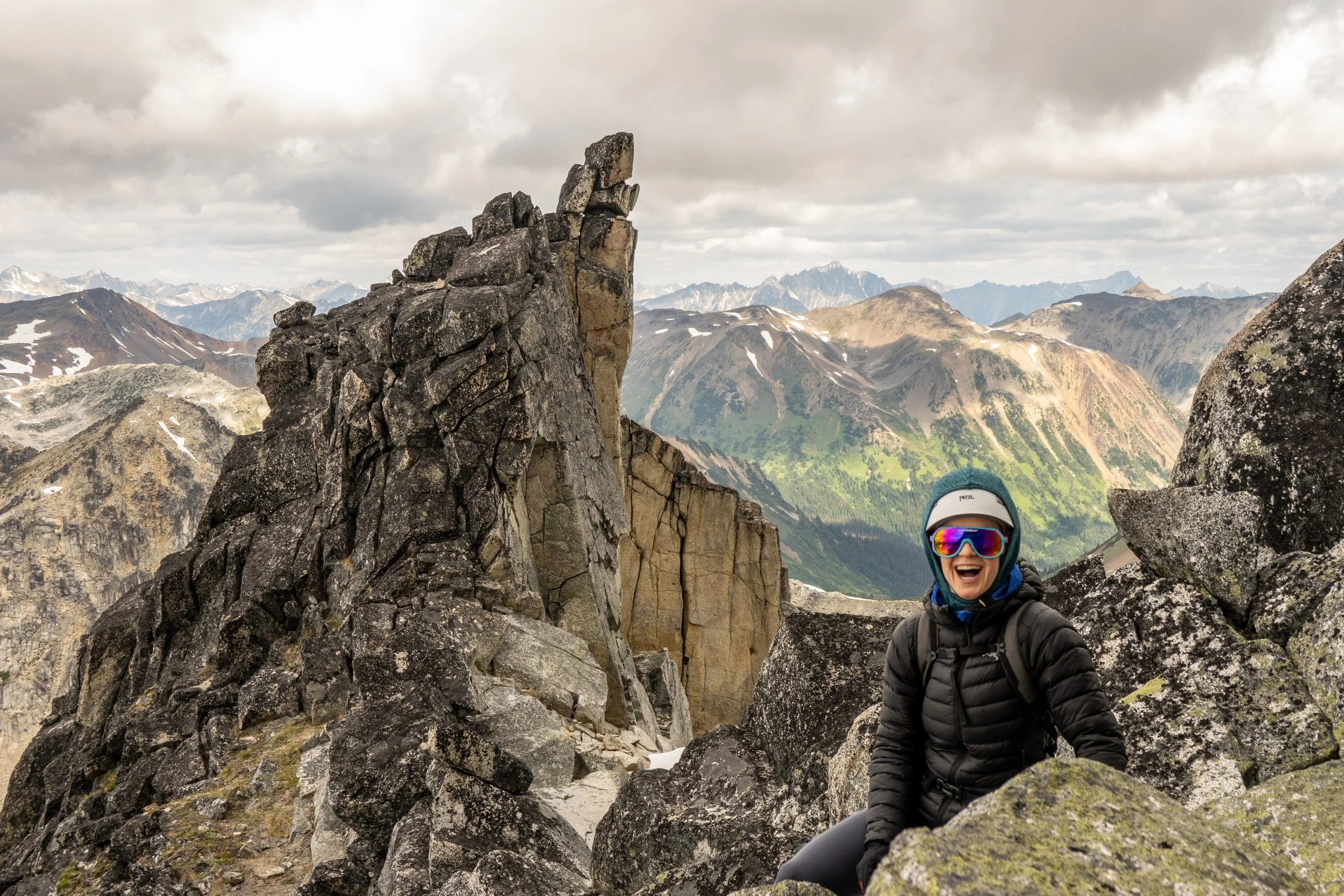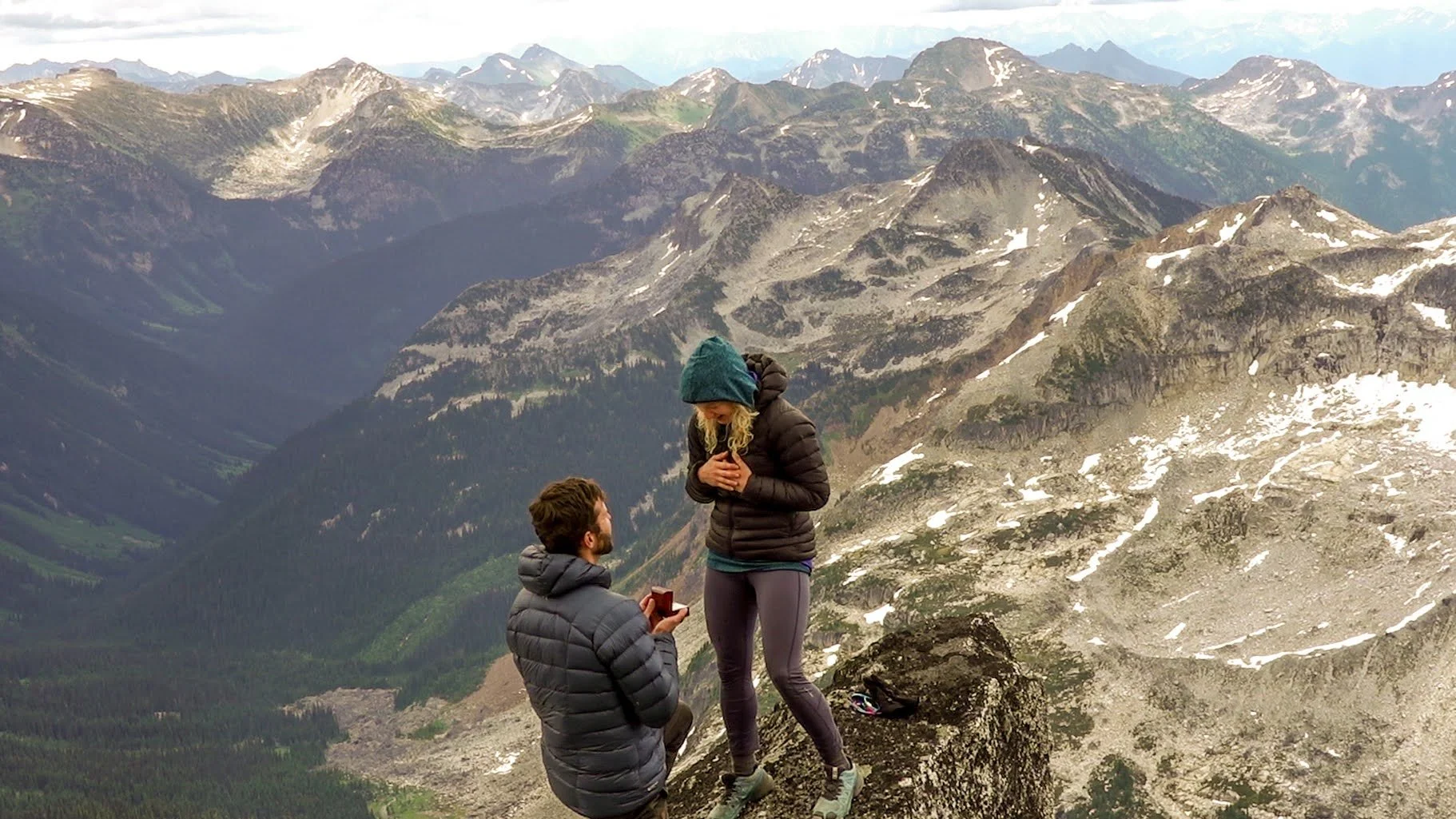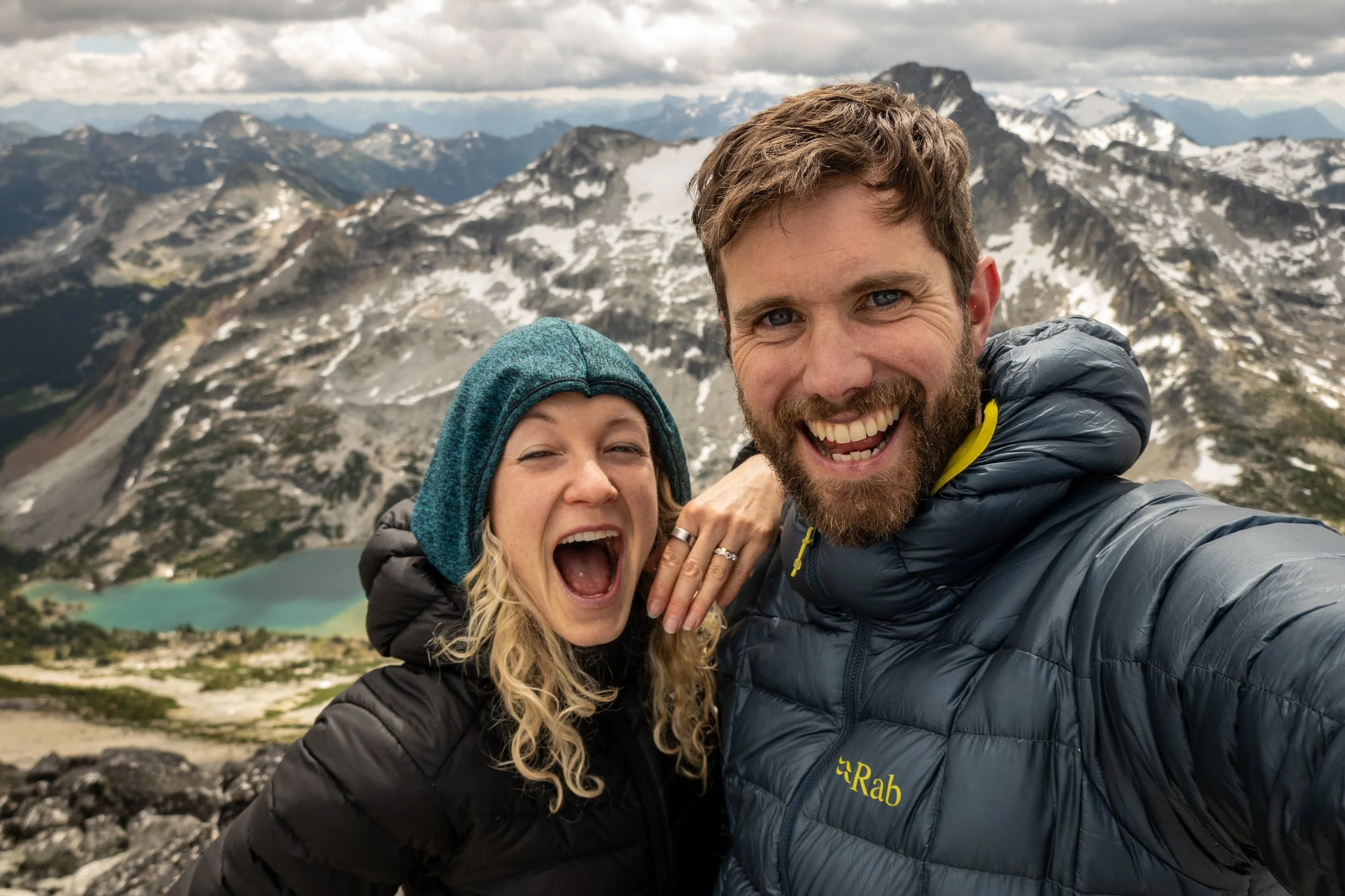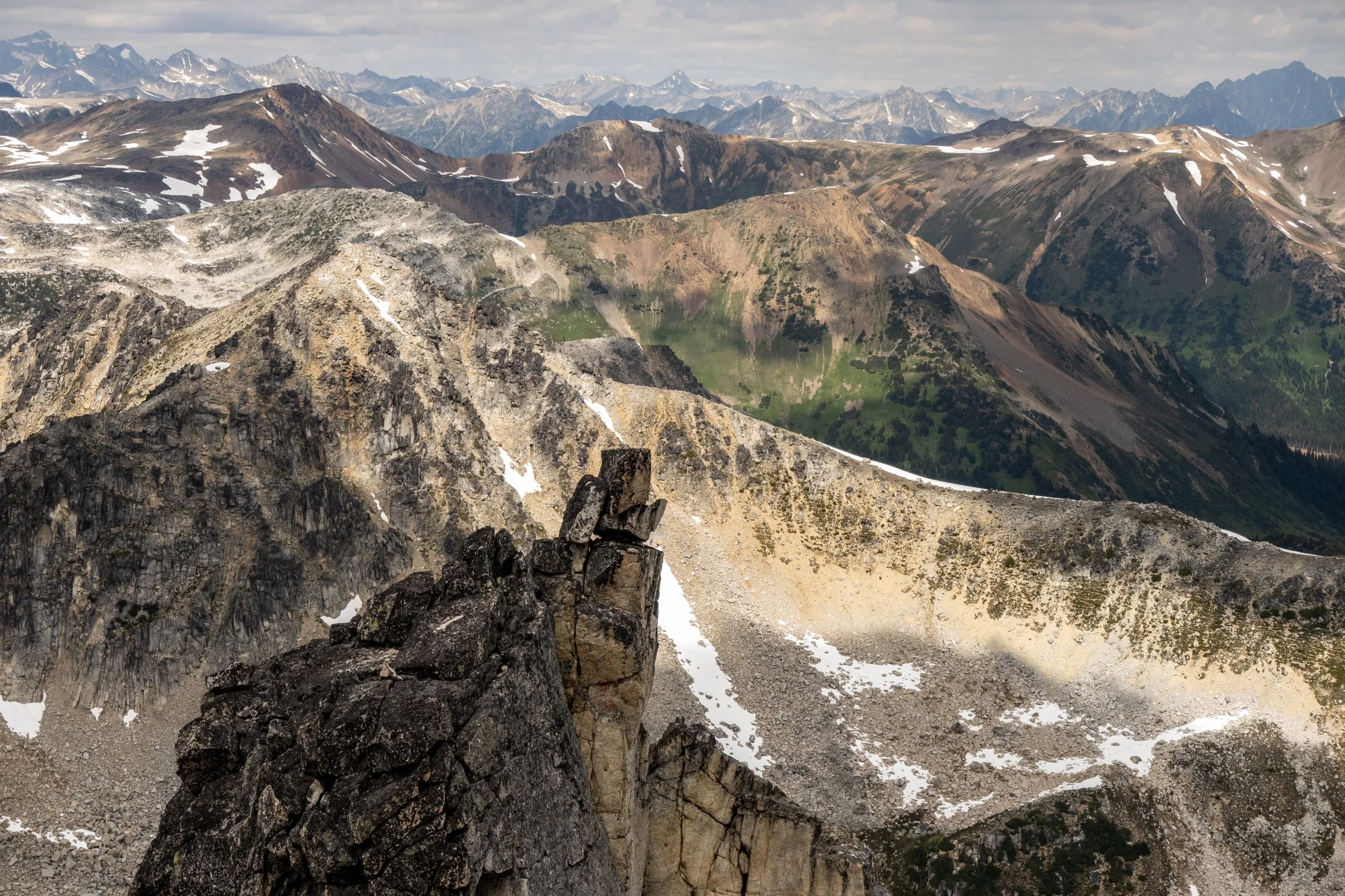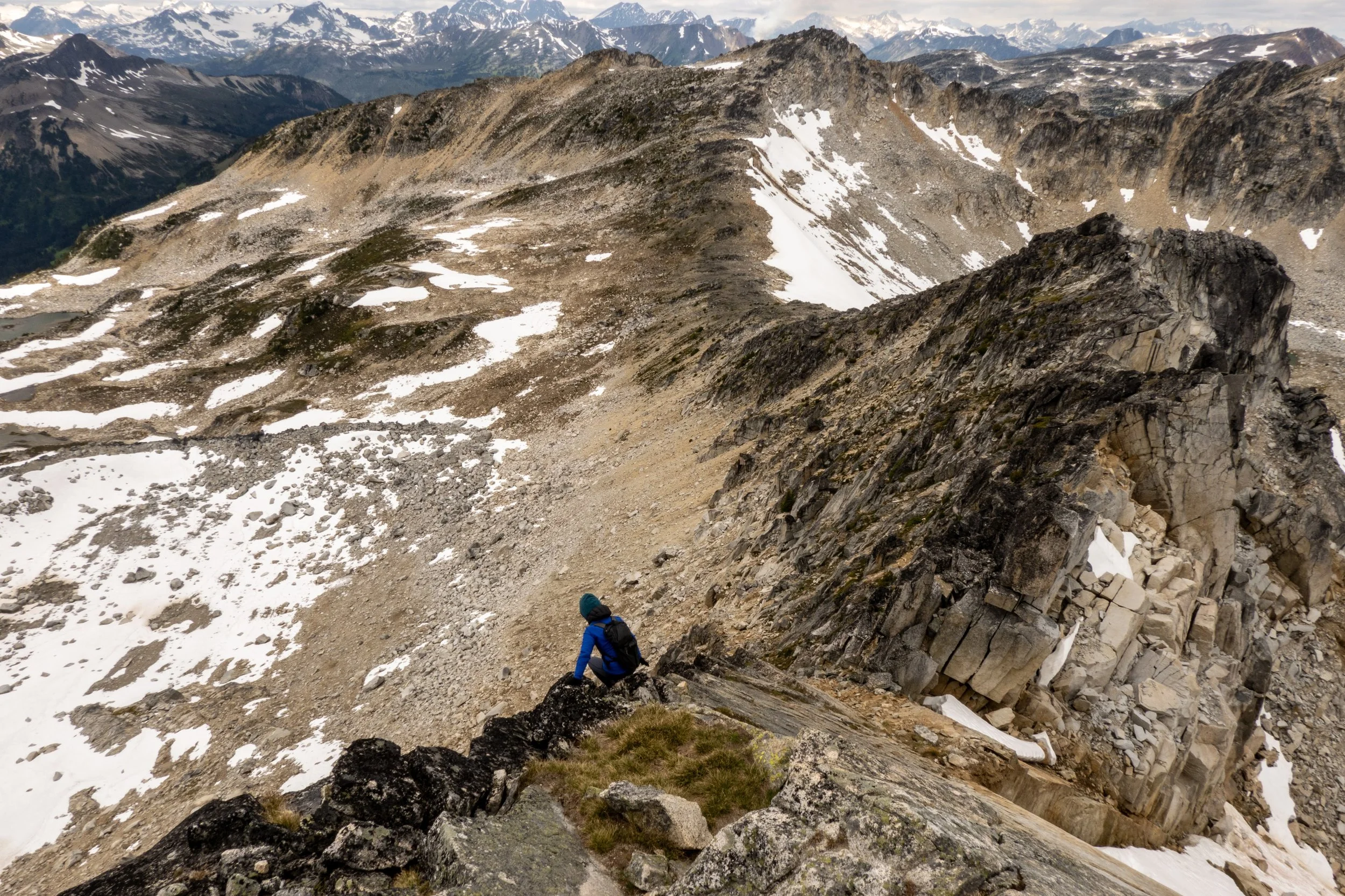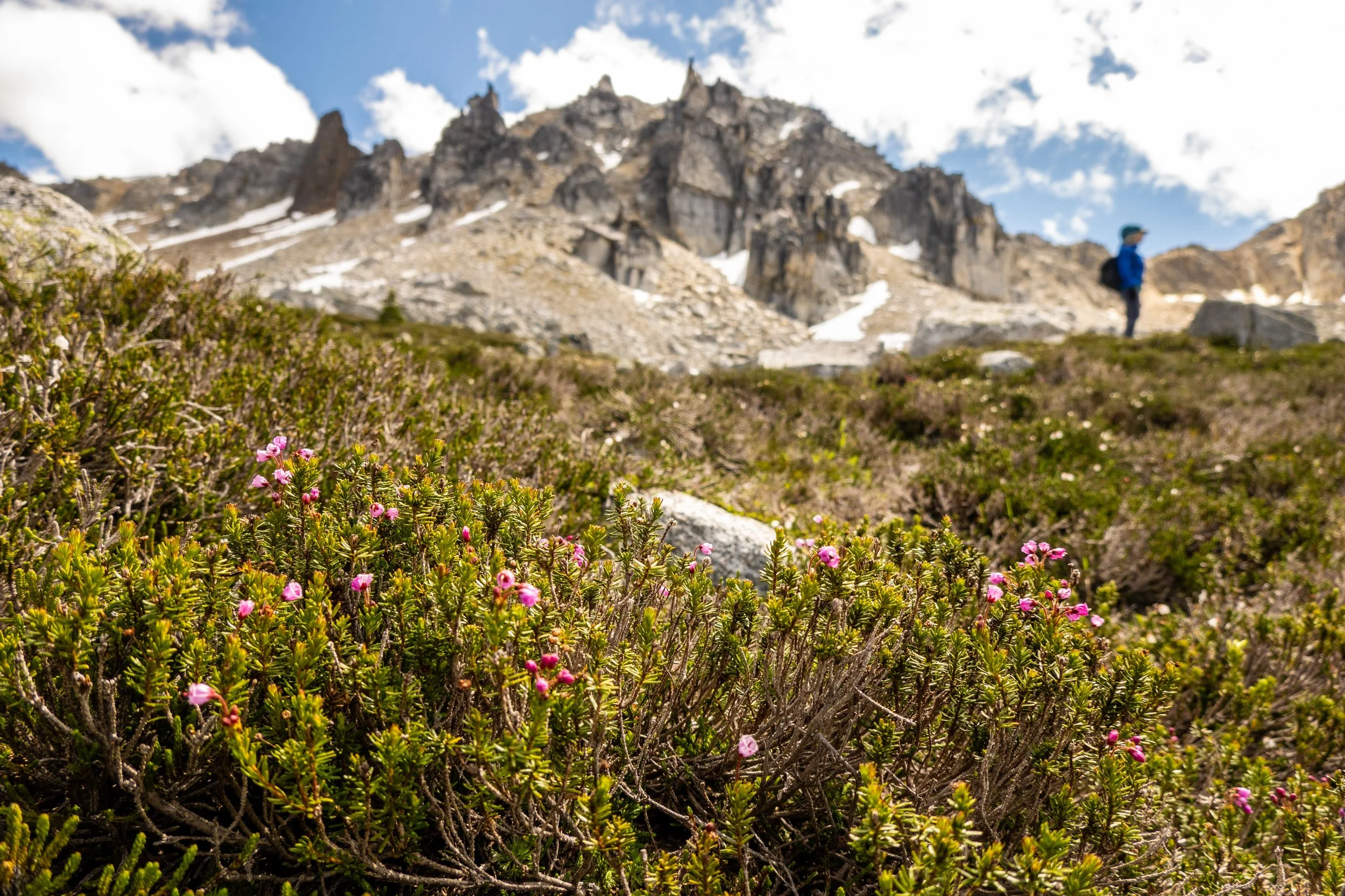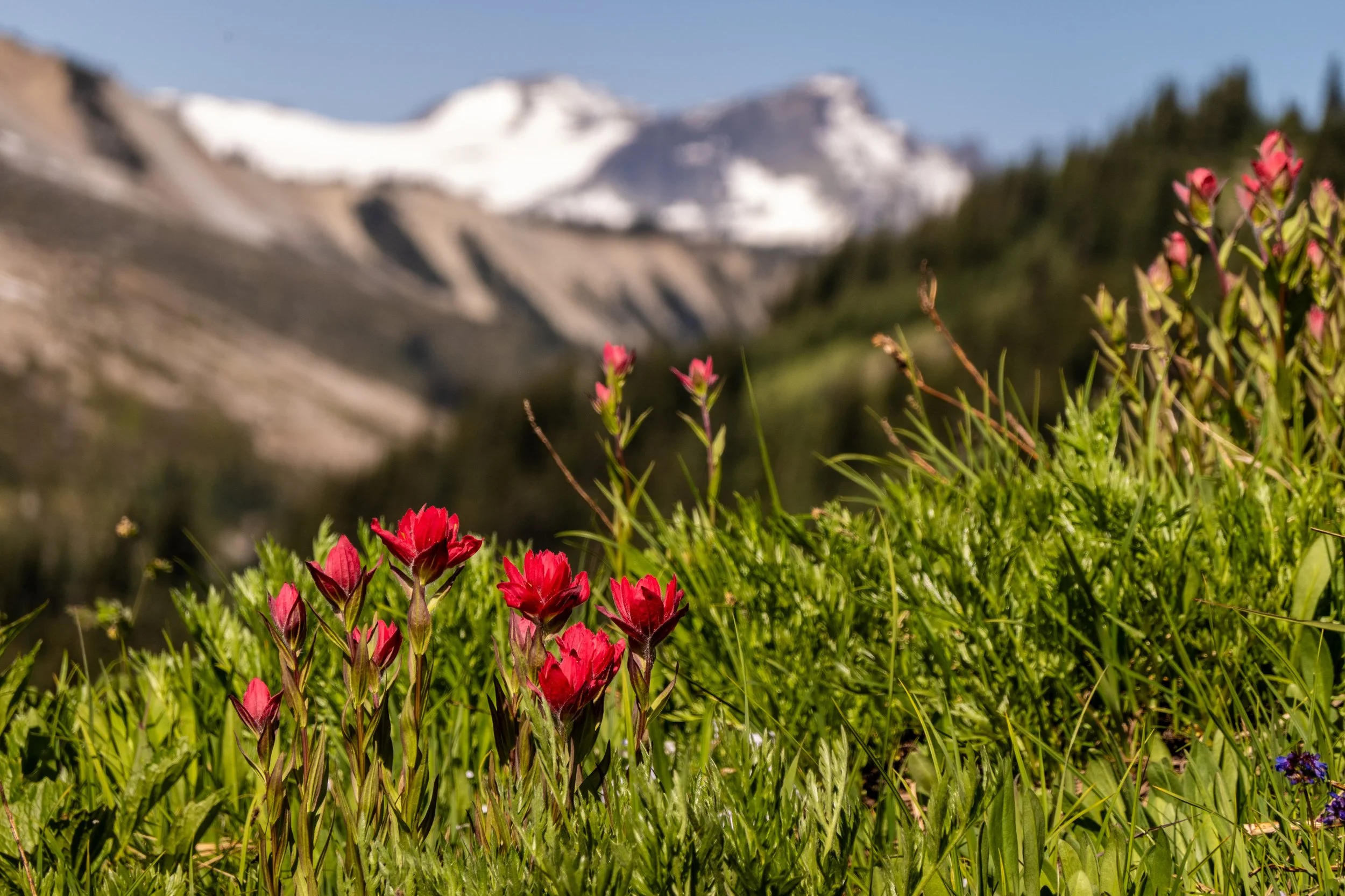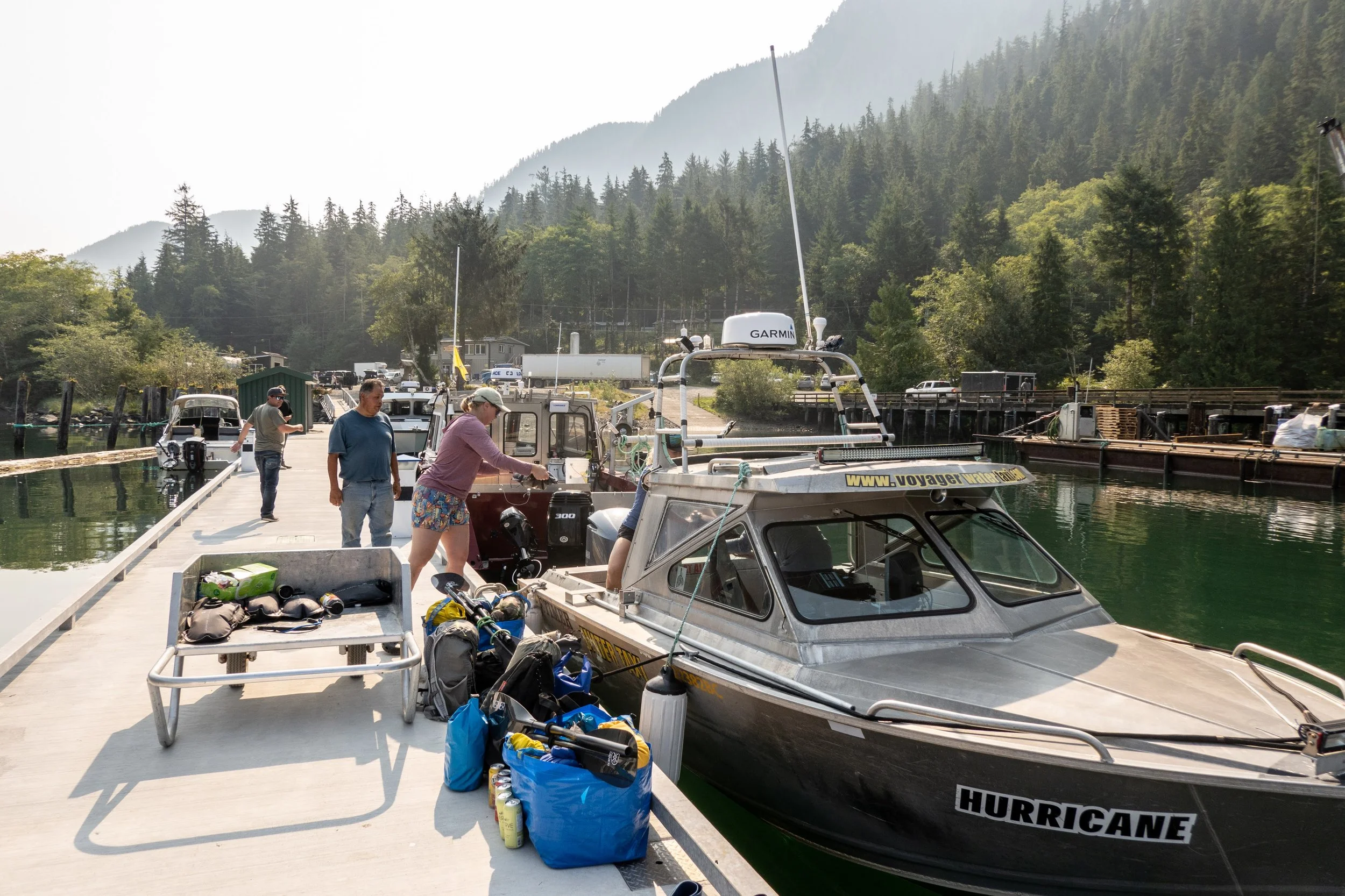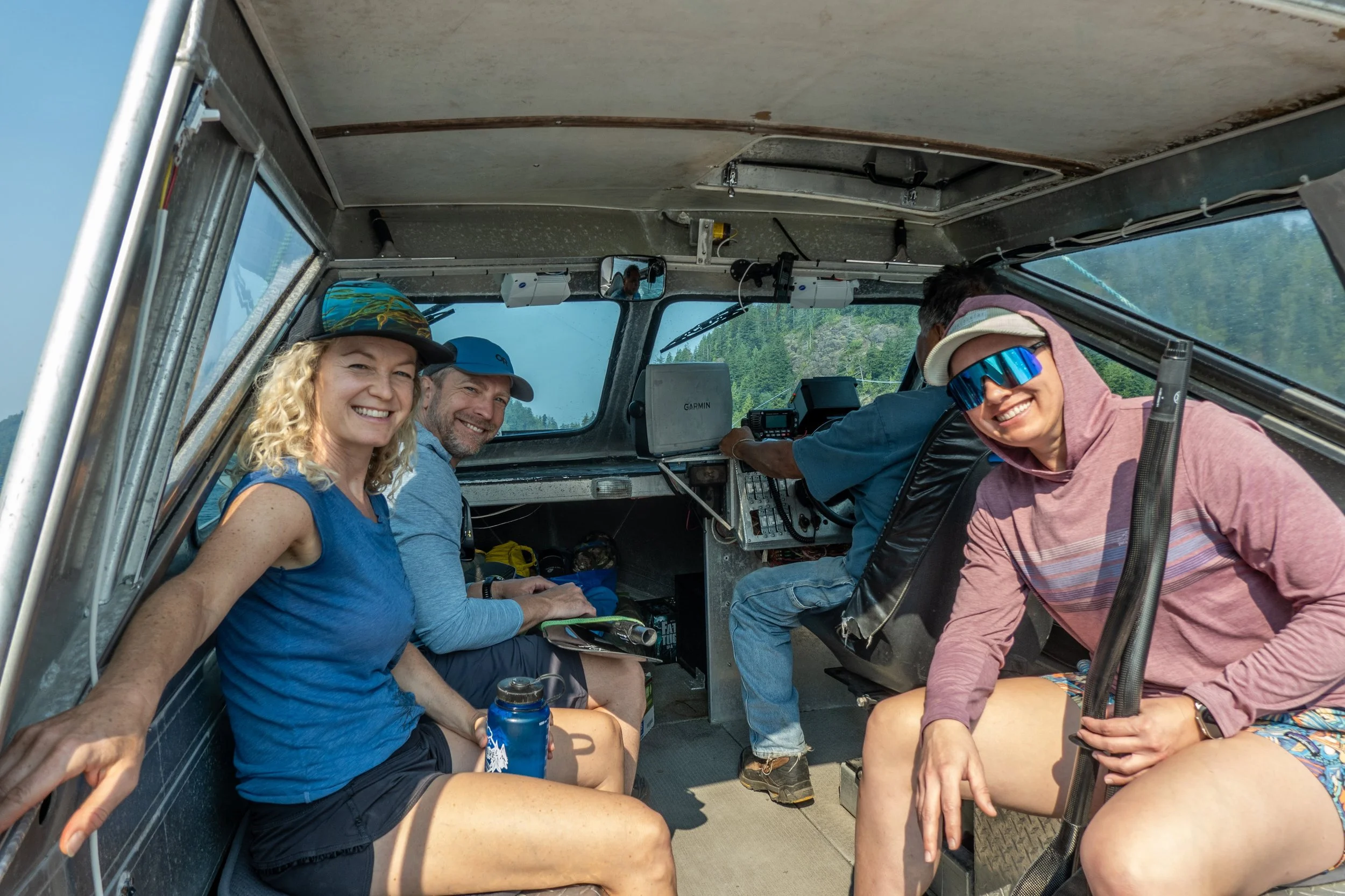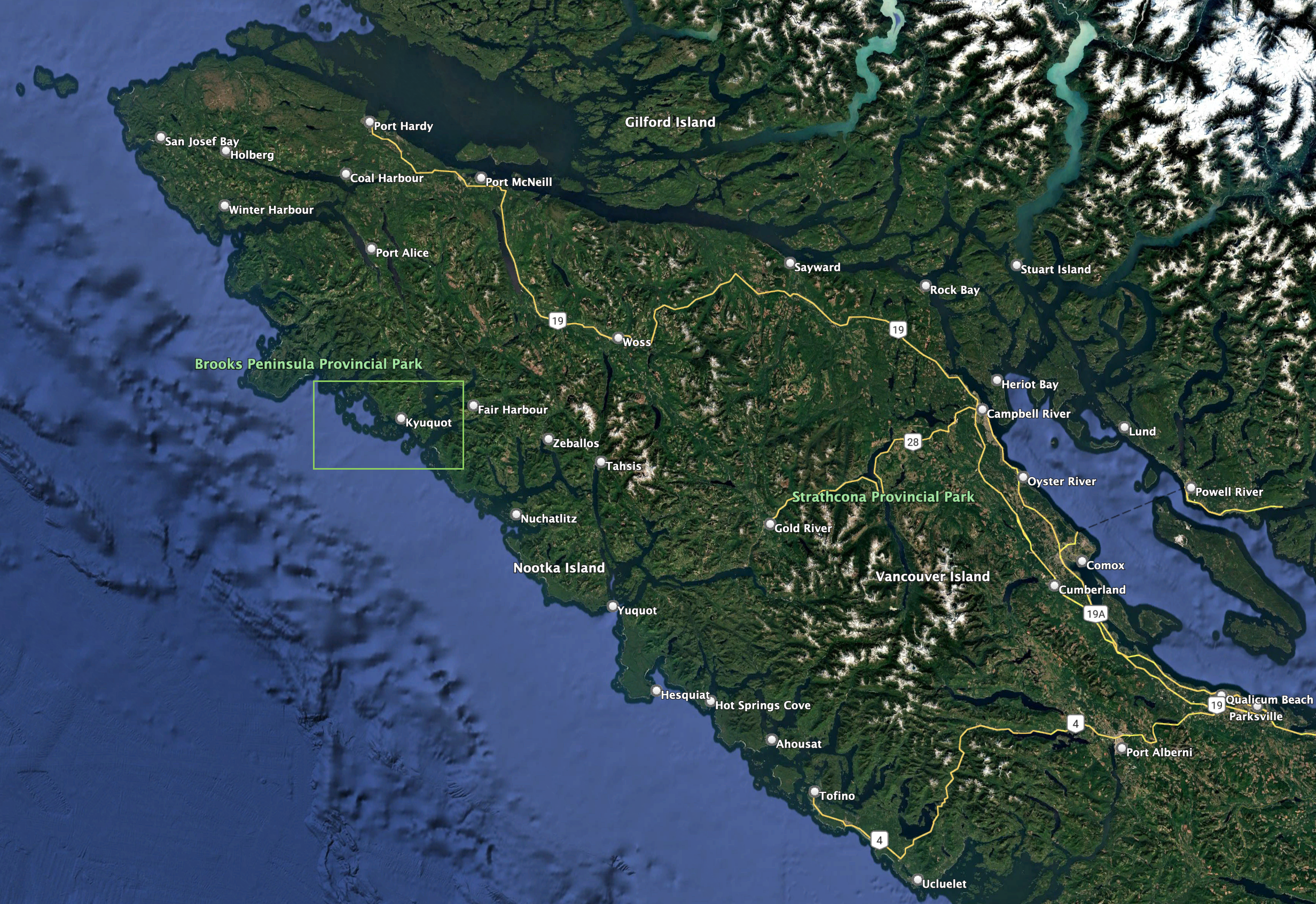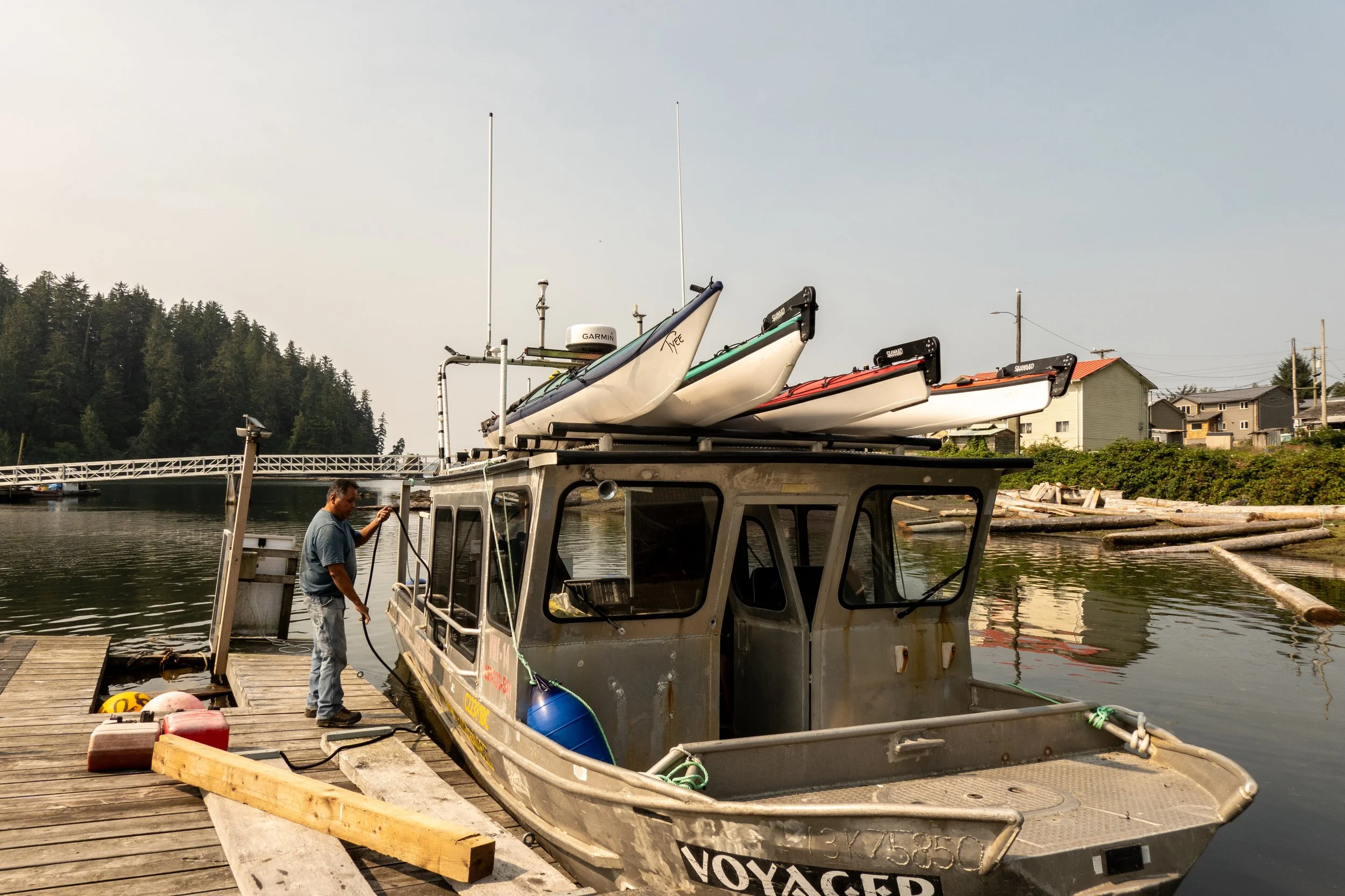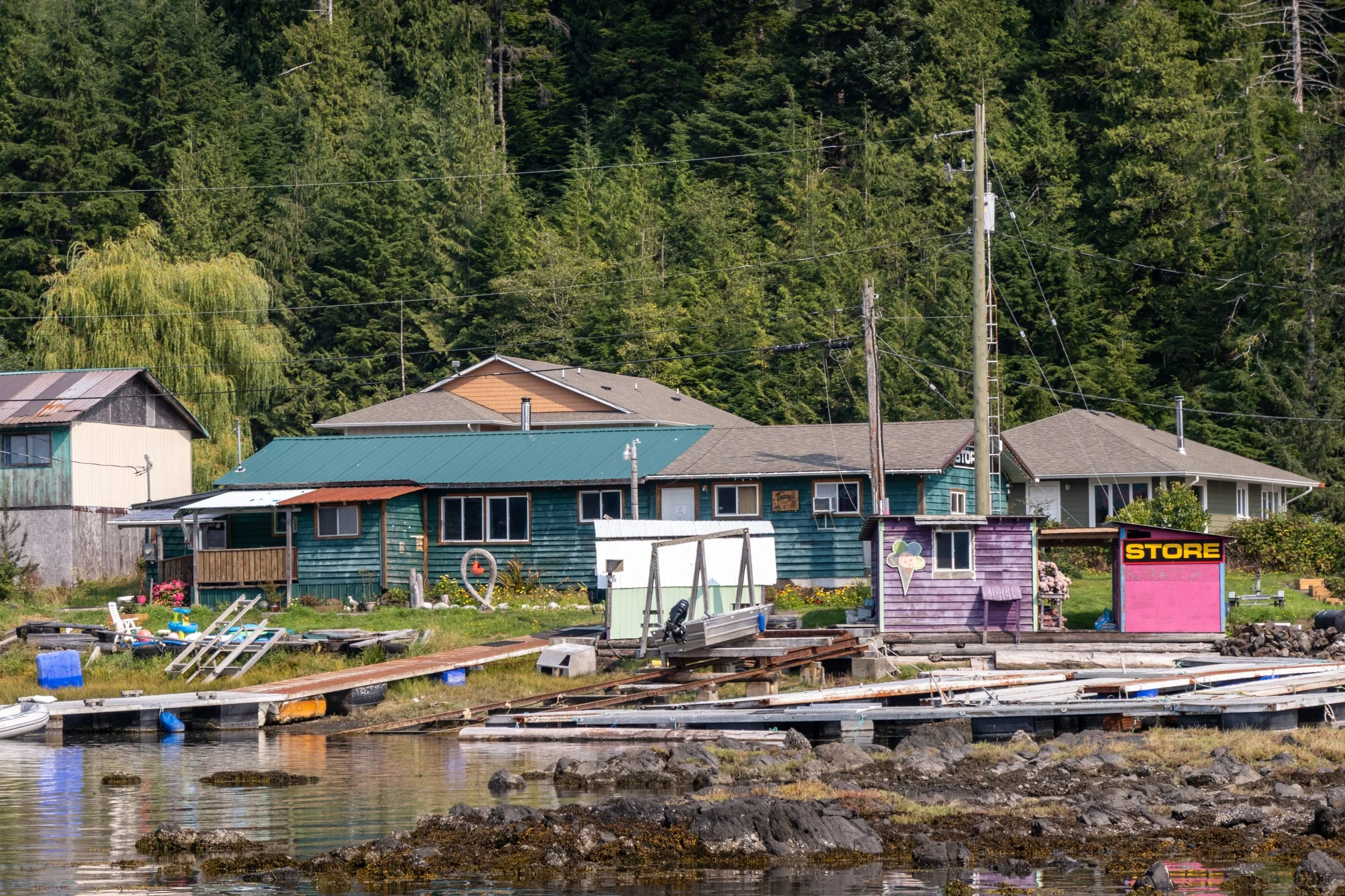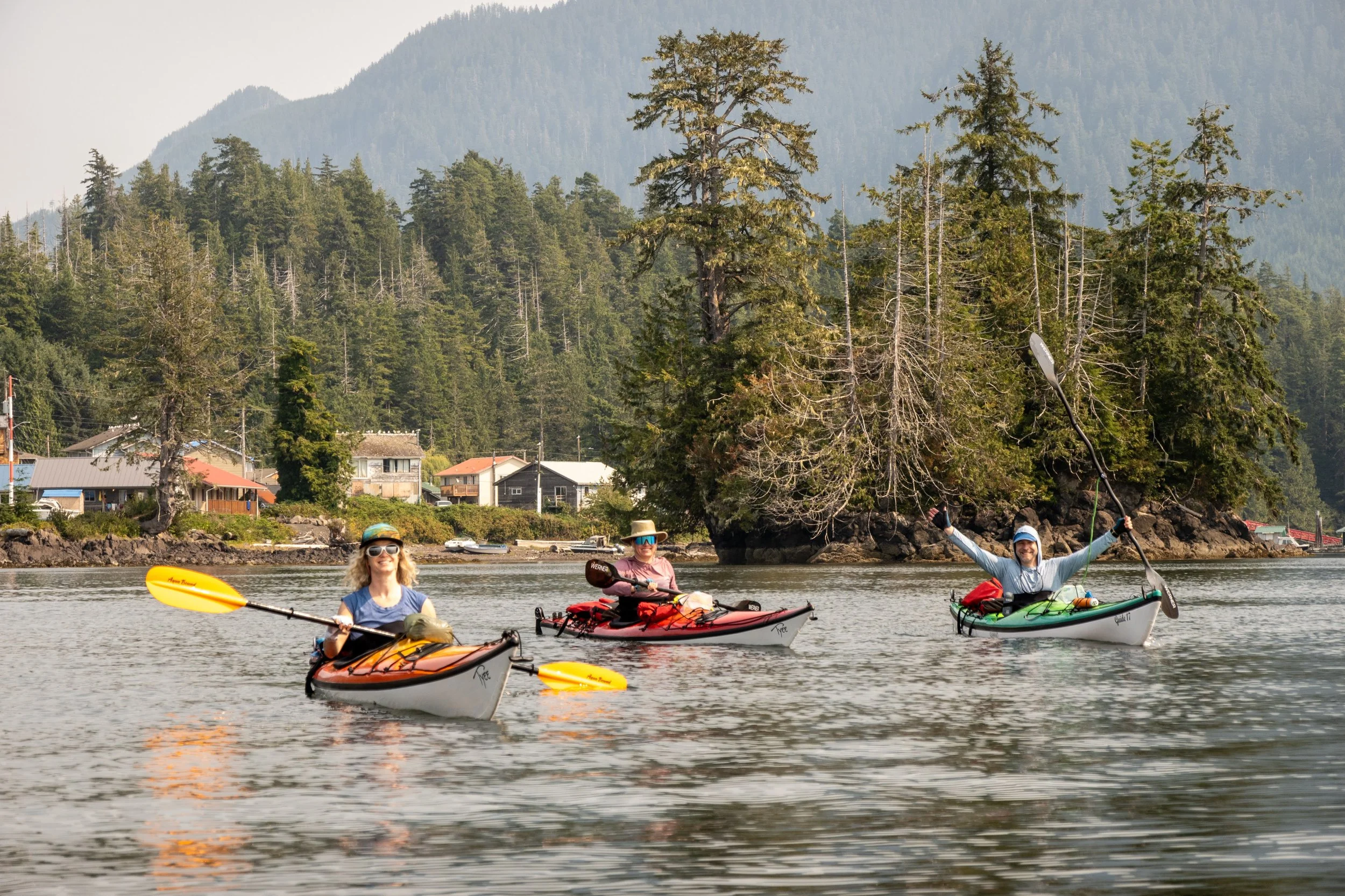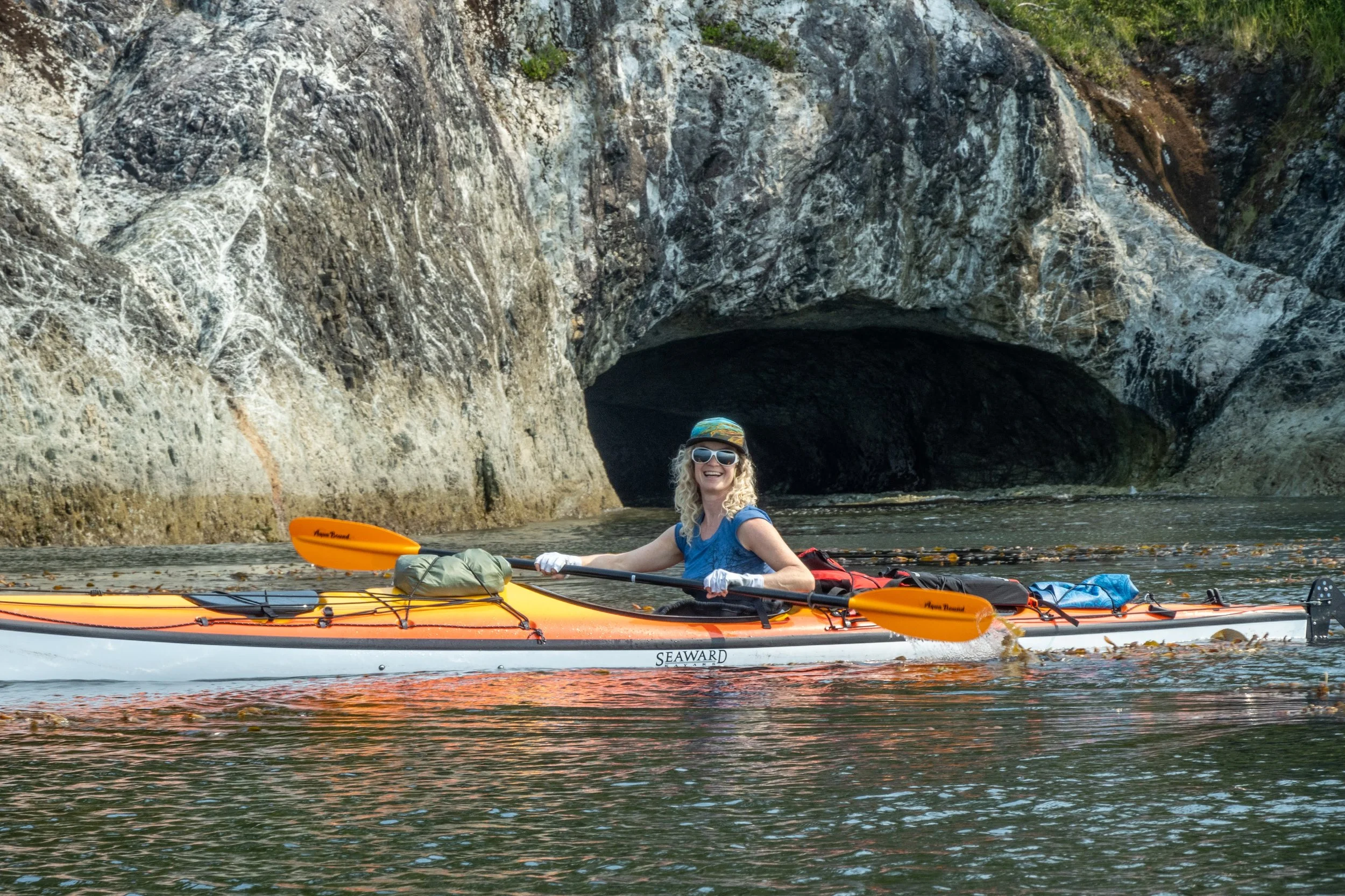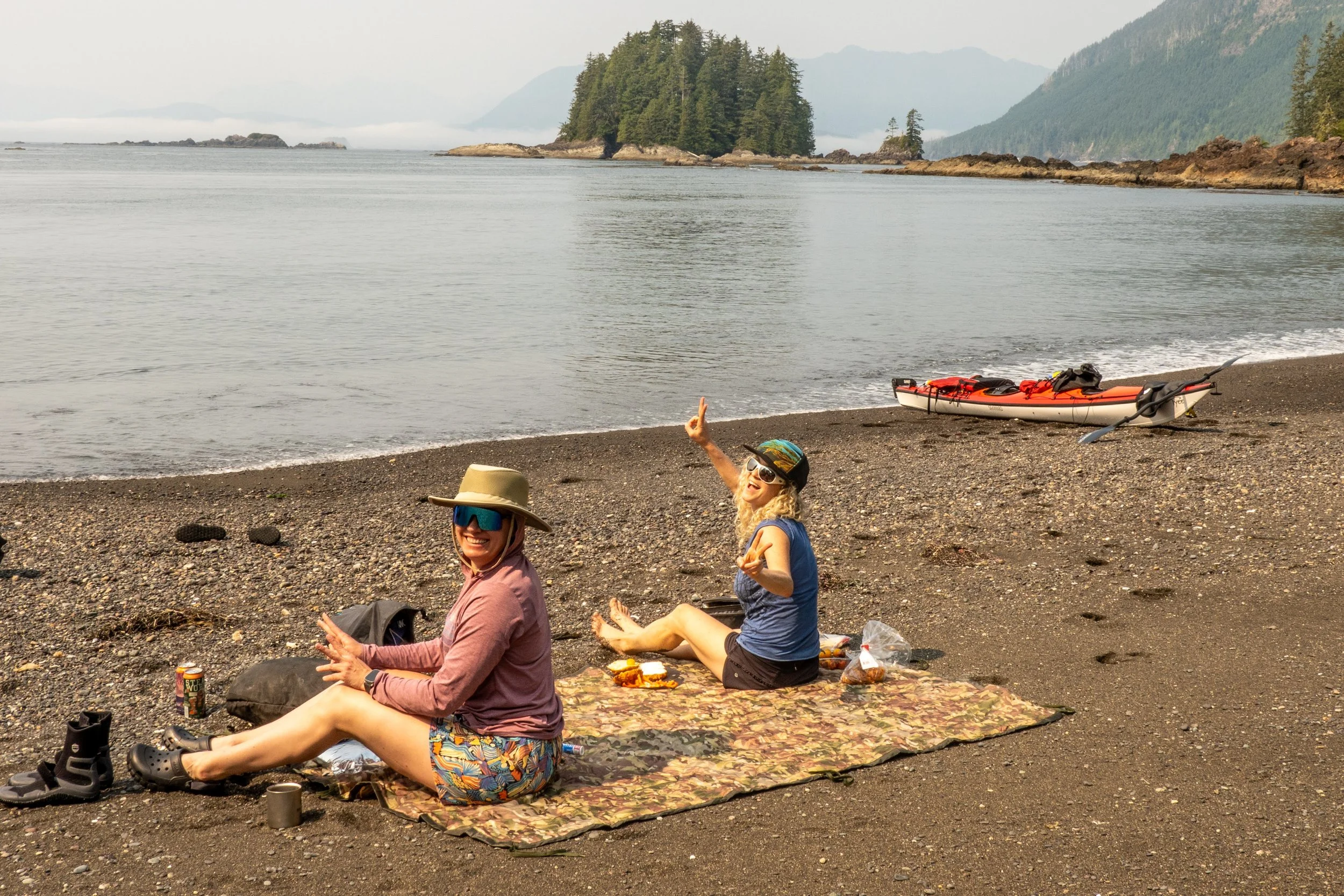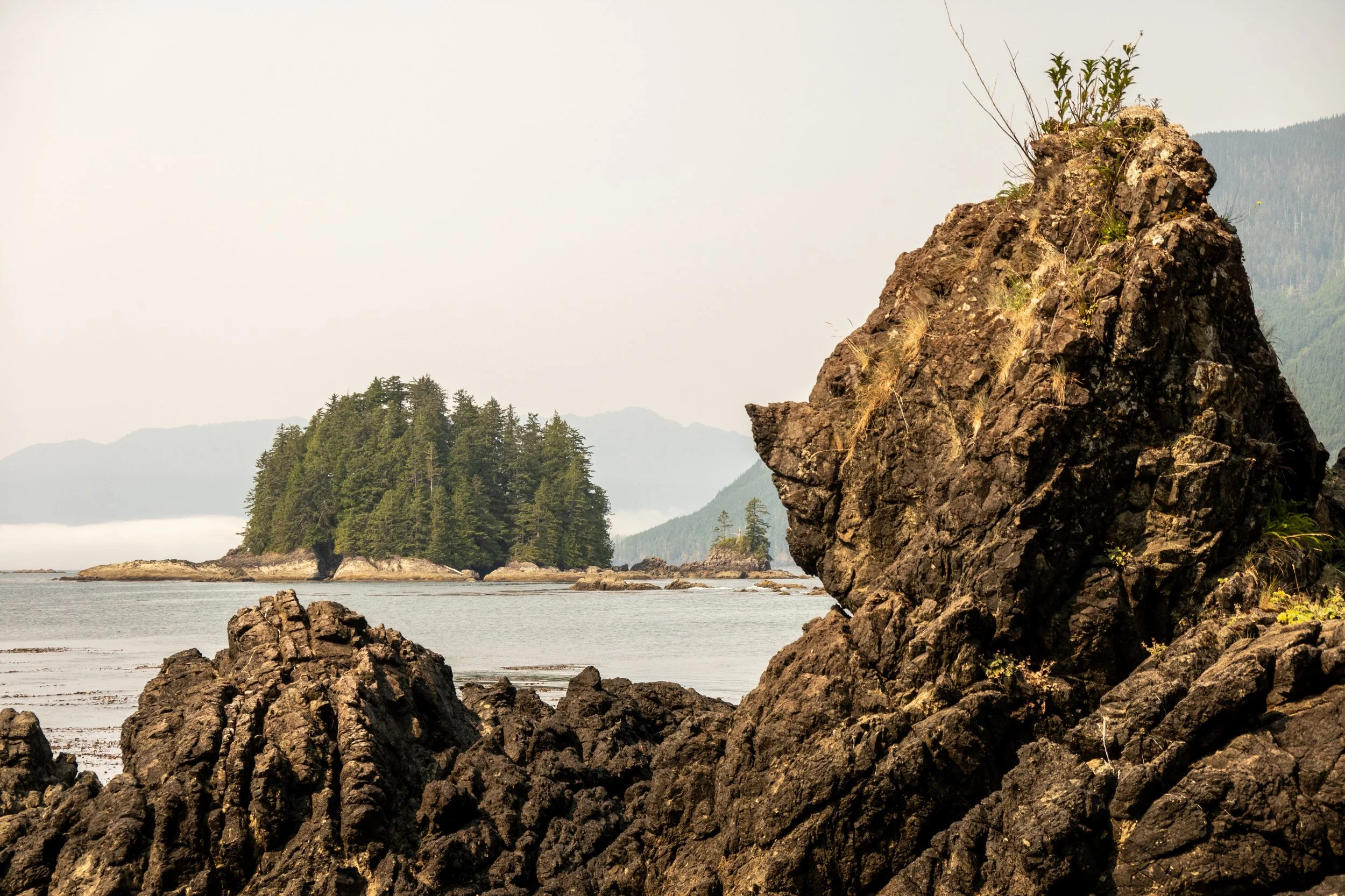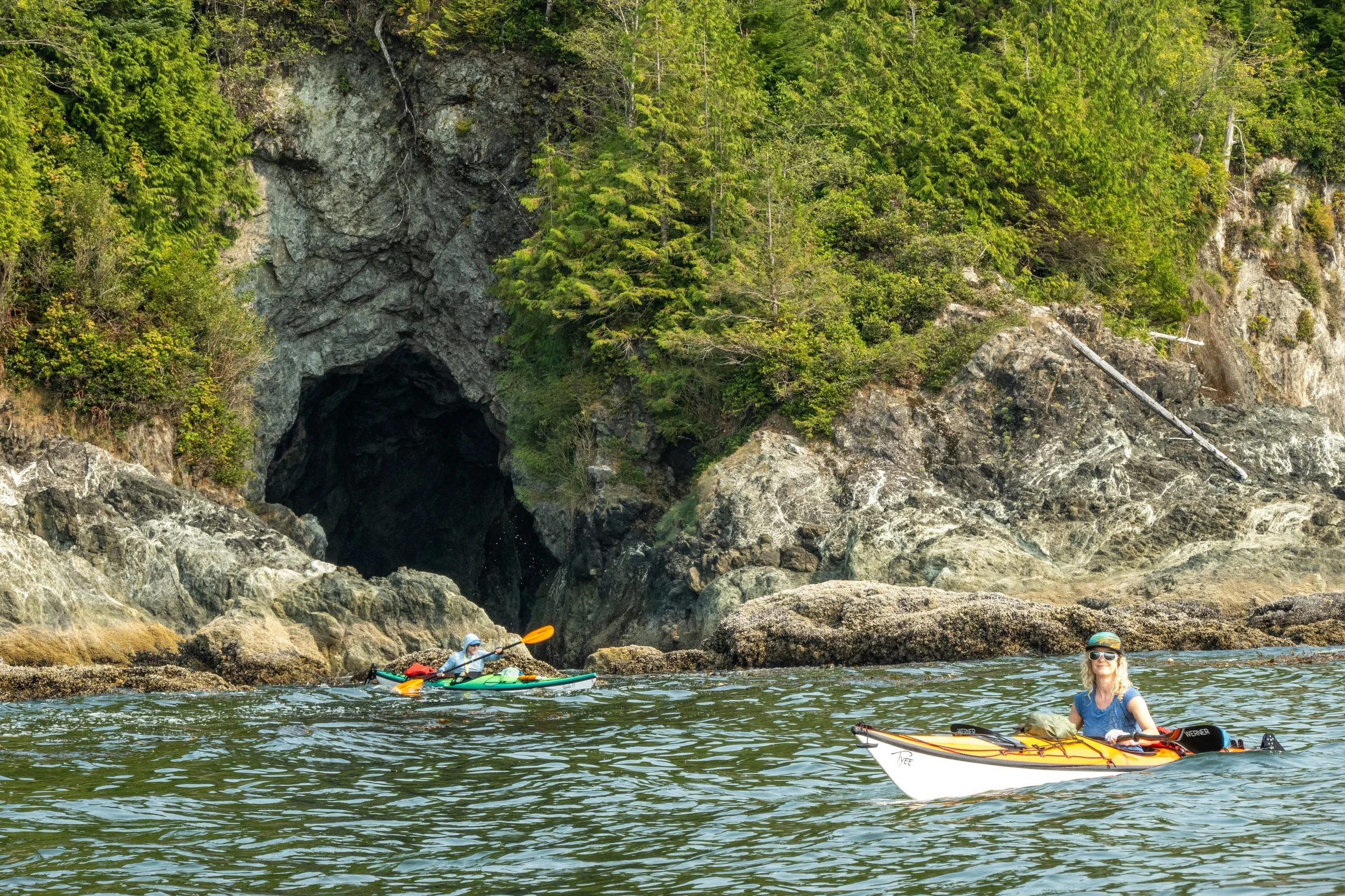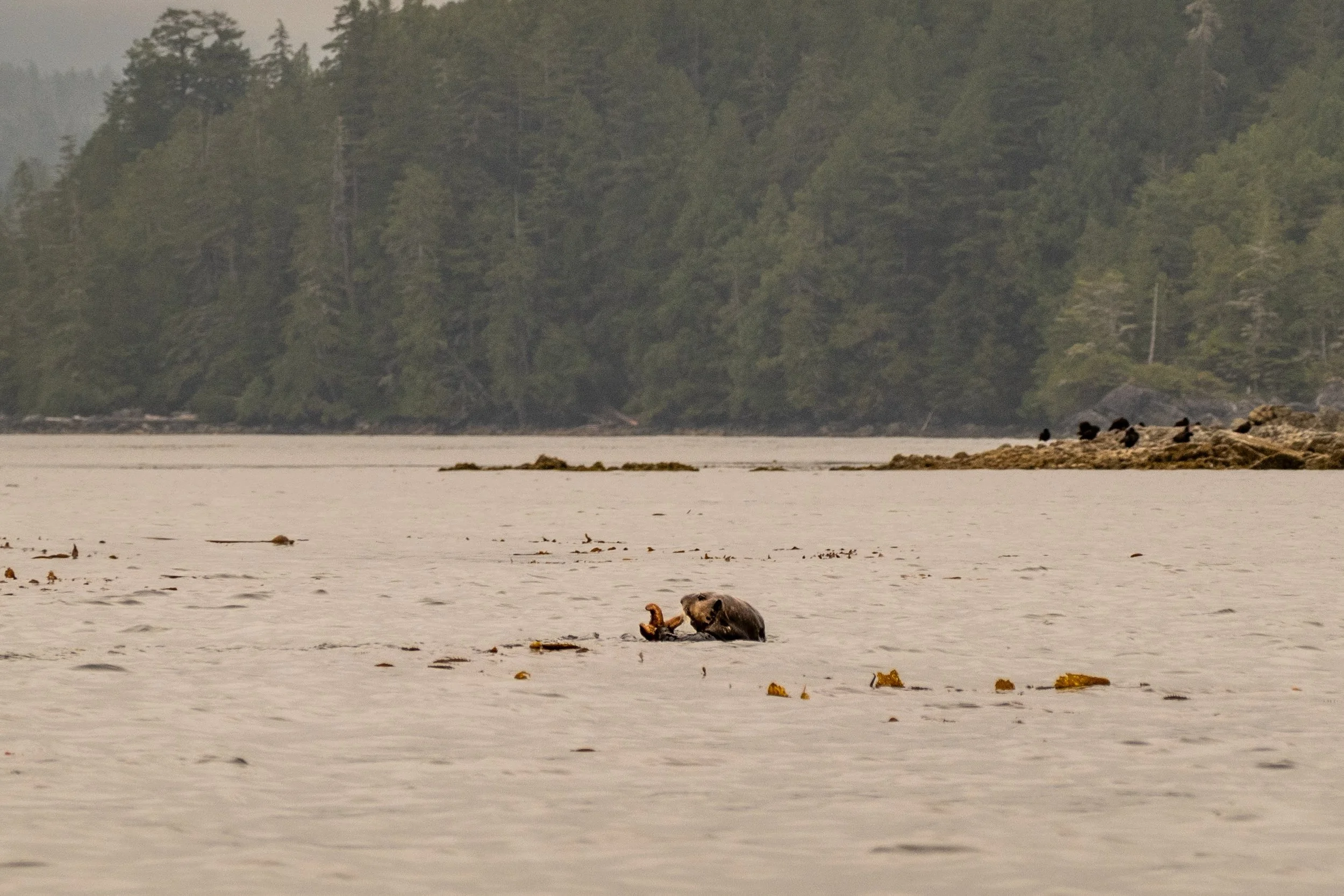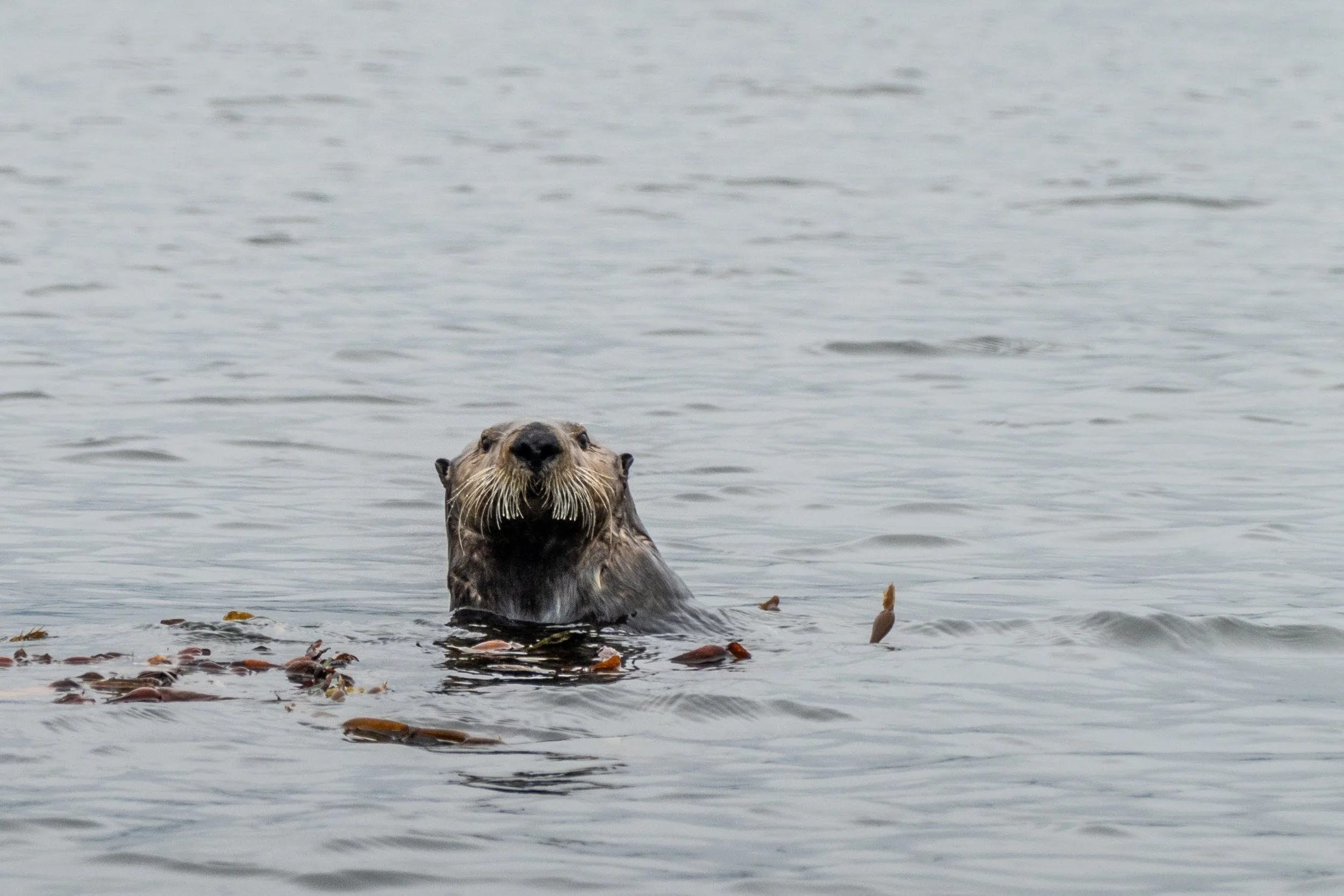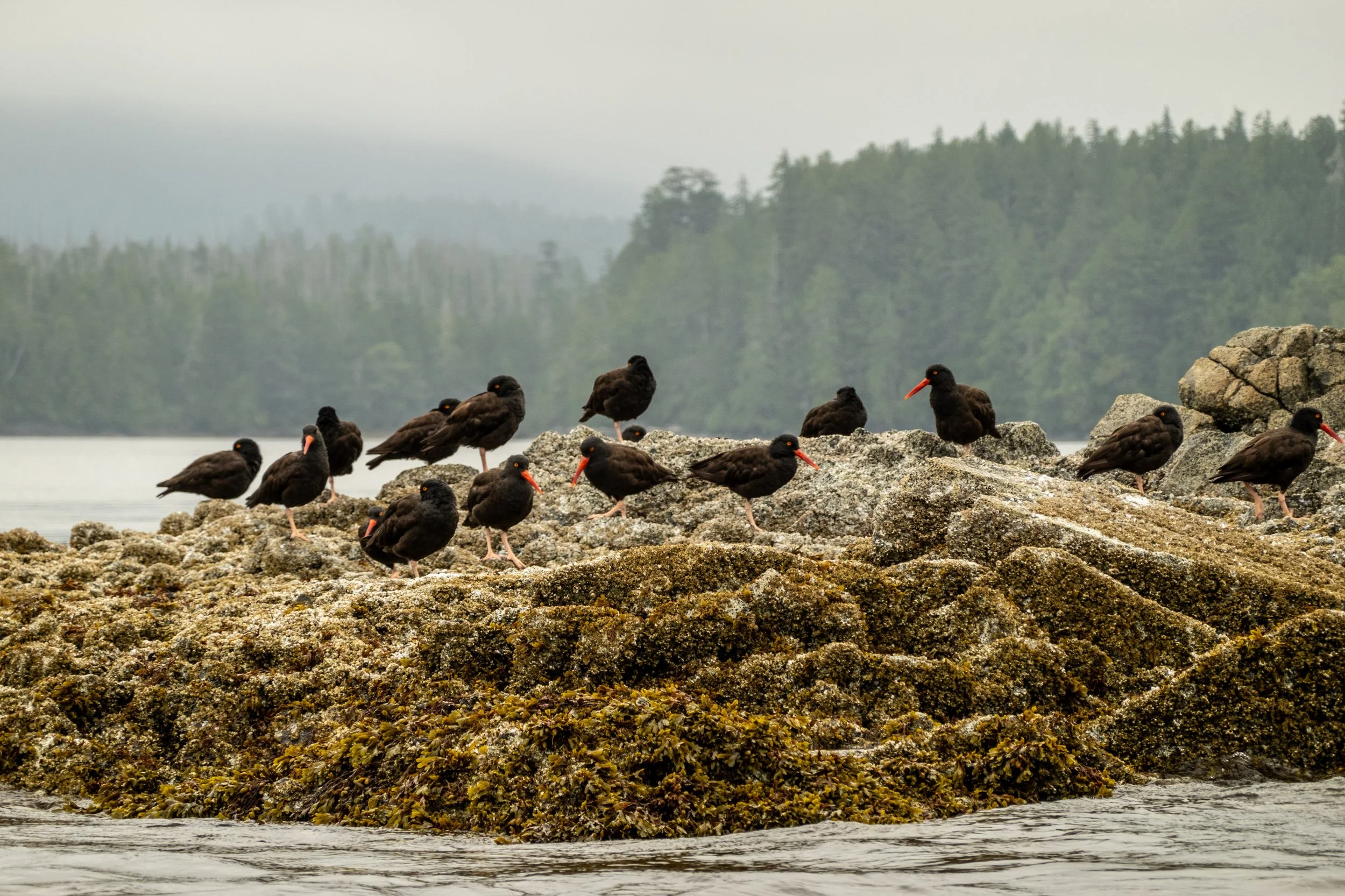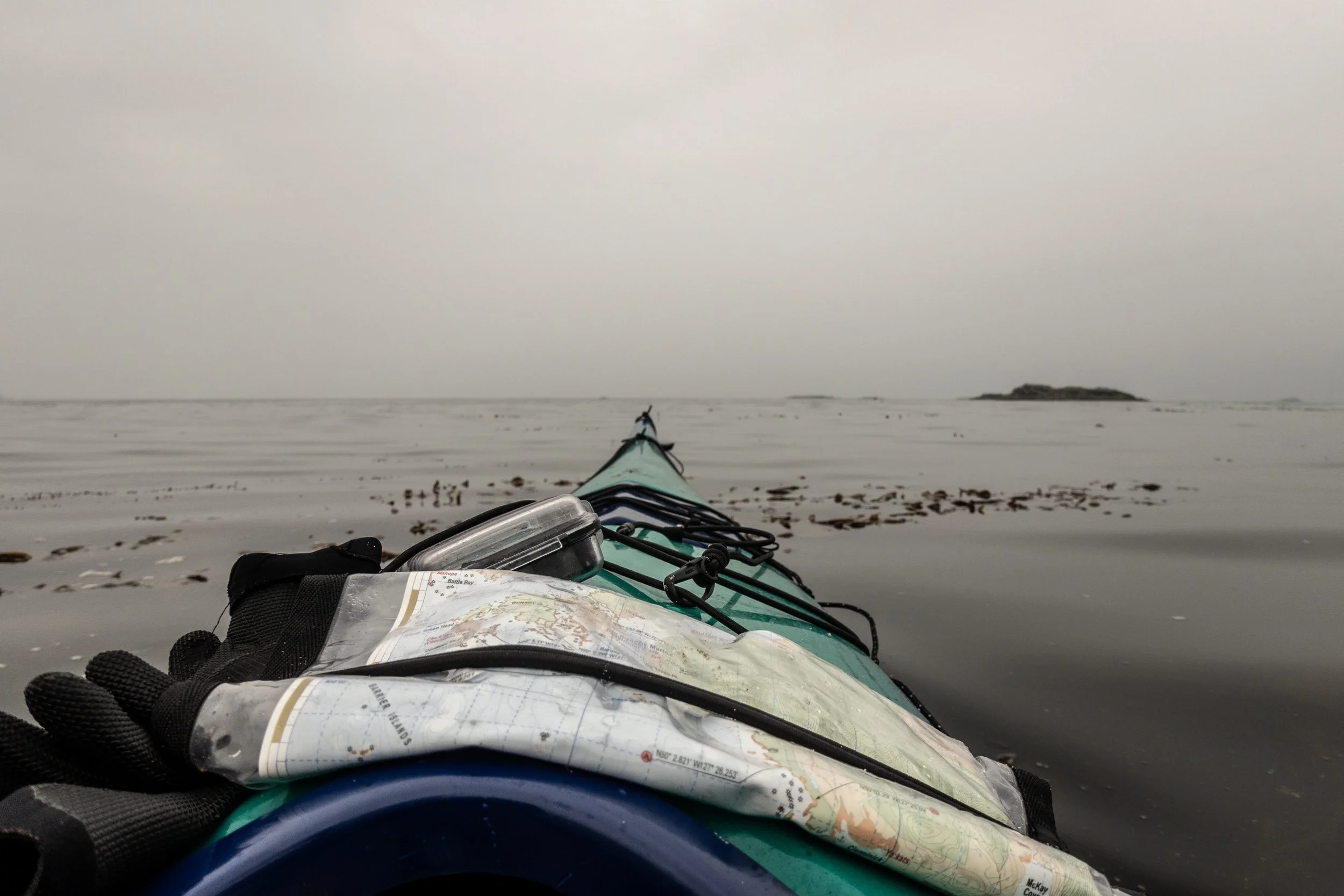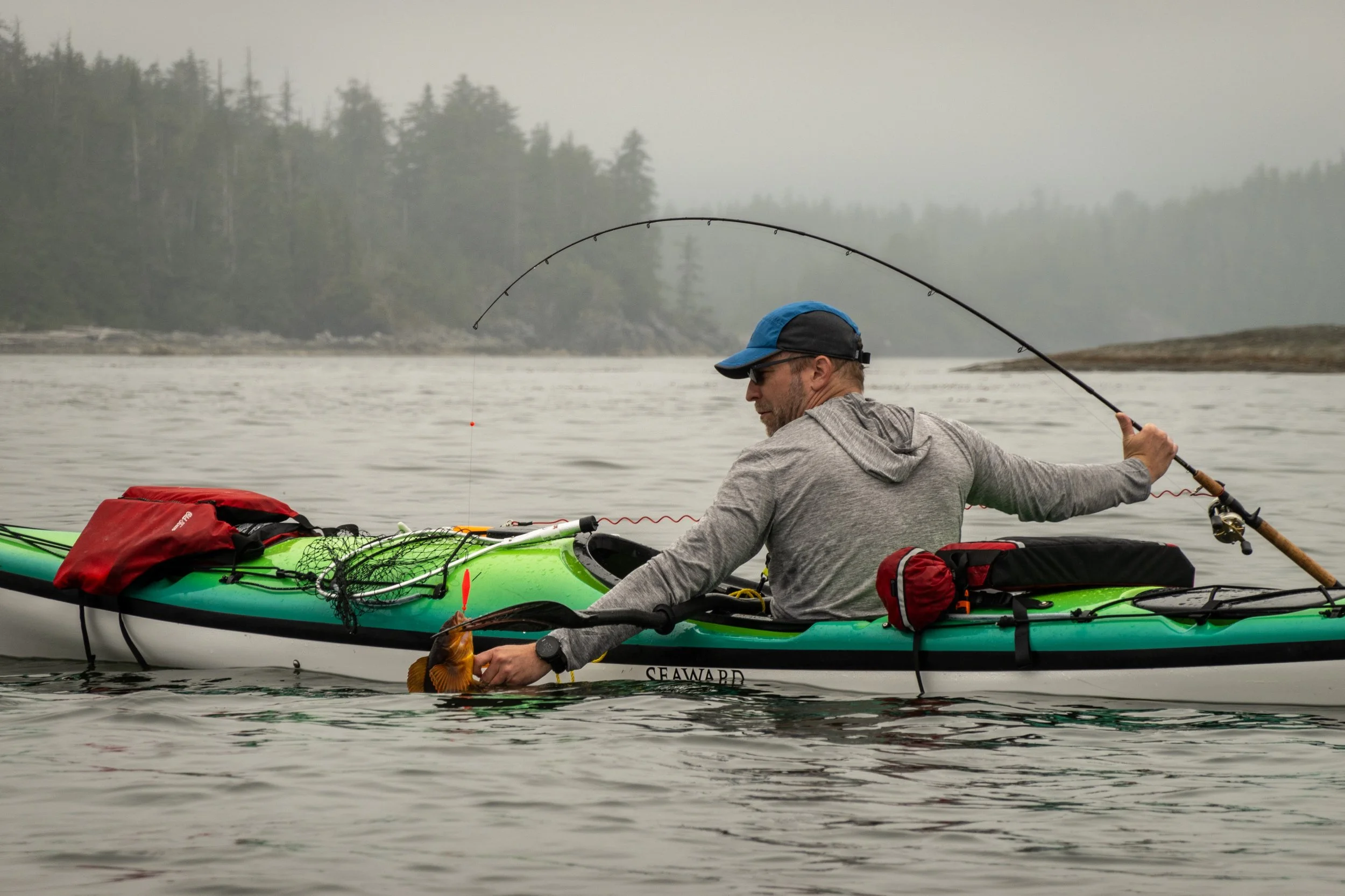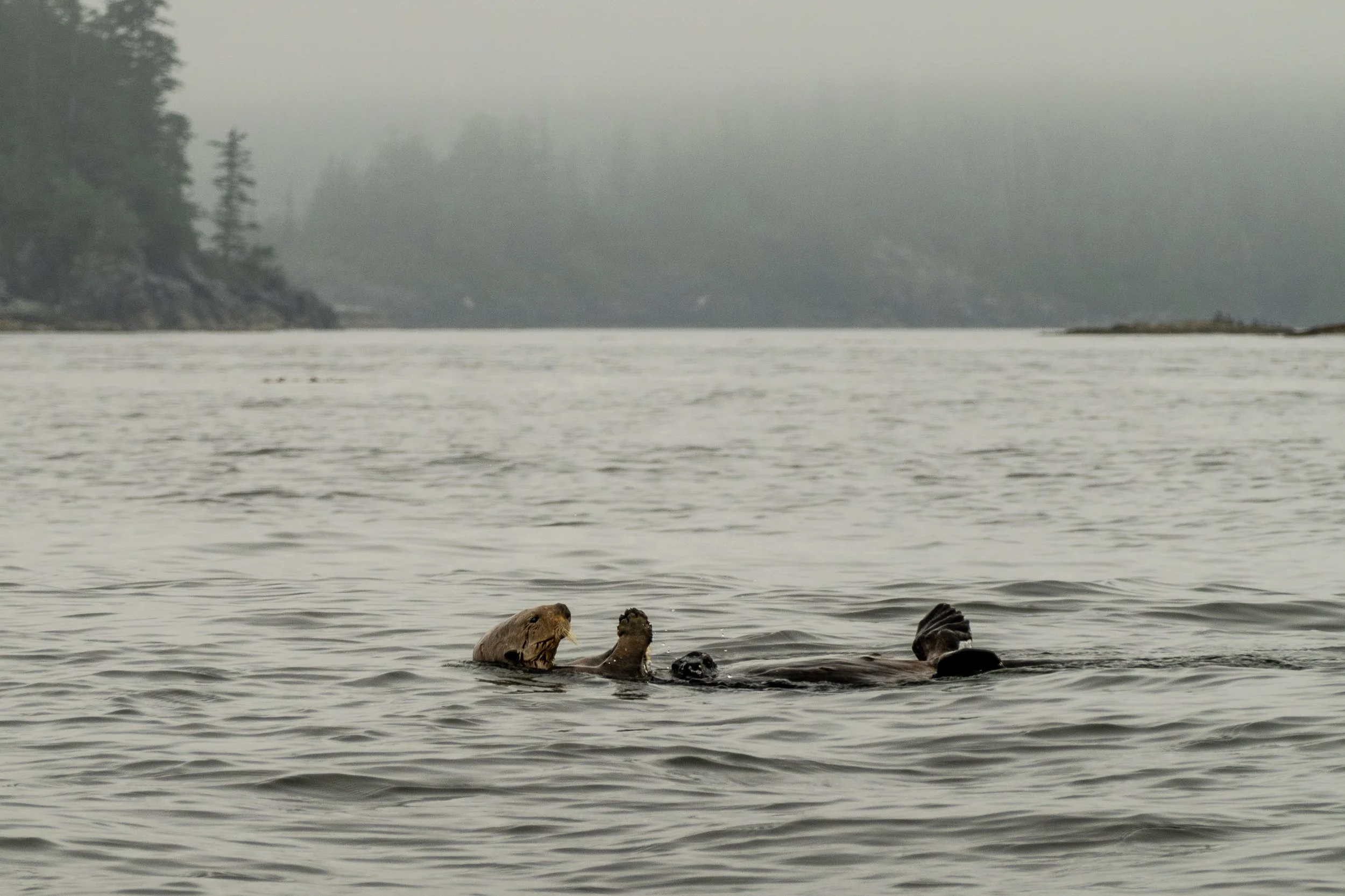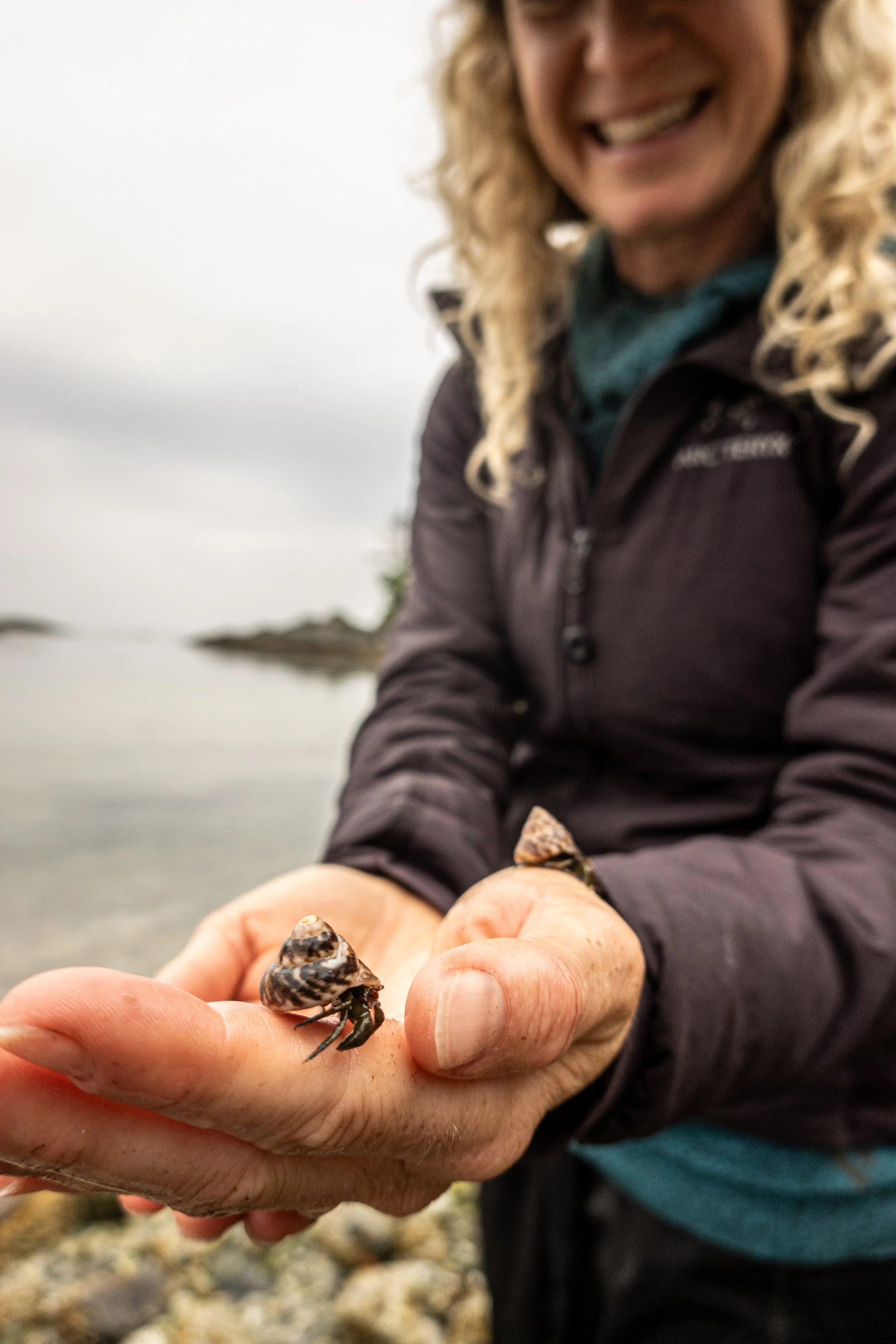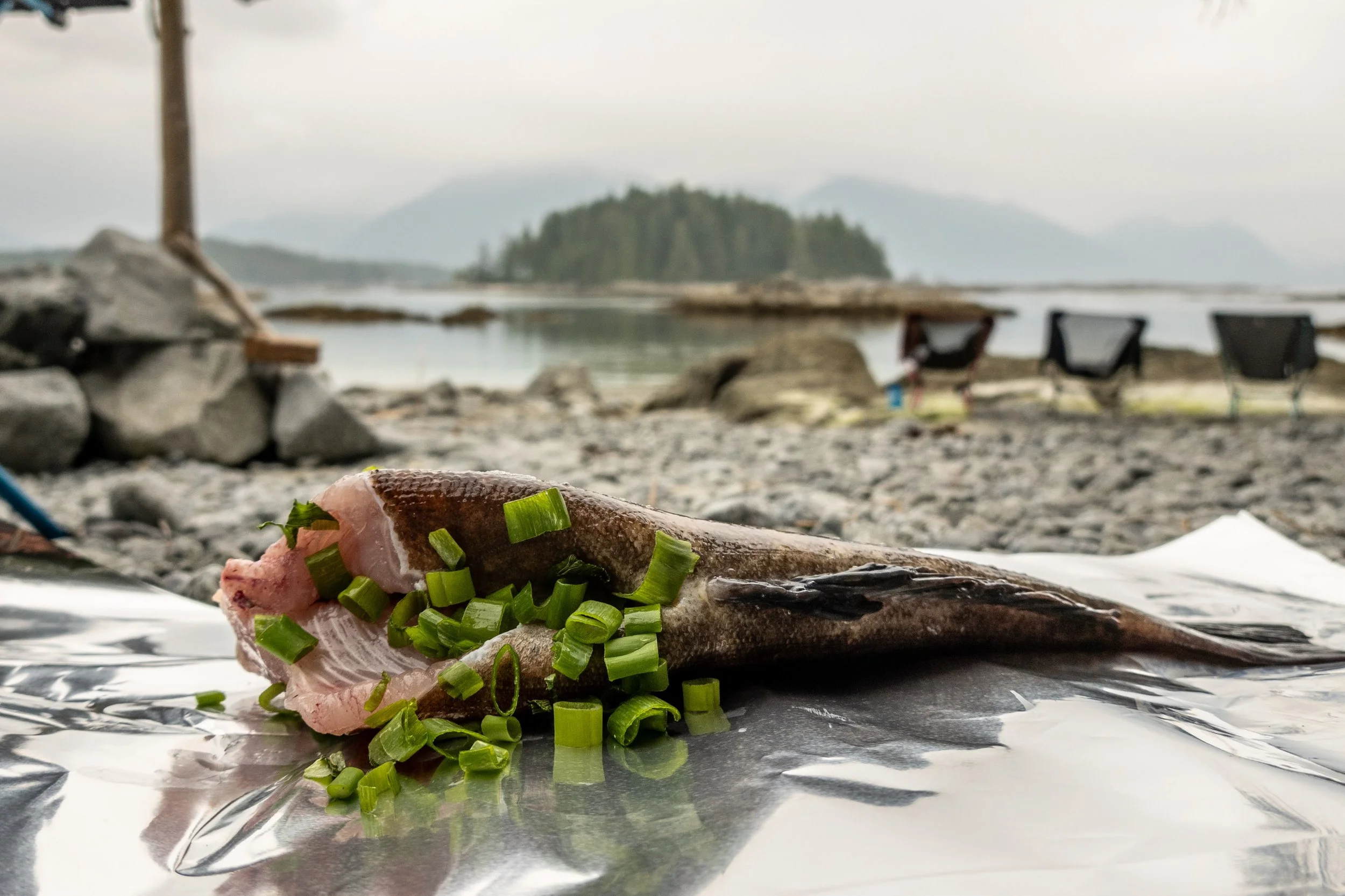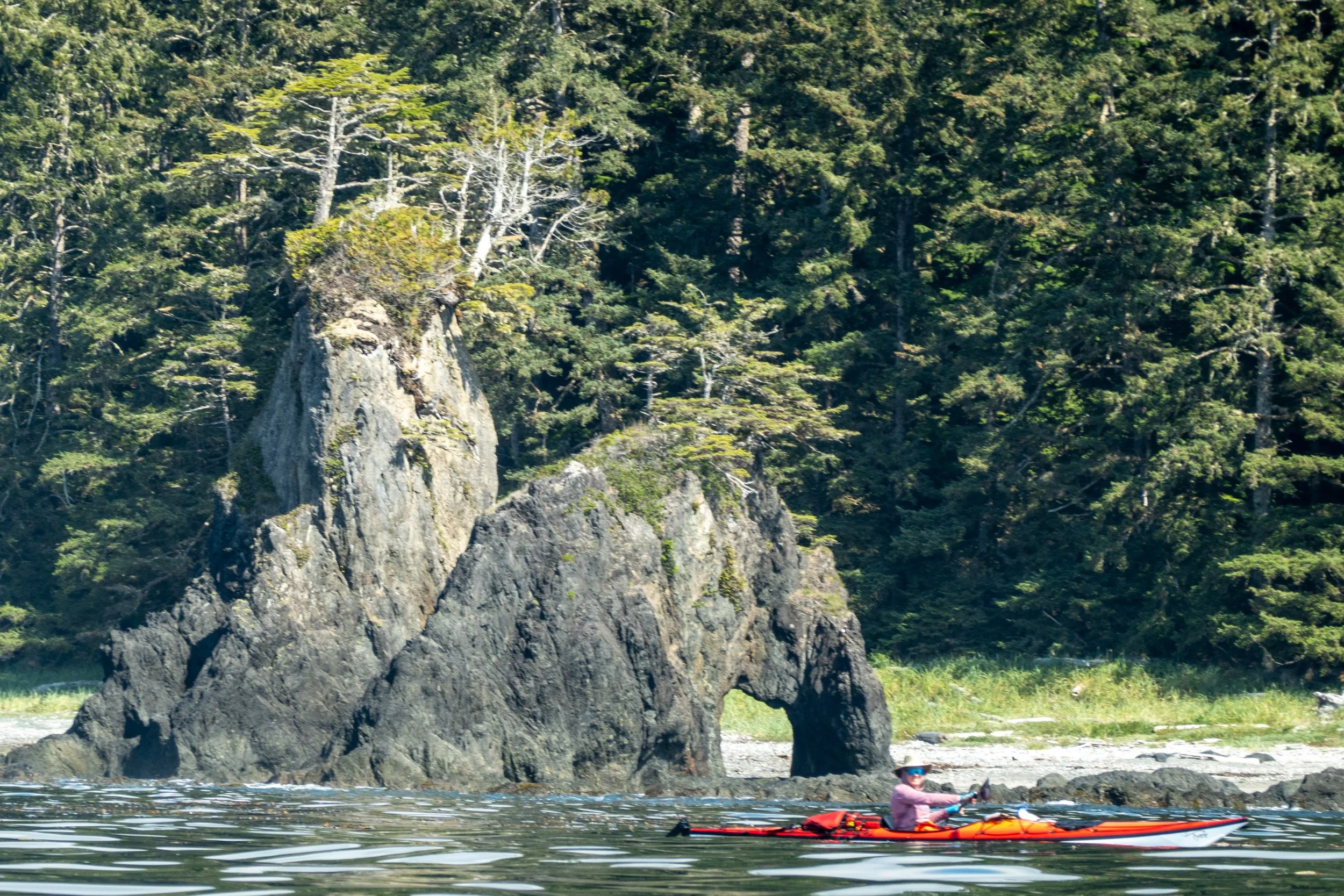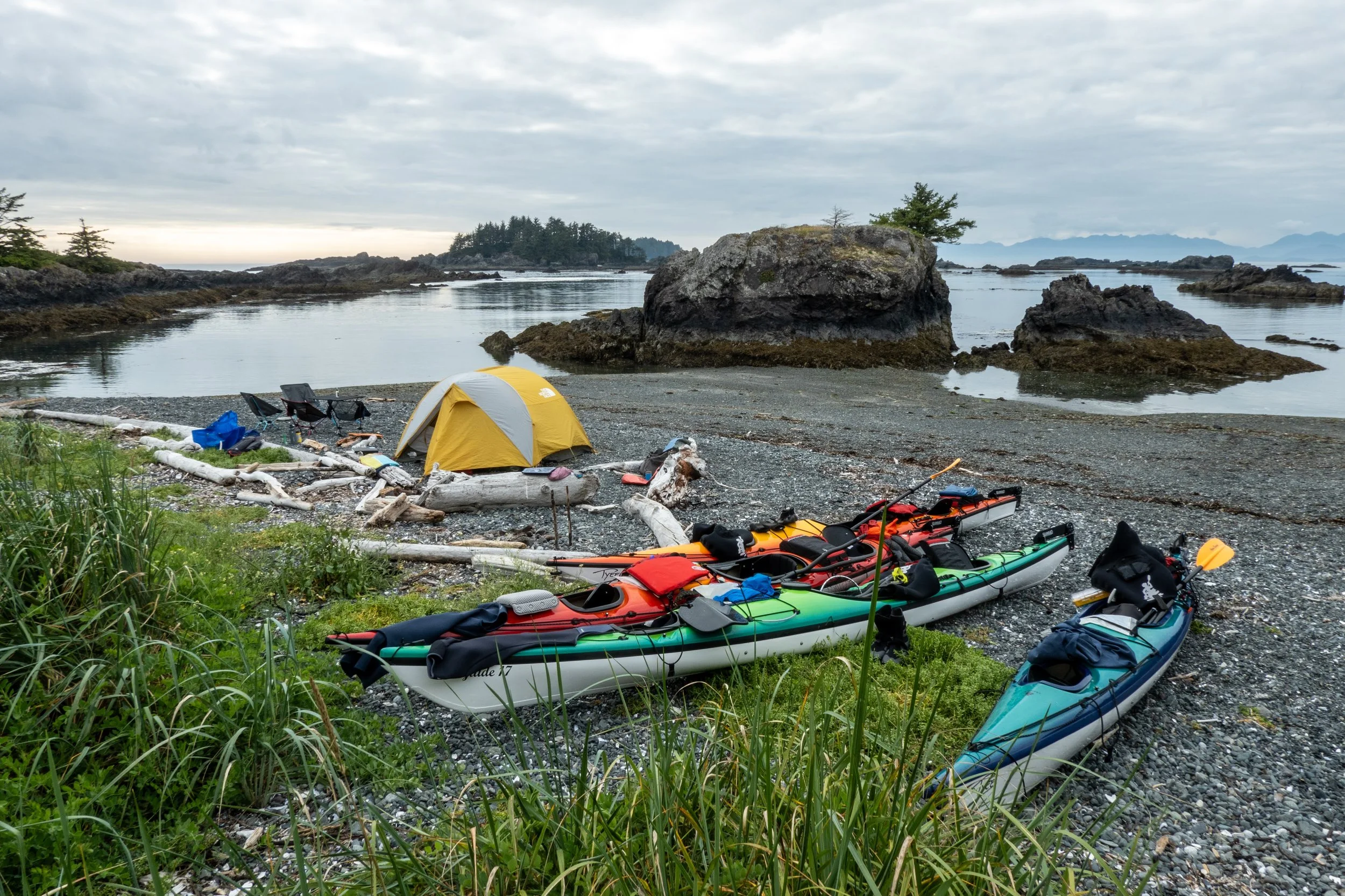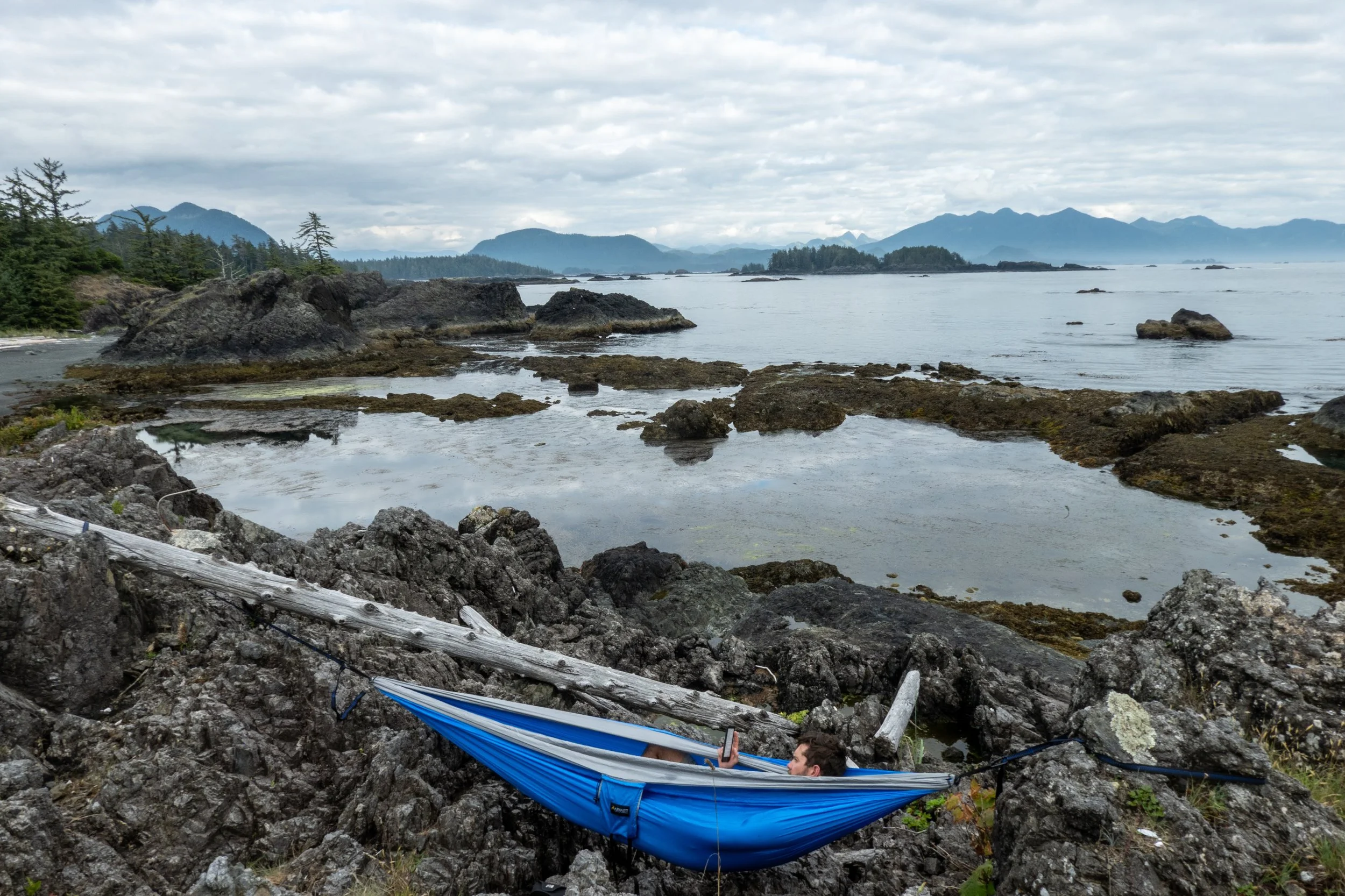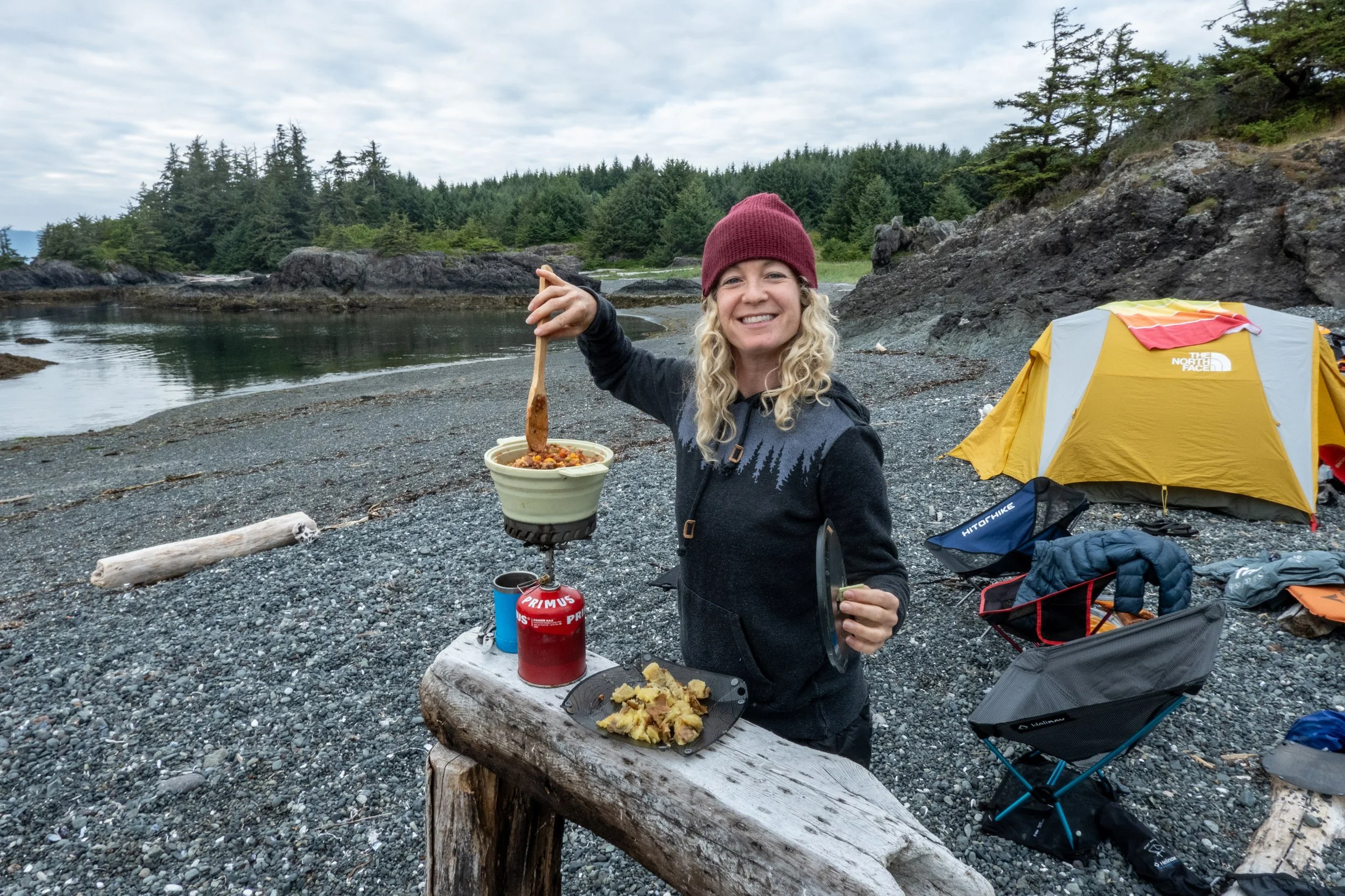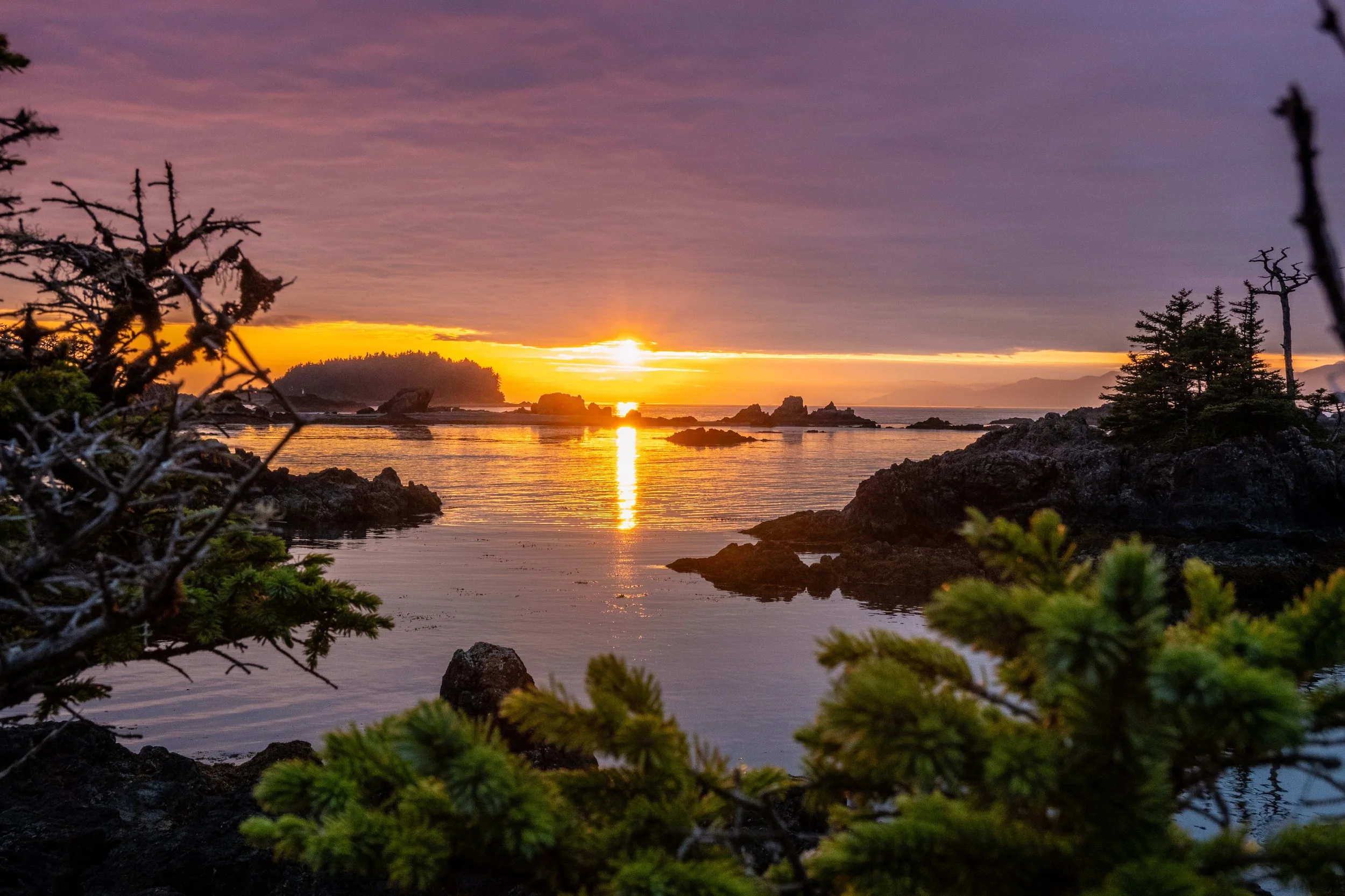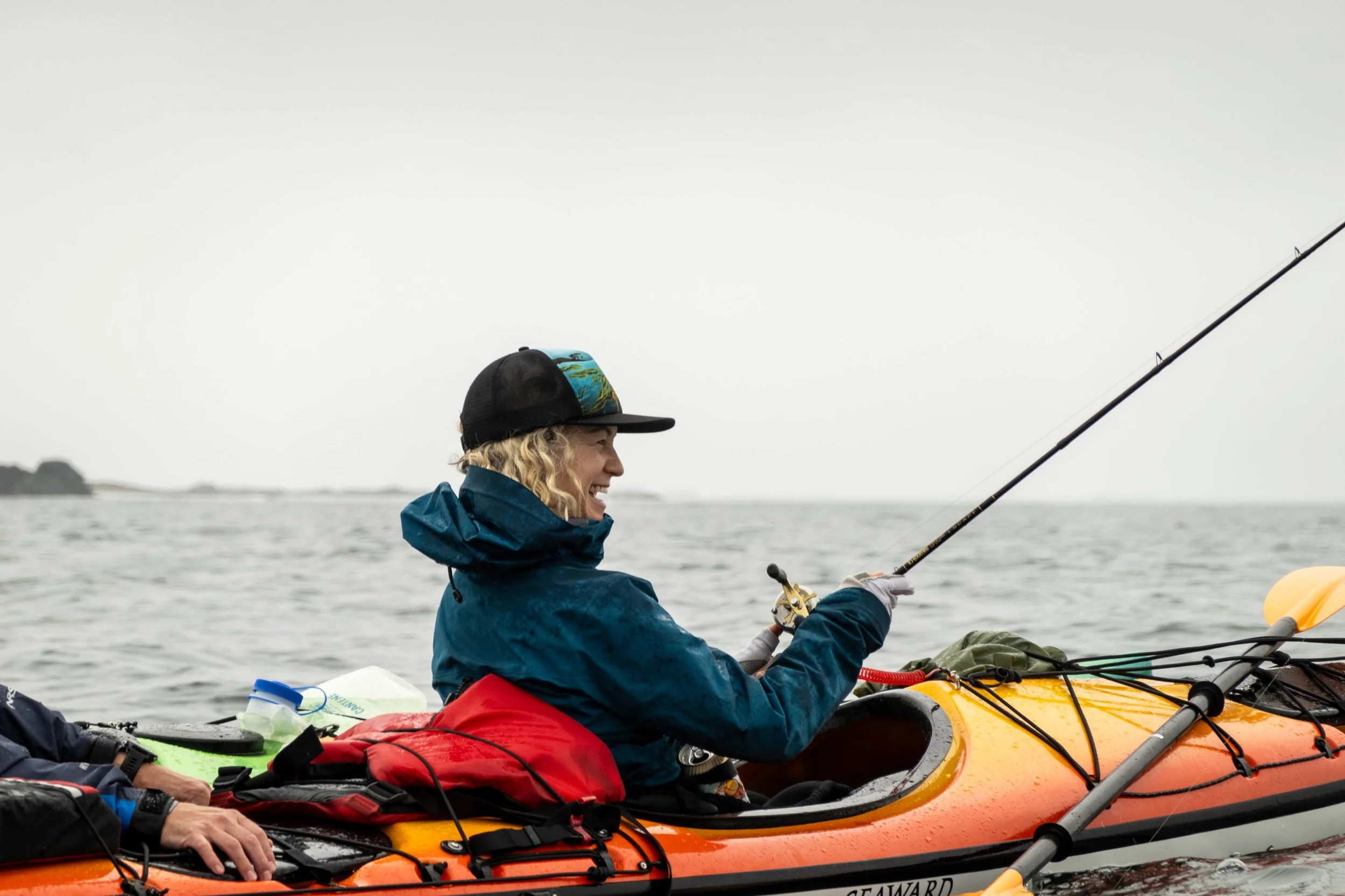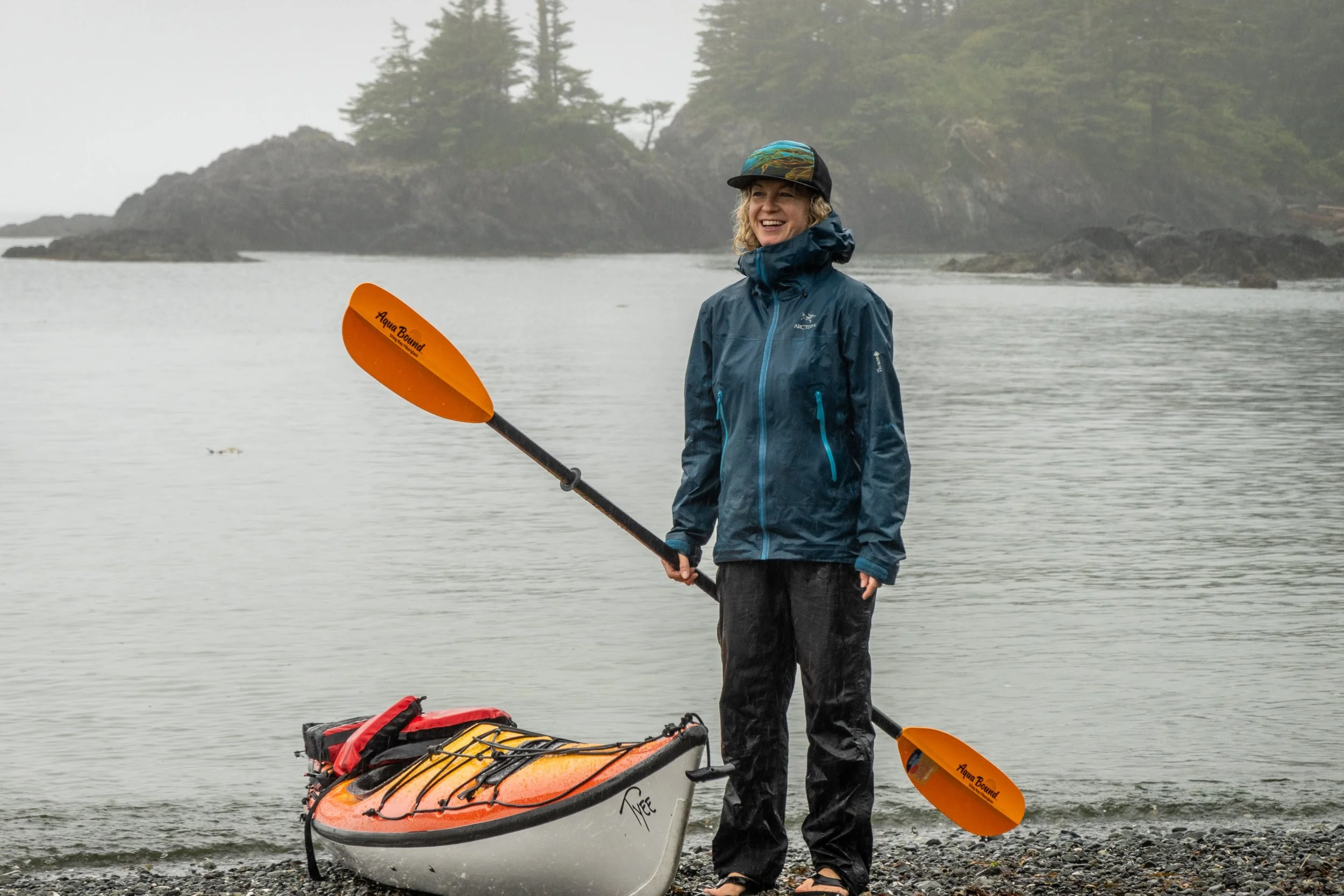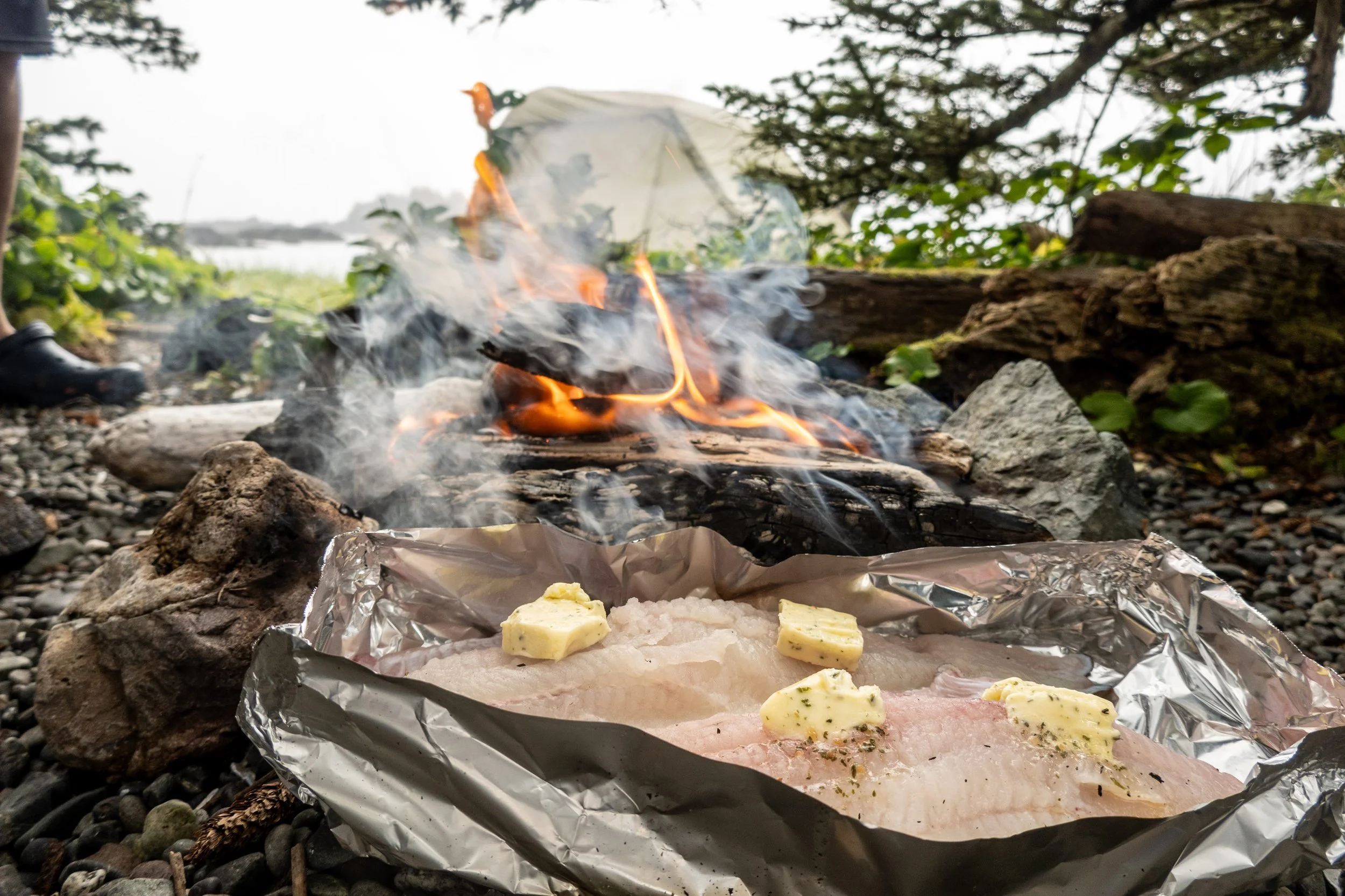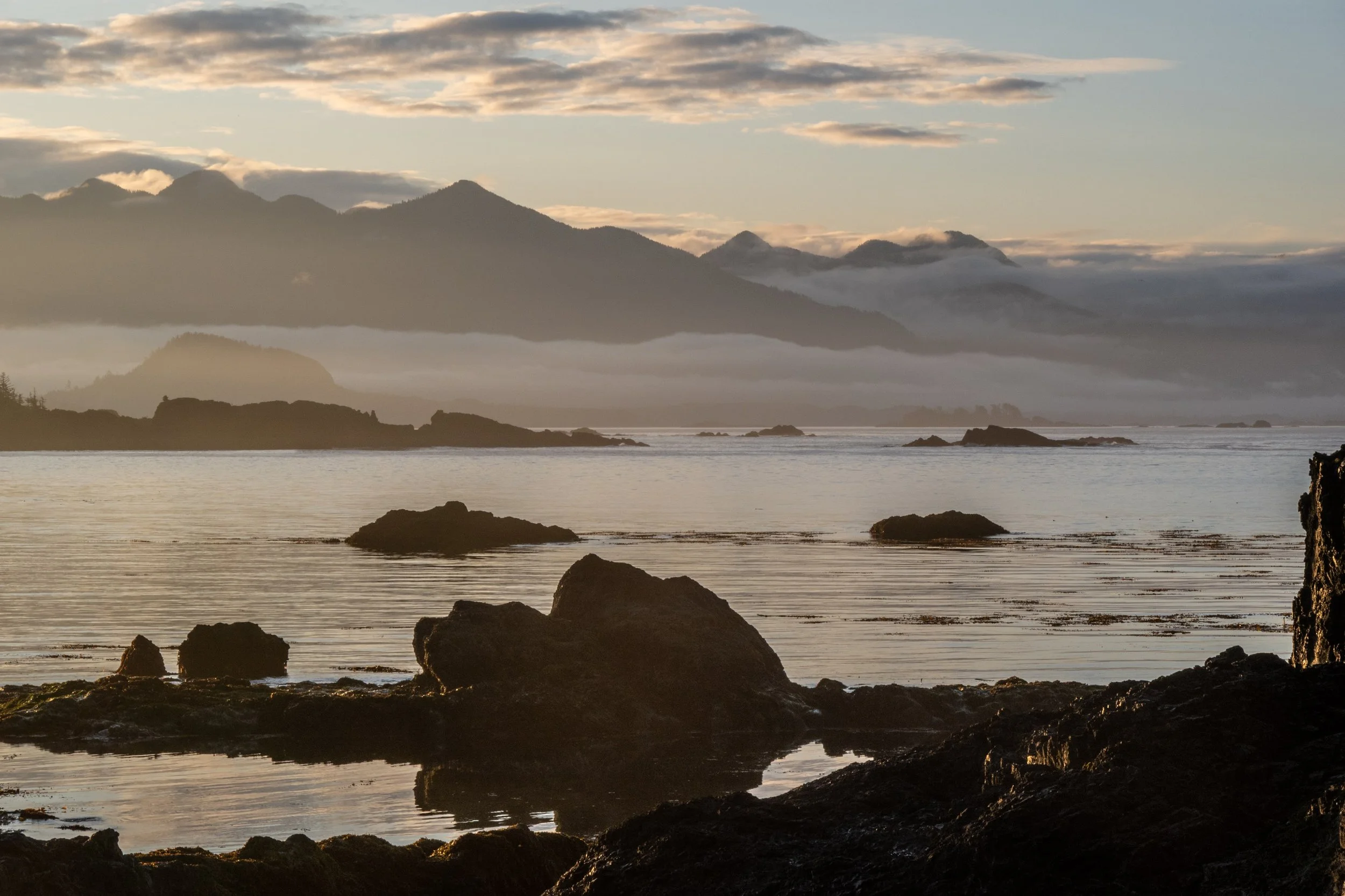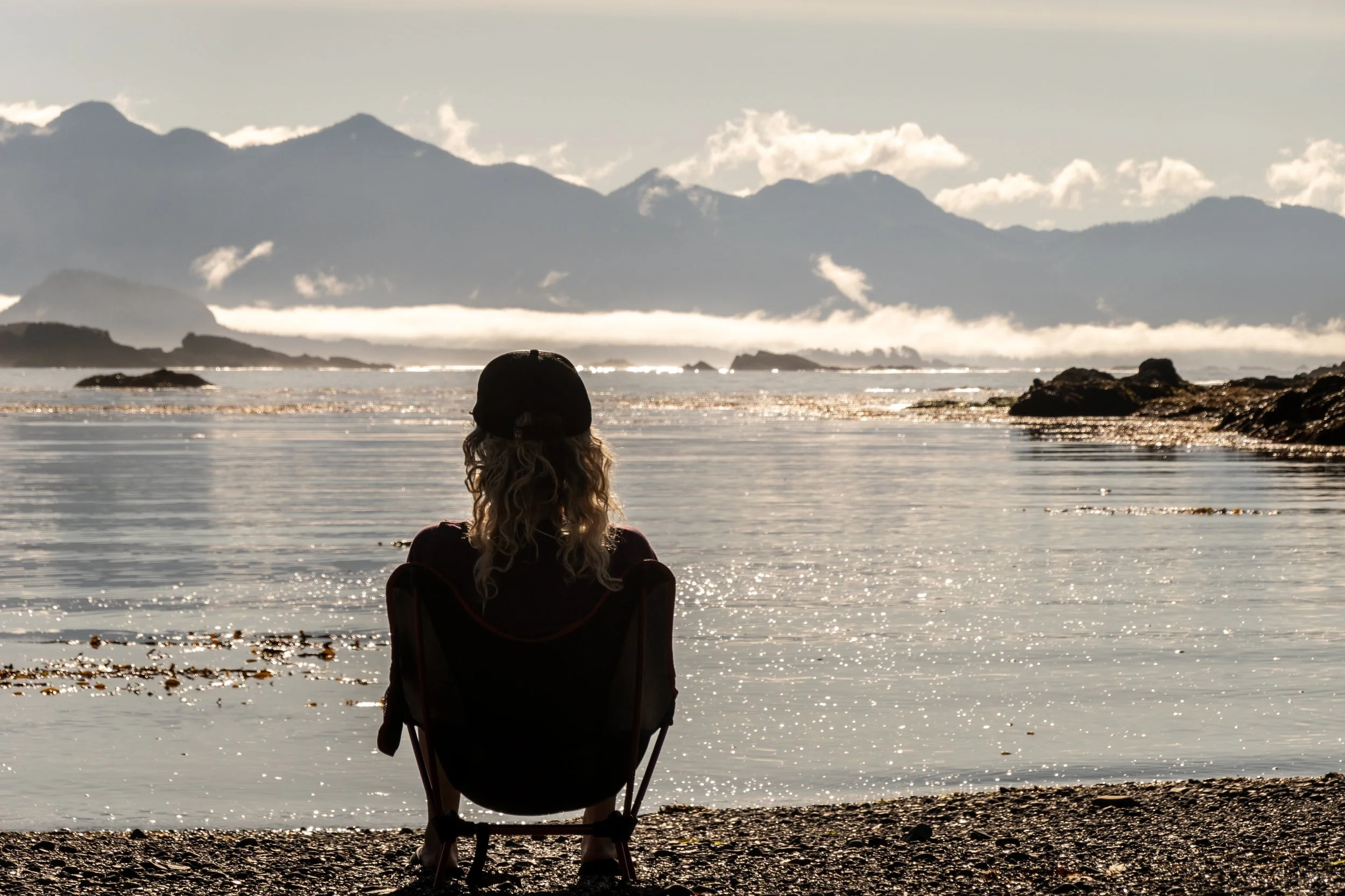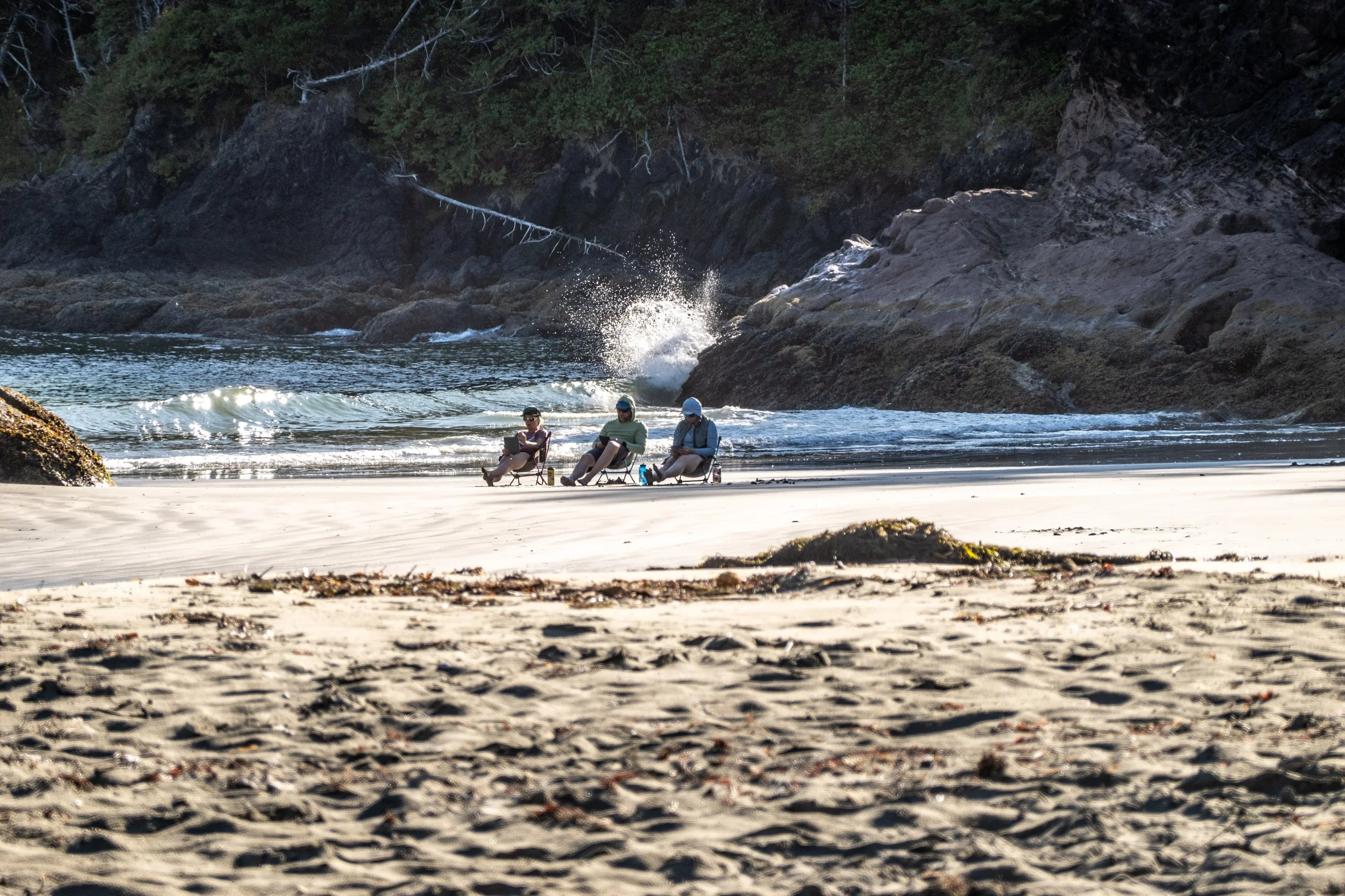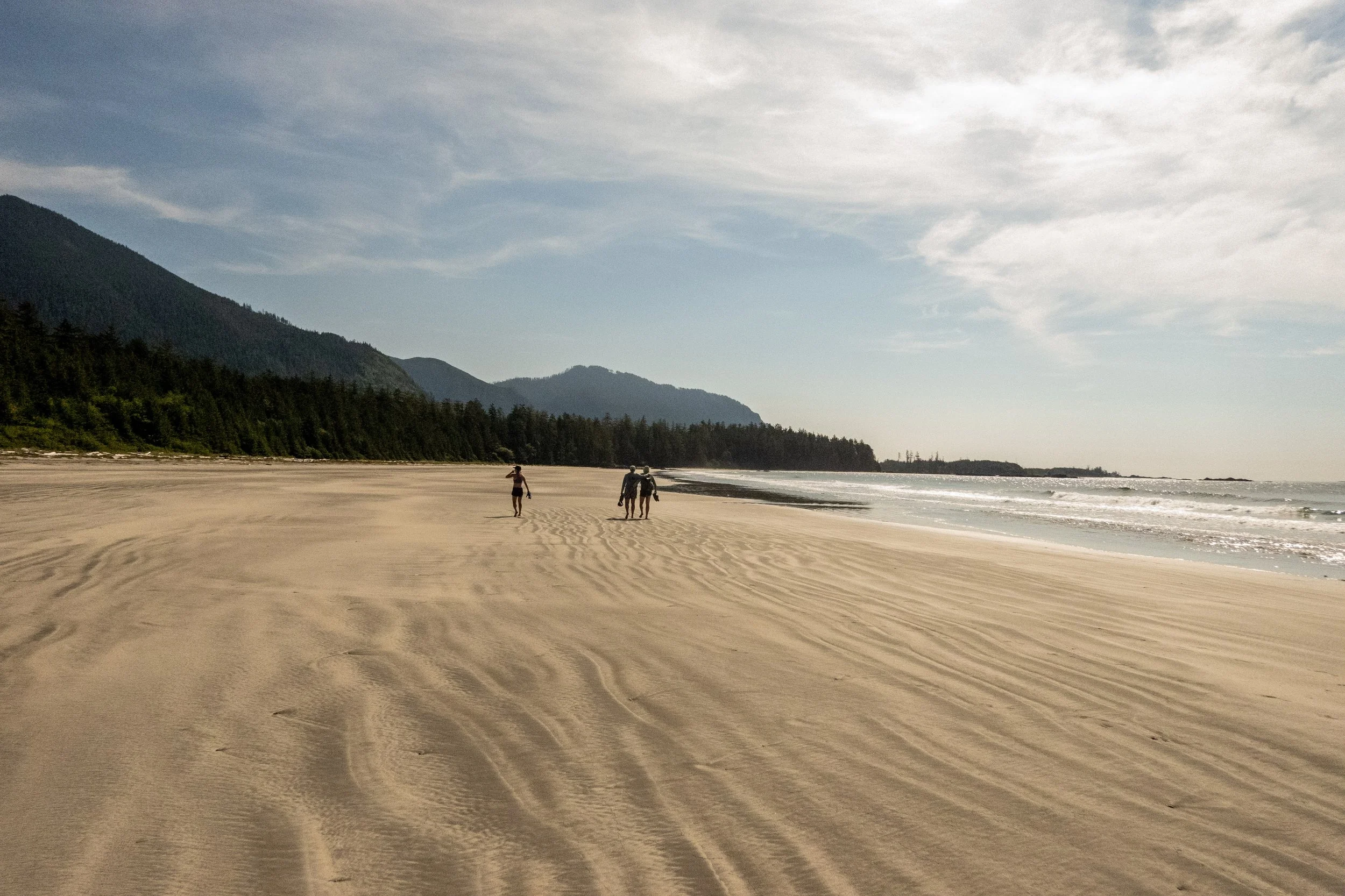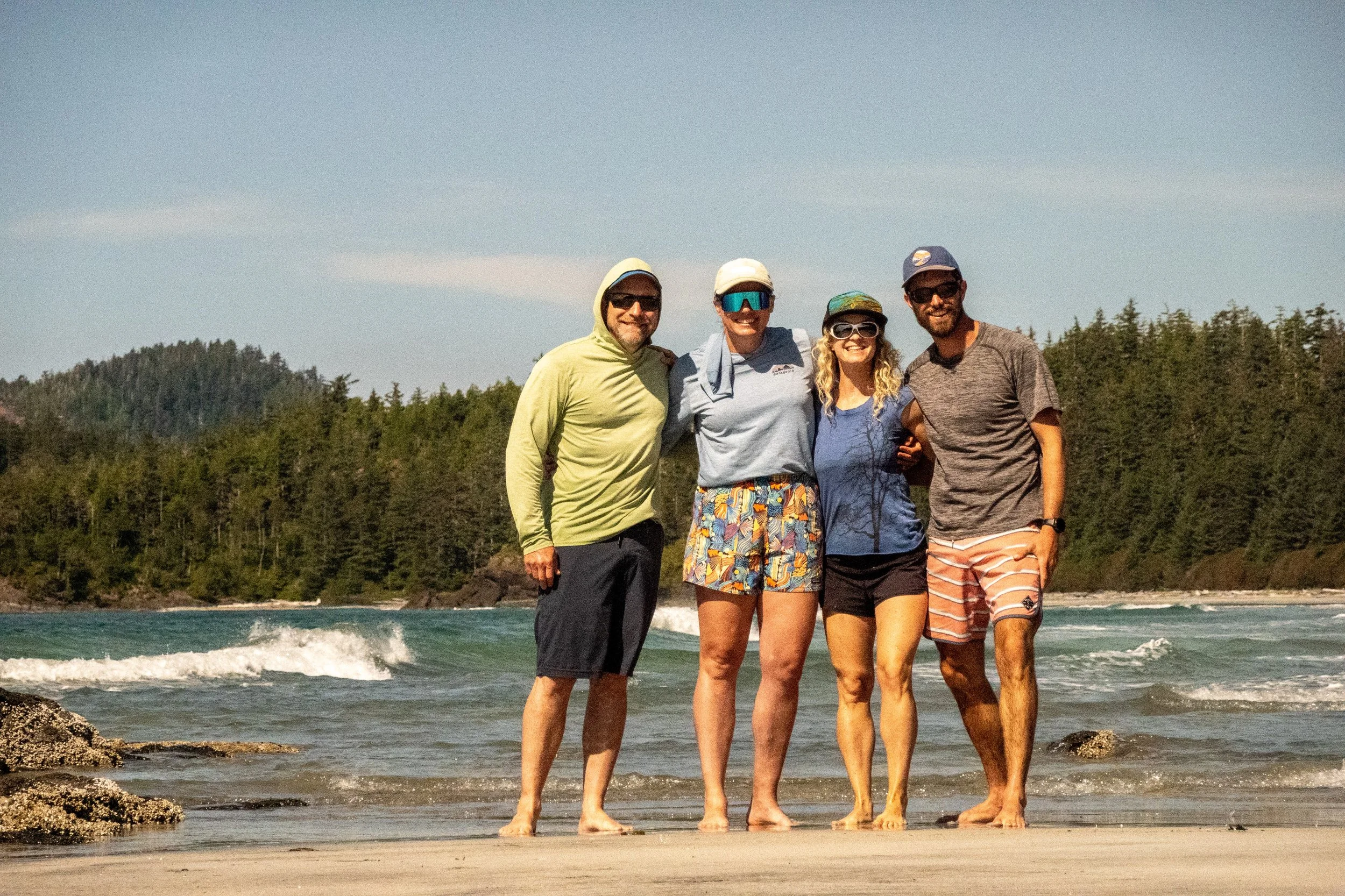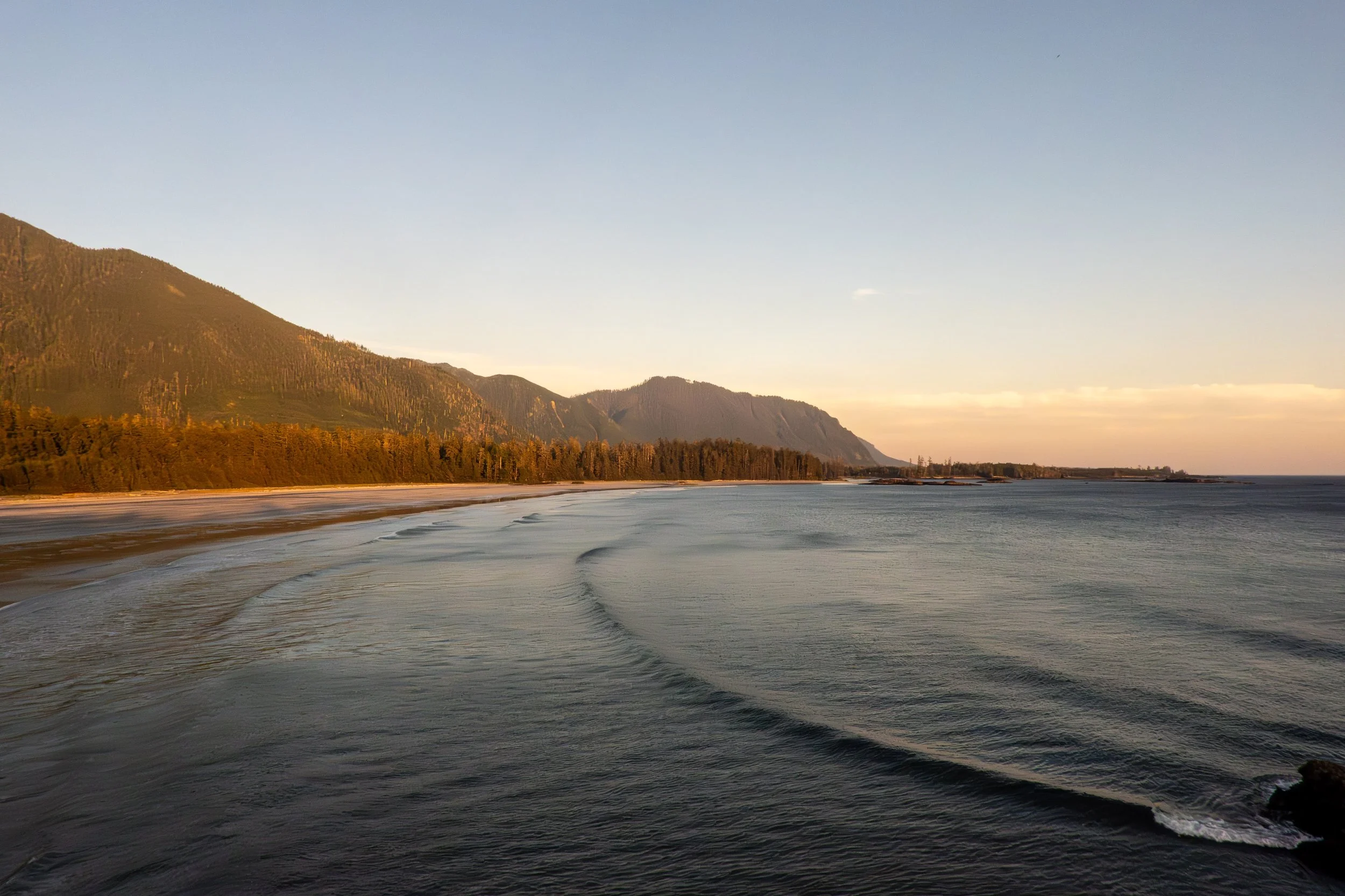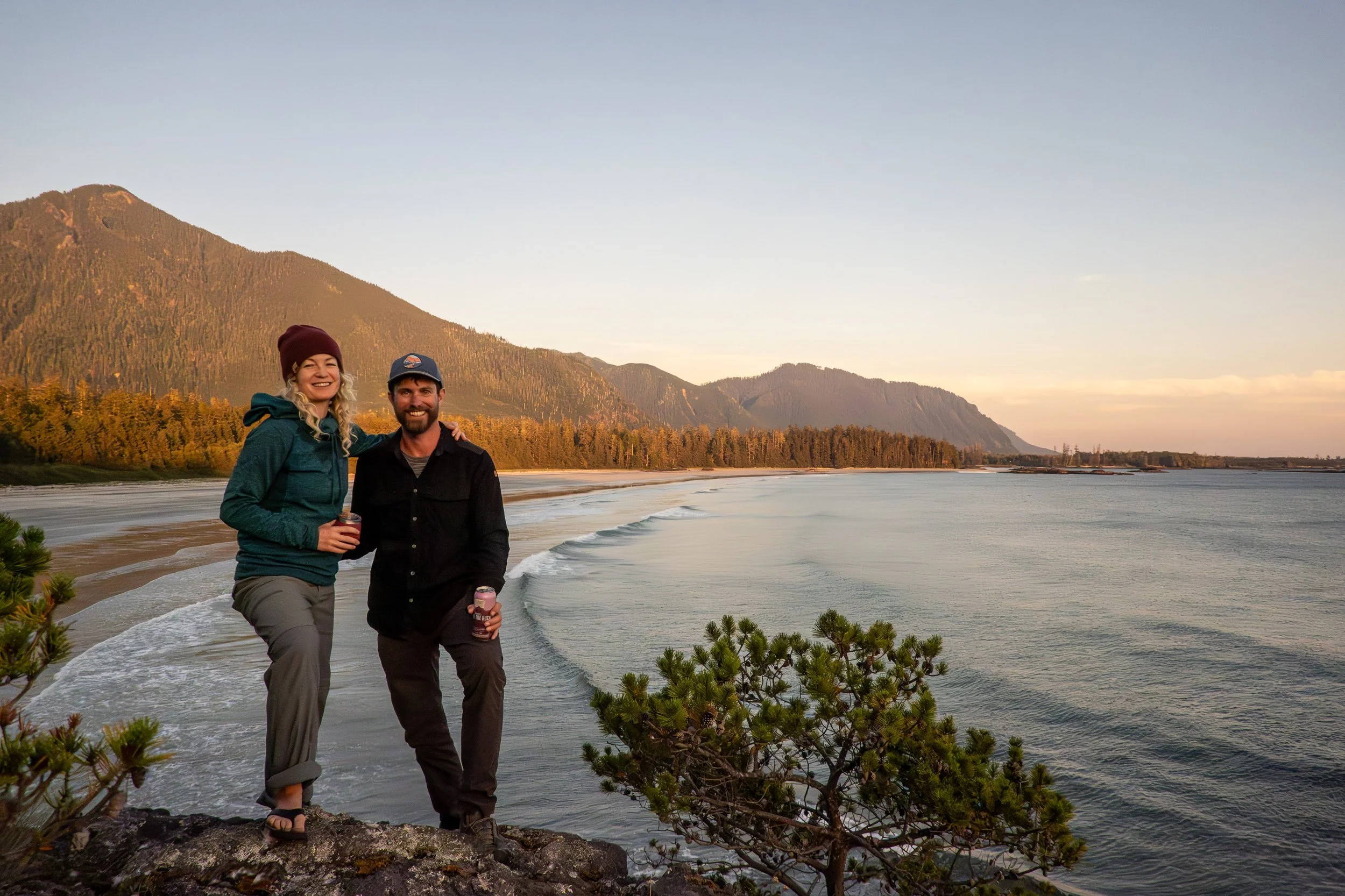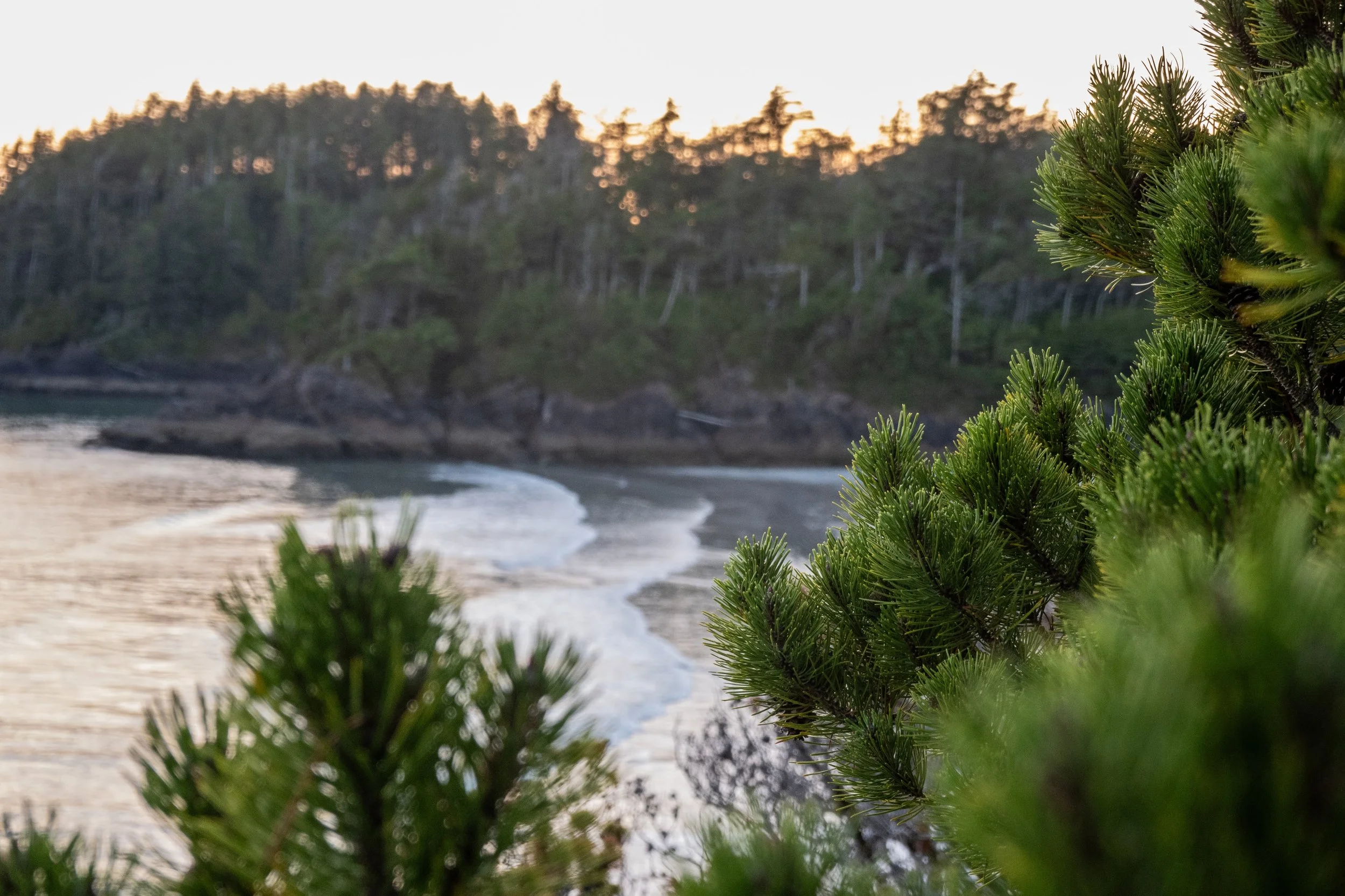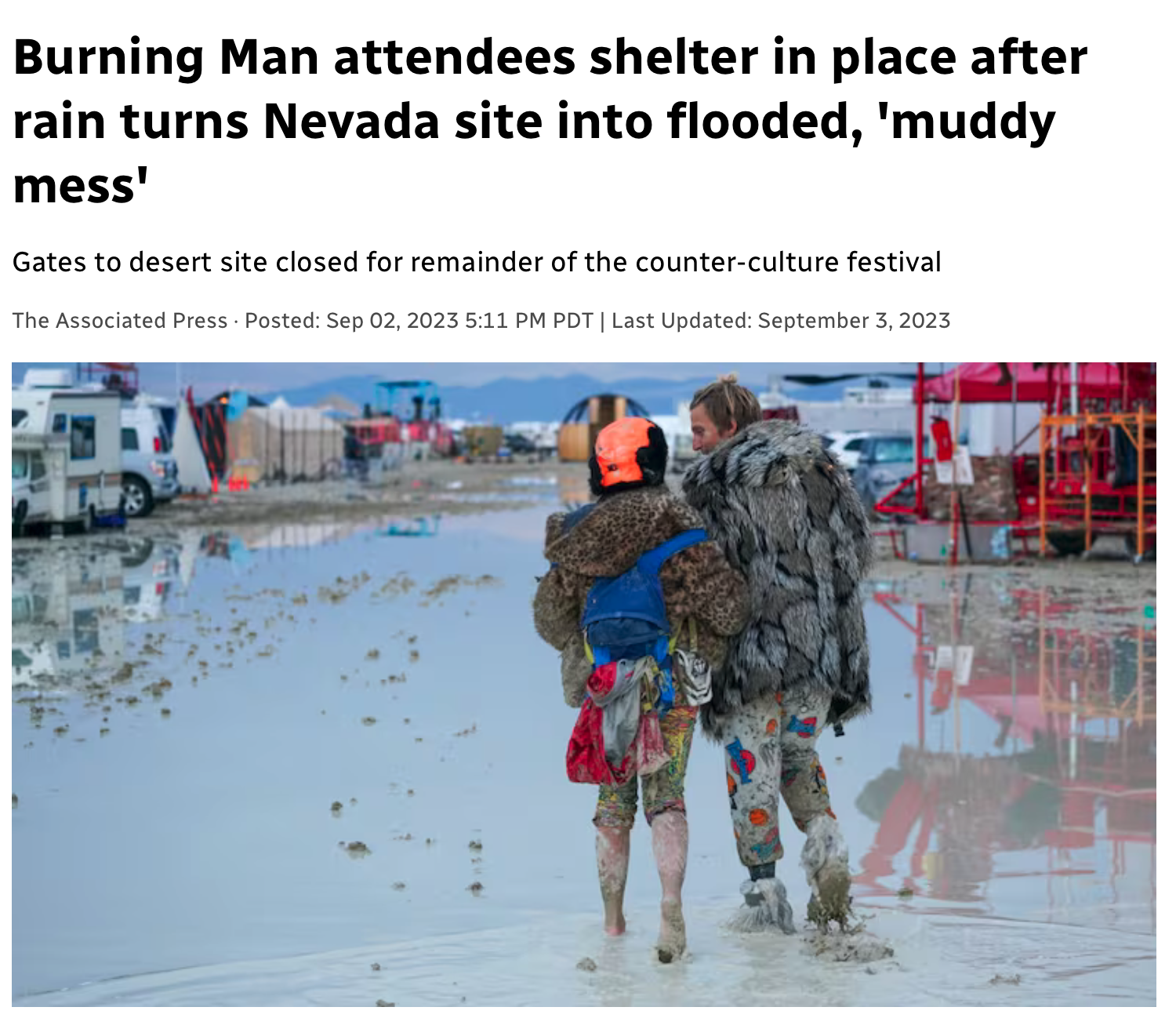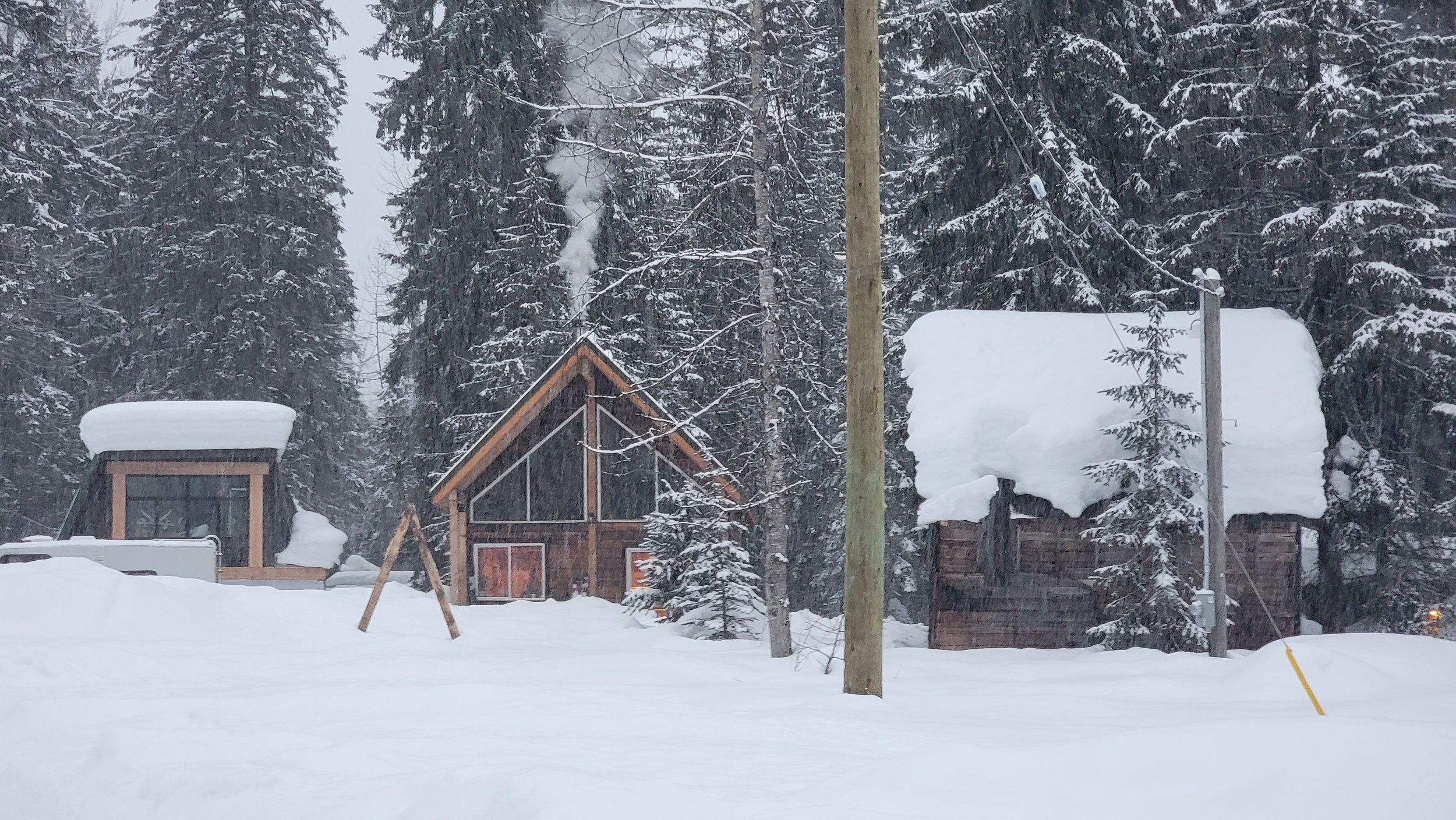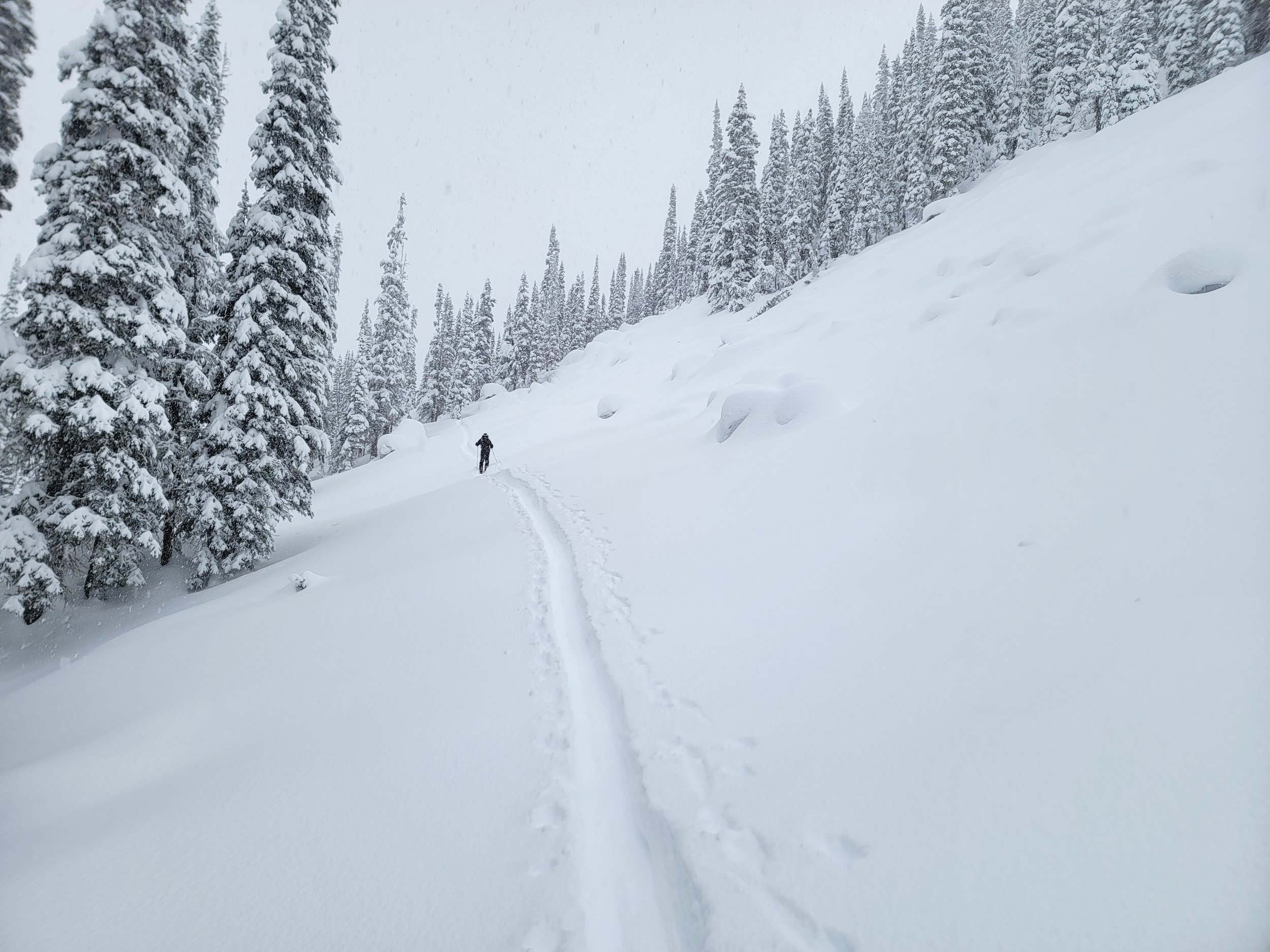Floating Off the Edge of the World: Athelney Pass
Lying on my back in the middle of a turquoise alpine tarn, the air mattress slowly drifting and spinning with the light breeze, I take in my surrounds with a quiet and complete sense of awe. Jagged grey granite peaks, a raw expanse of treeless alpine, towering moraines, and enormous glaciers rippled with massive crevasses frame the view to the east. The light breeze picks up slightly and gently spins my view around to the west. All possible shades of green slide into view, covering the hillside meadows that rise up, lined with cascading waterfalls splitting the slope. Above the bouquet of greens, an eerie and martian landscape looms above: the product of significant volcanic activity and mineral deposits that pulled intrepid miners to the region for over 100 years during the gold rush and subsequent boom. Reds to browns to jet black blend and fold into each other, creating a blurred watercolour painting of unique and interesting geologic forms.
As a pleasant shift from life before the trailhead, floating meant doing nothing at all: no notifications, no schedules just the gentle spin of the raft, watching the sun slowly descend towards the distant ridge. Backpacking feels like the same slow weightless drift, moving with the flow of the natural world surrounding you. Life before the trailhead can at times feel like a frantic swim upstream, or the chaotic churn down the rapids of Teams meetings, expedition logistics planning, social obligations, group chats, 2-factor authentication, Youtube gear review rabbit holes, and a rapidly expanding to-do list nipping at your heels.
A final push of trip organizing, food prep, gear lists, and ride coordination, and then you’re standing at the trailhead, eager to climb onto that raft and drift away from it all.
The tarn currently supporting this serene rotation sits at the col of Athelney Pass, deep in the Coast Range west of Pemberton. This particularly remote location is in the upper Lillooet River region west of Pemberton, host to remote hot springs, threatening volcanoes, and massive landslides. A place where civilization gives way to wilderness, with raw nature stretching unbroken for vast distances beyond the last winding turn of the dusty forestry roads.
Drifting on my little piece of alpine paradise, it felt like I was floating off the edge of the world.
Shan organized an exploratory mission up to Athelnay Pass the previous summer which Mary joined for, which sounded like a high quality though ambitious trip as a single nighter, based on the lengthy drive and significant approach hiking time. So a repeat was desired with a more leisurely itinerary, and time for side trips from base camp at the pass. Mary had talked very highly about the area in the classic Mary way of barely being able to control her excitement, all squeals and guttural moans of pleasure as she described the remoteness, ruggedness, and colour palette of the terrain. As an incredibly talented artist, she has a keen eye for the aesthetic of a landscape.
There was chatter about some more technical mountaineering objectives for those interested, which looked quite ambitious with some particularly uninspiring trip reports, but seemed worth a look. And so gear was packed, headlamps charged, maps downloaded, dehydrated meals rationed, bear spray readied, pre-rolls prepped, and critical apple fritter stores secured.
Plinth Peak, part of the Mount Meagre Massif, the site of Canada’s largest recorded landslide and a massive volcanic eruption ~2400 years ago. Another major event could have dire consequences for Pemberton and the region.
There’s not much for trails out here, so the 16km journey out from the truck to the pass at 1850m trundles through a clearcut fields of overhead fireweed, then pops out on Salal Creek where you try to stay on the riverbank as much as possible until you’re forced into the forest where a very rudimentary old trail has you weaving up, over, and around dense forest as frustration builds before stumbling back out onto the creek.
It’s physically easy, and the stoke was high, so it didn’t feel like long before we broke out of the lower forested elevations into the alpine, where we were immediately treated to a taste of what that this incredible valley has to offer. On the left across the Salal, an imposing ochre wall of crumbling rock chutes and spines, and on the right, enormous glacial moraines, jagged granite butresses and peaks, and blanketing glaciers draining noisy cascades of runoff down into beautiful waterfalls and streams.
We had an outstanding crew for the trip, including Mika “Also typically thinking about skiing while hiking” Davis, mega inspiring eco activist biologist extraordinaire Laura Yates, Mary “Peptide” Pines, Shan “Bring the” Payne, and Jem “Fuck yeah it frits!” Morrison coming together. All solid, positive, constantly entertaining people, and wonderful to spend a few days drifting around together in total solitude.
That’s a tall moraine!
Looking back the way we came up Salal Creek
Getting closer!
Up in the pass, with the remains of an old mining exploration camp bunkhouse slowly crumbling into the earth
At our destination, enjoying a post hike dip at our lakeside campsite.
Camp Athelney, with stunning views of the Icemaker Glacier, and Mount Etherweard
Morning sun breaking into Athelney Pass
Shan had scouted some alpine objectives in the area, but as mentioned, the trip reports we reviewed were not inspiring. The main objective in the area is looming Mount Ethelweard, one of the tallest in southwest BC, gazing down at us uncaring at camp looking like the messy choss chutey bad time. Summits are generally attempted early in the season as you can kick steps in snow up one of the main chute. At this time, in mid-August, with no snow it looked absolutely terrible!
But Shan, Jem, and I had carried some glacier gear with us, and there were a few “easier” objectives of Mount Guthram and Icemaker above us, and so without any real drive of summit fever and alpine starts, meaning a nice casual relaxed morning, we set off to hop around on rocks and crawl on some snow with just enough moderate fear to make it quite interesting.
Shan had just shared this Nathan Pyle comic, which we actively quoted throughout our “moderate danger” activity.
Icemaker Glacier looking rather hole-y. Definitely would have been the much faster and more efficient route if it wasn’t filled with cavernous crevasses!
Yep, those are some big holes!
Unsafe yet highly recommended!
A few sections of quality alpine granite scrambling kept the enjoyment up
We reached this sub-summit of Guthram, and realized we’d gone too high to get to the summit without traversing a very sketchy looking knife edge ridge. So to continue to any objectives, we would have to descend the last section of glacier, cross another one, jump across a rather large looking moat to regain the rock, and then… who knows!
As we were very non objective-y we all easily agreed that this was an extremely pleasant location for lunch, sat and enjoyed the views and some snacks (really it’s all about the snacks anyways), before delicately retracing our steps back down the blue ice glacier to the talus slopes and onward back to camp, hopefully in time for cocktail hour at the beach.
Looking at the route from yesterday up from Salal Creek
The route up Etherweard from across the valley. Described as a Class 4 scramble… May be above “moderate danger”
“The Elephant”, a very cool volcanic feature above camp on the west side up towards Mt. Ochre that we would investigate the next day
Looking west up towards the edge of the massive Lillooet Icefield, one of the largest in BC
“We Could Almost Die Over Here”
Icemaker Glacier and Etherweard
Medium Danger
Cool to see the terminal line of the extent of the Icemaker Glacier clearly defined across the valley. Insert gloomy comment about climate change and receding glaciers here.
Two people enjoying their “preferred level of nature”
Looking back down to camp at the lake.
We arrived back at camp almost simultaneously with the rest of the crew, who had explored the west side and had stood on the “Elephant” roughly the same time we were looking down on it. We shared stories, had some laughs, smashed down as much calories as we could, and caught a bit of the epic star show once it got dark.
We talked the crew into heading back up to the west bench above camp near to explore more of that area, which was strikingly different from the east, with gentle rolling slopes, loose volcanic rock, and a wild diversity of colours and tones of the soil and rock, making for a surreal, almost alien landscape.
“The Elephant”
120 year old mining claims found discarded up on the upper ridge
“It frits!” Jem flexing his Save-On Foods apple fritter game, which he puts in the same ziplock baggy as a PB+J, leading to the high pressure of a stuffed backpack physical fusing the two top shelf snacks into one uber snack.
Looking back towards Icemaker, with Guthram up on the right
We intentionally picked a straightforward half day mission, as the crew was super keen for an epic lake day party in possibly the most beautiful floaty lake you can find!
We did not pick a particularly shady spot, so the UV-sensitive among us had to go to work making their own. Fortunately, building shade structures comes second nature to Burners.
If you can spot Jem in this photo, I’ll be very impressed. We made him, wearing his all light grey getup, walk out into the boulder field and I snapped this ultra wide angle shot, with plans to make it into a “where’s Waldo” type book series some day.
Seriously, good luck!
The toe of the Icemaker Glacier. We ventured over to collect cocktail ice which helped take the edge off my sun warmed tequila.
The night shots didn’t really turn out, as I need to spend a bit of time familiarizing myself with how my new Olympus camera works for the optimal long exposure shots. Needed a shorter shutter speed to avoid the blurry stars, but the Milky Way’s galactic core is always cool to see.
The crew!
The exit took about as long as the walk in, but with the long slow descent, it was fairly painless. Even the dense forested section, mildly infuriating on the way in, felt a bit easier after the unwinding of the previous few days.
Back at the truck, we floated on a post trip high, enjoying refreshing stream cooled beverages and salty chips, not quite ready to dive straight back into the whitewater. The messages, the todo list, and the Monday meetings could stay upstream a little longer while we bumped slowly down the dusty road back to civilization.
Athelney Pass lives on as that memory of quietly spinning under the majestic mountains, drifting on the edge of the world.
Owl to Tenquille Traverse
Round 3 of the “Pines Pack v. Jones Jog” summer epic would take us north of Pemberton to a classic point to point that is often completed as a long run, but we opted for a leisurely 2 day walk to have time for summits and swims. This Rec Sites of BC site and managed trail extends from the Owl Lakes/Chain Lakes area off the north road to Anderson Lake, across a long alpine ridge that runs west parallel to the Pemberton Meadows Valley, finally descending to Lake Tenquille and on to the north terminus on the Hurley FSR.
It is a fantastic route, with more stunning lakes than you can count, some cool off trail adventure, and verdant alpine meadows blooming with an incredible array of flowers.
Mega crushers Jem and Shan, the “Mo Payn” duo, joined up for this mission, undertaking a relatively low stress activity in amongst the madness that is some of Shan’s mountain epics, with Jem testing a problematic ACL keeping him off of burly climbing objectives. Sometimes going for a nice reasonable long walk in the mountains with great friends with a general lack of high risk and fear is precisely what the doctor ordered!
Setting up the shuttle for a point to point of this size takes a bit of logistics, but fortunately we had the time and the vehicles to make it happen. We tested Shan’s newly inherited F-150 up the Hurley and onto Branch 12 to the Tenquille Trailhead, the latter consisting of a few waterbars but nothing significant, and in better shape than expected. We had left late after work, so by that point, we had time for a Pony dinner and drive to the Owl Creek Rec Site to crash, before driving up the Owl Creek FSR to the east end trailhead.
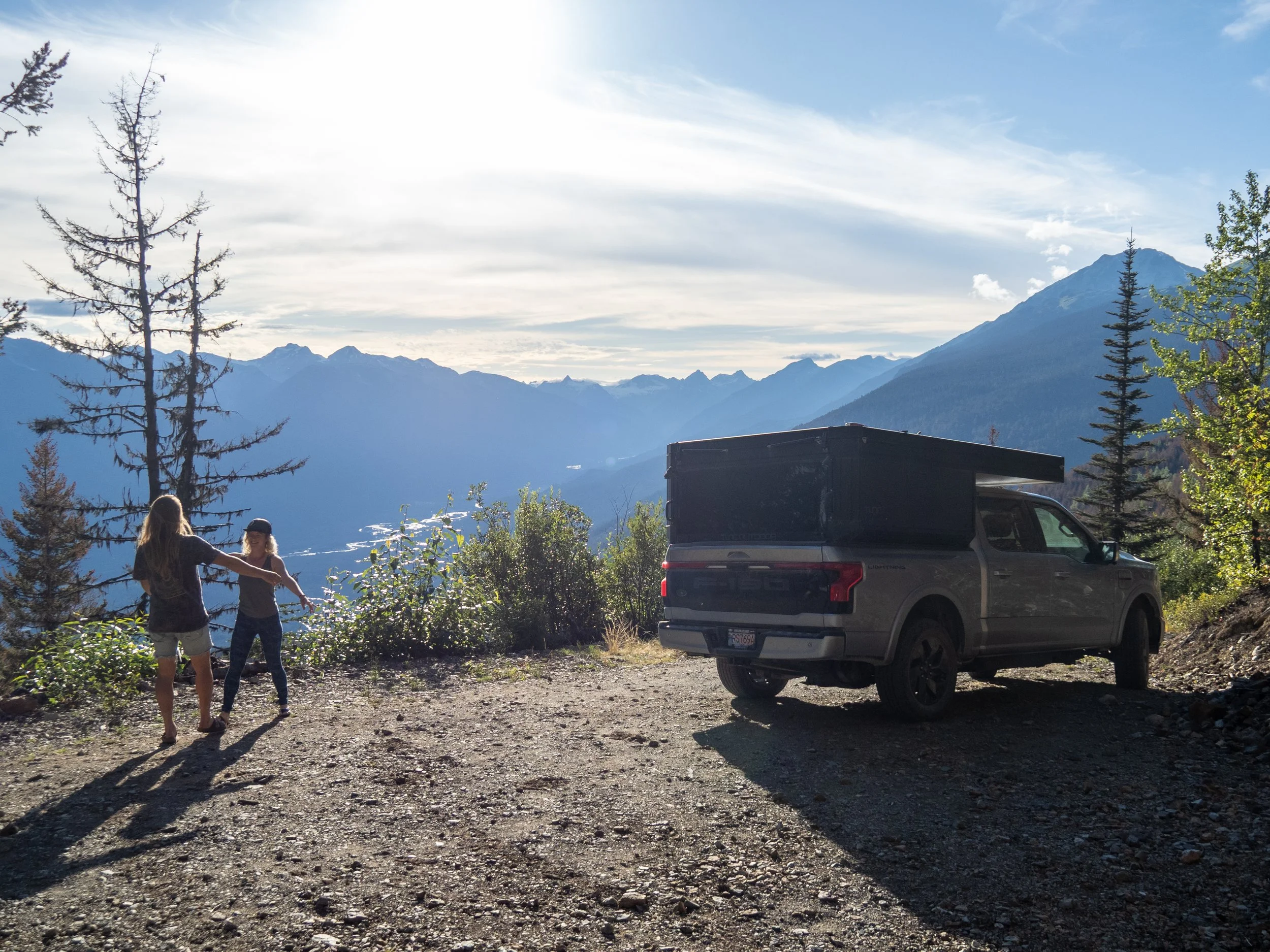
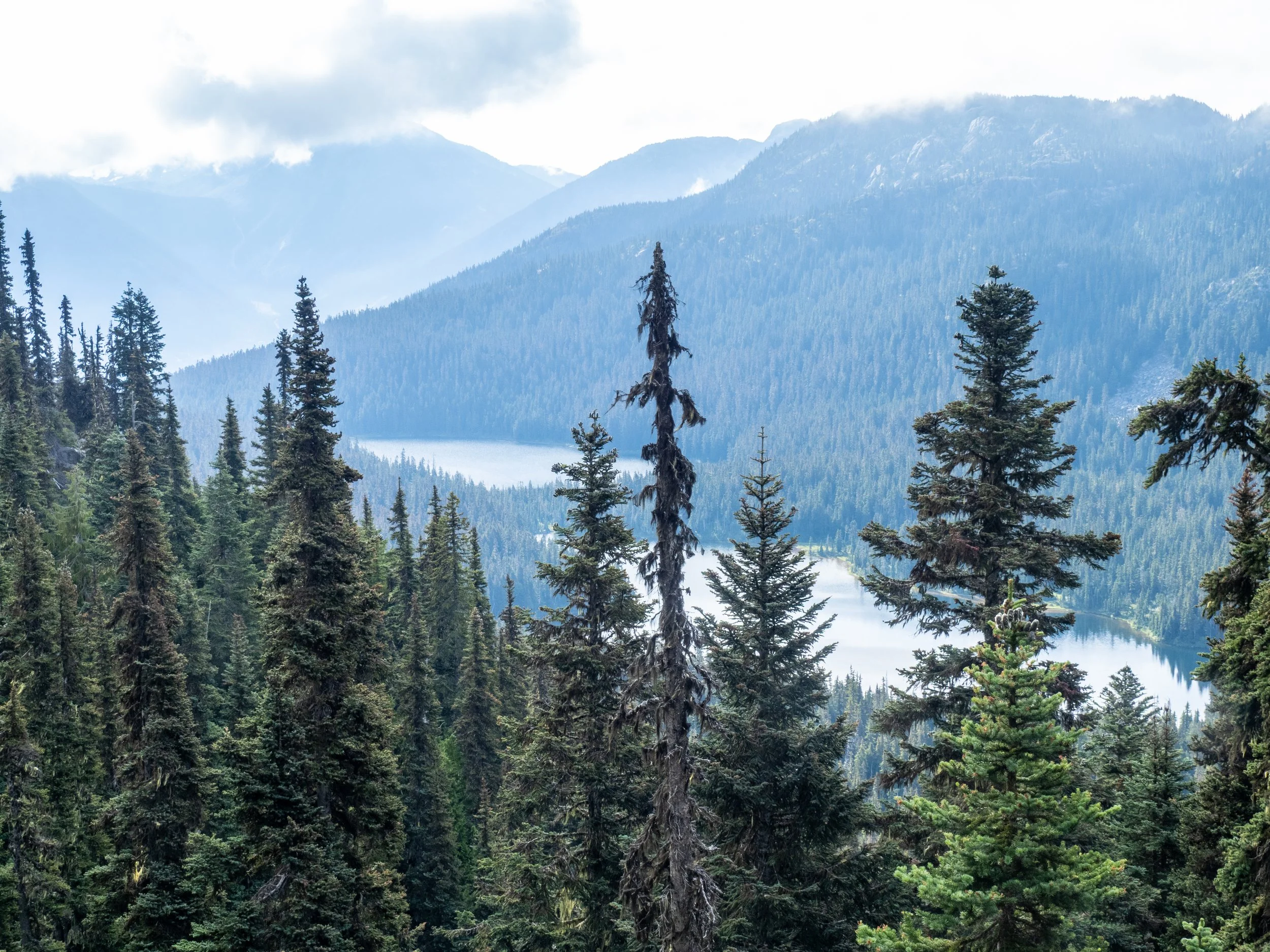
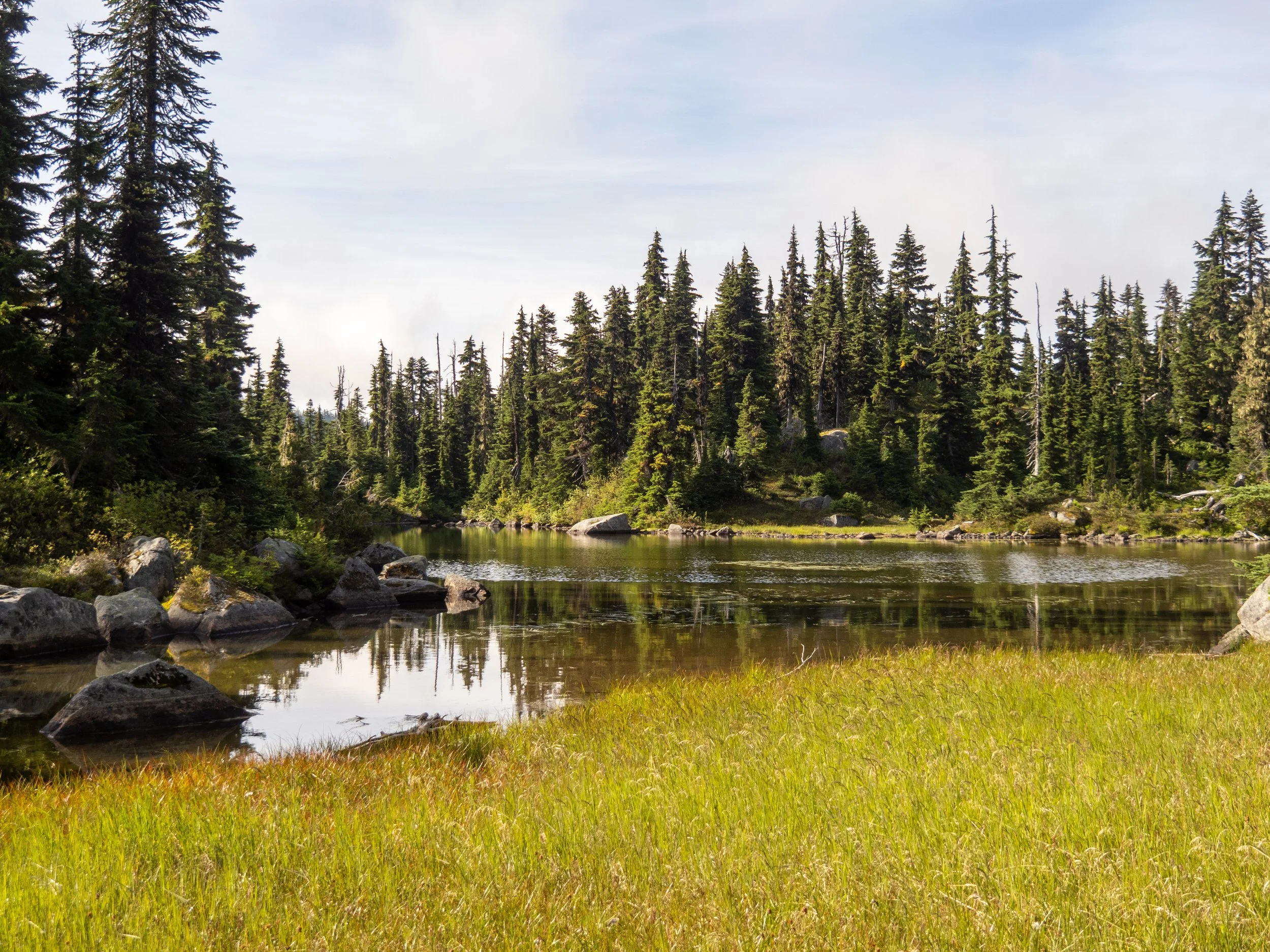
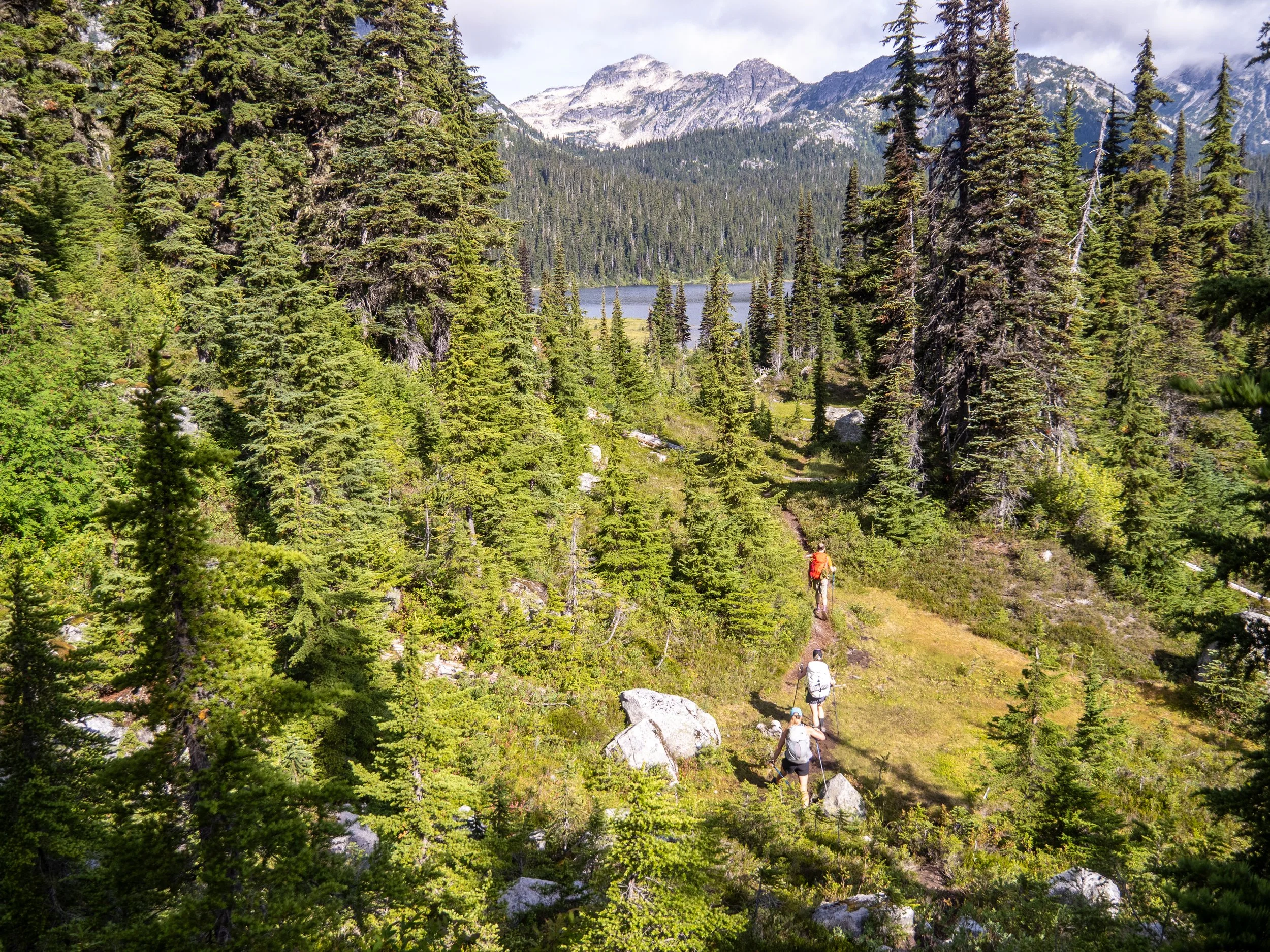
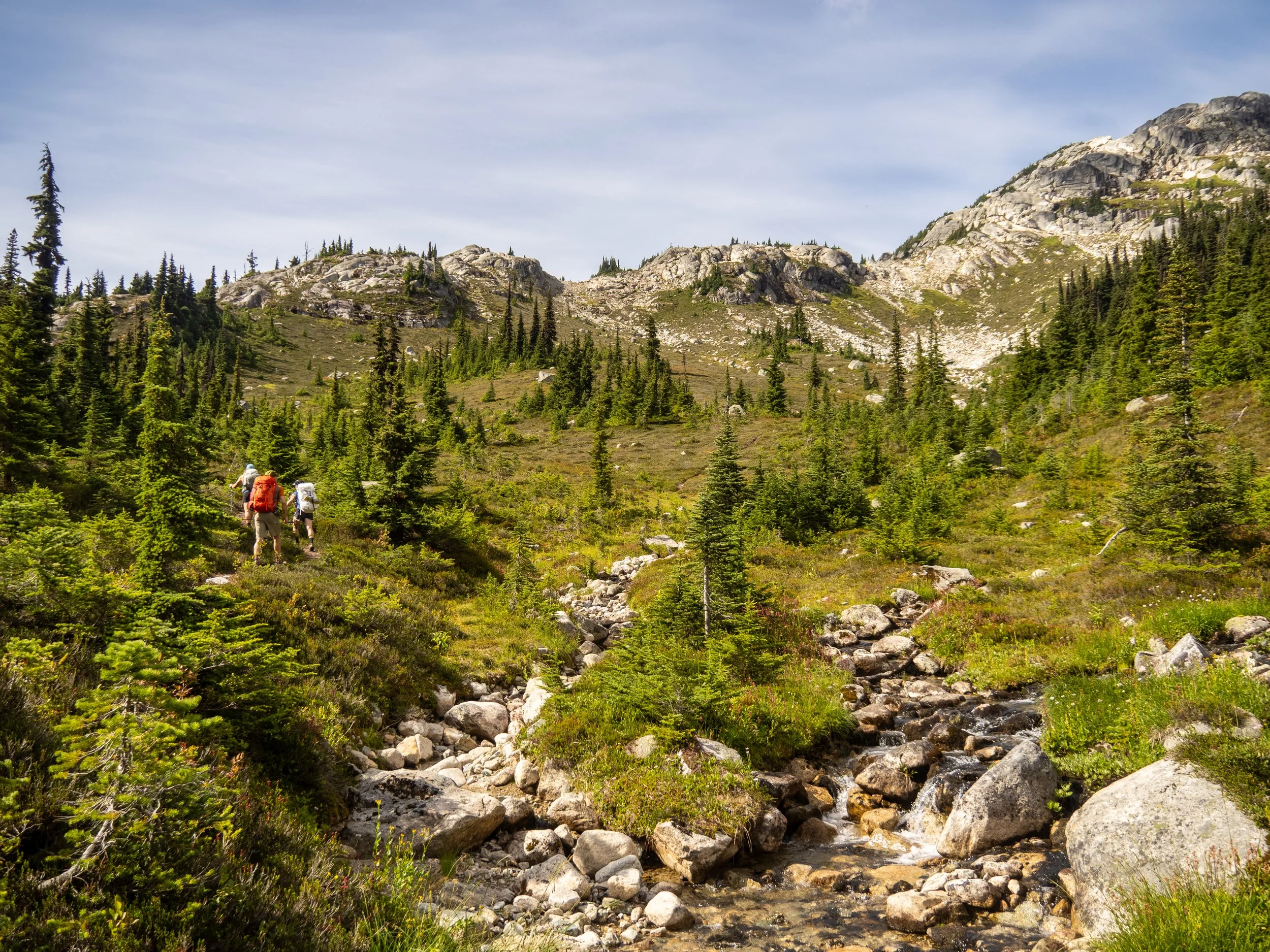
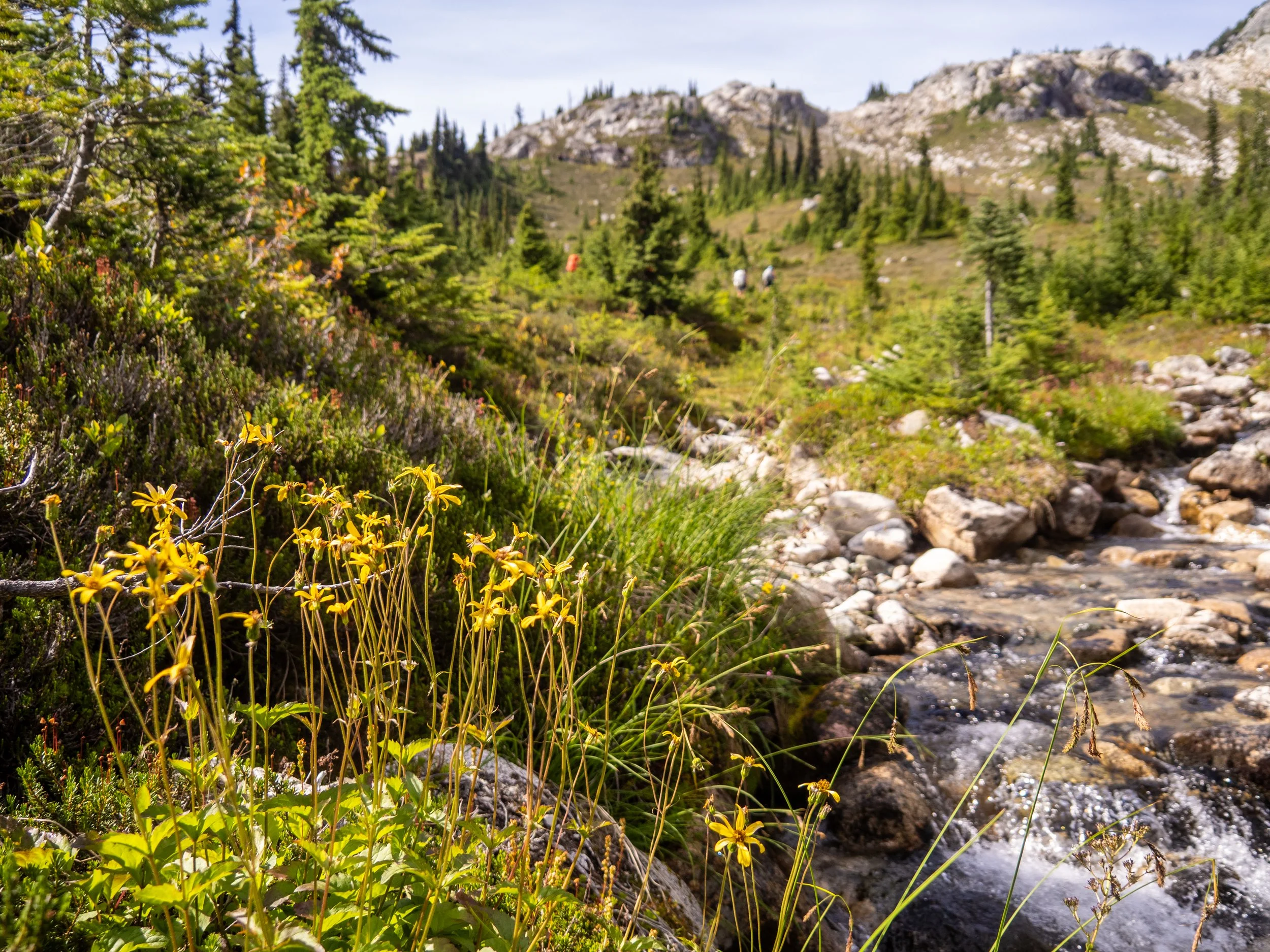
Leaving the clearcuts at the trailhead, the trail meanders up and over the Chain Lakes, climbing towards consistently pretty alpine meadows and lakes. We likely crossed 8+ beautiful lakes in the first couple hours, and were shocked that we did not see a single other person, or signs of camping. This is an incredible area, but doesn’t see the traffic that other nearby sites do, I guess partially due to the worse access up the Owl Creek FSR?
The crew at Fowl Lake
At Fowl Lake, the trail ends and the route finding section begins, though it’s fairly obvious based on the GPS track and the odd cairn marker. Ascending from Fowl Lake through enormous car to bus sized boulders was pretty fun and engaging.
Ascending boulders above Fowl Lake


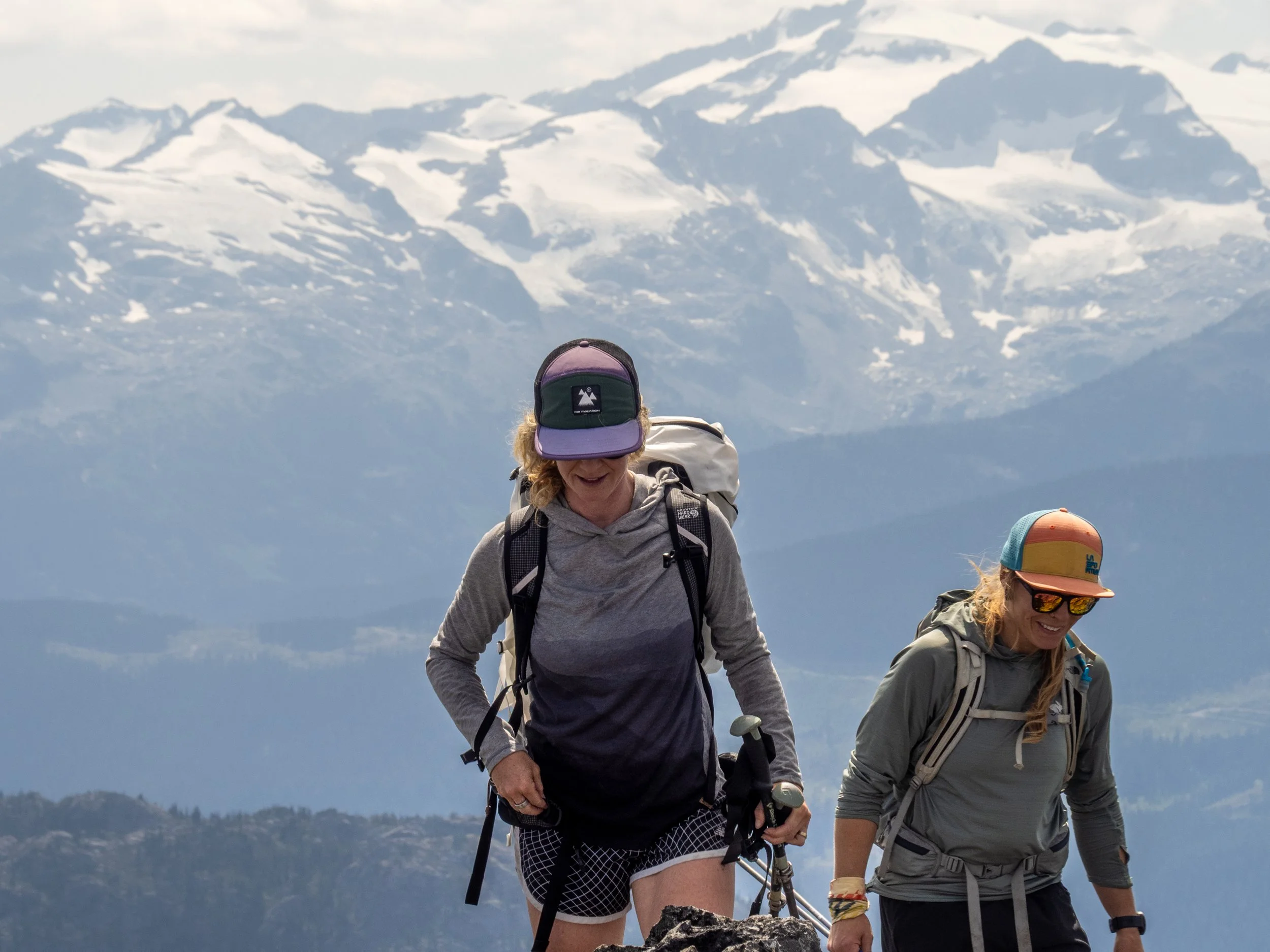
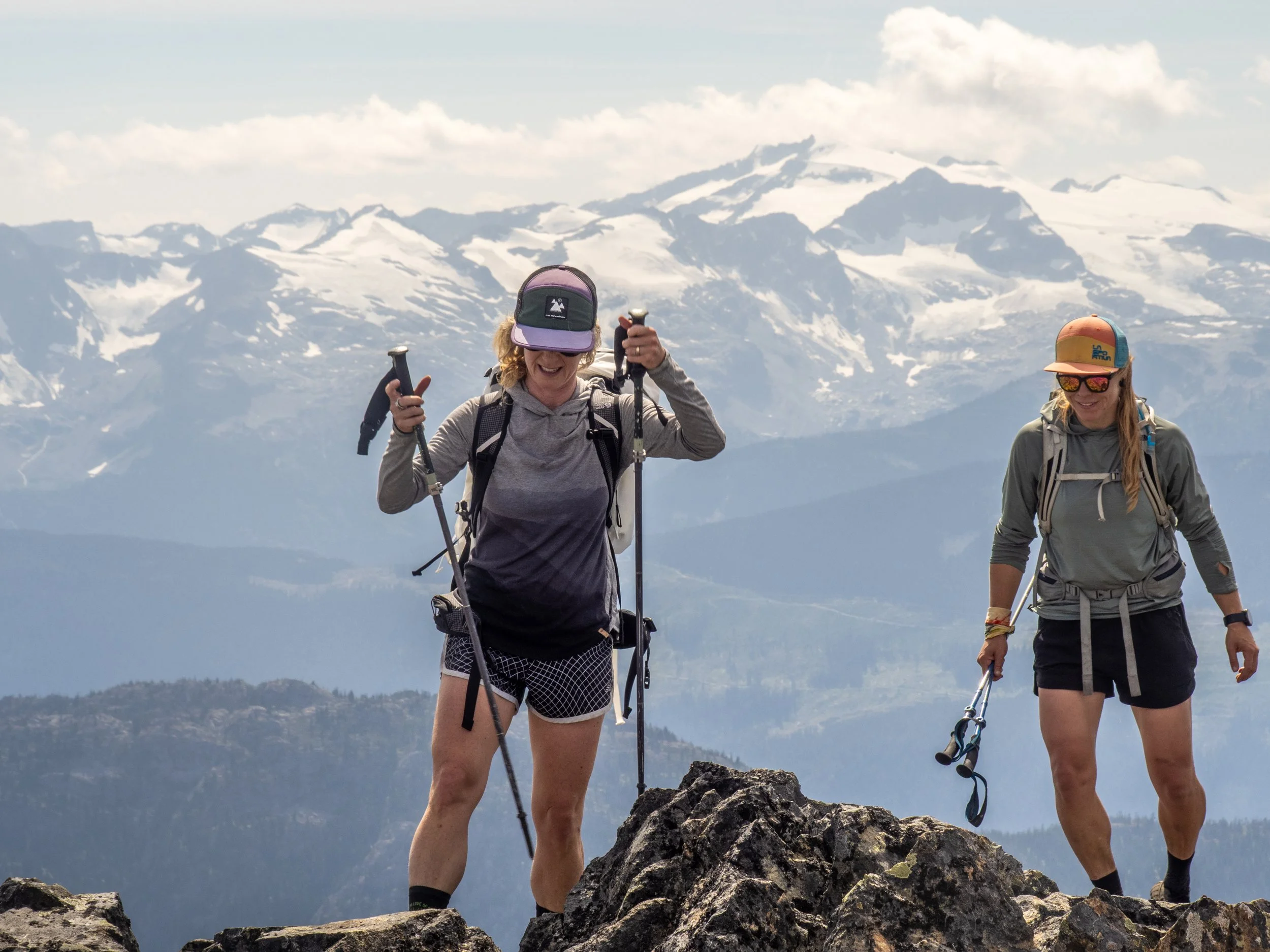
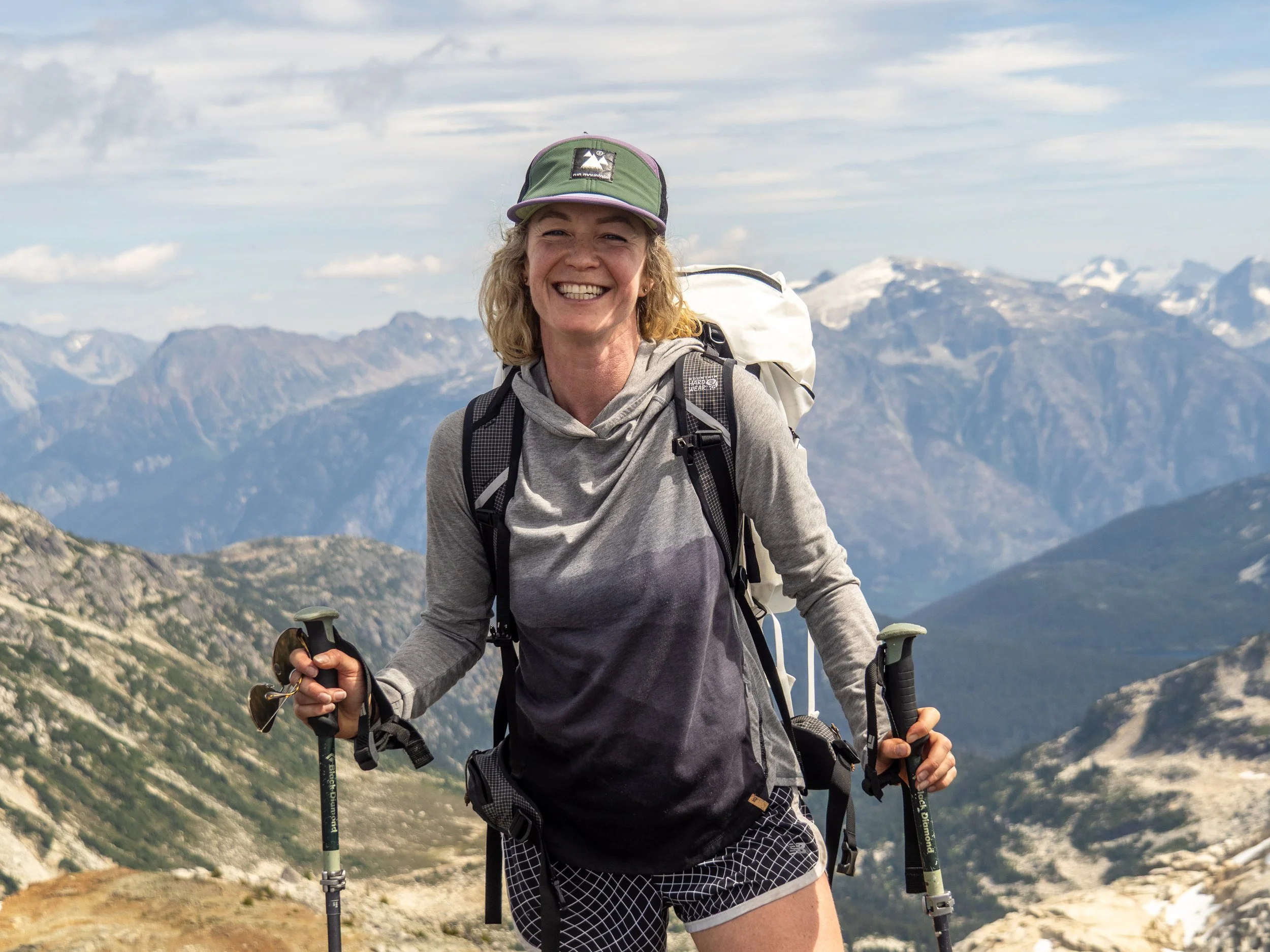
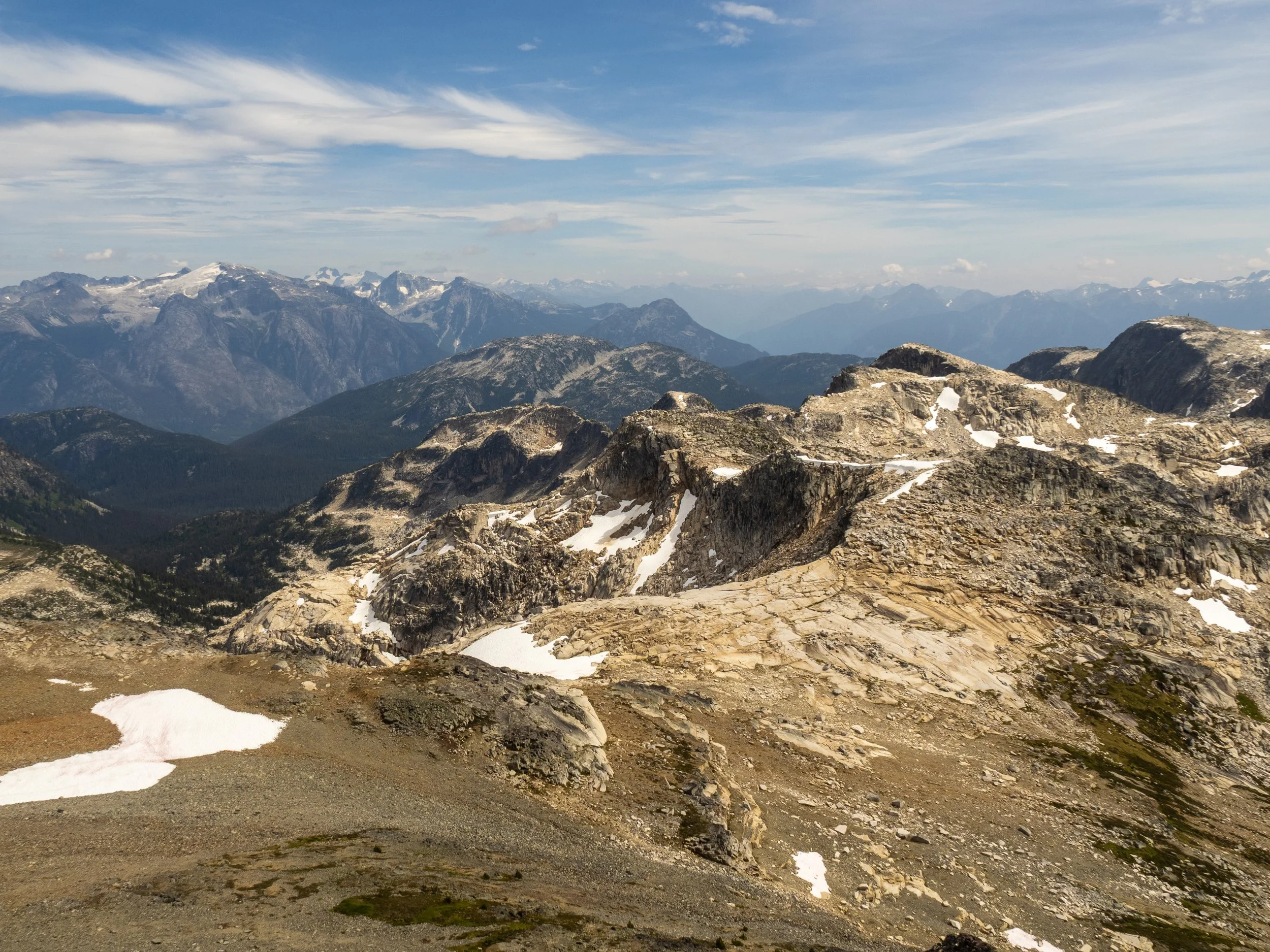

We took a brief detour to reach our only summit of the trip, Mt. Ronayne. From the top, sweeping views revealed much of our route in both directions. The peak is also a storied spot for skiing in past winters, as it hosts an exceptional snowmobile-access zone that offers long, steep ski lines that can be doubled up and lapped with relative ease. It was one of several moments this summer where I stood in a landscape that felt familiar from winter, yet carried an entirely different character and presence in the summer season.
The view west towards the continuation of our route. We would descend down to Ogre Lake at the far end of the valley, then back up verdant slopes with the goal of camping up in the upper basin where another small tarn can be seen. Tenquille Mountain is behind to the right, with Locamotive and Sampson further west.
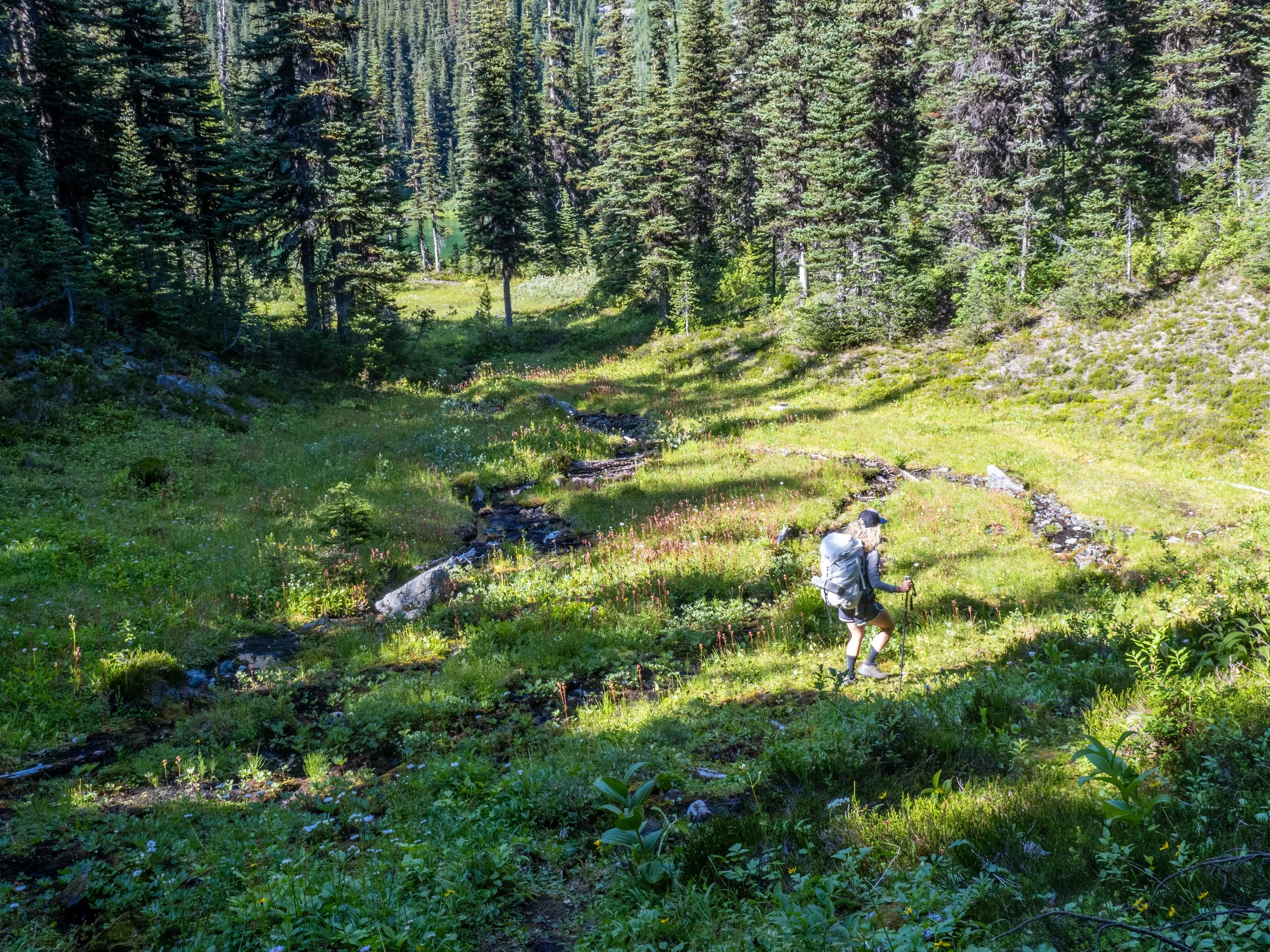
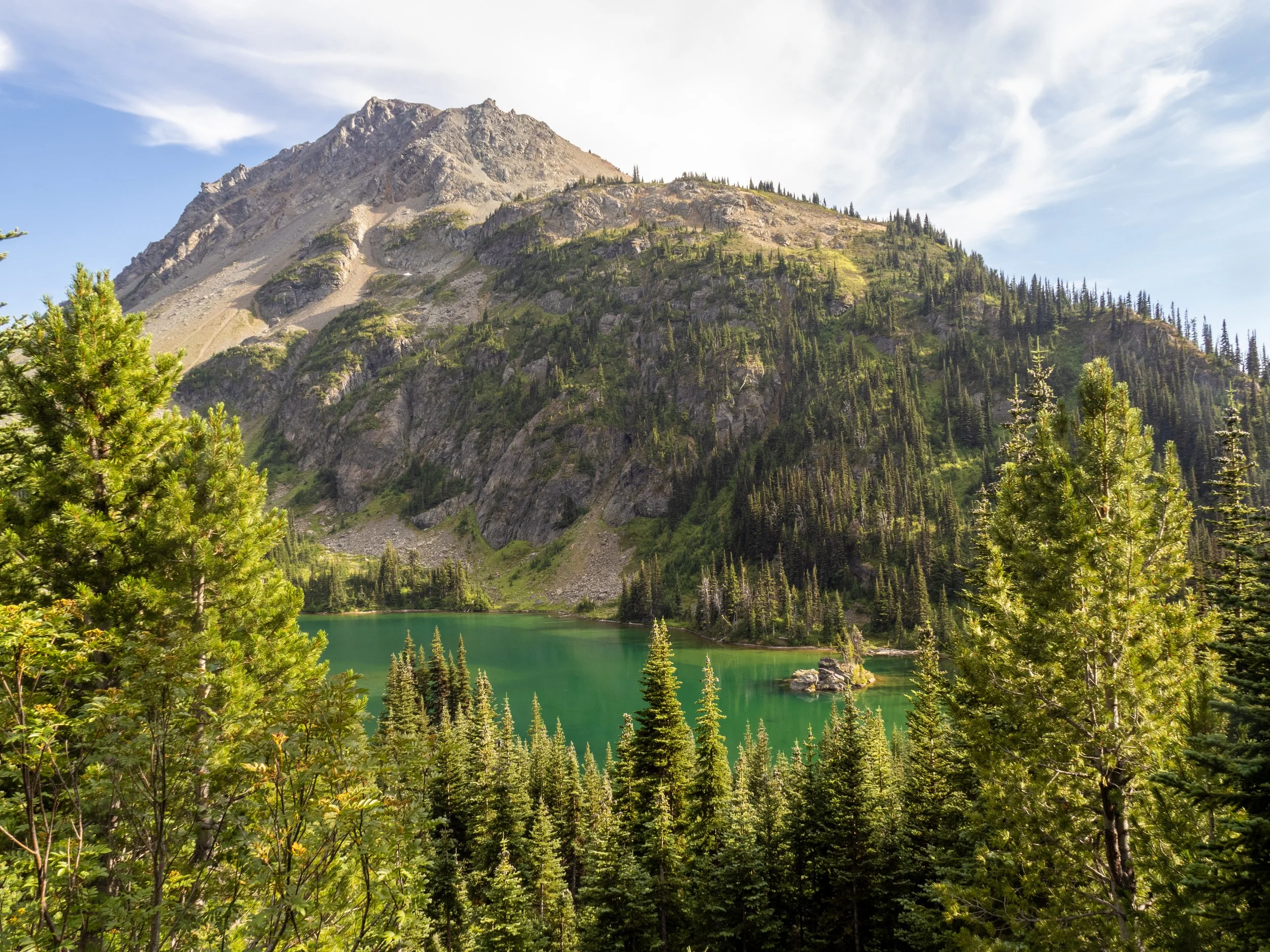
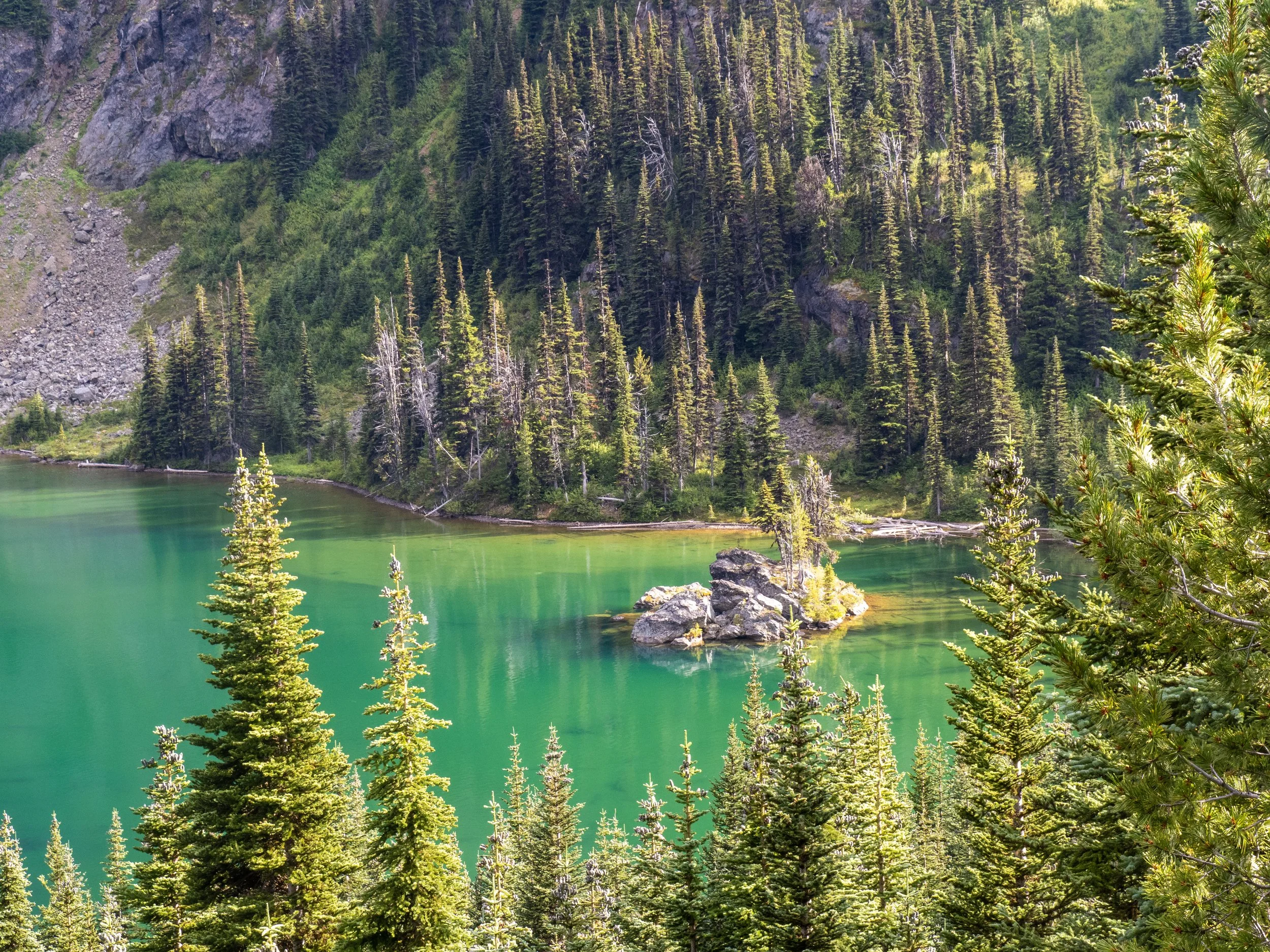
The trail picks up again down in the valley, where the descent from Ronayne is fairly direct and uncomplicated. From there, the route winds past even more lakes, open meadows, and flowing streams, weaving together an incredible lush landscape.


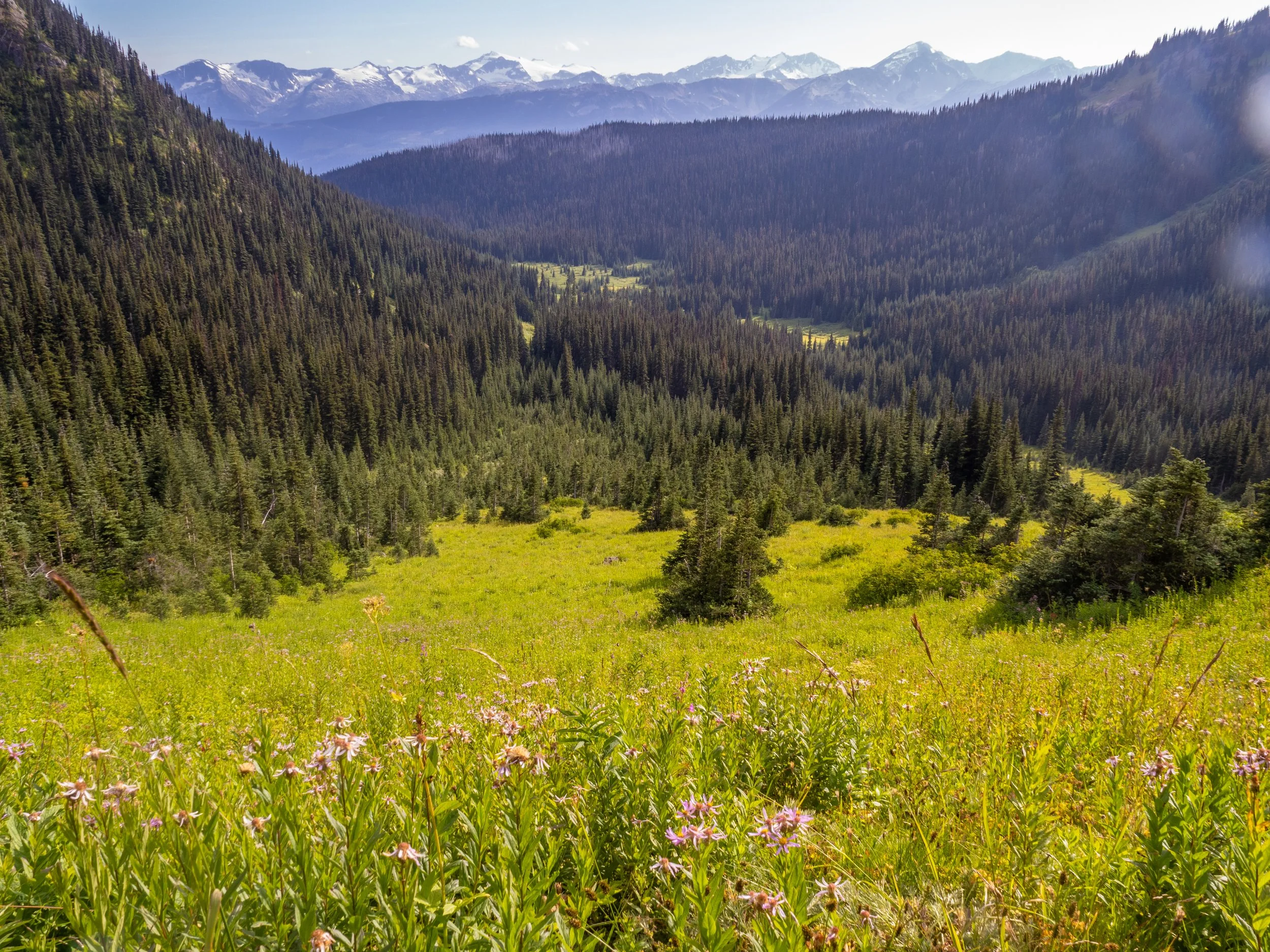


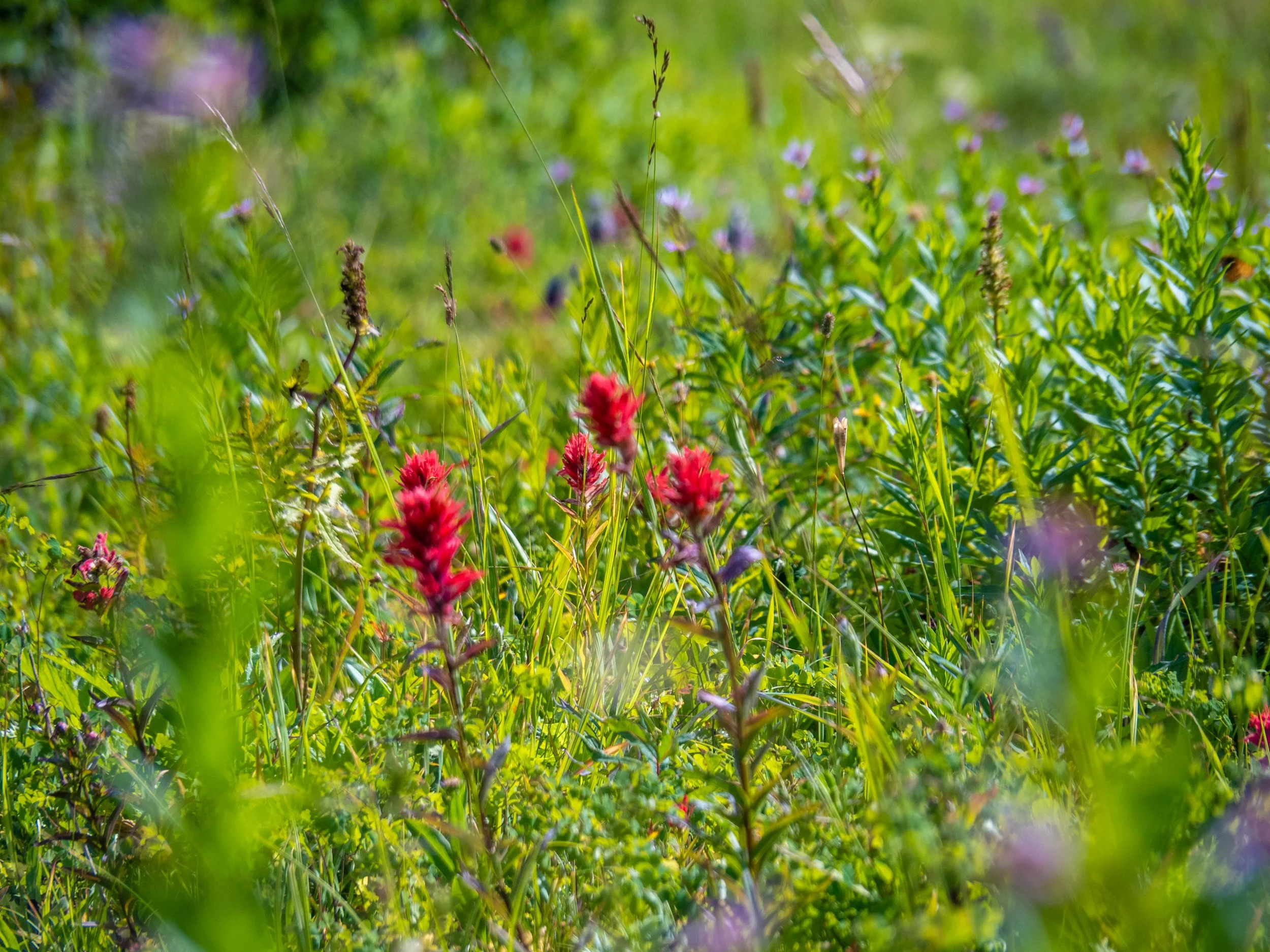
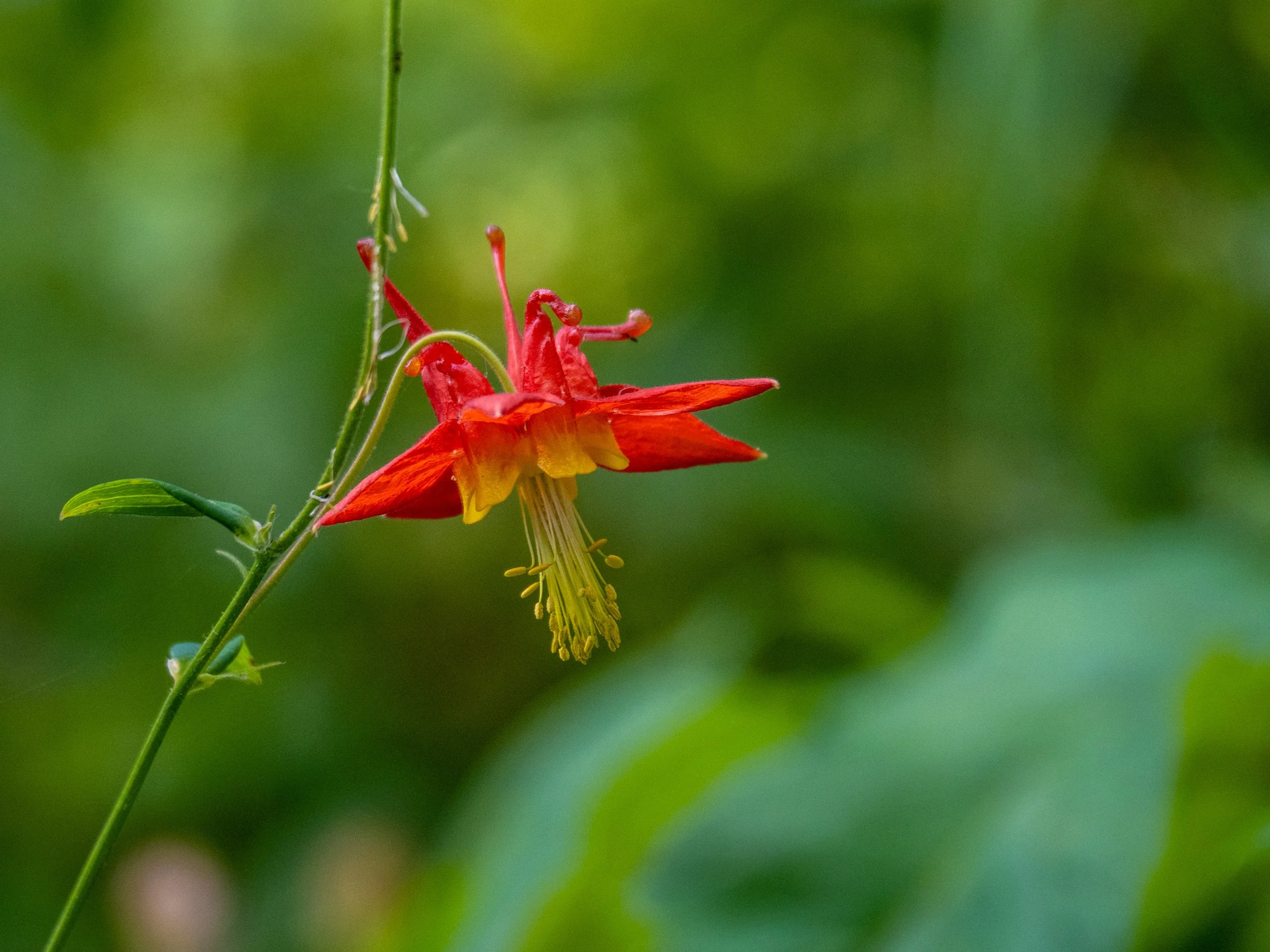

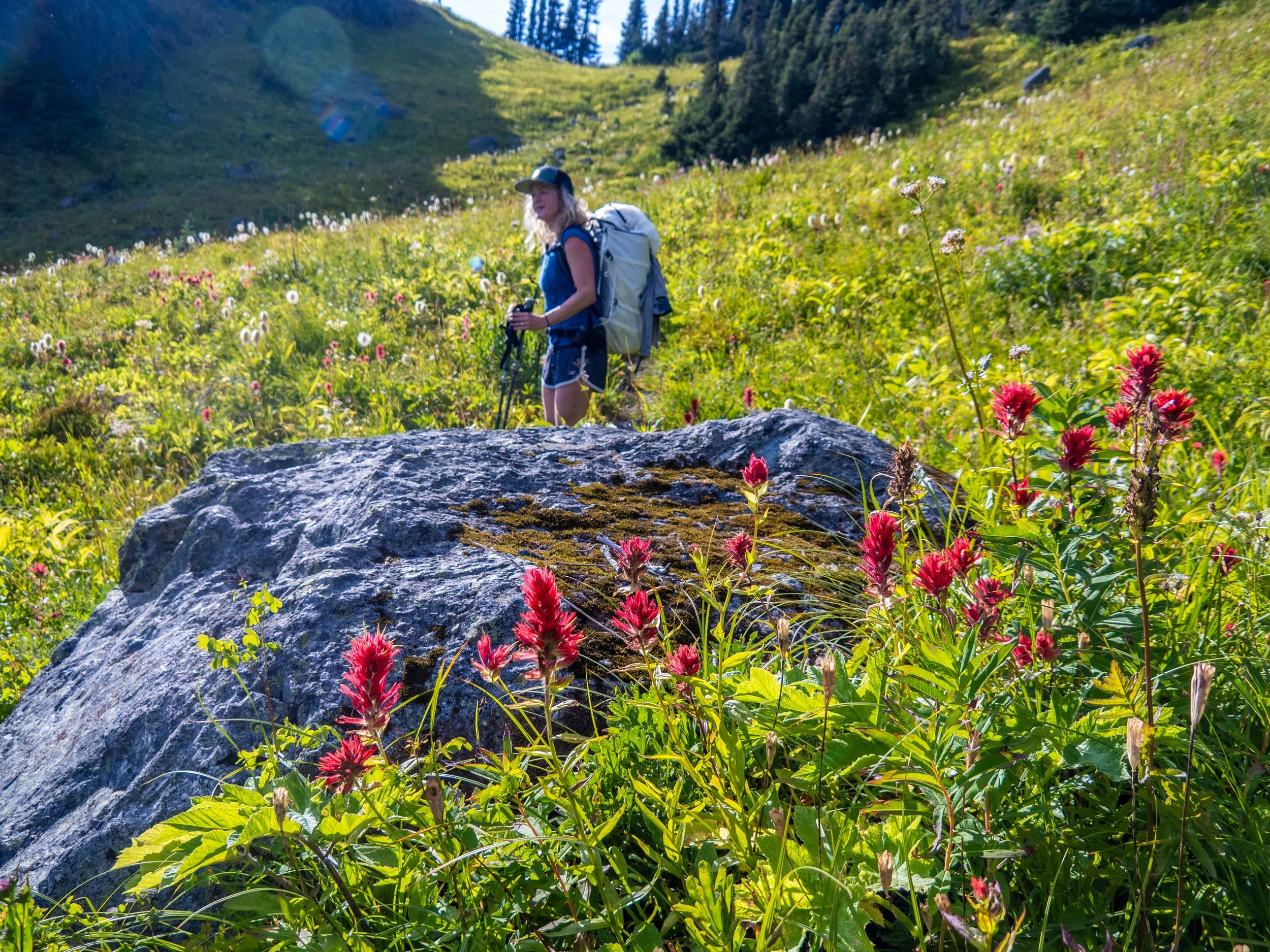

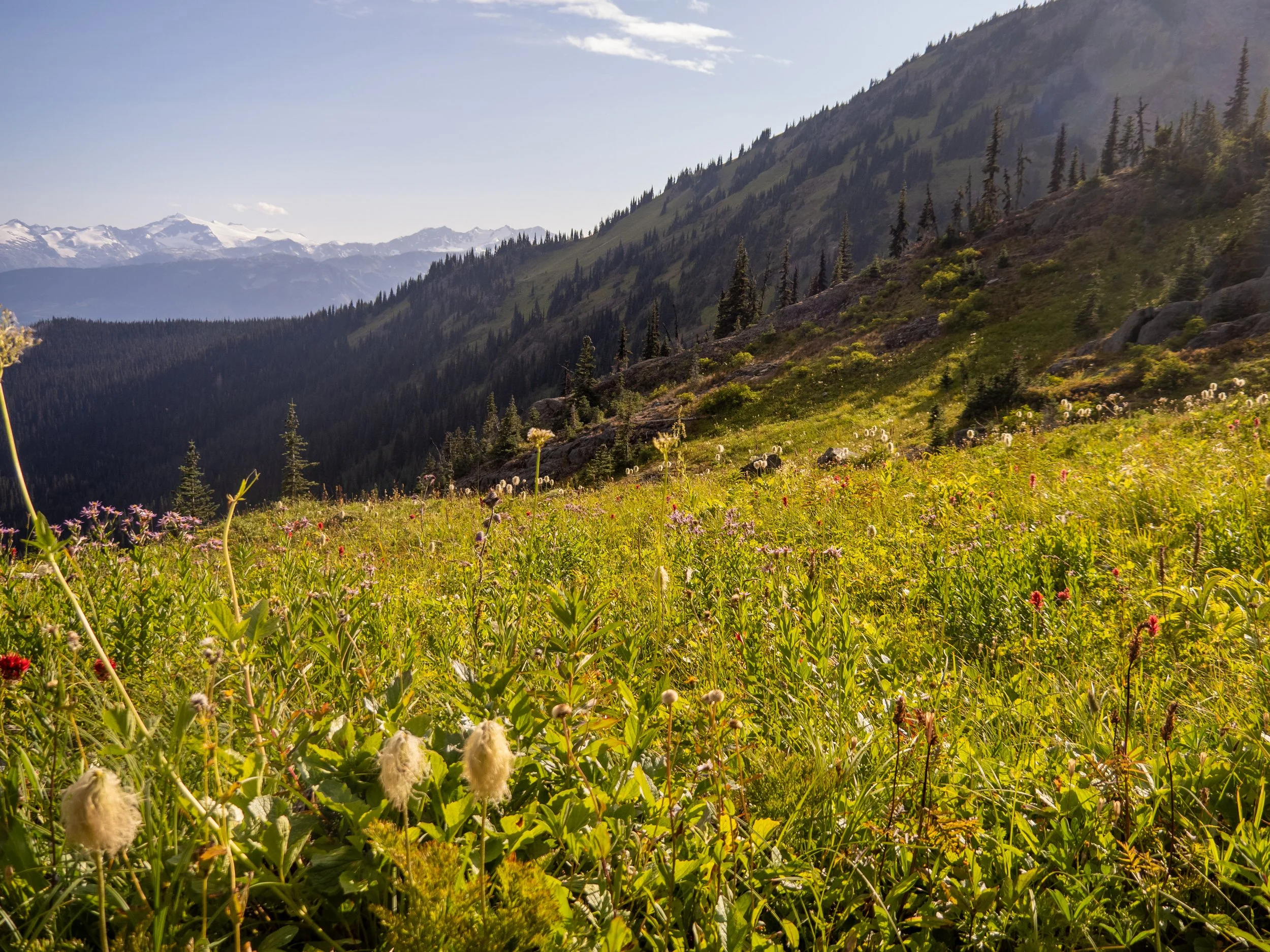

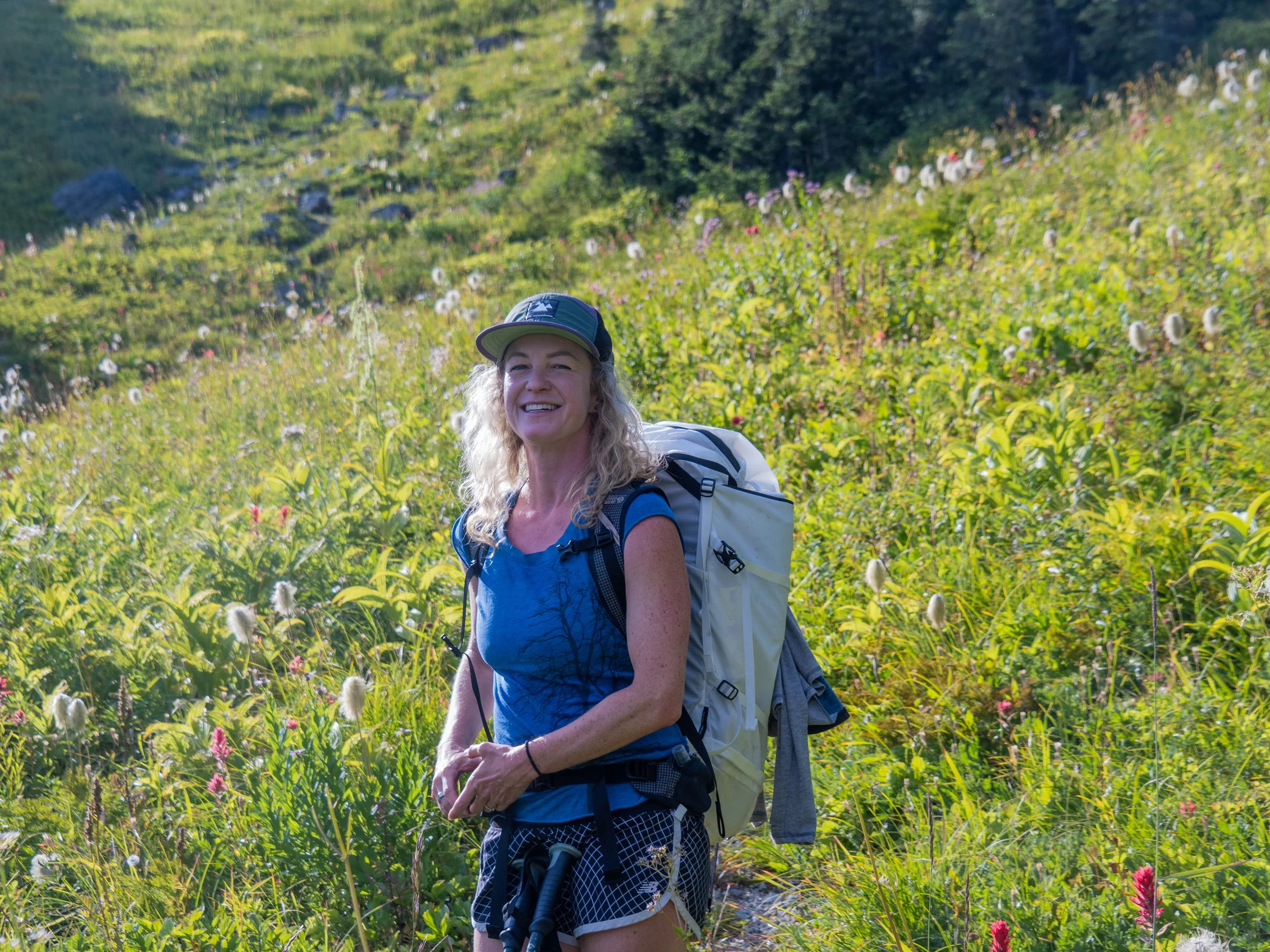



By the time we started the ascent from Ogre Lake we had pushed a fair distance of around 18km and 1800m of climbing with overnight packs, and the crew was starting to fade a bit. But we were immediately greeted with jaw dropping lush alpine meadows with a dazzling array of flowers, bee, birds, colours, and smells. This provided a much needed burst of energy, with plenty of stoke as we meandered up to the basin where we would set up camp for the night.
It’s incredible how much fatigue is tied to mental states. Exhaustion can completely dissipate when the mind is engaged and awstruck by its surroundings.
In the upper basin above Ogre Lake
Alpenglow from camp on Ronayne.
A few pesky mosquitos came out at dusk in an attempt to prove my point regarding backpacking, but they seemed to mainly just want to hang out on Shan’s bright turquoise toque. We crawled into the tent well before dark, which never actually came as the full moon illuminated us in our tents with such intensity that eye masks were needed.
The next day we had looked at a direct up and over option around Mt. Barber, but we’re unsure about the route and if it even went without technical gear, of which we collectively brought none. So we marched to the col to the east of the peak and it became immediately apparent that this was not gonna fly, as the access to the summit and the descending ridge beyond looked very technical. But the views were worth the climb up anyways, and so we enjoyed a morning snack before descending back down the way we came, regaining the main trail.
Views from the col east of Barber. More beautiful lakes, the lower one we would pass a few hours later and enjoy a very refreshing swim.
First views of Tenquille Lake in the distance on the left.
This was gold mine country, and so signs of old claims were present, including this old wheelbarrow accompanied by a lot of abandoned trash.
More lakes!
Mary enjoying the final lake of the trip at Tenquille
The “Pines Pack” strategy allowed for numerous refreshing lake dips, and we stopped at the recently upgraded Tenquille Lake cabin, a joint project between BC Rec Sites, the Pemberton Wildlife Association, and the Lil'wat First Nations. A lot of work and resources have gone into this hut, with a full time caretaker residing on site, who we chatted with for a bit about grizzly sightings and hut maintenance. It appears to be a successful partnership, which has proved to be a challenging and divisive topic recently, with opposing ideas of how these special places should be treated, maintained, and shared.
BC Parks is currently engaged in a challenging arrangement with local First Nations interests, who have collaborated on annual closures since 2021, but this year Parks rejected their request for a longer closure, shutting down the park for 30 days instead of the 2-3 months requested.
For Tenquille and the Lil’wat, I imagine being at the table initially during the development of the vision and strategy for land use management would have been significant. If interested, the Visitor Use Management Strategy document on the Pemberton Wildlife Association site provides historical context of the local First Nations, and values associated with the area.
We were incredibly appreciative to have spent some quality time in this incredible landscape. The effort that has gone into developing and maintaining this area is substantial, yet, remarkably, it receives only a fraction of the foot traffic seen at other local destinations. Aside from crossing paths with another duo on the Owl-Tenquille trail—who, by chance, camped at the very same site as we did—and briefly encountering the hut caretaker and a couple of groups heading to Tenquille Cabin towards the end, we enjoyed complete solitude. Which is wild considering how close to Pemberton this trail is.
I hope we continue to nurture and develop these shared resources in a sustainable way, that avoids overuse, provides a level of respect and compassion to First Nations’ interest, while maintaining access to the general public to enjoy as much as possible.
These places are just too special to lose, either through misuse or disuse.
Squamish Cheakamus Divide (“Semi-Alchoholics Traverse”)
Relationships are all about compromise (or so I’m told), and so to balance out our last overnight backpack adventure, I got my wish of a “fast and light” long day trip across a wide swath of the Sea to Sky between Whistler and Squamish, with an elite crew of rad humans. We also got a lot more than we bargained for, as there was a slight miscalculation about the actual length of this route!
The “alcoholics” traverse starts by ascending from Brandywine meadows to the summit of Brandywine mountain, and continues on a long high alpine traverse past the jagged tooth of Mount Fee to Keg and Brew mountains to finish. A long but not particularly technical 25km point to point. An even longer, more technical option, which includes two more impressive scramble summits along the route, continues along the main ridge towards Squamish, climbing Cypress and Tricouni, before descending to Berg lake and out.
We were keen for the latter, and had a strong and capable group to pull it off in a long day push. Confusingly, available online GPS tracks ranged anywhere from 22kms to 40km (!). In my head I roughly split the difference and was expecting around 28km and 12 hours. Others were slightly more optimistic. It ended up being around 30km and took as a little over 13 hours, as there was a fair bit of more technical talus and scramble sections that are hard to safely move fast over.
This was an extremely high value hike, staying well above treeline almost the entire way, with incredible views of Mount Cayley, Fee, and expansive vistas from three main summits that mark the highlights of the route.
Our relatively large crew of 7.5 (Brian “Deep House” wasn’t joining for the whole trip and only the Brandywine summit) seemed large for such an expedition, especially complicating the shuttle logistics, but it worked out really well in becoming not only a super fun mountain adventure, but a great social mission, with extremely high stoke and vibes.
Dylan “finally stopped falling apart” Falls, as usual, was the pace setter for the mission, charging along with his zero percent body fat and long bike fit legs.
Shan had recently done the clinically insane thing of climbing Mount Fee the week before, so she was able to provide some beta of our route and show us the terrifying loose “sand slab” and precarious loose blocks that make up a “scramble” that sees barely any traffic in the summer for very obvious reasons.
We were stoked to team up with zen yogi superstar and local legend Julian Wells and his elite trail racing partner, the long legged Malin, who both maintained an awesome level of positive stoke and energy the entire 13 hour journey.
Our boy Zac Holden joined, fully recovered from any and all Montenegrin stomach viruses by now we assume.
Mary was quite nervous about this one (as was I!), considering the elite level of athlete making up the crew, but this was a great confidence booster trip for the modest Dr. Pines, as she crushed it and made short work of a long day.
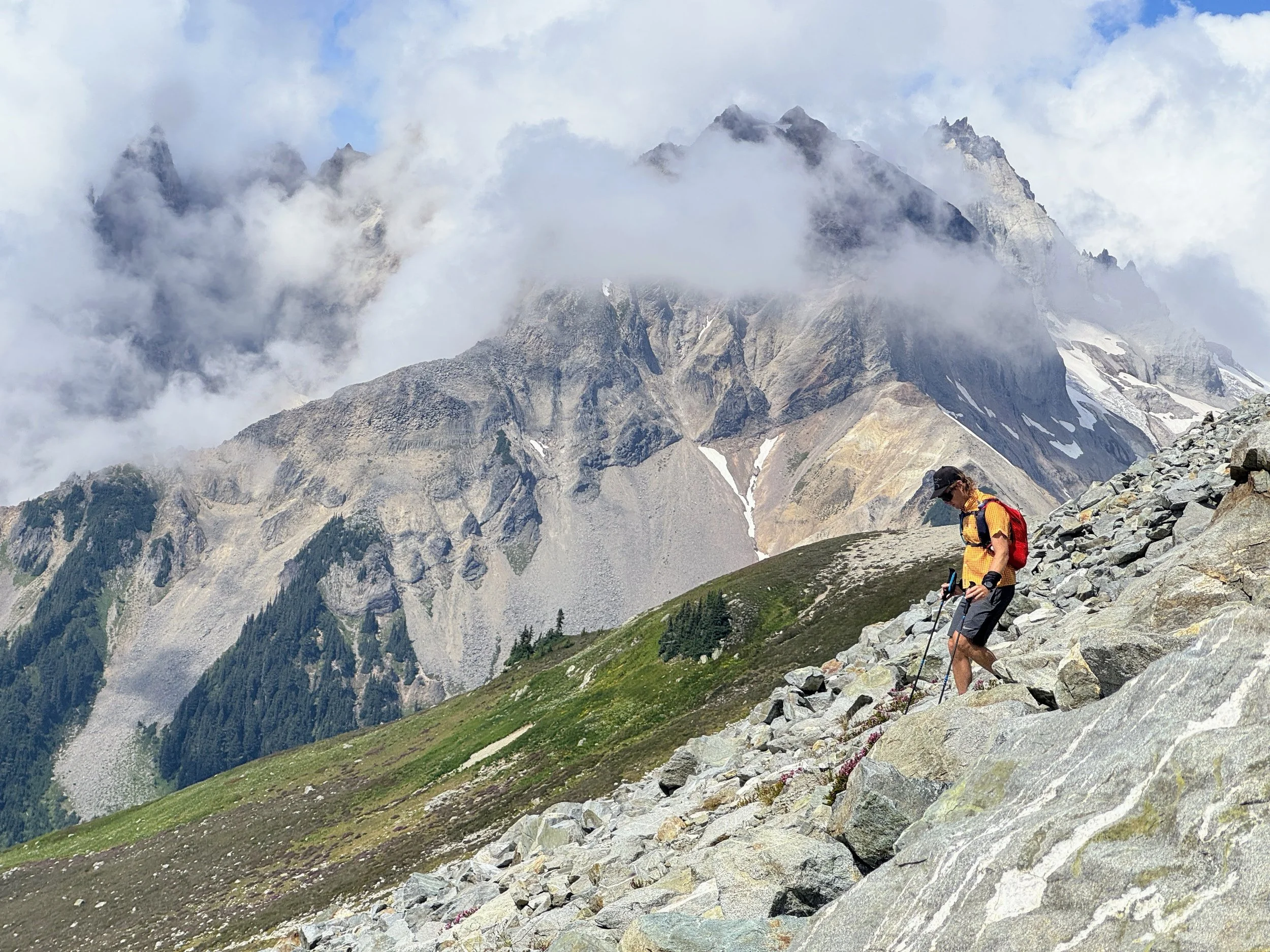
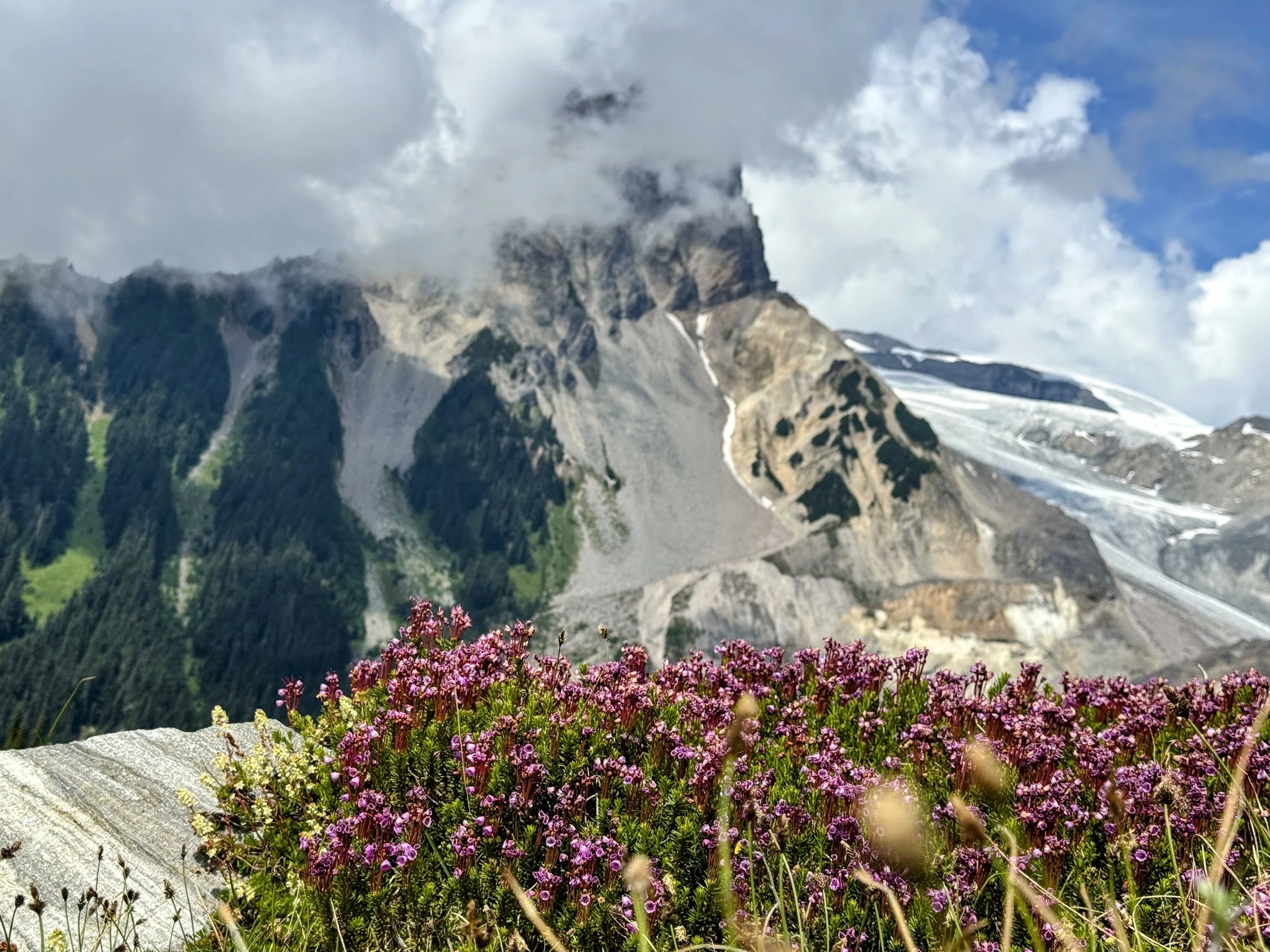
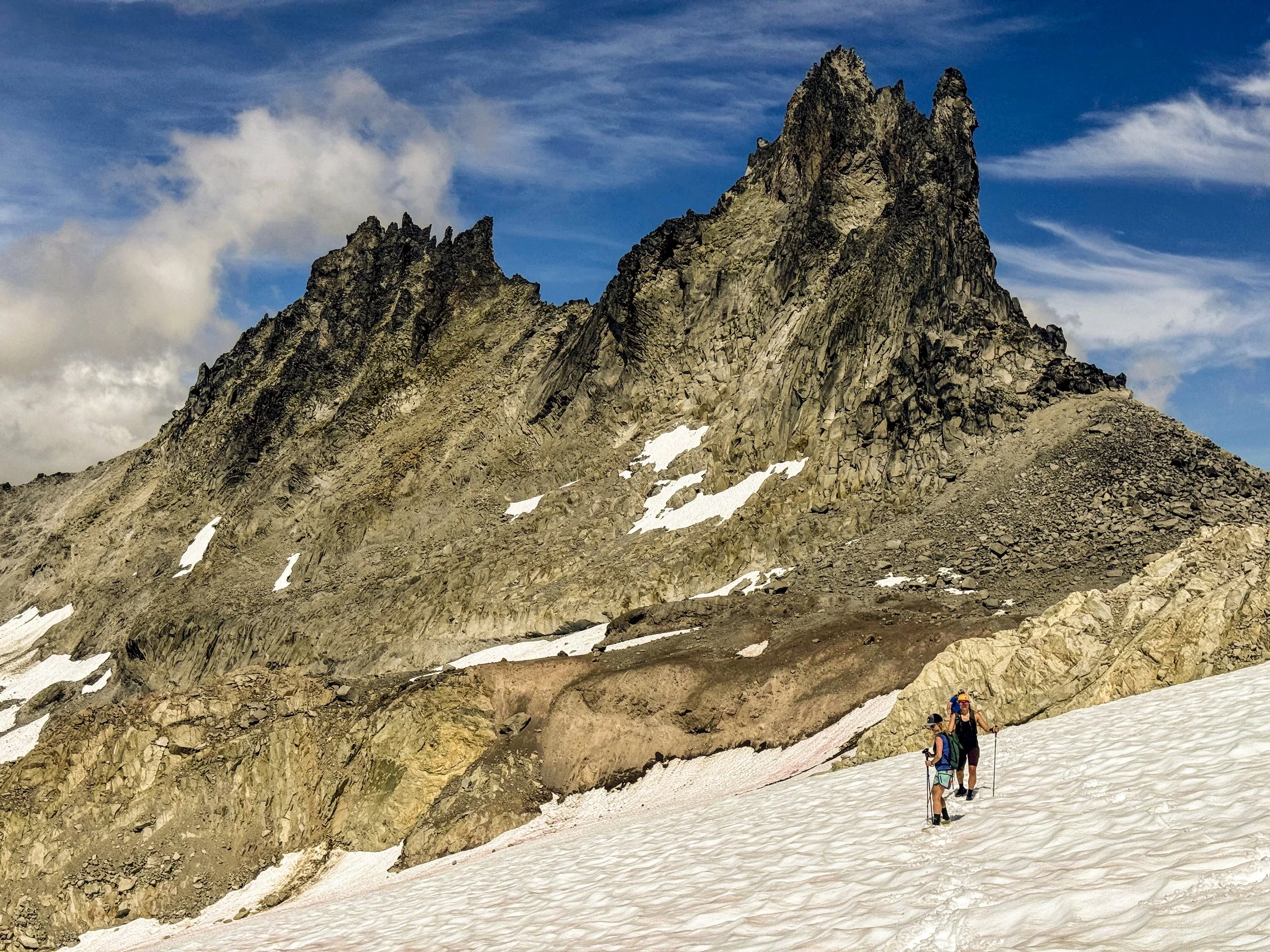



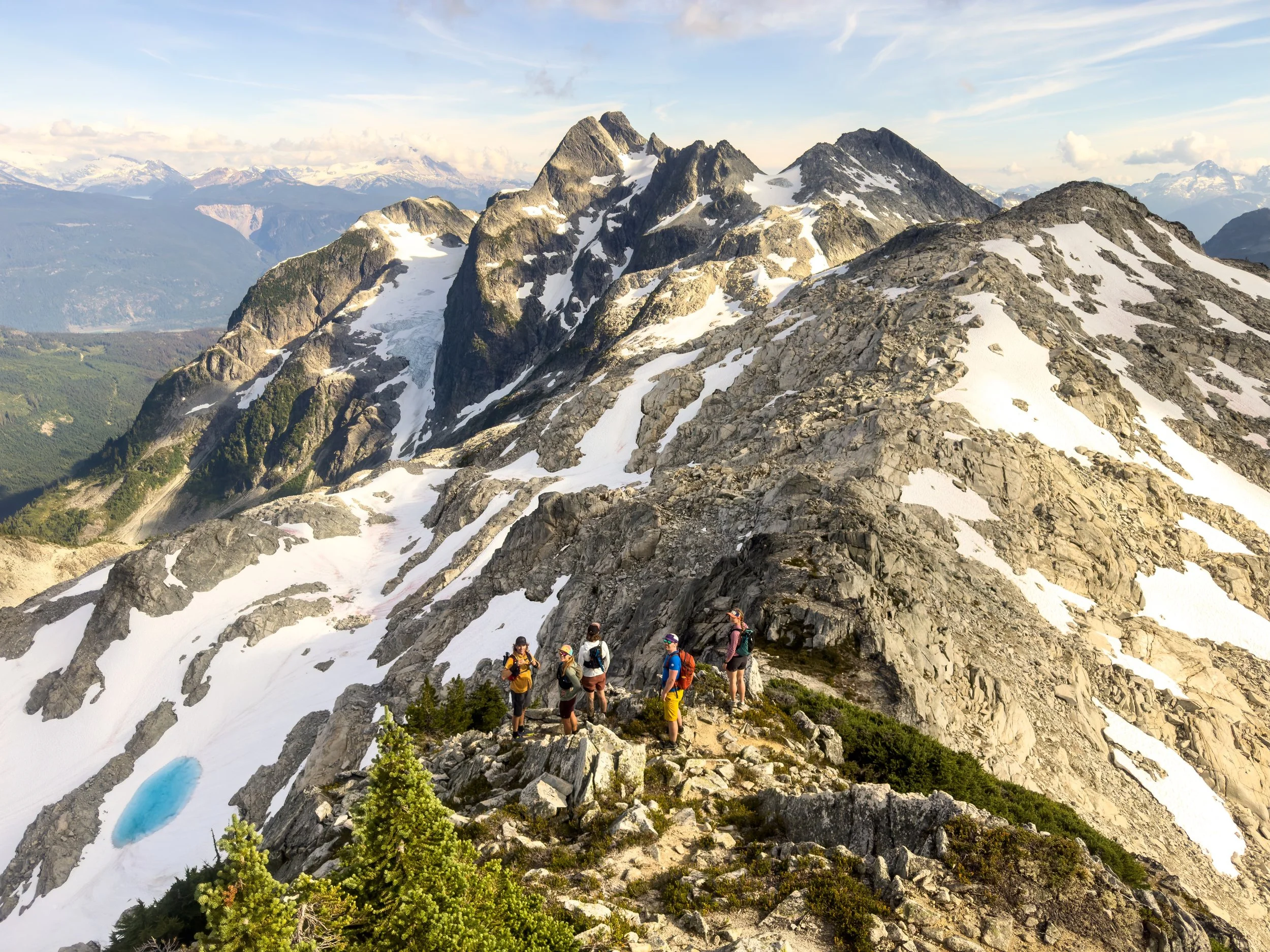
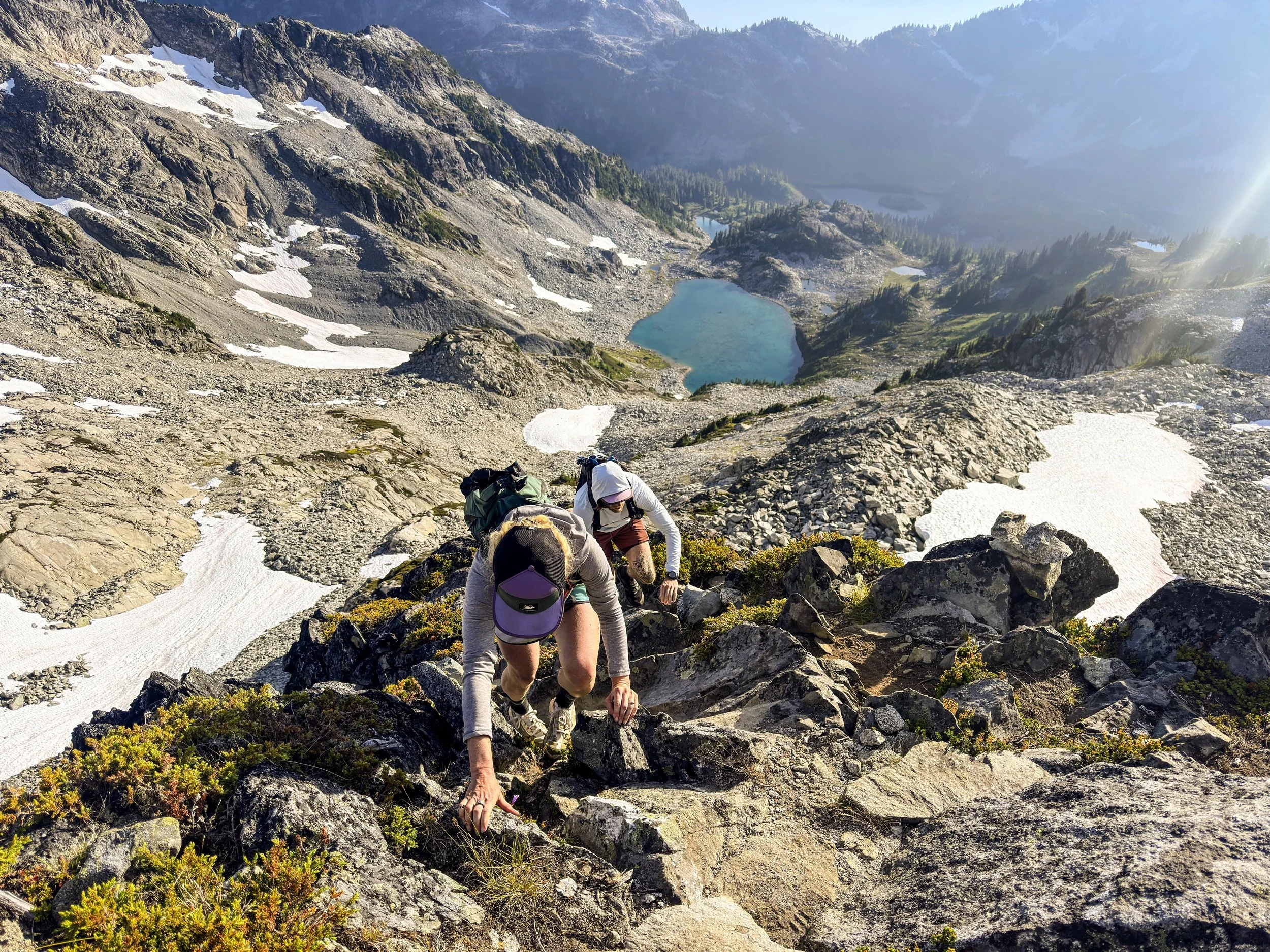

The “fast and light” mentality is justified not only based on the comfiness of the bed involved and quality of pre and post food consumption, but also a hard to describe feeling of travelling far distances through the mountains in the single day. The diversity of the terrain on a route like this is staggering, and moving from lush alpine meadow, to blocky granite summits, to loose gravel volcanic rock, and back again in and out maintains interest and provides rewarding contrast. Another wild feeling is the awe of looking back at the massive route you’ve just undertaken, and the associated feeling of accomplishment.
View of the route back from Tricouni. Cypress is the smaller triangle on the ridge on the left, the two teeth of Fee near the middle, and the far ridge dropping to the right is Brandywine.
Standing atop Tricouni at sunrise, looking North deep in the distance at Brandywine, where we stood only a few hours earlier, was a peak highlight.
Following the shuttle retrieval, it was too late to procure any Dr. Mary Pines approved food (I think if I really begged I could have got Macdonald’s, but the disappointment would have been palpable), so we drove home for protein shakes and an obscene amount of cheese, consumed in a hot bath, before crawling into a comfy bed. A luxury only afforded to the long day trippers!
We’re on the board! For those keeping score at home:
Summer 2025 Bryan and Mary’s Adventure Show Down
Pines Pack: 1
Jones Jog: 1
Mount Marriott
Considering we now live in the age of “AI” and Large Language Models, I really should be faster at posting these… Why should I be intimidated by the idea of writing a blog post, when I don’t even have to actually fucking write it! Fortunately, Zuckerberg has been doing a terrific job reminding me of my motivations for keeping to this format every time I actually jump back on after many months and try to use Facebook/Instagram.
Will keep at it, and maybe experiment a bit with a more light touch writing style with a focus more on a photo gallery.
Anywho, the summer of 2025 was the summer of the ‘pack, where Mary through relentless perseverance, succeeded in convincing me that strapping a 35 pound backpack to an ageing vertebrae atop an imbalanced and chronically tight and injured hip, scrambling off trail on loose ankle destroying talus far from civilizations was a good use of time and physical exertion.
Turns out, we were both right! My hip was not a fan, and it also made for some absolutely incredible adventures only possible through this method of backcountry exploration.
I had drifted deep into the “fast and light” long day trip mode camp, which has grown in popularity amongst trail runners and distance hikers of late. Starting early, finishing late, bookended by a cozy sleep in your own comfy bed, and ideally 2000 calories hot warm food and a frosty beer at an awkward time of the night. But sleeping in the mountains is an experience in and of itself, and provided the bugs aren’t at their worst, it is an experience that provides a level of disconnection from daily life that you just can’t achieve otherwise.
We had planned on an overnight in the Duffey to check out Rohr Peak, which is a popular day trip/trail run from the highway, but we had planned to spend a night at an alpine lake there to add some nice relaxation time as well. But at the trailhead, browsing through the Matt Gunn scrambles book, we made the call to pivot and hike up past the Wendy Thompson Hut to the Marriott Basin, and summit the impressive Mount Marriott, rising 2,735 metres, the highest in the north Duffey Cayoosh Range, and a fun and engaging scramble.
One lesson learned was that objective pivots generally should be made based on gear availability, and we were slightly under gunned for this one, particularly due to the high snow levels from a cooler Spring. We also didn’t have much for GPS tracks as we hadn’t preloaded anything, and so had to put our faith in Squamish city planner/guidebook author Matt Gunn to show us the way.
Our faith ended up being tested a bit on this one!
Wendy Thompson Hut, the location of a few previous winter missions including https://www.cabininthesky.ca/blog/hutlife
Still very much snowy up around 2000 meters above the hut.
A room with a view
Joffre’s North Face which has lost a lot of weight in recent years, and Mount Matier standing tall behind. Jem and I climbed and skied the upper Northwest face of Matier the previous winter https://www.cabininthesky.ca/blog/gs1zyowoc5cm5el8yzlybmy3c36014
#staypuffed Dr. P showing off her full body down tuxedo she loves so very much. Maybe most of the reason she does these trips?
Which way do we go?
Looking up at Matt Gunn’s preferred ascent route. Looking a little snowy and tech!
Mary is not impressed with Matt’s route by this point. A few spicy moves and a bit of snow travel in running shoes kept the nervous system pinned for a bit.
Almost to the top
Phew!
Finally views of the objective. Doesn’t look like an easy Class 3 scramble from here to the top of Mount Marriott, but a good scramble typically doesn’t!
The meat of the scramble up to the summit was super fun and straightforward. A bit of route finding as we tried to ascend too quickly in a few places where staying on a lower traverse was the right move, but generally fun and engaging scrambling right to the broad summit, where incredible views of the area greeted us, with perfect weather for snacks and satisfaction.
Views from the summit. Anderson Lake in the background.
Looking across at Cayoosh, “Million Dollar Couloir” on the lower left.
Back across at Joffre and Matier, and Slalok (right)
Closer view of Matier. The obvious snowy bowl on the upper right is the uber classic NW Face ski from last season
For the descent, we noticed some cairn markers on the North ridge descending down the basin above the hut, and what looked like an easier path down than what we came up, which Mary flatly stated she would not be going down, so we worked our way down benched granite and found a much friendlier route. Be careful fully trusting guide books I guess!
Fun alpine rock, Marriott summit in the back.
Very cool to spend some summer time in an area I’ve spent a lot of time in during the winter (that will end up being a theme for the summer). The hip and back weren’t overly angry by this activity, and the bugs were at a minimum. Maybe this backpacking thing that I had slipped away from a bit from in recent years ain’t so bad after all!
They say a good partner will nudge you out of your comfort zone. Well that was true in both the literal and figurative sense, but well worth the discomfort!
Biking the Balkans pt. 3 - The Dalmatian Coast to Montenegro
“Here! Take keys! Drive car! Go eat!”
This generous offer from our host came as a bit of a surprise to us, as Mladin, the patron of a small farm and guesthouse in central Montenegro, had just watched us greedily gulp down multiple bottles of his vineyard’s “black wine” in short order. We were particularly thirsty and famished after one of our bigger days on the bike, and had found ourselves a long pedal from a place to eat at dinnertime in the rural countryside hills above Lake Shkodra. After asking him if we could buy a charcuterie plate or some bread to soak up some of this rich and delicious wine, our host started to get creative in solving our dilemma, offering up his Audi to drive the 20 minutes to the nearest restaurant. We were exhausted, and had just downed many glasses of wine on an empty stomach, so none of us felt particularly ready to take the wheel, and vocalized this to Mladin.
Sitting across from us in a crisp Adidas tracksuit and tight buzzed haircut, chain smoking cigarettes, enjoying a tall can of Niksik domestic beer, Mladin was the perfect embodiment of the cliche Slavic “dude”. Incredibly friendly and chatty, enthusiastically regaling us with stories of his family’s 150 year ownership of the farm, while simultaneously typing furiously on his phone, apparently making business deals with his contacts in the country’s capital, Podgorica, a few hours away, and our final destination for the trip.
In the end, he decided to drive us to the restaurant, offering to pick us up anytime we were ready. His enthusiastic chatter continued for the entire car ride, explaining that the Lake provides the best tasting carp in the world, while simultaneously continuing a constant flurry of one handed typing away on his phone, seemingly not actually paying attention to the single lane winding road he seemed to be treating as a rally car raceway.
Was it terrifying? Of course.
Was it a memorable cultural experience? Absolutely
Is there such thing as good tasting carp? I’m doubtful
Sadly it was a rare miss on the food front, which was especially hard for poor Zac who was on the tail end of a stomach bug that messed him up pretty good for our Montenegro leg, but the overall experience was a memorable one. Montenegro was our final country on the Balkan bike journey, which gave us the best local cultural experiences of our trip.
Following our train misadventure in Croatia, Mary and I arrived in Split to connect with Zac “Honk” Holden and my parents for a few days of rest and chill on the bougie island of Hvar, famous for its beautiful beaches, lavender fields, historic sights, as well as a destination for the mega wealthy and their mega yachts. The restored historic centres and hilltop forts make for great exploration, and the quiet island roads are ideal for cycling to the many excellent restaurants and wineries.
Success with a Croatian ferry! On our way to Hvar from Split
We spent a night in the beautifully maintained old town of Split, containing the Diocletian's “Palace”, a walled fortress/massive retirement home for the 3rd century Roman emperor Diocletian. By this point of the trip, we had really figured out the routine of:
1) Look at very old things
2) Eat ice cream
3) Drink local wine
4) Repeat 1-3 until ready to fall asleep
Zac had joined us by this point, and we synced up with my parents for a few sites and sounds, before we got on a ferry to the Dalmatian island of Hvar.
Hvar Town
Hvar well lived up to its reputation: It was beautiful. It was great for biking. It had some realllllly big private yachts.
Fortunately although it was the most expensive spot on the trip, considering the obvious clientele, it wasn’t too overpriced, and we had some quality seafood meals. We had a great time riding bikes across the island to Stari Grad, for, you guessed it, looking at old things and eating ice cream, and visiting a nice farmstead for afternoon wine and charcuterie.
After a few days relaxing and resting the legs, we were ready to continue our journey south. We packed the bikes up and rolled out to the Hvar ferry to Dubrovnik, which fortunately was more reliable than previous Croatian ferry lines, and after a scenic cruise we were debarking in the city now most famous currently for the filming of Game of Throne’s Kings Landing. We were told it was very touristy, and by this point we didn’t really need to go out of our way to see another old walled city, so we pedalled through town towards our next and final country of this itinerary, Montenegro.
Dubrovnik
Bay of Kotor, Montenegro
The ride started out pretty miserable on the busy highway south of Dubrovnik, but after lunch, we were rolling through beautiful Croatian wine country on empty back roads, before descending down towards the Montenegro border at the entrance to the Bay of Kotor. This stunning inlet provides a safe anchorage and popular cruise ship destination, and is flanked by various different holiday destinations around the perimeter. We slowly wove our way through a busy seawall that traversed many hotels restaurants and beaches, and had a decent dinner on the ocean. We found a hotel room above a bar, and drank radlers on the patio consuming significant second hand smoke from the super friendly gay chainsmoking host who was drinking much harder than we were, with a playlist of exactly three pop-house tracks playing on repeat.
At this point I had to look it up, cause it was definitely a noticeable cultural phenomenon: by one study, the AVERAGE per capita adult consumption of cigarettes in Montenegro is 18 a day. We were not surprised!
The cost of food and drink dropped when we crossed the border, but so did the quality. This was to affect poor Zachy especially hard the next day…
We rolled out of the west bay of Kotor in the morning, anticipating a big day. We had the biggest climb of the trip ahead of us: the incredible “Serpentine” road climbing from sea level to 1200meters over 16 switchbacks above the bay. We enjoyed seaside riding for the morning winding around the bay, including a ferry to cross to the east bay. By the time we were ready to stop for lunch, Mary and I knew something was up with Zach. He was riding super slow, and looking pretty rough, and wasn’t able to get down any of his lunch. It was seeming like he had some sort of food poisoning or similar gastro issue, so we started to put together and alternate plan.
Zac laid on the ground in visible pain beside the lake while Mary found us some accommodation so Zac could recover. We were just outside the town of Kotor, which had a beautiful old town centre to explore, so she booked there, and we rolled over to check in in the early afternoon.
What we didn’t realize was that we didn’t book a full rental, but a room inside a tiny family home in the old town connected to a cat museum to celebrate the famed street cats of Kotor. So we have to get poor Zac into this rental, which was run by the most adorable, and most Eastern European, elderly woman imaginable, who spoke precisely zero English. She came at us strong with individual cake and offerings of tea, trying to get Zac to eat her cake, and not quite understanding that this wasn’t a time of indulgence for him. We awkwardly shuffled a near catatonic Zac into the room and put him to bed, and in broken language and Google Translate, managed to communicate the situation to this very generous, kind, and enthusiastic lady.
We thanked her, and Mary and I set off to explore the town. Meanwhile, she immediately went into full mother mode, assembling a care package for Zac. Without asking or knocking, she brought it straight into his room—tea, biscuits, and medicine arranged on a tray covered with cat photos. All the while, likely chatting away to a semi-conscious Zac, who was curled up in the fetal position on the tiny bed, unable to understand a word she said.
A fairly comical situation, and one I’m glad to have been the observer on and not the receiver. Mary and I had a great time exploring Kotor, which does indeed have a fucking insane amount of street cats along with feeding stations and little wood houses for them. The town was beautiful, and we enjoyed one of the best Italian meals of the trip in a beautiful basement bistro, and hiked up above town to explore the ancient fortifications protecting the 1000+ year old Byzantine village.
Almost felt guilty enjoying one of the better meals of the trip while Zac struggled to exist in the care of a tiny Montenegrin “Babushka” cat lady.
The next morning we awoke to a slightly recovered Zac, and a hard talk about plans for the day. We needed to keep moving, but we were directly at the foot of a monster climb on the bikes. Zac could have taken the easy route and chucked his bike in a taxi, but he chose the path of pain and suffering like a good lad, and crawled his way up above the bay with not a single word of complaint.
For Mary and I, the slightly slower pace, and the terrific lower grade of the 16 switchbacks actually made the pedal fairly benign. It helps to have such incredible views at every turn, and the end of 3 weeks of daily cycling for your fitness baseline. We were still very stoked to be at the top for celebratory beers and snacks.
A rare smile from the poor lad
Getting higher!
Stunning views of the Bay of Kotor. Old town of Kotor just below us on the right next to the docked cruise ship. The night before that we stayed at the very top left of the photo in the distant bay.
Ziveli!
The broken man
Mary doing her best to motivate
Now in the Montenegrin high country, we pedalled through beautiful countryside, with the destination of Lake Skadar for the night, before our final roll into Podgorica. We managed to find a source of protein in a small town on our ride, with a typical slavic spread of meat and bread and French fries and more meat.
Misty river draining into Lake Skadar
Carafe number 2 of the Rustic Village Rijeka’s black wine, where our host Mladen told great stories about his multi-generational farm, and how delicious the local carp is, before giving us an exciting rally car-esque ride to dinner on a single lane country road while texting and telling stories all at the same time. Zac made the poor choice of attempting to validate the carp claim, which did not vibe with his current digestion issues. But many laughs were had, and the spirit of the tracksuit wearing quintessentially Slavic Mladen will live on with us for the rest of our lives.
Photos from Mladen’s farm.
Lake Skadar
The final leg of the trip was ahead of us the next morning, with a very pleasant ride along the lakeside of massive Skadar, the largest lake in Southern Europe. We decided to go easy on the still recovering Zac, and use that as an excuse to skip the final urban bike ride through the rougher city of Podgorica, Montenergo’s capital, and the final destination of our Eastern European cycle. Through some conversations with Mladen and some google investigation, there was a lakeside town that hosts a train station that runs daily trains to downtown Podgorica. So we just had a very hilly, but very beautiful 45km lakeside pedal to the town for lunch, and a train right into the heart of Podgorica where we would stay before our departing flights the next day.
We still had some work to do to get our bikes boxed up for the return, but I had coordinated with the bike shop before the trip so we knew where to go. We got our bikes sorted, found a brewery to celebrate, and then took a still recovering Zac to our Airbnb to crash while Mary and I did some exploration of the city, which had a lovely riverside park and an old town district with a mix of old Catholic orthodox churches, and some very cool street art.
On the one hand, it felt nice to have the bikes packed up and moving on from the daily logistical challenges that a bike tour like this can bring. But we were not ready to finish, and it felt like I could have continued this type of lifestyle indefinitely. The experience of exploring a new environment at the meandering pace of a bicycle was incredibly rewarding. We had great food, shared laughter with strangers, and soaked in landscapes that would have blurred past from a car window. The slow pace of bike touring transformed every day into a series of small discoveries—whether it was Mimosa’s great bakery in tiny Most Na Soci, Slovenian, stumbling upon a farmstay with great wine and the cacophony of a huge Italian family celebrating a birthday at dinner, or exploring millennia old walled townsites like hilltop Motovun or seaside Piran, steeped in ancient history.
Slovenia, in particular, was a revelation. Its emerald rivers, snow capped mountains, and meticulously preserved towns like Ljubljana and Piran made every kilometer spectacular. The food was fresh terrific, with a beautiful blend of Italian and Slavic tastes, alongside incredible bakeries. Enjoying the delicious local wines daily after our rides was a great way to celebrate the day’s accomplishments.
.Of course, not everything went according to plan. When our ferry connection in Pula was cancelled, we found ourselves rerouting through northern Croatia by train - a detour that cost us a day and forced us to rethink our schedule. But these missteps became part of the adventure. Piecing together a new route, and rolling with the unexpected was a good challenge, and it reminded us that flexibility is just as important as determination on a trip like this.
Meeting up with my parents on Hvar was another highlight. Sharing the joy of bike touring with them in such a stunning place was unforgettable, particularly a stop at a farmstead winery for a leisurely charcuterie lunch. Sitting together, savoring fresh bread and local cured meats with a glass of wine, perfectly captured the simple pleasures that make bike touring so rewarding.
As a final bonus, Mary and I had scheduled a four-day layover in Istanbul on our way home. With our bikes boxed up, we flew to Istanbul, left the boxes at airport storage, and set out to explore one more unique, fascinating, and ancient city before returning home.
Biking the Balkans pt. 2 - Istria
It was now time to descend out of the mountains to begin the seaside part of the journey. The pedal down the Soca River valley was the definition of tranquility, winding down a variety of gravel country roads and a riverside paved bike path. Hard to imagine this region as the scene of sustained trench warfare as the Italian Eastern front in WW1 against the Austro-Hungarian forces. Proud signs of Austro-Hungarian resistance dotted the trail network; interesting to gain a perspective of the “other side” of that (especially) pointless war.
One interesting historical note I wasn’t aware of was Italy’s involvement in WW1 and the ramifications for its role in WW2. The Italians were initially eager to remain neutral, but pressure from England to join on the side of the Allies included promises of significant land annexations across the Adriatic to reclaim what Italy felt should belong as part of their Republic. The Italians took heavy casualties fighting along the Eastern Front in very challenging conditions in the same rugged mountains we explored, enduring brutal winters moving through the high passes. Eventually succeeding along with the rest of the Allies, Britain, through pressure from America, reneged on much of the promises, with only Trieste and the surrounding area ending up under Italian sovereignty. The US wanted to break up the large empires they saw were the catalyst for the war, and saw the Italian control of these lands as counter to that strategy.
If the scope of the original land promises were kept, almost our entire trip would have been through in Italy, including all of Istria and Dalmatia south to Dubrovnik.
The long term consequence of this was the infuriating of the Italians, and likely contributed significantly to the rise of Facism in the country, the rule of Mussolini, and their role in the Second World War.
Soca River bike path
We did not have much of a set itinerary for this trip, and so as we crossed over a Slovenian-Italian border for the 5th, but not final, time this trip, we discussed a plan over lunch to check out the farming region north of Trieste instead of heading into the city itself, and stay In one of their agritourism towns at a farmstay. The place was adorable, served cool red wine from the tap for 1 euro a glass, amazing local food, and we enjoyed a noisy local experience at dinner surrounded by a massive family (including their dogs) celebrating a birthday, immersed in a cacophony of exuberant Italian energy.
Next was a smorgasbord of rich history, visiting the city of Trieste and Muggia at the Eastern end of Italy, then rolling onto the 123km Parenzana Trail, a historic rail line operating from 1902-1935, recently converted to a bike trail. We spent a memorable night in perfect seaside Piran back in our final pop into Slovenia, and then on and up into Istrian hill country and Croatian wine region. We stayed in a nice guest house down the hill from the incredible town of Motovun, and enjoyed delicious and cheap vina Rossa from the local winery. Finally, we headed to the south end of Istria and the city of Pula, a historic marvel boasting thousands of years of sites and stories.
Sanctioned Roman Abramovich's seized $800 million super yacht, anchored outside Trieste..
Trieste
Caffè San Marco - Famous cafe in Trieste, complete with these super cool copper espresso machines.
Parenzana Trail
Izola
Pretty farmland on the Parenzana to Piran
Piran
Mary's "meal of the trip". After a long grind on the bike that day, only a piece of cake for lunch at Caffe San Marco in Trieste, and being our first night on the coast, she was ready for a big seafood feast. Pirat Piran restaurant delivered the goods.
Piran
Piran
Piran
Piran
The rich and complex history of various cultures that habituated these lands is fascinating to read about and experience. The Romans, Greeks, Celtics, Venetians, Ottomans, as well as countless smaller sub-groups and modern slavic cultures were present in these areas, and all left their mark.
Heading inland towards Motovun
Groznjan
Hilltop Motovun, in central Istria, originally a Celtic settlement, before a long history as a Byzantine and then Venetian strategic fortress and stronghold
Parenzana Rail Trail
We were definitely stoked to visit the "World Truffle Center"
Motovun
Roman Arch dating back to the 2nd century AD, a few feet away from our hotel balcony in Pula
Pula has such a rich and fascinating history that many pages of writing would not adequately cover it. Looking at its location on a map, near the southern tip of Istrian jutting out into the Adriatic, its strategic importance is obvious. The Romans has the most obvious impact in its archaeological wonders, seeing significant development at the time of Julius Caesar, but was destroyed when it sided on the wrong end of the subsequent civil war after Caesar’s legendary assassination. Rebuilt on the request of victor and now current Caesar Octavian’s daughter Julia, it then changed hands many times after the fall of the Western Roman Empire.
As someone who has not visited the classic European archaeological sites, and from a place where a century old building is considered “historical”, this small seaside city was fascinating.
One of six major Roman coliseums in the world resides in Pula, Croatia
This took us to the end of our Istrian adventure, the beginning of our train misadventure, and our group expanding to explore Dalmatia and Montenegro.
The 15 euro "Croatian Meat Platter for 2"
Biking the Balkans pt. 1 - Northern Slovenia
As I sit on a slow train chugging south towards Split, on the Dalmatian coast of Croatia, I gaze out the window at the rolling hills and farmland passing by, savouring a celebratory breakfast Crni Lemon Radler, reflecting on the Stoics. After 30 hours and numerous logistical challenges, Mary and I have managed to navigate the final leg of our unplanned re-route following the cancellation of our ferry from Pula to Zadar. Word was that it was unlikely to sail again that week due to stormy weather. The culprit behind the disruption was storm "Boris," which has brought heavy rains and snow across Europe, causing widespread flooding across the continent. We're in the midst of a bike tour that spans from Ljubljana, Slovenia to Montenegro, exploring the stunning Julian Alps, the history seeped Istrian Peninsula, the Dalmatian Coast, and the breathtaking Kotor and Lake Skadar region of Montenegro. As mine and Mary’s first proper bike tour, our journey so far has more than adequately confirmed that this mode of transport is indeed an incredibly enjoyable way to travel; a pace conducive to immersing oneself in the sights and sounds of an exciting new region.
However, over the past day and a half, we've learned that cycle touring can introduce its own challenges to travel.
Croatia's transportation network has a mixed policy on bike travel, leaving it up to the discretion of drivers and ticketing staff to decide whether to allow bicycles on board, even when it seems there is plenty of available space. This unpredictability has introduced our first significant logistical challenge to our adventure.
We took a major backtrack north from Pula via train back near the Slovenian border and then east on a bus to the city of Rijeka, where our confidence was reasonably high after watching a pair of Germans and their bikes get on the southbound bus to Split that we were aiming for. The driver capped it at their 2 bikes, and we were told to wait for the next one. 2 buses, and 2 aggressive denials later, our confidence was weakened, and we had to make a tricky choice between continuing to try this discretionary bus option, or head over to the last southbound train option, where we had heard mixed reports of success with two wheels.
We have some pressure to get south reasonably quickly, as Hollywood “Honk” Holden (otherwise known by his Christian name, Zac) has just arrived and expecting us south on the Dalmatian Coast. We are also connecting with my parents, and have a place booked in a few days time on Hvar to explore the southern islands together.
In the end, we gambled on the train, where we had success loading the first leg, delivering us to a very remote rural station even further from our destination for the transfer south. The moment of truth arrives with our last connecting train rolling into the station, and just as we’re loading our bikes in, an impressively towering, and equally stern female ticket collector storms over and yells in a heavy Eastern European accent, “no room! no bicycle!”. We protest and begged as she hopped back aboard, but within seconds the 1/2 empty train was accelerating off into the setting Croatian sun.
Well, fuck…
We assessed our surroundings. Surprisingly, for a major transfer point connecting the Istrian west and south Croatia, the train station was completely isolated in rural farmland. A look at the map showed that we were a 15 minute pedal to the nearest town. The train station attendant spoke precisely zero English, though liberal use of Google Translate allowed us to glean that he has seen this before, and previously, people have disassembled their bikes, placing them in large garbage bags to make them into “luggage”, and bring them on board. Not a guarantee, but worth trying.
The next train was the following morning, and it was getting dark, so it was time to try to find some large garbage bags and a place to stay, and hope we make it on tomorrow, as our options were rather limited here in, as Mary eloquently put it, “the middle of Croatian buttfuck nowhere”.
That’s when the negative thoughts creep in: “Why the fuck did I plan a route that was so dependent on this damn ferry?” “Why didn’t we just stay in the city and wait for the eventual bus ride?” “Why didn’t we pack the bikes up better in the first place for the train?”
Time for a deep breath, a reminder to focus on the present, and embrace this new challenge, instead of sliding into frustration and self-criticism of past actions that cannot be altered. A key component of numerous philosophical teachings, including the Stoics, that I’ve been working on adhering to more in daily life, to combat instinctive tendencies. In hindsight, it seems insane how we can treat ourselves sometimes in the face of ‘not-at-all-adversity”.
An hour later, we were checked into a quaint country home (60 euros for an entire house), heading off through pleasant countryside passing cute farmstands to a quirky grocery store and restaurant for supplies and an enormous local “mixed meat platter for 2” (that could have fed 4) for 15 euros with tall brews to wash it down, reflecting on how incredible the previous week had been.
For me, these elements are inevitable and essential to the joys of travel: the creation of lasting memories, testing patience, navigating logistical challenges, and imbibing just the right amount of high-value domestic beer and wine to soothe the nerves.
To celebrate a significant-yet-meaningless milestone in aging, I wanted to plan a Europe cycling trip around my 40th birthday, which is a pretty classic activity for aging adventurous folk. Mary and I being foodies, the idea of biking up and down pleasant hills all day, providing the caloric motivation to stuff ourselves with local grub at every chance is a recipe for a great time.
If your idea is to “go biking in Europe where they have good food and drink”, you’re going to be presented with a lot of options. The bike culture in Europe is incredible, and there are countless classic routes well beyond the main Eurovelo list that I had first discovered many years ago. I was keen to build a trip that included some more remote mountains and big pedals, as well as warm coastal Mediterranean time where I could extend the invite out to friends and family. Through enough online research, I landed on this loose route which seemed to tick all the boxes.
Our trip began in the capital of Slovenia, Ljubjlana, which is a wonderful city, small for a European capital at only ~500,000 people, with a beautiful downtown river promenade complete with cute restaurant patios, cobbled pedestrian streets, and a hilltop castle resting like a crown above the historical city centre.
After a lovely day in Ljubljana, due to some significant weather approaching with Boris rolling across the continent, we had to push through some jetlag to kick off the pedalling with a big 100km day. The riding was so good that it was easy to find the energy, and we had an awesome intro day riding out of the city exploring the Slovenian countryside.
Hilltop castle outside Ljubljana
Gotta put those 41mm gravel tires to good use!
After getting some bad beta for a gravel "trail" on our mapping app, Komoot, leading to an adventurous forest hike-a-bike, we were overdue for a refreshments stop by the time we rolled through the small town of Radovljica, just outside Bled.
Mary's first of a near-daily strudel habit for the trip
Chocolate shop in Radovljica
Rolling along Lake Bled and its iconic island monastery in the mid afternoon, Mary contemplated a swim but we decided to keep rolling and enjoyed a beautiful cycle up along the edge of the towering peaks of Travnig National Park.
Incredible section of road riding after Lake Bled, dipping into Triglav National Park
Celebrating at the top of our last steep climb of the day!
Descending back down into the lower valley, in time for dinner, followed by a mad dash to get to our destination before dark.
First Day Riding Highlights
Following a damp rest day in the ski town of Kranjska Gora waiting for the meat of the storm to roll through, we stuffed ourselves with the extensive buffet breakfast at the Kranjska Hotel, packed our bags, and adorned all of our cloths and raingear, as it was still drizzling outside. Observing the snowline only a few hundred meters in elevation above us, we felt good about the decision to reroute through a lower pass at 1200m in Italy, instead of the straight up and over 1650m Vrsic Pass that would be in full winter mode.
Achieving peak dork
Fortunately, as soon as we hit the road the rain stopped and the skies began to slowly clear. We enjoyed beautiful pathway riding alongside the Julian alps and Triglav, and our first jump over to Italy.
Our first of 5 times we crossed the Slovenian/Italian border. The Euro zone is pretty cool!
Incredible views heading south from Tarvisio, Italy
This region was absolutely stunning, with quaint farms dotting deep mountain valleys, ancient aquifers connecting mountain streams to mills. Heading south from the town of Tarvisio climbing up into the mountains, we passed an old mining town before ascending an old dirt road with beautiful views of the lake below, back up to an old WW1 post at the top of the pass and the Slovenian border.
Ascending back up to the Slovenian border
Getting closer to the top!
Austro-Hungarian WW1 Bunker at the pass
From there we were treated to an incredible 1000m descent through the mountains with snowy peaks towering above us.
We stopped for a pastry and microbrew in Bovec, where Mary didn’t pay attention to the ABV in her order, and, instead of 2 “tasters”, somehow ordered a regular sized and strength pale ale AND a large full pint 9.2% malty face smash “pancake breakfast”….
Following the inevitability of me taking it on myself to correct Mary’s mistake, we rolled out to explore some gravel on the river Soca feeling a bit wobbly. Just in time to leave pavement and bounce down varying degrees of gravel rowdiness, including a wet walk across a flooded river.
River Soca
Beautiful gravel section along the River Soca
More beautiful road riding through pleasant countryside took us to Most Na Soci, a quaint little town on a wider part of the Soca, more like a lake. We stuffed ourselves with an epic pizza dinner (1: burata, ham, with pistachio sauce and 2: truffle porcini and procuitto. Sploosh) and then Mary got her custard fix at the great bakery attached to our hotel (Happy Rooms). The matron, Mimosa, was adorable, and extremely proud of herself reverse engineering this custard treat recipe they were importing from out of town, finally gaining her husband’s approval after numerous attempts.
The perfect post ride dinner: local wine, pizza, accompanied by a giant bottle of olive oil and various vinegars
I learned about Mary's love of custard treats tonight. In her happy place!
Lovely Mimosa (sp?) in her bakery and guest house
It felt as though we could easily spend the entire trip in the Slovenian mountains, but the next day we continue down the Soca out of the Slovenian mountains to the Mediterranean.
The Tantalus Traverse
Slipping through the final weeks of my 30s, recently I’ve spent a fair bit of time considering the past decade, including the many challenges, obstacles, and successes that defined this period of my life. Reflecting on the lowest lows alongside the highest highs, and everything in between, it's easy to draw parallels between the great challenge of life and climbing. Success requires significant effort in building skills and gaining knowledge, as well as a willingness to take risks; without risk-taking, you never get off the ground.
Matching capabilities and risk taking, pushing yourself towards the next goal or objective, can be a very tenuous bridge, often leading to hard lessons learned along the way. I’ve learned many a hard lesson in climbing, and this really describes my general path through life as well. Progressing skills, taking risks, working hard to accept failures, learning from mistakes, reveling in success.
2024 has seen a few major tick list successes, the latest of which was an incredible trip across the Squamish River to complete the Tantalus Traverse. The pinnacle of this southwest BC classic is composed of the incredible ridge line above the wild glaciated terrain of the Rumbling Glacier that every driver to and from Whistler ogles as they drive by and gazes west. The route has numerous technical challenges, requiring extended time spent in exposed terrain, providing a significant mental challenge as well as a physical one. Though the climbing never jumps above what most climbers would consider 4th class (no rope needed for safe travel), steep loose choss, crevassed snow slopes, and exposed-yet-easy moves on quality alpine granite keeps your focus for many hours, as making a mistake at any point would be highly consequential.
I had a very narrow window to sync up with Jem “Moat Daddy” Morrison to make this happen following a work trip, and we needed an early start to squeeze this into two days. After flight delays, a midnight packing job, and a few hours sleep, I met Jem at 530am at the Watershed pub to drop a vehicle to tackle this new challenge.
The ideal window in the summer comes when the snow has retreated from the upper ridge, but before significant melt increases the size of the many glacial “moats” along the route. This incurs an additional challenge getting on and off the glaciers, as the yawning mouth of the moat opens, wanting to swallow you up into the depths of the mountain.
The full traverse typically starts on a trail ascending from the Squamish Valley at Sigurd Creek, and climbs a sizable 2100 meters up and over a col just east of Mount Pelion. Once you leave a marked trail heading up towards Mt. Ossa, the routefinding begins, as there is essentially no markers and minimal sign of a “trail” until you descend towards Lake Lovely Water at the opposite end of the traverse. There seems to be some intention with the complete lack of sparse flagging tape or a cairn markers on this reasonably well utilized route, as these beacons are a controversial practice counter to the hardcore “leave no trace” mentality, with the expectation being that parties should be capable of route finding on their own.
Jem had done the route previously, and with that knowledge and the magic of modern GPS phone maps, we did not have any issues on our journey.
The South Tantalus Range, from the Sea to Sky Highway
Sigurd Falls
We quickly discovered my new filter had a small hole in it. Jem here is experimenting with different blocking techniques.
Ascending Pelion
For gear, we tried to keep things as light as possible for a basic overnight, and so the tent was left at home in favor of a minimal bivy setup with sleeping bag, pad, and a small tarp. Climbing gear included 4 mid-sized BD Camelots, standard climbing setup of a harness, belay device, double length alpine slings, a Petzl microtraxion for recovery, and an unneeded ice screw and snow picket. A small stove for cooking a basic meal and melting snow, and other typical essentials.
The equipment fail of the trip was a spillover from an awesome trip I did with Mary the week before up in the Tolkien group, on a shiny new pair of ArcTeryx Vertex shoes, which on paper and in practice seem to be exactly the shoe I’ve been looking for as a mix of a hiker and a light climbing capable “approach shoe”, but unfortunately gave me savage blisters which made a lot of this trip super painful…
Based on the objective, and the work required to keep up with Jem, I opted to leave the bigger camera at home, so these are all iPhone shots, and I’m pretty happy with the results. Low light capabilities and a telephoto option were missed, but overall I think the quality is acceptable considering it is no extra weight!
Flowers on the slopes of Pelion
Low angle snow slope on the final push to the top of Pelion
Overview of the ascent route, following the Zenith/Tantalus Ridgeline, with Mount Tanatalus at the end.
Closer shot on the Zenith ridge with the glacier crux
After grinding hard for 3 hours up from essentially sea level to 2100 metres at the Pelion Col, you are rewarded with a massive stoke boost taking in the breathtaking view of the route ahead. From a distance, the gnar level definitely looks high! Nerves and excitement start to pulse deeply through the veins, and a jolt of energy washes over tired legs.
This is why we’re here!
At the first technical crux: a traverse across a crevassed snow slope to a steep loose rock gully to gain the ridge. Nothing steep or difficult necessitating ropes, but from here on the mental game starts, where careful footwork and controlled movement is required to stay on your feet above consequential terrain.
Descending down on the far side of the previous climb onto the next snow slope, where you ascend high to the left to finally gain the proper Tantalus Ridgeline
At this point, the weather played into the mental game, with distant pockets of thundershowers to both the East and West. The lighting was beautiful, but immediately became aware of our exposed position on the ridge if a storm rolled through.
We were about to receive another warning shortly…
Arriving at the “pièce de résistance” of the journey: kilometers of beautiful solid alpine granite scrambling leading towards Tantalus summit
As soon as we started moving across the ridge, I noticed a strange sound coming from my backpack. After a few moments of adjusting my pack to determine its source, I realized it was an audible “buzz” from my ice axe when facing upright! Above us was some light clouds, with a few thunderclouds looming in the distance, and so the electrostatic force in the air must have been enough to cause a reaction in the exposed metal of the axe. Jem confirmed the same, and so we very quickly retreated to better cover at a rocky pinnacle at the start of the ridge.
We assessed the weather situation, and it was clear that we were fortunate to be in a good spot with no significant weather moving in our direction. The forecast showed a clearing trend, so it felt like this was a “wait and see” situation, and be ready to move if conditions worsened.
Ominous thunderstorms surrounding your exposed position on an alpine ridge? A perfect opportunity for Moat Daddy to provide a little spark himself with a stylish costume change!
Also a good opportunity to take in the absolutely wild and appropriately named “Rumbling Glacier”. We were treated to numerous enormous serac falls, where house sized chunks of ice and snow crashed down the glacier in spectacular display.
Very happy that the modern route we were on did not take us anywhere near this angry maelstrom. The first ascent in 1911 required a boat ride to Squamish from Vancouver, followed by a long bushwhack straight up to the base of this splintered maze of ice and overhead hazard. Crawling their way upwards with the heavy expedition gear of the day in this terrain must have been exciting indeed.
Fortunately, our assessment of the forecast and the moving weather was correct, and so once the weather cleared after an hour of rest around 5pm, we decided to keep moving on to get as far on the ridge as possible today. With the questionable weather and the delay, our stretch goal to summit and navigate the challenging descent of Tantalus on Day 1 would have pushed the safety margins too close..
Beautiful late day lighting amongst the clouds
Rainclouds in the distance, but signs of lightning had abated, so we felt confident setting up our basic bivy and cooked dinner. After much deliberation we decided that the threat of rain dictated that we abandon this beautiful wind sheltered camp spot in favor of an adjacent rocky location where we could string up the tarp in case of rain.
The 3 hours of sleep the night before and 12 hours + 3100 metres of climbing that day meant that despite our exposed quarters, I slept solidly, even as Jem stumbled around in the middle of the night removing the noisy flapping tarp inches from my face after peeking out in the middle of the night to a clear sky of stars.
Sunrise above Garibaldi Provincial Park
The next morning we were immediately met with our next challenge from our camp, with two options available:
Walk down lower on the glacier and make an awkward snow and ice mantle above a 10 metre deep moat
Find the reported rappel anchors and descend to a section where the obvious existing tracks on the glacier meet a much easier climb onto the snow
#1 looked super sketchy, while rappels take time and have their own dangers. In the end we opted for option #2 which was the safer bet, but cost us a fair bit of time.
Following the rappel, we kept the rope on, attached our crampons, pulled out our ice axes, and scrambled onto the snow before untying. Then a straightforward but exposed traverse across a bridged bergschrund got us to a steep slope of rock which thankfully was significantly less loose and terrible than it looked.
Rappel down to the glacier next to our bivouac site
Rappelling down into the moat
Back on fantastic solid alpine granite for the final push to the summit
Looking South to our descent route, which drops down below the “Witch’s Tooth”
Gazing East towards Squamish with the incredible north Tantalus ridge behind
Mmm, summit pizza
Incredible views from the summit in all directions, along with the elated feeling of accomplishment standing in a place you’ve gazed at admiringly for many years. We were treated to calm, beautiful weather, alongside the best cold pizza I’ve had the pleasure of eating courtesy of Chef Jem, who pulled out all the stops adding chicken and extra cheese to a frozen (then baked) Hawaiian pizza.
If that’s not the sign of a quality climbing partner, I don’t know what is.
Beginning the descent following various ledges to a series of 4 rappels to return to the upper Rumbling Glacier
The descent from the Dione ridgeline on the far side involved another rappel, and another awkward transition to crampons to gain the glacier
Following the long traverse around the Dione Glacier, Mount Dione (sister peak to Tantalus) behind.
View to the South of our next challenge of another crevassed glacier crossing and ascending the far ridge, before finally descending into Lake Lovely Water basin
First views of Lake Lovely Water
Moat Daddy never misses a chance to practice his poi skills
Back down in the flowers on the beautiful basin above Lovely Water. Still challenging route finding here all the way down to the “Russian Army Camp” below..
Looking back up at our descent
The “Russian Army Camp” was beautiful! Meandering streams surrounded by incredible alpine flower displays
At this point we were very keen to keep to our plan of returning to our paddle boards at the Squamish River in time to float down the hour or so it takes to get to the Watershed Pub, to finish the trip in style. Arriving at Lake Lovely Water at 6pm, 12 hours after we started that morning, we moved quickly down the trail in a speedy hour and a half, getting to the boats at 730pm, and the Watershed before 9pm in time for well deserved burger and beers.
Burger Time!
Mt. Baker
Iconic Mt Baker is on the tick list of any Southwest BC/Northwest Washington mountain enthusiast, and I am certainly no exception. The “little” brother of Seattle’s overlord Mt Rainer, Baker stands at 3288m, the 3rd highest in Washington state (Ranier rises an impressive 1100m higher to 4400m).
Jem and I were in conversations about tackling this during the Spring prime ski mountaineering season, and the weather looked ideal for a mid April attempt. And a great opportunity to go round two in the Peebles, and test out the heating in:
Jemotorhome Shredventures 2: The Re-thermocoupling
After a gear and passport check in Squamish, we hit the road to cross the border to Washington, with a plan to drive and sleep up the Glacier Creek forest service road with access to the popular Coleman Deming route, hopefully making it reasonably close to the actual trailhead with an unknown snowline in early April.
We stopped at a classic American TexMex joint after we crossed the border to fuel up on a carb explosion. My plan to order a burrito to go as my trail lunch backfired when I discovered that a burrito by definition in this establishment was a completely flat wet mess completely saturated in cheese sauce. The only way this thing was making it in my pack was after a visit to a blender en route to a water bottle, but a) the concept of an alpine burrito smoothie wasn’t sounding particularly appetizing, and b) Jem’s rig was understandably void of most common kitchen appliances, so it looked like my plentiful stash of sugar snacks and RX bars was going to be the menu de jour.
Mt. Baker towers above much of the region, with an enormous prominence. View across Georgia Straight from the Gulf Islands. From this photo I would guess the Coleman-Deming Col is just to the right of the little nub down and left from the summit.
We rolled up the Glacier Creek with the truck camper bouncing around a recently rebuilt and reasonably well maintained single lane road winding through the forest, until we came across the row of vehicles full of like minded folks ready to climb North Washington’s iconic volcano. We had managed to drive only 3-4 kms away from the trailhead, which for early April felt pretty good, as this was early season for Spring ski mountaineering.
After a bit of a gear review, next to the glowing warmth of a beautifully functioning propane heater, we crashed early with a 5am alarm set to get a reasonably early start on the day, unsure how long the climb would take. Unfortunately, a constant stream of even keener snow nerds started rolling in around 330am and so we were regularly woken up by the sound of parking trucks, ripping skins, and tired but excited voices. By the time we crawled out at 5am, there was around 25 vehicles surrounding us.
The walk in started with a slog up the forest services road for the 3.5 kms to the proper trailhead, then another 4 kms of forest shuffling across a mix of snow and dirt. We managed it with skis on the feet in contrast to our Matier march earlier in the season, but a lot of dirt shuffling and exposed creek crossings made travel arduous, and mental preparations were made by the splitboarder of the group (me) that this part of the ski out would be less than enjoyable.
Ascending onto the flank of Baker and the Coleman Glacier at tree line, around 1500m elevation, our massive objective was immediately in clear site. With a mountain the size of Mt. Baker, the distances are deceiving! With a clear view of the summit, it felt like it was reasonably close, but that was definitely not the case. 600 metres of climbing done, another 1800 to go!
As we continued to climb to the upper reached of the Coleman Glacier and the last of the skiis-on skinning, one thing became quite clear: Jem is a beast! We kept a very solid pace and I was working hard just to try to keep up. By the time we reached the Coleman-Deming Col, the hip flexors were screaming, and I was actually relieved to see that we were switching to boot packing for the remainder of the climb, allowing a completely different group of muscles to descend into the pain cave.
There was an elated, communal vibe between all the parties ascending this final push, and terse yet quality conversations were forced out through shortened breath with the other climbers that had linked up through the few choke points in this section. The steepness of the slope was such that you could easily walk upright with ski poles and plod along, one step at a time, for the final 400 metres to the summit plateau. I definitely prefer my solitude in the mountains, but I will say it was enjoyable to connect with another group from Bellingham and share in the stoke.
My energy had returned, as that sweet sweet drug of adrenaline started to seep through the veins, and the proximity of the approaching summit calmed the mind and reduced the number of “how much fucking further is this thing!?” thoughts. The views were stellar, revealing Ranier in the far distance to the South, along with views out to the San Juans and Juan de Fuca Straight, with the Olympic mountains far in the distance.
The walk up the Deming Glacier
On top of the summit plateau, true summit within reach just ahead
Coming up the summit, the San Juans, Juan De Fuca straight, and the Olympics in the distance
Summit Stoke!
One surprise for us was the noticeable sulfur smell that hit us as soon as we were on the summit. At least that’s what I assumed it was, and not Jem processing the bean-heavy tex mex from the night before. We were standing on the top of a volcano, so I took him at his word that he was not the guilty party swamping out the summit.
Beginning the loooong 1800 meter descent back to treeline. The Coleman glacier had some great easy spring glacier skiing!
Monstrous Mt. Ranier off in the distance to the south
Back at Peebles, enjoying a well deserved beer and… ONE DELICIOUS WET BURRITO!
A very satisfying day up an iconic peak, with some decent skiing, and a solid cardio effort getting to the top. Lots of talk about keeping our eyes open for a weather window for the final boss of Washington stratavolcanos: Ranier.
Need to keep pushing my cardio to keep up with Jem on that one, although you do start 1000meters higher, so it isn’t a significantly bigger day vertically, though it comes with increased technicality, and pushes you up into an elevation that can definitely take its toll if not acclimatized.
Will definitely plan my lunch better for that effort!
The Backyard Summit - Nch’Kay
Squamish is one helluva town.
Downtown Squamish, with Nch’Kay towering above. Mt. Atwell is the prominent triangle peak on the right, and the true summit is the small bit in the centre back.
I feel incredibly fortunate to have called this place home for the much of the past 13 years. Each year continues to reveal new hidden zones, fulfilling (albeit expensive) hobbies, and a dynamic and exciting culture of its own. The area is experiencing a cultural renaissance, with demographics shifting from the old industrial logging town to today's vibrant outdoor tech community.
However, this transformation comes with the usual drawbacks of gentrification. The affordability crisis is hitting Squamish hard, especially affecting the locals who have nurtured this town from its humble beginnings. They are now being priced out of a housing market that aligns more closely with Vancouver than with smaller, traditionally industrial towns in BC.
Looking further back, this rapid transition has been even more impactful to the original inhabitants of the region: the Squamish First Nation.
Land use management in the 21st century in this region is a highly complex issue, one without a perfect or eloquent solution. Many of the beautiful locations we enjoy are considered sacred, and while honestly initially it felt a bit awkward and insufficient, I've come to realize that acknowledgment is indeed a critical part of the path forward. The more time I spend experiencing the beauty of the unceded lands of Canada’s First Nations people, the deeper my appreciation and love grows for this region , and the peoples who have called this place home for thousands of years.
Speaking of peoples I love and appreciate, who also share a spiritual connection to the Squamish lands, buddy Mike “Dank Fromage” Martenson and my wonderful fiancé, Mary “Matsu” Pines make up the dream team for bottomless levels of stoke and energy for quality adventures. I had convinced them of the ideal window to summit and ski the Squamish Overseer, Nch’Kay (pronounced N-Cheek-eye), hopefully soon to be the mountain formally known as Garibaldi. Named after Guiseppe Garibaldi, an Italian from the mid-19th century that never visited Canada who, historically, seemed like a decent enough guy as far as these things are concerned, but probably doesn’t need an eponymous sacred mountain in British Columbia.
Nch’Kay is a dormant stratavolcano that sits imposing above the townsite of Squamish. The name means “The Dirty Place” or “Grimy One”, and as someone who lives in a decent neighborhood called the “Garibaldi Highlands”, it would definitely be a laugh to have my locale translate to the “Grimey One”.
I’m doubtful that some of the upscale residence would approve…
It is also sometimes known as “Diamond Head”, but technically that name applies to a lower sub-peak following the ridge south of Mt. Atwell: the “pointy one” that is most obvious when viewed from Squamish.
In winter, access is actually remarkably straightforward… provided you have access to a snow machine. The Brohm Ridge snowmobile area, slated for redevelopment as a commercial ski hill (though that plan is starting to look more doubtful), provides easy access to the perimeter of Garibaldi Provincial Park, which hosts it’s namesake mountain. From there, it is a beautiful ski tour across stunning glaciated terrain to the middle section of the Warren Glacier, and an easily travelled slope that brings you to within only a few hundred meters of the summit before things get proper steep. From there, a large bergschrund guards the upper slopes of the fan, though in mid-winter, this barricade is covered by a season’s worth of snowfall. Even in the low snow season of 2023-2024, this proved to hold true, and travel was indeed straightforward.
Straightforward in the mountains definitely does not equate to easy, and the 200 metre bootpack up the steeper upper face definitely gets the heart racing, and drives a satisfying sense of accomplishment. Cresting the upper ridge to glimpse the first views down into Howe Sound and the backyard of our home we know intimately was an overwhelming emotional experience for all of us, and we were elated to be standing on the crown of Squamish finally after marveling at its majesty for many years.
We were even treated to some decent glacier skiing after the initial steep crux of the upper slopes, which was icing on the cake, descending down towards Garibaldi Lake and the deeper parts of the Provincial Park.
Considering the ease of access, and the emotion of standing on top of a such a stunning mountain that backdrops our home, this is definitely a trip I will aim to complete every year!
Mikey gearing up
Beautiful fit there Mikey
Sleds are dropped, time to start walking
View of the upper slopes and the final steps up to the summit. The Bergshrund is the obvious horizontal line mostly filled in with snow.


Incredible views back down to Squamish and Howe Sound
From the summit, looking North. Garibaldi Lake on the right with Black Tusk visible above.
Table Mountain, Garibaldi Lake, Black Tusk
Looking real good there buddy Mike!
Mt. Matier
For many a mountain junkie in the dark months of winter who enjoys craves compulsively obsesses over sliding long metal and plastic planks across snow, the 2023-2024 season for much of North America has been a test of patience. After a few weeks back from Japan smugly stating that I had had my fill at the all-you-can-eat pow buffet of Hokkaido, with everything else this season purely a bonus, reality kicked back in and it was clear that was a blatant lie, as I was in need of a good day in the mountains.
Ski season comes with a lot of hype: spent money on gear, trip plans, objectives added to the lists. But you are completely helpless when a bad ski season hits, and besides jumping on an expensive flight, all of your spent energy on your desire to shred is just a call out into the empty void.
Jem Morrison and I had been trying to get out for some kind of mission since we crossed paths through mutual festival scene groups a few years back. Avid rock climber, skier, as well as a key local member of various Burning Man collectives including the silly party pirates of the Boobs and Berries crew. A Venn diagram alignment I’m always appreciative of between these two distinct and seemingly distant life pursuits.
He had purchased a new propane heater for his camper and wanted to drive it up the Duffey Lake road and hit some kind of ski objective, with the secondary objective of testing out whether the heater was working reliably.
Spoiler alert: it wasn’t.
View of the Joffre (front) and Matier (rear) from the Duffey Lake highway
For our ski objective, we had our sights on a classic peak that he had summited once before, and I had only looked at and dreamed of: Mt. Matier. Though its comparably lofty neighbour, Mt. Joffre, gets a bit more of the hype due to its popular lakes, gnar town ski lines, and sometimes-a-tad-crumbly North face, Matier stands a cool 52 meters higher at 2783, and is the highest peak in the core region of the Duffey Lake mountains popular for ski touring and mountaineering.
Our journey was inspired by a recent attempt to climb adjacent Mt. Joffre, documented by the Southwest Peak Baggers group on Facebook. Shout out to this wild bunch who seem to generally abhor the idea of long planks connected to their feet; anathema to their love of plodding through deep snow in boots and sometimes snowshoes to climb as many unique peaks as possible while missing out on all of the fun sliding back down them (Yes, I am aware glissading is a thing, nerd).
I kid of course, just a bit of friendly cross sport trash talk. Big respect for their drive as they put up some massive days. The beta and info they post regularly far surpasses the often dumpster fire of the South Coast Touring page, though there are some great regular contributors there too, along with the barrage of both top and bottom shelf trolling.
#makeSCTLeeLauAgain #Duffeypoopgate2020
Truth be told we ended up having to take a page from the peakbagger playbook anyways, and due to low snow conditions, ended up walking the first 6km on foot with boards/skis on our backs, almost all the way to Keith’s Hut. Wild for mid-Feb. The Anniversary Glacier was a mess of exposed moraines and wet snow avalanches, which meant it was mandatory to take up and return on the high route above the hut along the upper bench to the spot known as Motel 66, which would be an incredible base camp beneath the imposing slopes of Mt. Joffre.
Low tide in the trees
The carnage of the Joffre slide
Looking up towards the Joffre slide. Apparently they are expecting another similar collapse of another massive buttress. Kinda scary place to be! https://gripped.com/news/major-alpine-climbs-on-north-face-of-joffre-peak-collapse/
Classic Duffey early season alder bashing… in February
Keith’s Hut - photo: Jem M.
“Motel 66”, looking up at the summit pyramid of Matier in the back.
From there, we traversed over onto the glacier proper, and ascended the gradual slopes and switchbacks up to the Joffre-Matier Col, below towering walls on either side.
We had brought our glacier gear, but didn’t end up needing the rope and harness in the end, as conditions were as reported with a decent snowpack up high. We were able to skin above the col to around the 2550 meters where there was a flatter bench to transition to crampons and ice axes for the steep 47+ degree climb to the top. The snow conditions were great for kicking steps and the exposure didn’t feel overly imposing, and so it made for an exhausting but solidly type 1 fun climb.
Easy travel up the Anniversary Glacier. Cruisy classic low angle glacier turns were beautiful on spent legs for the return trip.
Preparation for the final push at the Matier-Joffre Col. Slalok in the back.
Jem looking ready for some climbing!
Steep, and in parts exposed, bootpack to the summit from 2550m. Snow was soft with easy purchase made the climb feel solid and secure.
Steeeeeep! Glad we didn’t return this route, as Jem did on his previous summit.
Looking down towards the Matier Glacier
At the Matier summit!
Mt. Joffre, with the incredible “Aussie Couloir” splitting the SW face.
Looking south across Lillooet Lake
Joffre, Matier Glacier, and Middle/Lower Joffre Lakes below.
The views were incredible, seeing as far as Mt. Baker to the south, and a massive swath of the beautiful coast range we know and love. I’ve spent many days on and around the local peaks of this region, and so it was special to get to look down on this incredible range from this long dreamed about vantage.
We tried to get eyes on the classic ski descent of the Northwest Face, which drops down the far side, hoping things looked promising. A ski/board back down the way we came on the exposed steep face would have been much scarier as a fall would definitely send you over the lower cliffs, with the pitch significantly steeper than the ~45 degree NW face.
After quick investigation, fortunately things were looking solid, with a short down climb on wind hammered rime that made up the entire windward side of Matier’s summit, and then we were strapping into skis and boards, ready for the fun part.
Spicy down climb on the wind hammered Matier summit to access the skiing on the northwest face
A look back up to the summit and the beautiful consistent pitch of fantastic skiing on the NW face
The skiing was surprisingly excellent, not even just for this shiite season, but actually pretty good for a higher alpine line. We took a long awkward traverse back to the Joffre-Matier col where I quickly boarded the pain train to the all-to-familiar destination splitboarders often visit when on a big day out with a skier, cursing the deficiencies of my chosen toolset. Though it was quick work to regain the Joffre/Matier Col for the return descent.
The stoke was extremely high between me and Jem at this point, that buzzing energy of adrenaline and excitement felt after a day well spent in the mountains. Those Peakbaggers are definitely onto something: summiting truly is a wildly spiritual experience. Maybe they do actually have their priorities in order…?
A beautiful, friendly cruise of low angle glacier skiing in shin deep powder on the upper Anniversary Glacier answered that question very quickly. Snow surfing really is just so fucking fun!
That fun ended very abruptly - a shockwave reminder of the 2000+ meter freezing levels and heavy rain that ravaged southwest BC over the previous weeks. I’ve written this in the past, but the adage about the best mountaineers having the worst memory comes into play at this point, and the melt/freeze crust ski, alder bashing, and exhausted march out, are probably all best forgotten.
Joffre Lake Apres Session In Effect
We returned to Casa De Jem for après-ski beers and chili, hastily eaten in an attempt to replenish the approximately 4,900 calories my watch indicated I had consumed that day. Regrettably, the atmosphere was slightly diminished due to the aforementioned fact that the star of the show, the shiny new propane heater, was not staying lit. Fortunately it was pretty toasty in there from our body heat and the heater’s earlier operation, and I had brought my winter sleeping bag as insurance against this possibility, so comfort was not a concern.
Nevertheless, he was eager to diagnose the problem, and thus the great battle of the Jem v. thermocouple commenced.
Having sold my vintage Airstream, Winston, last fall, I relished the break from such maintenance that previously occupied much of my free time. Unable to assist with the heater, I ventured to Lower Joffre Lake for some night photography.
The conditions were far from perfect; it was hazy and pitch-dark, and my basic astrophotography skills and equipment fell short. However, I thoroughly enjoyed the complete solitude by the lake: sipping whiskey and observing the repeating lone hoot of an owl, gazing back up at the distant peak that we had stood upon earlier that day.
Zen and the Art of Hokkaido Powder
Hokkaido, Japan’s northernmost island, truly is a magical place. It really has it all: world famous seafood and ramen, beautiful lakes, mountains, and beaches, wonderful people, over 250 onsen (hot springs), metres of reliable powder snow on the planet, and one hilarious mascot. “Marimokkori” takes on the anthropomorphic form of the strange Marimo, a regionally celebrated algae ball that develops in Hokkaido’s lakes. Passing by the obvious, easily “cutifiable”, local mascot options: bears, deer, foxes, pikas, or even the world famous Hokkaido scallop, the decision was made, not only to select an obscure piece of algae to represent the prefecture, but to endow it with… notable prowess.
http://www.myjapanesewife.com/what-is-marimokkori-anyway/
When traveling in Japan, you spend a lot of time observing things that leave you questioning: are they in on the joke, or are our cultures just so distinct that this is just business as usual? You also repeatedly find yourself comparing our relatively brutish and unrefined ways with their kind, polite, thoughtful, and civilized nature. With pristine bathrooms, quiet public transit, respectful strangers, maybe sometimes you just need to put anthropomorphized genitals on some algae to spice things up a bit?
We flew into Sapporo from Osaka, met by a very enthusiastic waving Narihito at the airport, who picked us up and took us to his home where our rental RV was waiting for us. For whatever reason, we had decided to bring the cramped living space of Tokyo on the road with us north to Japan’s most spacious region. And so, four of us piled ourselves, 6 snow/splitboards, and all our gear into a cute Japanese RV, to explore Northeastern Hokkaido.
Narihito is a retired snowboard instructor from various Hokkaido resorts, who decided to buy an RV to rent out seasonally when he wanted to move away from the ski bum lifestyle. Unfortunately, as he described it, the RV “came with COVID”, and so his entrance to the tourism industry was hindered for a time.
Being used to a flexible lifestyle as a ski bum, he simply moved into the RV and traveled around exploring every square inch of his native island, building up incredible documentation of the island’s sites, sounds, and ubiquitous rest areas. Here is his awesome site.
He provided a great overview of his favourite hills, some guidance on driving the RV (“if you go up THIS winding mountain road, make sure you choose your BEST driver”), along with his recommendation and even a sample glass of his pick for local value whiskey (Nikka Black).
We waved goodbye to this local legend, and on his recommendation, headed to a Wagyu BBQ place by his house on the way out of town. $30 CAD each included a mix of Wagyu strips, a thick tenderloin, grilled veggies and mushrooms, 2 Korean bibimbops, kimchi pickles, a large salad, and beers. And that Wagyu was every bit as wonderful as its stout reputation.
After that, we pushed on into the night in rather dicey driving conditions across the city of Sapporo to our first overnight rest area experience. It was -5 and lightly snowing, and the excitement of our first taste of Hokkaido ski culture was high.
The next day, we rolled into “small in size, big on vibe” Kamui Ski Links . I had found it only a few nights previously on the Powderhounds website, and looked like a great intro to Hokkaido resorts, and happened to make a convenient first stop on a loop of the Northeastern ski hills from Sapporo. It was exactly what we were hoping for: $35 lift tickets, knee deep powder, no lift lines, super cute small ski hill vibe with mostly all local Japanese, and a great backside lift that boasted inbounds low angle tree runs continuously refilled all day by the constant descent of imported Siberian freshies. And of course, high quality on hill ramen in the cafeteria to warm the body and soul.
After skiing til close, we pushed on to Hokkaido’s second largest city, Asahidawa, for a soak at a terrific onsen, and a delicious sushi dinner. From our rest stop home for the night, in an urban part of the city, we remarked how incredibly clean and safe it felt when we went for a late after dinner walk. I don’t think there is an urban public rest area in North America where anyone would leave commenting on how safe and clean it was.
Of course, the heated seats on the Japanese bidet toilets really make the experience quite civilized.
The next day, we drove through beautiful hilly countryside under the near constant light snowfall, to the largest resort in the region, Furano. It definitely felt like a different world from Kamui, waiting in a long line to buy tickets in the morning surrounded by vacationing Australian families. But the legend of Hokkaido lived on, and we had an awesome day exploring the resort hitting lots of great inbound tree runs, a decent bowl of ramen for lunch, and one slackcountry run to finish the day that gave us a good taste for some more consistent untracked goods. Though the main gondola line was a bit longer (`10 minute wait), the upper mountain lifts were ski on with no waits.
We hit up a terrific Okonimiyaki restaurant that night, where the staff were as much of a highlight as the food (which was also terrific). We ended up picking the wrong parking lot to sleep in, as we got a visceral appreciation for how incredibly active the snow plowing is in Hokkaido, as it felt we listened to them scraping all around us for the entire night.
The next day, we decided to bust out the touring gear and work off some of the constant stream of convenience store snacks and rich Japanese cuisine. It ended up being fortuitous timing, as the sun came out and we had fantastic conditions for a walk in the Hokkaido mountains. The day was everything I had dreamed about for Japan skiing, and even though lift access pow hunting is easy pickings here, you just can’t beat a walk on skis in a beautiful forest. We had a great 3 laps of the Furano backside before a long and at times spicy creek drainage ski out to valley bottom.
With snowboarding this good, I can definitely relate to Marimokkori’s constant… excitement.









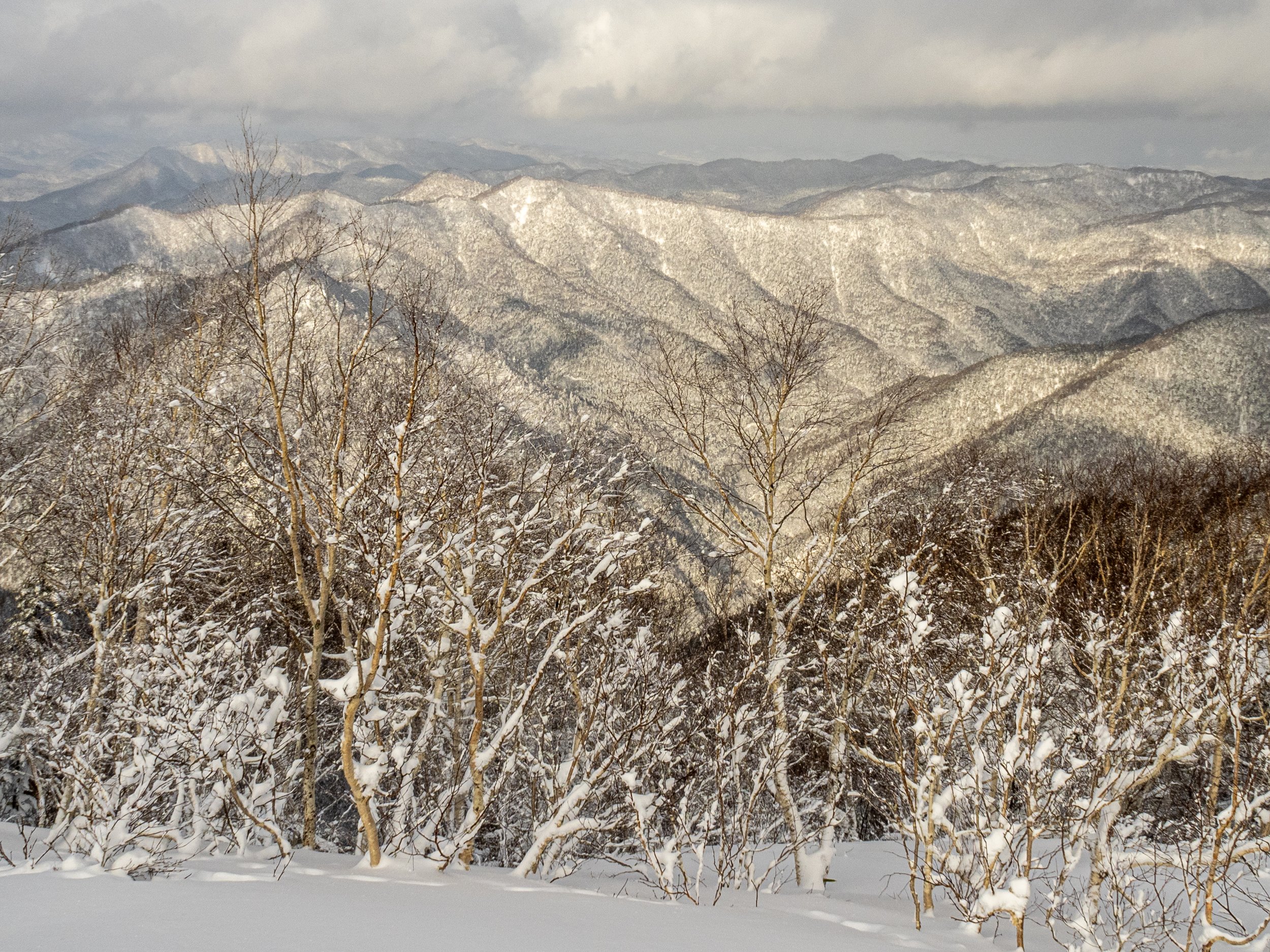
That evening, we decided to drive south to complete a loop of the area back to Sapporo, and tried to find a spot for an onsen and dinner along a beautiful lake south of Furano, but everything was closed. You definitely cannot rely on Google Maps for business hours in Japan. We continued on and ended up in a small town of Minamifurano, where we had a silly dinner at a tiny homestead restaurant called Svalbard (no actual relation to the Norweigen island, they just read about it in a book and thought it was cool!), with a puppy and super cute owners. This was a very small town, so the other two parties at the restaurant and owners all knew each other, and we had fun attempting to connect through a significant language barrier.
Popular ice fishing lake
The crew at Tomamu
The next stop was Tomamu, which you could describe as the 3rd flavour of Japanese ski hill. Kamui represented the small, undeveloped vibe, Furano was the larger resort adjacent to an existing town, and Tomamu is the modern purpose built family oriented Japanese ski resort, complete with giant wave pool, Club Med, and many different types of tourist activities like an Ice Village, snow cat rides, etc. It was definitely worth the visit, as like many things in Japan, sometimes it’s just about seeing the grand spectacle of it all.
We decided to keep rolling as Tomamu was quite overpriced for pretty much everything except their $10 single ride lift ticket. We drove 30 minutes down the road to a wonderful onsen (Shimukappu Yunosawa) to freshen up. The hot spring was extra hot, the cold plunge extra cold, and the tiny sauna extra cozy, with only a couple others there, including a local who has splitboarded around much of the area, and had some great advice for Furano side country for the next time we’re back.
We ended up in a small village of Shimukappu where we finally struck out on finding an open restaurant, and so we just enjoyed a hilarious but sub-par convenience store dinner of microwaved noodle bowls, a plastic wrapped cheeseburger (Ali dared me to try it), and various other strange snacks and bits and bites. A quirky finish to RV life on this phase of the trip, as the next day, we roll back into Sapporo to return the RV, and begin the final phase of our trip at our Airbnb in Niseko.
Back in Sapporo, we swapped vehicles, bidding farewell to the RV and wonderful Narihito and embraced a much more maneuverable Delica 4x minivan. We thoroughly enjoyed the RV, but the driving in wintery conditions was definitely on the spicy side for much of the trip. The major freeways are salted and cleared, but the side and country roads were not, leaving hard packed roads of snow and ice to navigate, leading to a rather active driving experience.
The Delica was generally more than ready for the challenge, though later on we would find out that in the most extreme of winter driving conditions that Siberia can throw at you, things get very sketchy regardless of vehicle choice.
We stopped for terrific sushi at a family run business running since the 1940s, with a multi-generational staff of the son currently working as the chef, and the adorable elderly Mum helping clear plates and serve.
After that, we drove south along the Hokkaido coast towards Niseko, with a stop at the bear sanctuary; which was an as expected ridiculous Japan experience. The Japanese brown bear is friggin’ enormous! The “human cage” where the male bears come to receive food they are fed by tourists all day was wild, the bear “athletics” performance was a bit of a letdown as I was expecting juggling and trapeze, and we don’t even really know what was happening with the duck race…
Onwards to niseko and our Airbnb, and you immediately knew we had entered the snowy part of Hokkaido! Driving through 3 meter snow banks in a blizzard to arrive at out relatively palatial abode, we had just enough time to unpack before heading to pick up the rest of our crew, Neal and Limor, who had just flown over from California.
We popped out for a confusing but delicious izakaya experience, hit a convenience store for snacks and whiskey, and headed home for an early night to prep for an early start on our first taste of the Niseko United ski area.
Niseko United is a collection of 4 interconnected hills that have individual lift passes, or a combined united pass. They all have somewhat different characters, from the more basic to the comically opulent.
Our first day was at the less developed Annipurni, which has more of a westerly aspect and was getting absolutely hammered by wind. So much that the main gondola was not forecasted to open, but we made the call to stick it out and ride some very cold lifts and avoid the crowds. The day was great and we found some solid stashes, in between nearly freezing to death, and learning some hard lessons about how flat terrain can be at Japanese ski hills when there is a meter of fresh snow.
We wanted to take advantage of our spacious kitchen, so we went to a large grocery in neighbouring Kutchan to pick up terrific value sashimi, wagyu beef, local Hokkaido scallops and rice, and 7 kinds of various mushrooms, to make some tasty noms.


We tried out Hanazono next, representing a more high end resort side of Niseko, complete with a Luis Vuitton Mongolian hut at the base, heated six seater chairs, and some longer lines. Some pow stashes were found though, and the remote Onsen we checked out that was actually a bit too hot felt nice on the body that was starting to feel so many days on the board.
Fortunately we were looking at another 20cms overnight, as our day at Niseko Village was the kind of resort ski day you dream of. Riding the main gondola from opening to close, with a delicious lunch at an Italian themed restaurant at a local dairy farm, each run was fantastic powder tree skiiing. The Gate 11 zone and the adjacent “Superstition” area was an incredible area of open tree skiing descending into a lower gully that had freshies all day.
The system of “gates” adopted by the main Japanese ski resorts is a way for the culture of slackcountry rope ducking typical of pow hunters to mesh with the strict rule abiding culture of this beautiful nation. By providing a dedicated access point, with information about recommended avalanche safety precautions, while keeping some level of enforcement for the classic rope ducking elsewhere, you have given the shredders what they want (access to the goods), while still providing a level of control over the less informed to get themselves into trouble in the wrong spot.
It’s a smart system, and seems to work fairly well. Technically, you’re supposed to have typical avalanche gear (beacon/probe/shovel) to enter these zones, but enforcement there is non-existent and definitely looked more like a suggestion. Pretty much all of the terrain we accessed was not actually avalanche terrain, so that is fine, but the upper alpine gates on Niseko should definitely be taken seriously, judging by the terrain we could see.
Iconic Mount Yotei towers over the Niseko area












Giles and I were keen to spend a bit of time walking on skiis, so while the rest of the crew took a rest day, we checked out the classic Niseko backcountry zone of Nito, adjacent to our much-to-hot hot spring experience from a few days prior. Fortunately, there is a wealth of info about the backcountry skiing options in the area, so we picked a fairly popular one to ensure we weren’t the only ones around, and headed off. Nito starts literally at the end of the road. Snow plows end their work on Hokkaido’s own Route 66 just past a military training base at an abandoned ski hill, and adjacent Yumoto onsen. Leaving a snow covered snaking trail providing simple access into the Niseko area back ranges.
Again, luck was on our side for conditions, as although the forecast had us expecting low vis but quality deep tree skiing, we were treated to clear skies and the opportunity to ascend Nitonupuri, and take in the incredible views from the North Japan Sea to the Tsugaru Straight separating Hokkaido from Honshu. The riding was phenomenal as we lapped the incredible pitched treed slopes that every powder aficionado that has seen a Hokkaido ski film segment has fantasized over.
We watched this local woman struggle up the skin track in snow shoes with this plastic toboggan on her back. I wish we got to see her on the way down!
We finished this leg of the trip with a fun cruisy half day back at Annupri with a running gondola, with a fun apres celebration on our last day with Neal and Limor. We decided to cook up another feast at home, heading back to the Kutchan grocery for thick Wagyu steak, snow crab, tuna sashimi, and other delicious random Japanese goodies.









All in all, even the crowd averse Giles agreed that Niseko was well worth the visit. It now has a reputation for being crowded, and we definitely could see signs of that, but nothing compares to our home hill of Whistler. In fact, during our time in Niseko, the crowds were essentially a non-issue, with the exception of when we foolishly tried to venture into the main town of Hirafu for apres and got frustrated by long lines for a quirky bar in a vending machine, and likely the busiest convenience store in all of Japan.
At the hill, the lift lines for chairs were often non-existent, the gondolas pretty quick <10 minute waits at most, and if powder is what you’re looking for, as long as the conditions are typical Hokkaido, you will not be disappointed. Even on our last day at Annapuri, when it hadn’t really snowed much the past couple days, we were finding easy access stashes tucked away in the trees through Gates 8.
We found great food wherever we went, though it is likely better to make reservations beforehand, over the phone. Mary had made our sole reservation via email, and when we showed up they had no record of it, which lead to an uncomfortable stand off before they seated us anyways. The backcountry opportunities are plentiful. There is a good mix of accommodation options, and we found our Airbnb townhouse to be ideal for our stay, and reasonably priced.
It was an absolute treat to get to spend some quality time with Neal and Limor, with tons of laughs, and the usual smorgasbord of quality food and drink and silliness, with dirty Grandma jokes from Neal kept to a minimum, I assume out of respect for the polite Japanese culture.
Hokkaido lived up to all the hype and then some, and we are so excited to return. If you enjoy skiing or snowboarding, great food, hot springs, and strange and wonderful culture, a trip to Japan’s north island will definitely leave you looking like gleeful Marimokkori every single day.
Elemental Kyoto
Kyoto is an incredibly special place, and truly the Yin to Tokyo’s Yang. Well, more appropriately, Kyoto is the “in’yō” to Tokyo’s “onmyō”, which is the rough Japanese equivalent to the classic Chinese philosophy of universal balance. Historically, in Japan the practice is called Onmyōdō, which literally translates to “Way of the Ying and the Yang”, and became a component of Shintoism, and evidence of this doctrine is still seen throughout Japanese practices today. A key component of this philosophy, directly brought from its Chinese roots, are the 5 elements balanced in harmony, reflected in much of our living world: Water, Earth, Metal, Wood, and Fire.
Kyoto, with its traditional Japanese aesthetic, exemplifies a harmonious balance between these various natural elements, creating an immersive experience for those who wander its streets and temples. The city is adorned with water features: ponds, waterfalls, and numerous rivers and canals. The interplay of deep wood tones and dark metals fosters a connection with nature even in the more urban environments, and is further enriched by the surrounding network of pathways, forests, and mountains.
Fire, the wildcard Keith Moon 5th member of the elemental band, which is often seen as a disruptive force, also symbolizes rebirth and transformation. This element reflects Japan's history of overcoming challenges and evolving, contributing to its unique identity today.
Even in relatively quaint Kyoto, with a population of 1.4 million, the same rules apply about the crowds. Get up and out there early, and you will have a significantly better time. Though of course don’t expect any businesses to be open.
Tanuki - Everyone’s favourite good luck racoon with oversized scrotum representing “financial luck” for businesses, found all over Japan.
We started our Kyoto explorations in Gion, the beautiful Geisha district, with beautiful traditional buildings and canals. Much of this area is forbidden for photography, as apparently there were too many tourists harassing the Geishas. We did walk past the Ichiriki Chaya Tea House, famously frequented by a group of Samurai in the 18th century known as the 47 Ronin, and the source of one of Japanese history’s more brutal tales of Samurai lore:
The tale begins when Asano Naganori, Lord of the southwest town of ‘Ako’, gets into a spat with Edo official, Kira Kozuke-no-suke Yoshinaka, and unsuccessfully tries to kill him. Naturally, due to his failures, Asano is to forced to commit the savage Japanese ritual suicide of seppuku, which typically involves an initial self-disembowelment by sword, and then generally some assistance is needed at that point to complete the ceremony with a final beheading.
With Asano dead, this left behind his master-less samurai (“Ronin”) to plot their revenge.
The Ronin frequently met at Ichiriki Chaya, concealing their revenge plot by acting despaired, and often feigning drunkenness. After one year of patient waiting and secretive planning, they stormed Kira's mansion, assassinated him, and placed his severed head at Asano's grave. The tale concludes dramatically with the Shogun mandating that all the Ronin perform ritual seppuku.
The Way of the Samurai, or “Bushido”, was some gnarly stuff!
The Teahouse is still running almost 300 years later as an invitation-only establishment, where you can spend an evening sipping green tea and entertained by Geisha for 500,000-800,000 yen ($5-8000 CAD).
Wandering along one of the smaller canals, Shirakawa, with beautiful cobblestone streets and pretty bridges. With the cherry blossoms in, it must be spectacular.
Kenninji Temple
We had a recommendation for a popular tea house, Tsujiri, who have been making their own tea for over 160 years, in central Gion. We had to take the opportunity to try out what passes for a complete breakfast in Japan, and ordered one of their ridiculous layered parfaits. It tasted as epic as it looks!
East of Gion your start to climb up into a hillside area full of a variety of temples, large graveyards, and a maze of pathways. Some areas were extremely busy, but many remained peaceful and serene, often just a block away.
Yasaka, Kiyomizu-dera, and the road leading up the Kiyomizu were packed. Most of the surrounding area was relatively quiet.
Tourists loved to dress up in rented traditional kimonos and walk around for photos. Selfie sticks outnumbered the temples 2:1, and there were a hell of a lot of temples!
The super busy climbing street up to Kiyomizu-dera temple, filled with tourist shops
Kiyomizu-dera temple
We’d put in a lot of walking by this point, so it was time to chow down. Mary’s food goals for the trip was to eat as much Okonomiyaki as she could find, and we managed to track some down eventually. Finding food on the go was a bit of a challenge throughout the trip, as Google was often out of date or wrong about the hours, and often if you did find a place you were excited to check out, there was a crazy long line.
This one was worth the wait, as these Japanese flour and cabbage pancakes really hit the spot. So much cuisine in Japan is absolute comfort food; simple yet rich flavours, plenty of layered sauces and textures, and the Okonomiyaki and side Yakisoba noodles was kept nice and hot as it is often served on a heated surface at your table.
You’ve gone too far Japan… “American Dog Parfait”…? wtf mate.
We ate a couple of terrific meals in Kyoto, the first being a bit of a fancier Izakaya (small plates). We had some of the best sashimi of the trip, including some variety of squid that was insane (just buttery smooth and not rubbery like you’d expect), and a number of other delicious treats like fried mushrooms, and chicken karage.
Our other terrific restaurant experience was at a kaiseki, which are higher end set menu establishments, offering seemingly endless courses of what really is culinary art. Each dish was beautifully prepared and plated, and we got to try some more wild and exotic fare, including the poisonous pufferfish, fugo, served in a gelatin, served inside an orange peel. The exciting part was that even though this was a fairly high end restaurant, the servers spoke barely any English, and so the descriptions of the dishes only came through in bits and pieces, and usually involved a lot of random guessing on our part like a game of poisonous pufferfish charades.
The experience definitely captured the essence of Onmyōdō, striking a tasteful equilibrium among the diverse elements. The visual appeal of the dishware, the thoughtful selection of accessories, and the broad spectrum of flavors created a harmony for the senses.
On our final day in Kyoto, we popped back onto some rental Luups, and headed out towards the popular Arashiyama bamboo forest area. The cycling alone was a highlight, and though there aren’t really bike lanes or suggested routes (at least not on Google Maps), we just picked a rough direction and fortunately most of the 10km ride snaked along quiet residential laneways, where a masterclass in Japanese landscaping was on display framing beautiful townhomes.
Photo: Giles



Once again, due to the New Years Eve holidays, a few of the main sites in our area like the Imperial Palace and Nijo Castle were closed, but we definitely didn’t run out of things to do. Kyoto was a wonderful place, and one I’m excited to come back and visit at a different time of the year to experience sakura (cherry blossoms) or the autumn colours: new natural elements added to the already rich palate.
We were off to the Osaka airport the next day to catch a flight to Hokkaido. Meticulous weather tracking suggested that the renowned skiing conditions in northern Japan were shaping up well for the next leg of our journey.
Kaleidoscope Chronicles
I’ve been fascinated by this beautiful and peculiar country for much of my life, but never took the opportunity to visit until now. In 1970, my grandfather took a year’s sabbatical in Tokyo, plucking my mum at 14 years old out of high school along with her two younger sisters and my grandmother, for what must have been quite the cultural experience. They have many incredible stories from this time, and an admiration for the land and culture persistent through to today.
Visiting Japan in 2024 is quite the culture shock; I can only imagine what it would have been like in 1970…
And from the stories, they had to really put in some work to fit into life in central Tokyo. As there weren’t English translations in the buses back then (though they generally did exist on the subway thankfully) my Mum took it on as a project to, as a solo 14 year old, travel on all the surrounding lines from their central Tokyo apartment, meticulously documenting various distinct features of each to assist with future travel.
Japan is famous for its shopping, but I’m not sure too many foreigners in history besides my grandfather managed the logistics of finding, inspecting, procuring, and freight shipping a 27 foot cruising sailboat in 1970 Tokyo, which became their second home exploring the coastal seas of BC for the subsequent decade.
It feels special to write this today, as I just had an emotional final conversation with that incredible man, my grandfather Doncaster Russell, still sharp as a tack at 95, as he prepares for his anticipated medically assisted in dying procedure this week. Guitar player, artist, world traveler, and obsessive computing scientist since the 1960s, I can recount many stories from him that over the years laid an inspirational foundation for my own life’s pursuits. Over the years he made many connections with incredible people across the world, and had a wonderful ethos about him, with a respect and appreciation for people across all walks of life.
In a post about Japan, it feels appropriate to write a Haiku in his memory. I’m far from a poet, but I’ll do my best, and include a classic Grandad-ism for good measure:
A curious mind
Care and compassion for all
Will it run Linux?
Thank you for all the great stories. You will be missed.
Sayonara, Doncaster-San
Grandad and my mum on Mt. Fuji, 1970
Japan has changed immensely since 1970. The history of this nation feels as wild and chaotic as the streets of Shinjuku, evidence of which is easily observed as you explore the sites and sounds that drastically vary from street to street. Modernity came to Japan fast and furious in the mid-19th century with the Meiji Restoration, and, in between a few significant interruptions and setbacks, continued at a frantic pace. The Tokugawa shogunate, a military government run by a single family for over 200 years from the early 17th to mid 19th century, enforced strict rule over a feudal system throughout the land, imposing a rigid social hierarchy and banning foreign influence and trade.
The Meiji Restoration in the mid-19th century, which saw the return of power to the emperor and advisors, the removal of the shogunate, reintroduction of relations and trade with the West, and significant shifts in social and economic frameworks and mindsets, lead to a rapid shift towards modernity, industrialization, and free market capitalism. Japan’s explosive growth during this period took it from it’s peasantry roots to a leading industrial economic power in an incredibly short period of time, fueled in no small part by some rather nasty imperialist tactics across East Asia.
World War II dealt a significant blow to Japan’s progress, through massive destruction of infrastructure, loss of life, and a collective national trauma. US efforts to curb the spread of Soviet influence including immense financial aid invested in Japan, lead the country to not only recover to pre-war output levels by the mid-1950s, but rapidly expanded into the world’s second largest economy by GDP after the US in the late 60s, remaining around that position until the end of the 20th century.
The 1980s saw another period of wild modernization and growth, until the major bubble and crash of the early 1990s lead to a crippling period of stagnation for 20 years, referred to as “the lost decades”. Though there are some serious warning signs about the future of Japanese economic growth, requiring some significant ideological shifts and progressive policies, currently the stock market and larger economy is finally ticking upwards again. The future looks to bring more challenges though, with a dwindling and ageing population, antiquated workplace culture, entrenched gender roles, and immigration policies, and Japan looks to require a significant overhaul to help drive the nation’s momentum through the 21st century.
Popular claustrophobic nightlife district Golden Gai in Shinjuku, with 17th century Hanazono Shrine behind
Parts of Tokyo feel straight out of a 1980s dystopian sci-fi movie, interspersed with beautiful 400 year old traditional Edo-era temples (rebuilt replications of the originals, as sadly not much has survived the many fires over the years , particularly WW2). Referred to as “The City of a Thousand Villages”, it makes for extremely satisfying exploration, as it seems every block is different than the last, mixing and blending many different styles into a smorgasbord of lights, colours, shapes, scents, and sounds.
Truly an experiential kaleidoscope, nearly overwhelming the senses.
Regardless of the past and the future of Japan, it is an incredible place to visit today. We absolutely loved it, and spent a significant amount of the trip planning our next visit. The people, the food, history and culture, ease of travel, not to mention the cherry on top for deep powder connoisseurs like ourselves with Hokkaido skiing, made for a magical time in the Land of the Rising Sun.
Our trip was loosely broken up into 3 phases, the first of which was an attempt to scratch the surface of at least a handful of the thousand villages of Tokyo, and explore relatively quaint and natural Kyoto. Giles and Ali joined us, maybe feeling a bit overwhelmed flying from the tiny town of Rossland to a city with the population of Canada. We then flew to Hokkaido, where the four of us squeezed into a rented RV exploring the Northeast of Japan’s winter-smashed island and powder skiing mecca, before finally migrating to a relative life of expansive living in an Airbnb house in Hokkaido’s more developed ski area of Niseko.
In Tokyo, we stayed in Asakusa, which we all felt worked out well. It was pretty far from some of the major modern Tokyo sites and sounds, and unfortunately some of the closer east Tokyo highlights such as the Imperial Palace gardens, and the museums at Ueno, were closed for the New Years holidays. But Asakusa has a chiller, older vibe, with a large temple complex at Senso-Ji that was definitely an experience on New Years Eve, where we visited at midnight to watch people queue up for their first blessing of the year. This is a significant event, called Hatsumode (literally “first shrine visit”) for many people, and it’s reported over 3 million people visit the shrine on the first few days of the year! The temporary food market at the temple was incredible, and we all regretted having bothered to eat a rare miss Izakaya dinner prior instead of gorging on the various random Japanese street food delicacies more.
Asakusa Street Art on a closed shopfront
Endless popular Izakayas (casual drinks/small plates) dotted the area around “Hoppy Street” in central Asakusa. They seemed very popular with college age Japanese.
There appeared to be a massive, quirky, and quintessentially Japanese “Don Quijote” department store in the all the popular Tokyo neighborhoods. Everything from snacks, liquor, pets, sex toys, and, apparently at the Akihabara location, a purpose built theatre for an 86 member J-Pop girl band named after the neighborhood, “AKB48”. Split into many “teams” to share the load of their insane schedule, they alternate performances at the “Donk”, touring, or fan meet and greets around the country.
After learning the hard way that the overwhelming quantity of restaurants can make for some challenging decision making at meal time, we settled on a random spot for our first proper Japanese meal, that turned out to be a bit of a Chinese fusion place, but still had a Japanese favorite of ours, delicious Takoyaki (flour and octopus balls).
Senso-Ji Temple is generally a beautiful enclave of peace and tranquility (except on New Years Eve/Day, or other major festivals) in amongst the chaos of larger Tokyo. Staying in Asakusa had the benefit of having this space very easily accessible, and we visited it multiple times during the trip. Senso-Ji is Tokyo’s oldest maintained temple, dating back to 625 AD. It is considered the most commonly visited religious site in the world, with 30 million visitors annually.
Buddhism came to Japan from China in the 6th century, and after brief conflict, became the dominant religion in the country ever since, leading Japan to become the third largest Buddhist country in the world, after China and Thailand. Somewhat confusingly, it is also home to a separate though often complementary religious practice of Shintoism, and shrines and temples commemorating both Buddhist and Shinto beliefs can be found interlaced throughout the country.
Shintoism is an amalgamation of ancient indigenous Japanese beliefs, and the term generally was used to distinguish itself with the newer doctrine of Buddhism. There is no known founder, core dogma, or central organization. It is considered a religion of nature, worshiping the beauty of the natural world.
Worshiping the natural world sounds like a practice I can get behind, and the care and attention to incorporating majestic gardens, ornate landscaping, amidst meandering pathways, was clearly evident in both the Buddhist and Shinto shrines we visited on the trip.
Charms for purchase to wish for good luck in a wide variety of topics and areas
Older Buddhist statues with the imposing Tokyo Skytree in the background
Beautiful water features surround Senso-Ji
We decided to see how the Gods were looking down upon us by contributing 100yen (~$1 Canadian) to receive a fortune. You put the coin in a slot and help yourself to a narrow stick you shake out of.a small cylinder. This provides a number for a drawer you open to retrieve you fortune.
What I wish I knew before engaging in this act, is that they also have “bad fortunes”. After more general wisdom on modesty and maintaining reasonable expectations, mine wrapped up with the following rapid fire bombardment across a wide swath of life’s primary concerns:
Your request will not be granted
The patient is hard to get well
The lost article will not be found
The person you wait for doesn’t come
Building a new house and removal are both bad
To start a trip is no good
Marriage of any kind or new employment are both bad
A bit harsh if you ask me, and some of these hit a bit too close to home… Couldn’t they have contained them to just one individual bad fortune each, not a barrage of an entire life of anxiety? What happened to all that Japanese kindness?
Thankfully, they have a system where supposedly all of these bad fortunes are negated by twist tying the paper around a kindly provided adjacent rack. I would have preferred to have skipped this part and instead received even a neutral fortune, but I am not one to allow my cultural naivete to judge foreign religious practices.
We ventured out on our first Tokyo subway mission (besides the uneventful trip from the Airport) towards the Tsukiji Fish Market. Though the entire system is dauntingly massive, we found it fairly straightforward to navigate once we had a few key pieces understood. In hindsight, we definitely should have found a station that sold a special day pass specific to tourists, that would have negated the need to awkwardly dig through our collective spare yen to come up with the required fare each time, but we learned too late.
Tsukiji was at times unbearably busy. Maybe due to it being the Christmas/New Years holidays, we’re not sure, but I wouldn’t recommend going there mid-day like we did. As with any popular tourist destination, the early bird gets the worm.
Street Squid
We were in bad need of a convenience store beverage and snacks after the chaos of the fish market, so we found a nice riverside park.
“The Future” - As we thought it would look like in 1985
We decided to stop into Akihabara on the way home to check out the “OG” Tokyo electronics/anime/manga district
A 1970 photo from my grandfather’s collection
Returning back to Asakusa, we walked across the river towards Skytree and the Asahi Building, complete with it’s “Golden Flame” art. You be the judge whether “golden flame” is the first thing that comes to mind… Behind is the Asahi Headquarters, and the gold building with the grey “head” at the top is supposed to look like a frothy pint…
Sure, why not?
Wandering Asakusa
Mandatory conveyor sushi stop. For the best sushi, go elsewhere, but sometimes it’s nice to have a simple option for efficient eating when on the go
Nightime in Asakusa. Tokyo Skytree towers above all.
We found a random bar on Google called “3wood” that looked like a nice spot for a cocktail to wind down. It was a cozy little space with all wood panelling and a great bartender who was excited to connect with us, but didn’t know any English, so he brought out his laptop and talked through Google Translate. We enjoyed some quality negronis and Japanese whiskeys.
Unfortunately much of Ueno park, which is a major attraction near Asakusa in East Tokyo, was closed. Home to a crazy urban zoo and some of the main museums and art galleries, it also has some nice trails and lakes, so Mary and I decided to go for a run to check it out. It was likely not the best idea to push it after a mediocre jetlagged sleep, straining the immune system, but I was just super excited about exploring and so we ran around some of the open areas of the park.
Our hotel, the APA Asakusa, even had rooftop baths/spa (you can’t technically call it an Onsen unless it is actually geothermal water), which was a nice touch to freshen up, and was a welcome escape from our comically minuscule hotel room.
After figuring out a decent breakfast, which was a surprising challenge in Japan (though admittedly were coffee snobs), we decided to venture towards one of the epicenters of Tokyo shopping insanity, Shibuya. Ali was keen to check out a crazy high end food mall at the Shibuya Station Food Show, which was a totally overwhelming smorgasboard of gourmet versions of all things Japanese (and European) cuisine.
Shibuya Crossing
The cool thing about Tokyo is that within just a few blocks, you move from one of the most dense urban experiences to quaint little side streets and surprisingly cute neighborhoods. We charged through the dense mega-shopping area of Shibuya to escape to the relative tranquility of Yoyogi Park and the surrounding neighborhoods, traveling along beautiful arcing narrow laneways. Adjacent Meiji Jingu is a Shinto Shrine dedicated to the Emperor Meiji (the same “Meiji” who was in charge during the Restoration), and is an enormous complex including long wide forest pathways separating the different components.
Ali had a desire for a specific food craving she had heard about in adjacent Harajuku, a shopping district popular for modern youth culture. We passed this oddly named donut shop that had a 50 person line around the corner as we first entered the neighbourhood, which I thought was likely a bad sign for Ali’s desires. Sadly, she did not find what she was looking for, but Mary and I did come across a Takoyaki shop directly adjacent to one of my bucket list items for the trip, a Japanese Crepe Parfait.
This ended up being a somwhat poor choice for what ended up being my lunch and dinner, as by the time we made it the one hour journey back to our hotel via the subway, I was absolutely wrecked from jetlag and the onset of a cold, that I ended up crashing at 4:30pm for the night.
The next day, I woke up feeling a bit better, and decided to try to move around away from crowds, and signed up for Luup, a bicycle share service. They ended up being super awesome in both Tokyo and Kyoto, and although the transit system there is incredible, getting around on two wheels will always be my preferred way to travel.
Mary and I visited the mostly closed Imperial Palace area during the day, before making our way to Odaiba, a strange man-made island now home to some enormous mega-malls and large attractions, and also home to the Teamlabs interactive art exhibit we had tickets to check out that evening.
Imperial Palace Grounds
Imperial Palace Grounds
Imperial Palace Grounds
Imperial Palace Moat
Giant Gundam Statue on Odaiba
Mary’s Odaiba Tapir Friend
“Tokyo Big Sight”, an enormous convention center in Odaiba
TeamLabs Interactive Art Exhibit
We returned to Asakusa to enjoy the final hours of 2023. The Hatsumode festival at Senso-Ji was a whirlwind of attendees of all ages and nationalities, winding through row upon row of temporary food stalls. The line for the shrine itself extended as far as you could see, as people excitedly awaited their first blessing of the New Year. The air was filled with the delicious aroma of a huge variety of Japanese street foods. Although completely full from dinner, Mary and I sampled some Japanese seafood savory crepe dishes, as this trip we tried to run on the principal to eat as much food as was physically possible, regardless of hunger levels.
As the clock struck 12, a roar arose from the crowd. As this was a religious site and not Times Square, the only notable celebratory activity was the ringing of a gong, and the forward momentum of a massive crowd of practicing Buddhists shuffling towards the Shrine to bless the upcoming 365 days with good fortune.
Since none of us were practicing Buddhists, had our fill of busy streets and lines, and were all completely bagged after a very full day, we headed back to the hotel, wrapping up the year, and an awesome time in Tokyo.
The next morning, our plan was to take the Shinkansen bullet train to Kyoto, for a more subdued and traditional flavour of Japanese culture.
The Beautiful Hill - Mt. Beaujolais Scramble (+ bonus engagement)
Reading through a guide book cover to cover is an all too common activity for me. Particularly ones I’ve already poured through numerous times and by now, really should have memorized verbatim.
But seriously, if you ski tour in coastal BC, and you haven’t read Baldwin’s bible cover to cover at least 14 times, do you really ski tour?
This time it was Squamish district planner and local mountain guru Matt Gunn to get the gears turning for our next adventure, with his “Scrambles in Southwest BC”. Mary and I were keen to check out a new area up the Hurley and try to get away from the crowds, and found an awesome area up the Hope Creek zone that I’ve explored in the winter by snowmobile, that boasts a stacked collection of high quality scrambles and alpine terrain.
I had additional motivation to find an aesthetic spot to explore with Mary at this time: a newly crafted engagement ring. Nerves and excitement were cascading around the where and the how, but I figured that I would bring the ring with us on the trip, and if the timing seemed appropriate, go for it.
Access to the remote Mt. Beaujolais area is deep up the Hurley Pass, a seasonal rough road connecting Pemberton to the Bralorne/Gold Bridge area through some incredible high country terrain. The access possibilities from this area in both the summer and winter are truly staggering, having explored many of the drainages in the winter by snowmobile and splitboard over the years. Turning off the Hurley Main road to head up Hope Creek to one of the more distant branches of this area, signs of other humans diminished quickly. In fact, even though this was Canada Day long weekend, after turning off onto the East Hope Creek road, we didn’t see another soul for the rest of the trip.
East Hope Creek FSR is quite overgrown, and if you care about your vehicles exterior paint, I would recommend parking a few KM up the road and bike/walking the rest of the way. We pushed about 3/4 of the way up the road until I decided to park and walk the rest of the way to the trailhead, which was a bit silly as the pinstripe damage was already done. We really need to get a pair of e-bikes to skip this part of the adventure…
The trailhead was easy to find, and although we took a wrong turn at the main pass to enter the Beaujolais Valley, we were able to head in the right direction and get on track through the lower valley instead of the high traverse that is recommended, and was our return path. The key was to stay on the ridge and continue up hikers left to stay high above the valley, instead of descending back down and up again like we did. A little bit of extra work, but easy travel and routefinding in the valley.
We made it to a beautiful alpine lake with clear views of Beaujolais towering imposingly above us. Beaujolais features the hallmark of any terrific scramble—a term typically referring to unroped 3rd/4th class travel to gain the summit, as opposed to easier established trail hiking or more technical mountaineering. From a distance, the summit appears to be protected by a challenging fortress of steep rock. However, up close, a straightforward and fun route through the spires is presented and available.
The mosquitos were definitely a factor on day one! Mary practicing a variety of techniques to keep them at bay.
Ascending alpine meadows toward the basin below Beaujolais ahead.
The mosquitos were a thing!
Camp lake
It’s hard NOT to be sexy in these situations. Puffy down pants: check. Bug hat: check. Maybe I’m crazy, but to me, THAT is the kinda woman I’m excited to marry!
Fortunately the mosquitos subsided slightly for the next morning with a bit of a breeze, so we were able to enjoy a nice relaxing breakfast, considering our route up for the day.
Beautiful lush greens in the valley contrasted beautifully with the rocky escarpments above.
The route gains the ridge down low on the far left of the valley, and then climbs to the summit.
A better view of the “crux”: low angle slab climbing above some significant exposure. Looking a little more reasonable now.
Like any good scramble, the crux was exciting but safe and straightforward. Easy ledges provided a simple ascent through the steep and exposed section.
Once on the ridge proper, the wind picked up significantly. At this point, I had made the decision that if conditions allowed, I would go for the “big question” on the summit, but Mary was quite cold, and the wind made it very inhospitable on the ridge, so that idea seemed doubtful at this point, and I was resolved to wait until the evening or later.
But I continued to rehearse my words and prepare myself for what I hoped wouldn’t be an overly stiff and awkward delivery!
After more simple blocky scramble and gaining the enormous wide summit plateau, incredibly the wind died down completely! So I rehearsed my words in my head one more time, set up my camera on the rock to take a “selfie” and went for it! I managed to completely forget everything I was going to say, mumbled some incoherent words awkwardly, but fortunately my body’s orientation and associated prop made my intentions fairly obvious to Mary, and just like that, we were engaged!
Alright, enough with that stuff, let’s get back to the mountains! Mystery Peak was another quality rated scramble across the valley to the South that we had put out as a potential day 3 mission. Looking dark and foreboding from the peak of Beaujolais.
Looking north towards the Chilcotin, the characteristic colourful rock begins to appear. Beaujolais and neighbouring Merlot peak were named due to the iron deposits and red hue.
Looking a bit steep on the way down.
Morale was high after the day’s events, and so we enjoyed a bit of wine and the sunset, fortunately with a reasonable number of mosquitoes this time. We decided against the monster day of another summit and exit the following day, and had a relaxing and fairly straightforward exit, doing a better job of route finding this time, staying high on the north slope to gain the col at the far end of the valley, dropping down the short and steep descent to Hope Creek and our truck.
Finishing the day at the Beerfarmers up Pemberton Meadows, we ran into another couple that was doing a big multi day bike ride around the region, and they shared that they had just gotten engaged the day before as well! Stories were shared, stoke levels very high.
So, shout out to Matt Gunn and all the guide book authors out there. Without you, it would be incredibly challenging to find these stunning remote locations that offer the beauty and solitude that make for such a high quality experience.
For a few reasons, this was definitely a memorable trip!
Sea Beavers and Caesers - Kayaking in Kyuquot Sound
During the course of this “Cabin in the Sky” project, I’ve come to realize a few things:
Writing is MUCH harder than simply taking and posting photos on the Internet
It takes a certain mental state to be particularly motivated to invest time in this and expose myself to the world in this way.
I enjoy the challenge of new things, including the vulnerability of putting creative works out in public, though it can definitely be very uncomfortable
Mary has been observing that I often describe things as hard, and it comes across as negative framing at times. I tend to not necessarily equate hard to negative, they are just that, hard. And sometimes, hard is good!
It’s just a different perspective.
With the current era of large language models and “Generative AI”, it should probably feel less daunting, but, like I said, I like the challenge of writing, so I’m going to keep pushing myself to take this on and keep going, and get a few posts done that I started years ago but never finished…
In late August 2023, two of our dear California friends, Nick and Mer, who Mary and I know through the Burning Man community and longtime members of our camp, Planned Playhood, had expressed a strong interest in joining us on a sea kayak adventure on the BC coast. We decided to continue a tradition I held for years following my first Burning Man by opting for a kayak trip during the week of the Burn to disconnect and experience a very different type of adventure. Truly the Yang to Burning Man’s Yin, sea kayak touring provides the experience of a full disconnect, far away from jobs, taxes, and day to day responsibilities, and further yet from giant sound systems, day parties, rubber ducky art cars, flame spouting giant metal octopus, 12 hour exodus lines, dust storms, and orgy domes (of which I have never participated in, let the records show).
As it happened, this proved to be an excellent decision on multiple levels, not least because in 2023, both activies were atypically alike in the amount of liquid water present.
We had narrowed our focus on a region of North Vancouver island we had not explored before: Kyuquot (pronounced "ky YOO kit"), not to be confused with Clayoquot Sound north of Tofino and the location of a few previous incredible kayak adventures of mine. We opted for a water taxi to/from Fair Harbour to access the exposed western coast and skip two days of paddling up and down the Kyuquot Sound, maximizing our time in the heart of the region, and explore the waters just south of the massive barrier of land that is the Brooks Peninsula, jutting deep out into the Pacific and the source of significant marine hazard to watercraft travelling up and down the Island.
Fortunately, we were staying South of Brooks, exploring 3 incredible marine and provincial parks separately, with day trip options from each location:
Big Bunsby Marine Park at the North end of Kyuquot, consisting of 5 major islands, and dozens of smaller islets, relatively untouched by development.
West Spring Island, off the coast from the First Nations townsite of Kyuquot, which has some development as it was used as a former marine base, and popular with large groups of kayak guided tours, boasting some fantastic old growth forest hikes and an incredible spit of land and beaches for camping
Rugged Point Provincial Park, a classic West Coast of Vancouver Island beach destination, with Tofino-esque miles long pristine sandy beaches, wolf tracks a plenty, swaying ancient cedars lining the shores. But in contrast to Tofino, at our remote end of the beach, we barely saw another person the entire time we were there.
Kyuquot Sound relative to Tofino and the rest of Vancouver Island
We arrived in Fair Harbour and made our final preparations while we waited hopefully for Kyuquot local First Nations resident, Leo Jack, to arrive. I had managed the communications with him to organize the boat ride and the rentals, and was 97% confident our sporadic messaging had landed and we were secure for this trip, but it’s a different style of communication with remote First Nations disconnected from mainstream media and messaging ubiquitous today, so you never really know. But sure enough, Leo pulled into the dock mid morning, and after loading gas and gear, we were off racing up the sound towards the big swells, open coast and adventure.
Leo’s house in Kyuquot
We learned a lot about the local village during our boat ride with Leo, who shared stories about the fishing lodge. Originally built and operated by settlers, the lodge is now managed by the local nation. Leo expressed pride in seeing the community take charge, but he also acknowledged the significant staffing challenges that come with this transition. With a limited pool of workers in the village, finding and retaining staff is difficult. Leo noted that issues such as alcoholism—an unfortunate reality in many remote communities- further complicates these challenges.
We feel very fortunate to be able to explore and interact with these incredible places and rich culture on the unceded lands of the Nuu-chah-nulth people.
Ready to paddle, leaving Kyuquot village
Very cool rock formations and waterfalls highlighted the coast as we paddled North
First lunch spot, looking North towards Bunsby and Brooks Peninsula
Pooh Bear Rock
We enjoyed perfect paddling weather all day, with minimal wind and bright warm sun, right until we approached the Bunsbys, where we encountered something completely novel to me in 70+ days of sea kayak touring: pea soup fog.
I know my way around a map and compass, as well as setting a bearing, etc., but fortunately, we live in a magic land with tiny supercomputers with a seemingly infinite ability to simultaneously make our lives so much easier (maps), and so much harder (Instagram). Fortunately there was no cell service in Kyuquot, so the latter wasn’t an issue, and man did the former come in handy in this moment! A quick long press on the Garmin Navionics app to set our destination on the far side of the open crossing at the edge of the Bunsbys and we had our bearing. It was extremely disorienting as we paddled, as we could not see anything besides the white void ahead, and a hope that my GPS was in fact doing its job.
In the end, it handled it perfect, and we were in the Bunsbys without any issues, and it was now time to find an available campsite. We toodled around the many islets inspecting the various marked known campsites I had pre-recorded from the BC Marine Trail website (https://www.bcmarinetrails.org/map/), and eventually found a great protected option near the outer edge of the chain where we settled in for 2 nights to explore, where our only neighbours were some curious sea otters.
We had a great time fishing this trip, and Nick really showed off his solid skills from the boat, learning a ton.
While fishing, we got to watch this otter crack shellfish on his pet rock he kept on his belly.
After a few beautiful days exploring the Bunsbys, we were off to Spring Island with perfect calm weather for the paddle. We were even visited by a small sunfish at one point who paddled along beside us!
Campsite on Spring Island
After some great fishing and misty old growth forest hikes, including some random basketball on an abandoned court built in the forest, remenants of Spring Island’s time as a WWII naval base, we were off paddling across to the main coast and the beautiful beaches of Rugged Point Marine Park.
Life is good! We intentionally kept the itinerary pretty simple with only 3 camps over 7 days, meaning less time breaking camp, packing/unpacking boats, etc., and more time exploring on foot with plenty of time for fishing, reading, daytime hammock wine, laughs, and stories.
And of course a few dance parties from the girls:
Classic west coast vibes. We did a longer walk one day where eventually we did find an established and active summer camp and signs of logging camps, but our North end in the park was deserted.
On our final day, we made a short portage to the sheltered waters of the Inside Passage in Kyuquot Sound, where we waited for our water taxi ride back to Fair Harbour with Leo. While there, we crossed paths with a fascinating solo adventurer, deep into his elder years, navigating the coast on his custom-built sailing/paddling rig. He had spent weeks exploring these remote shores alone, sharing stories, both triumphant and calamitous, from his time at sea. There’s something deeply addictive about life in the solitude of BC’s tidal waters, a way of being that draws people back again and again, fuelling a lifelong pursuit of exploration, resilience, and self-sufficiency.
Back in Fair Harbour for a celebratory beer, with Leo’s boats in the background.
As we re-entered cell service and reintroduced ourselves to the un(let’s say semi)-productive parts of our mini supercomputers in our pockets, a flood of work emails, overdue corporate GST payments, Airbnb bookings, targeted ads, untargeted ads, Instagram memes, expense reports, group chat drama, bank alerts about “unusual activity”, and “Your storage is almost full” warnings are unleashed onto your previously restful psyche.
But one interesting bit of hot news came through Meredith’s phone that she had to immediately share with an initial cackle that initially sounded quite comical until the severity of the issue was fully understood:
Stories of daring escapes circulated everywhere - from Neal Gottlieb saving lives smuggling Bay Area surgeons out to return to work, to Chris Rock’s unlikely team up with Diplo. This made for entertaining fodder, representative of the dizzying speed at which information travels in this wild space age world. While I was very appreciative to learn that no one would miss their critical heart surgery, I could care less about Chris Rock, and even less about Diplo, and this information tidal wave had a part of me wishing I could surf it right back out to our little slice of isolated paradise at the edge of the Bunsby Group.
That feeling faded a bit, though, when we treated ourselves to an epic meal at the marine pub in Campbell River: a giant burger and fries, a few tall pints, and—maybe best of all—not a single dish that needed to be hauled down to the ocean and awkwardly washed on a slippery rock, trying not to soak our feet or lose a shoe in the tides. It’s just so easy!
I guess easy can be as satisfying as hard sometimes.
As with my feelings toward hard things, it really is all about perspective. On this trip, we gained so many new ones: experiencing the culture of the Kyuquot people, disconnecting into a stunning new corner of BC, and deepening connections with friends we rarely get to see.
All in all, a flawless trip in a beautiful place with a great little crew. It’s such a treat to get to share the joys of coastal sea kayak touring with new people, and based on their reaction, I’m pretty sure Nick and Mer will be back for another.
Winter 2023 Highlights
My 2022/2023 winter season felt like it played out a bit like a Greek tragedy. A series of rather comedic errors kept me off the slopes for a significant portion season, following a nasty and persistent herniated disc at Burning Man. Apparently desert revelry can have its own share of musculoskeletal risks. Shortly after I felt fully recovered and gained more confidence on the hill, an unseen patch of ice at Whistler sent me tumbling like Sisyphus’ boulder right into a tree, causing a mid-severity MCL tear.
The snowflake spirits whispered, “Hubris, mortal. Hubris.”
Fortunately, in the final act, the Gods took pity on me (or maybe it was the Peptides?), and I regained the strength to tick off a local classic, the Spearhead Traverse, to finish off the season.
Early in the season, I spent a solid day up at the local Squamish Sledneck Snow Club, Brohm Ridge, with Sterls and Dylan, rooping (yes, that’s a verb) and noboarding (also a verb). The holy trinity of pow, sun, and the mid-week lack of crowds made great toppings to spread on top the deep dish pizza of a gorgeous ridgeline off Nch’Kay.
In early Winter with the shorter days, on the rare occasions that you can actually see it, the sun treats you to an hours long sunset as the consistent low angle creates a beautiful color effect across the sky. As a local resident, it is hard to beat the incredible view from Brohm Ridge down into Howe Sound and the town of Squamish. The contrast of colors and light shades create a surreal and ethereal effect.
It’s hard not to feel a sense of tragedy when contemplating the possibility of yet another ski hill taking over this pristine area. While I generally oppose the idea, I recognize that there may be some positive aspects to consider.
Sharing this area and that view that I love so much with a wider audience is a positive thing. Local families I talk to are very excited and will appreciate an alternative to Whistler for skiing, and I imagine I will utilize it if it’s right there. Access to Garibaldi (soon to be Nch’Kay?) Park on skis will be incredibly easy, for mountaineering and ski touring around the Warren Glacier.
Clearly this is a real estate opportunity first and foremost. The weather and the terrain is not suitable for an elite ski hill, and with warming temps, this is only going to worsen over time. Deforestation and the impact on local resources, and potential increase in the cost of living of an already extremely difficult place to find a home. Numerous objections make it clear to most that generally speaking, this is not in the interest of the many.
Regardless of personal opinion, it seems a Squamish local ski hill we shall have indeed. Let’s hope it’s managed reasonably well, and that the benefits of introducing more people to this beautiful area outweigh at least some of the drawbacks.
The 1970s built Brohm Chalet can be seen down the hill in the background. This could look VERY different in just a few years.
I received an invite from Sterling to head into Marriott Basin and the Wendy Thompson hut with a solid crew, which is hard to turn down. Carrying an overnight pack with a few more beers and liters of wine as was sensible definitely pissed off my lower lumbar for a time after that, but a great weekend was had with some great lads (and lass).
A good demonstration of snowboarders having all the style
I think JS linked 17 spreadies + daffies in about 30 seconds on this run
Apres in paradise
What’s now become a bit of an annual tradition, Mary and I headed to the interior for Giles’ birthday, which managed to coincide with a brutal cold spell in the Interior. Mary and I spent a nice few days in Revelstoke remote working, skiing the resort on a busy but fun pow day in frigid temps, an awkward time spent learning to cross country skate ski, and some smaller hikes/tours.
When Giles made it up to Chase and Nicki’s place in Albert Canyon, we went out for a beautiful yet also savagely cold (-25) tour in Rogers Pass to try to ski a classic zone, Puff Daddy. The views were incredible, but we had difficulty finding the right line as it was just way too cold to be fumbling around with phones to route find, but had a great day regardless.
The rest of the crew arrived in Albert Canyon, and we had a fun day tour in Rogers Pass on McGill Shoulder with a larger group in slightly warmer conditions. Still too cold to for much photography!
The following photo series is a visual representation of Ali’s opinion on splitboarding 😂
Parking lot apres - good times with friends on Giles’ birthday
The outdoor kitchen that Chase and Nicki built is incredible! Had an awesome pizza party that night to celebrate.
The back was feeling strong by the end of the Revelstoke trip, but fate had another plan in place. Nearing the end of a great resort day up at Whistler, I hit a patch of ice popping out of the trees, and slid knee first into a solid mountain fir. I had thought I had dislocated it at first, as the pain was incredible, but managed to limp down the hill on my own.
6 weeks of rehab and slow recovery later, the carrot of a final proper mountain adventure for the season was too strong to resist. The 34km long Spearhead Traverse puts you an awfully long distance away from, well, anything, so it was definitely a risk dragging a partially recovered knee injury deep into the Coast Mountains. Fortunately, the Spearhead Traverse is essentially a very long, mostly non-technical walk on skiis. In ride mode, your knees are well supported for the down, so you don’t have the concern about unexpected lateral movement in the knee joint that skiers do.
Mikey and Dev were keen to try to sneak this in at the very end of Blackcomb’s lifts being operational, and a short weather window meant we had to look at a long day push instead of an overnight.
My assessment ended up being sound, and the traverse was phenomenal. The idea of a really long “fast and light” push in a day, instead of taking your time on an overnight is a debated concept with these types of objectives. It’s hard to walk past all these incredible remote ski lines, as you have to just keep grinding forward to complete the traverse in a reasonable amount of time. This was my first experiment with this concept on a splitboard.
The day exceeded all expectations. The incredible feeling of moving fast and efficiently, deep into the remote reaches of a mountain range, was absolutely exhilarating. On a high alpine traverse like the Spearhead, roughly each hour is distinct from the last, as you travel across one expansive glacier, gain a ridge or col, and descend onto the next one, with each having its own awe inducing character.
The traverse takes you across 13 distinct glaciers, many of them enormous in scale, up and over 11 mountain passes, all above treeline, with stunning views into the vast and almost entirely empty regions of the area. We were all definitely pretty wrecked by the time we pulled into Whistler village at 11pm, roughly 13 hours after we started.
Still within the resort boundary, on the Blackcomb Glacier. First transition of many for the day
Decker Lake
Shredmaster bringing the steeze as always
Adventurous animal tracks, not sure what kind?
Trorey Glacier - feelin’ fresh at this point, but questioning the amount of camera gear being carried
A short bootpack to gain the Pattison Ridge. The final Spearhead Hut will eventually be located here.
Tremor Glacier
Platform Glacier
On/near the MacBeth Glacier, looking out towards the much more remote and less travelled McBride Range. The middle Spearhead Hut will be in this area, expected to begin construction in Summer 2024.
Climbing the Iago Glacier
Cheakamus Mountain and the Diavolo Glacier
Looking back to the start of the journey from the Overlord Glacier, the far left on the ridge is Blackcomb. We had the best turns of the day here, with quality thigh deep powder on its sheltered North aspect. Mikey, in his exhaustion, somehow managed to forget one of his skins on his skiis for part of the descent!
Looking down at the end of the route from the Fissile-Whirlwind Col. The Kees and Claire Hut can be seen middle right. Sadly the snow quality deteriorated significantly here, so the final downhills were not at all enjoyable.
As we planned to avoid the often brutal Singing Pass trail exit, we still had to walk/ski all the way to the further end of the visible ridge to access Whistler resort for the ski out.
We refilled our water at the hut, and by the time we left, it was well past dark, and so we finished the final hours of the exit by headlamp grinding out of Singing Pass, and making the long gradual traverse back to the Whistler ski boundary.
Useful map of the route showing the extent of the glaciation.
Route finding and travel was all straightforward, as this is a well trodden path when the conditions are right. It was a long day, but enjoyable throughout, and a flavor of adventure I’m now very excited to explore more in the future.
It was a rather emotional day for me, after a long haul of physical pain and injury the previous 8 months kept me out of the mountains for a significant chunk of time. In addition to whatever physical damage and subsequent pain you’ve incurred, the spirit takes a significant bashing too, which can often feel even more challenging to manage and treat.
Fortunately, the mountains are always there, ready for your next adventure. Never take your physical health for granted, and get out there and explore as much as possible while you can!
Trophies, Turns, and Tartiflette
Our backcountry ski trip to Discovery Hut in Winter 2022 lead Mary to fall in love with the area and the experience, and so plans were immediately put in place to run our own trip with a Squamish contingent the following year. She was able to secure a slot over the Christmas holidays at the alternate “Trophy Hut”, managed under the same operator, Wells Gray Adventure.
Trophy has a similar character to Discovery, with a cozy, well equipped cabin including a small sauna for post ski rehabilitation. The ski terrain is similar to Discovery, with fantastic abundant and varied tree skiing. Trophy has the advantage of having a lot of easy skiing descending essentially from the cabin itself. Lower angle open glades also presented plenty of options for the group’s varied powder skiing skill levels on this trip.
Another advantage of Trophy Hut is the fact that it is fairly easily accessible without the need of a helicopter for access, unlike Discovery. A fun snowcat ride deep up a valley driven by the legendary owner/operator of Wells Gray Adventures, Ian Eakins, drops you at a short 1 hour skin up to the cabin itself. Ideally, you have a single helicopter flight bring in your food and drink for the week, and then the skin is an easy one with a daypack only. It also ends up being quite economical compared to multiple helicopter flights, and you are not dependent on flying conditions to access the hut, like what happened to us at Discovery previously, ending up stuck in the town of “often-not-Clearwater”.
In this instance, we had no issues getting in ourselves, but our supply heli flight was grounded, and so we were forced to make the agonizing choice about how much booze and snacks we would need to carry in with us for an indeterminate amount of time while we waited for a suitable weather window for the pilot to fly in.
I’m honestly not sure if you can get much more “first world problem” then that…
In the end, pilot Ken was able to fly our food and bagged wine in the next day, thus avoiding the chaos and cannibalism that otherwise would have certainly ensued.
It was a stellar trip. The snow was great and stable, everyone brought their A-game for cooking fantastic group meals, and celebrating the start of 2023 on the side of a mountain in a cozy hut was a blast. Champions were made and crowned in the Wells Gray classic dice game.
All the meals were terrific, but extra credit is due to Joe and Beth for their absolutely insane tartiflette they put together on their dinner night. It may have not finished until around 930, but everyone agreed it was worth the wait for the litre(s?) of heavy cream and 3 large wheels of brie that contributed to the overtly rich French carb fest.
As a new experience for a number of the crew, the stoke level was very high. The terrain is pretty much ideal for the more beginner backcountry skiers, with simple terrain surrounding the hut on all aspects. Though there are some fun pillows and steeper trees in the area as well for more advanced runs.
Will definitely be back!
Waking Dreams: Burning Man 2022
What to say about that big festival in the Nevada desert…
It is a serious challenge to describe this strange and wonderful event without ending up mired in, much like an Opulent Temple port-o-potty line at 1am, a long uncomfortable stretch of cliches. My apologies to 2023 attendees: I understand the use of the term “mire” surrounding Burning Man could be triggering for some.
To clarify, in my joke above, no stones are being cast, for I am not without sin, shamelessly flaunting cozy fun fur jackets, bright tutus, and leopard print… everything. I believe I currently own more pairs of “meggings” (that’s “mens leggings” for the uninformed) than regular pants, numerous heart shaped sunglasses, and steampunk/steampunk-adjacent attire, adorned both in and out of various porto lines across the playa since 2011.
I absolutely love it, and although I will likely only continue to attend “the big one” sporadically, for a few reasons I’ll touch on, I hope some flavour of the Burning Man experience is a part of the rest of my life.
I’m not quite sure what drew me initially, but I’ve always been interested in various aspects of counterculture movements. A lot of this initiated around music, an early obsession with the sound and story of classic rock, and the surrounding cultural movement that represented a break from the mainstream to explore the further reaches of artistic expression, often underpinning a message for social change. This expanded to include periods of history like the early punk scenes of New York and London, the political hip hop movement of the late 80s that continues strong today, as well as modern rave culture.
All represented a significant break from what came before it. A rejection of the status quo, and often, the rules and regulations that inhibited their radical expression, and in some cases, their very livelihood.
A deep respect for these movements instilled a propensity to question common practices and outdated ideas, and promote new and progressive ones. I’m far from an anarchist or libertarian. I think the answer to bad government is better government. Same goes for policing.
But let’s make sure we continue to get better.
And sometimes that takes dramatic action, outside the box thinking, and, on occasion, a healthy dose of mind expansion.
Burning Man 2011 - “The Great 8!”
Burning Man’s origins are tied to a San Francisco group called the Cacophony Society, an avant garde collective ranging from the die hard anarchist to more playful pranksters that enjoyed a good bit of revelry. After outgrowing their welcome on the beaches of San Francisco in the late 80s, they moved to a topography more apt for the wilder and chaotic sides of free expression.
I’m far from an expert on the history of this event, so I shouldn’t attempt to describe what the scene and intentions were like back in the early days. But as legend goes, it was definitely an experiment in the extreme; a truly lawless environment. The few close friends I know that attended back as early as 1998 definitely attest to this, and the common catch phrase that remains today - “Safety Third” - likely had a significantly heavier weighting to it back then.
It remains pretty damn wild and chaotic, but with enough structure in place to create a relatively safe environment required for the now roughly 70,000 attendees. Personally, I’m okay that a level of freedom needed to be sacrificed to restrict automatic weapons being fired by intoxicated individuals from the back of racing pickup trucks. But to each their own I guess, and this newfound cap on the limits of “free expression” certainly rubbed some of the early hard cores the wrong way.
September 5th, 2015 - Terrible photo, but one helluva birthday party
I believe my earliest introduction was in 2005, on a backpacking trip on the Juan De Fuca trail with my University hiking club. I met an Australian on the trip who ended up being my introduction to a truely committed global wanderer. He also had an excellent blog that was early inspiration to start my own digital diary, and one such entry documented his trip to a strange event in the Nevada desert. It included descriptions of wondrous art, incredibly kind and open people, wild parties, and a truly unique and incredible experience. I was hooked, and although it took me another 6 years to actually make the long journey to the Northwest Nevada, I followed news articles and photo journals studiously every September.
Fortunately, we had our own strange and magical modern age counterculture scene here in British Columbia. In 2003 I attended my first Shambhala Music Festival, at the ripe young age of 18. The wonderful Lyster brothers mentioned it to me when I returned to BC for my second year of University, and as I’m pretty consistently a ‘yes’ person when it comes to the threat of a good time, I jumped on the opportunity and we drove out to the Kootenays to experience a new world I was completely unaware existed.
Shambhala circa 2004
If you know, you know, when it comes to Shambhala, but at the time, it was a true life changing experience for me. It introduced me to a wonderful, loving community of good time seekers, the joy of youthful play and silliness well into adulthood, and spawned a deep love and appreciation for a wide range of electronic music that has really only grown to this day.
In 2011, a group of 8 close friends including those same Lyster bros, all piled into a rented RV to drive down to Nevada. Burning Man was still there, waiting to provide a significantly larger scale, more dynamic, more mature, and somehow even more silly version of that experience, and once again, caused a profoundly dramatic affect on my life and world view.
I could go on and on about the specific areas that represent catalysts for these affects. The sharing community, an appreciation of new forms of arts and culture, the energetic power of large groups of humans in synchronized joy and harmony. I have observed the residue of this state of consciousness in myself, and many of the attendees, spreading outward in our common lives back home.
Likely the ethos of Burning Man was part inspiration for our dear friend and avid Burner, Reza Marvasti’s incredible non-profit, “The Power of Play”. Play brings joy and happiness that echoes out through peoples lives, and into those surrounding them. People thrive and, I think, operate at their best in these conditions.
And, who am I kidding… I do love a good party.
And oh boy, Burning Man is definitely that.
2015 Temple
The Burn is not without it’s share of problems. And no, I’m not talking about environmental factors such as the flooding that occurred in 2023. Ideally, you should be reasonably prepared for these types of events, and although it dampens the good time temporarily, to me it is not a major call for alarm or questioning the entire program.
Primarily, for me, the issue of this event is around the ecological challenge of having a 70,000 person event where a large percentage of attendees fly around the world, rent large RVs, and drive into an off grid location, that requires the constant hum of 1000s of generators to literally keep the lights on, and the party moving. Add on to that art cars constantly jettisoning enormous amounts of fuel simply for the (very true) fact that “flamethrowers look cool”.
At least it seems that most people have figured out that the 7.4 minutes of life you get out of EL-Wire lights was likely not a good use of resources in recent years.
It’s unfortunate, but it’s kinda just how things are there, and it’s difficult to see that changing anytime soon. You may disagree with me, but a sustainable form of society it certainly is not. As a microcosm of the larger world, I hope that our advances in battery tech, etc. trickle down to address some of these problems along with our larger issues of climate change.
The Org has also reached a difficult position with the purpose and direction of the festival. It’s difficult to accept massive sums of fundraising money from billionaires, and not have to twist a few rules that make up some of the core ethos of the event. This trickles down to a more local level, with the issue of the “turnkey” camps being difficult to manage, as wealthy people will pay for this experience, and especially the larger, more elaborate, high budget camps, require the capital to make their show happen.
Saying all that, of course I do think it brings more good than bad, and it has brought significant inspiration to many a wealthy modern philanthropist. The ‘leave no trace’ ethos is generally kept as religious commandment, violation a cardinal sin, and implemented very well by individual camps and the post clean-up, literally sweeping the entire 16 square km area. The Org is involved with many sustainability projects outside the event, building solar arrays for the local town of Gerlach, and a variety of other initiatives. They are tracking ‘green camps’, which I’m proud to say our camp in 2022, “Planned Playahood” was awarded with some accreditation for the work we did in this space (waste management, bike repair, car pool organization, participant involvement, etc.).
I imagine there are countless social initiatives directly spurred from this event, and I could go on and on here about the positive affects, but I did want to share this challenge I see that puts a damper on the larger event for me. The growing numbers of regional Burns arguably provide similar positive impacts without the same format which creates such an environmental challenge, and so it’s great to see these continue to grow and thrive. For a variety of reasons, many people I talk to now prefer these smaller gatherings to the main event.
Speaking of Planned Playahood, camping with this incredible group was one of the standout features of Burning Man 2022 for me. I had not been a part of a larger organized camp (we were roughly 100 people aged from 6 to 80(!)), with meal plans, and significant infrastructure.
One of our primary purposes was as a women’s reproductive health resource, as we have a number of health practitioners that were able to bring various tools and resources to our camp to provide guidance and assistance where needed. This felt particularly relevant as the US had just decided they felt 50 years of progress wasn’t really the Supreme Court’s jam, overturning Roe V Wade, and reversing the ability for women to reliably receive abortions and other forms of reproductive health in many conservative states.
What the actual fuck America?
Planned Playahood
This was our special service to the playa, though we also advertised a full bike repair shop open every day, wedding officiant services by the legendary Doctor Z, a great bar and sound system for funky house parties most afternoons, and of course, a Museum of DilDon’ts, because, well, it’s Burning Man, and it’s fucking hilarious. The museum represented a culmination of efforts throughout the camp to bring together many objects of various shapes and sizes that should NOT be inserted into anyone’s… well, you should get the idea.
Mary and I were a part of a team for dinner duty for one night, which was a ton of fun, and an interesting challenge to cook a healthy and delicious meal in the middle of the desert for 100+ people.
Does this look like enough broccoli for 110 people?
The camp is made up of a terrific group of humans, many who were previously introduced to me by Mary, who had camped with this group for many years, even running as camp mayor once, which is no easy task! It was an absolute treat to get to camp there and experience what it was like to build a larger collective camp.
It’s an insane amount of work! Major kudos to all of the core group that makes it happen, in this, and all other camps. If you don’t know, most things that make Burning Man, well, Burning Man, is brought, built, and paid for, by individuals and collective groups. Key infrastructure, the Man itself, and a unique iteration of a spiritually focused “Temple” each year is what is covered by the ticket and built by Burning Man itself. Everything else you see is shared by the attendees themselves.
Four days before the event officially opens, we’ve driven into an entry line that is already quite long, as 10,000+ early entry ticket holders descend on the playa to start their own build and setup for their respective camps. Even before they’ve got their wristband, people are ready to perform.
The camp build was actually a ton of fun. All “back of house” needed to be shaded for camping and the kitchen/dining, as was the front of house for bar and dance floor. There was a classic geodesic dome that housed one of Mary’s key contributions to camp: “The Lady of Shorn Beaver”, a giant female form to provide the dome with an entrance/exit ‘birth canal"‘. And a cool swing for the front corner that made for a great spot to finish the night before retiring, taking in the view out to the open playa.
It was super hot, windy, and dusty, I absolutely destroyed my back, and it was a ton of work for 3-4 days, but was incredibly fun the entire time, with a great, well organized team.
I also took part in building an approved piece of art to be displayed out in the open playa. Apparently I’m technically part of a San Francisco art collective now, which is rather hilarious. I really should investigate whether there are any lucrative tax benefits associated with being a member of “The Goodest Boys and Girls Art Collective”…
Our dear friends, and camp mates, Luke and Lisa, lost their wonderful pitbull mix Charlie in the previous year, and Neal “constantly-scheming-a-heartfelt-surprise” Gottlieb organized a special piece to commemorate his life, all other dog’s lives, and apparently anyone named Charlie’s lives too.
My small contribution was building a dog house to keep a signing book for people to record memories of their beloved pets. Neal spent an inordinate amount of time building an incredible scaled up replica dog collar that Charlie used to wear.
It was a beautiful and tearful moment as the whole camp walked out with Luke and Lisa to surprise them with the gift. Luke coincidentally was even wearing his Charlie underwear!
Planned Playahood day parties
Deep playa random martini bar with a velvet rope and table service
A big highlight art piece from this year was “Paradisium”. An enormous grove of reclaimed wood-built “trees”. It was hard to capture, but the attention to detail was incredible in some of the individual trees you could climb up and inside.
The daily afternoon party at Dementha (“Mint, Music, and Misting”) was a saviour during this particularly hot year, as they had a ton of misting hoses, unlimited delicious Mojitos (all bars are open/free at the Burn), and good daytime house music:
Dinner prep
New (I think?) since I had previously attended in 2015 was Golden Guy Alley, a Nevada desert take on Tokyo’s Golden Gui district. A super cool narrow alley network of unique bars pack the better part of an enormous block.
As we were leaving Golden Guy, we heard reports of an impending thunderstorm. 2023 attendees really learned that this can mean a significant emergency situation, but even in 2022, we still took heed and booked it back to the safety of camp. Neal, rightfully not trusting the roofing job I did on Charlie’s dog house, booked it to rescue the booklet in a dust storm, and came back proud and disheveled saving the day.
One of our many awesome day parties - “Funk the Supreme Court”
Longtime camp member Jurgen (left) all the way from Austria on his 80th birthday!
The infamous “Beam”
It’s hard to beat the magic of a Burning Man sunrise
Especially with delicious bubbly from Neal and Limor’s excellent wine collection!
With fresh breakfast sandwiches served up!
I had attended Neal and Limor’s official wedding back in the Spring. It was an great event on a beautiful property owned by friends and fellow Planned Playhood-ites John and Natalie outside Mariposa near Yosemite. But never one to shy away from an opportunity for romance, a Neal and Limor playa wedding was held and officiated by Dr. Z at the Good Boy Charlie.
Squamish hometown hero Andrea (The Librarian)
Campmates from the San Francisco bluegrass scene put on a great show at Centre Camp
The Temple
It was very special to be back there with Mary, who I had attended the Burn with 9 years earlier as friends in 2013. To avoid the possibility of vomit splashing across phones and monitors, I’ll spare you any sappy analogies to “Waking Dreams”, which was Burning Man’s official theme that year. But needless to say, it was an absolute treat exploring that wild and crazy place together.
This turned into a longer post than anticipated, but I guess I shouldn’t be surprised… Honestly, I could go on and on. As I suspected, avoiding cliches was an impossibility.
We were there for 12 days that year, and so I’ve left out a ton of stories, special pieces of art, interactions, moments, names, etc. In that time I had so many meaningful connections with so many different individuals, that I just can’t list them all here.
I’m not sure when I’ll go back, as it’s sounding like it’s not really on the table for 2024. The regional events and our own variations here in BC are adequate replacements. But that “Power of Play” energy - to live weird and silly for as long as you do, lives on. Promote art, new music, and fashion. Share new progressive ideas and promote social change. Build cool shit, and maybe just burn that same cool shit right back down.
And there are still plenty of opportunities to wear those meggings.
2022: Socially Acceptable Gatherings and Personal Growth in a Post Pandemic World
2022 was a weird and wonderful year.
It represented a transition back from the grip of a global pandemic, and I think it took some time for many people to adjust back to previous ways of life. The lock down really shifted a lot of people’s perspectives, social habits, and general life focus. Myself definitely included.
Reflecting back on the year as I write this now, in late 2023, this really was a hugely pivotal period in my life, as many seismic shifts took place during these years. As I haphazardly flung my way towards what is commonly referred to as “middle age”, an abrupt and jarring global “ctrl-alt-del” provided time and space to look inward, and to try and figure shit out.
In late 2021, I was able to move back into the Thunderbird house after roughly one year completing the renovation. The project was a success, albeit an expensive one (Helpful reminder from 2023 Bryan to 2021 Bryan: variable rate loans are, in fact, variable). One massive unplanned bonus was that I was moving back into the house with a new roommate: the brilliant, beautiful, and beyond inspiring, Dr. Mary Pines.
All of this coming together, along with a great community of new/old friends here in Squamish, set the groundwork for a period of significant change, and I believe, growth in mental and physical health space. It was some of the most challenging years of my life, as I forced myself to move away from my standard escapism techniques of self deprecation, substance abuse, and generally keeping myself overwhelmingly busy. It felt like for the first time in my life, I had the time, space, and maturity, to properly work on myself.
It feels a bit ironic to write this here, as when I look through the photos and events that took place over the course of 2022, it sure seems like I was keeping myself very busy. But the pace was definitely slower and more mindful. Having a stable home living situation made a huge difference, as did having some semblance of a routine for much of the year. My physical health improved significantly, particularly as I pulled back from a rising tide of substance abuse. Up until this period of my life, I was completely in the dark about preventative medicine, sleep, nutrition, supplements, and other key areas of health. Mary has done an incredible job educating me on these topics, and now when I look back, I am honestly shocked by my level of ignorance, and how I was treating myself.
A failure on my part, but I do feel this area is also a massive oversight in our current health care and education systems.
A lot of this stuff is definitely a part of age and maturity, and has little to do with pandemic-induced lock downs. I don’t want to downplay the devastating effect that COVID-19 had on the world, and individual health and happiness. But, reflecting back, one silver lining of COVID for me is that it provided an opportunity and space to begin a critical personal journey, and press that reset button. I feel like a significantly better person today, though it was a very difficult process involving plenty of counseling, meditation, habit breaking/forming, and a transition to embracing the dark and the challenging instead of running away.
I do owe my wonderful partner, now fiance, a huge amount of gratitude in supporting and guiding me along this path.
With all that out of the way, let’s get back to the good stuff.
2022 was filled with many wonderful experiences. It represented the first year of post-pandemic unrestricted social events, and boy were some of us missing those.
Sure, time at home reflecting on all your psychological bullshit can be good and all, but remember Burning Man?! Reliably booking travel without the overarching worry that a new viral wave would epidemiologically shit all over your plans!? Leaving your house without scrambling to find your last reusable face mask?! Dancing at a beautiful wedding?! Socially acceptable hut trips?! New deep connections and friendships?! Air travel with only the guilt of the ecological disaster that is air travel?!
Well, get ready 2022, cause it’s all back on the table, and it’s going to be exhausting!
Rogers Pass for Giles’ Birthday:
Costa Rica
Misc. Winter Activities
Neal and Limor’s Wedding in California, post road trip
Gulf Island kayak trip for Ryan’s bachelor
Misc summer adventures:
Marble Range with Mike and Audrey
Kootenay Roadtrip with Mary
Sky Pilot back in Squamish
Ryan and Blaze’s wedding
Festival Season! Shambhala and Bass Coast
Tofino
Maui with the Pines’


